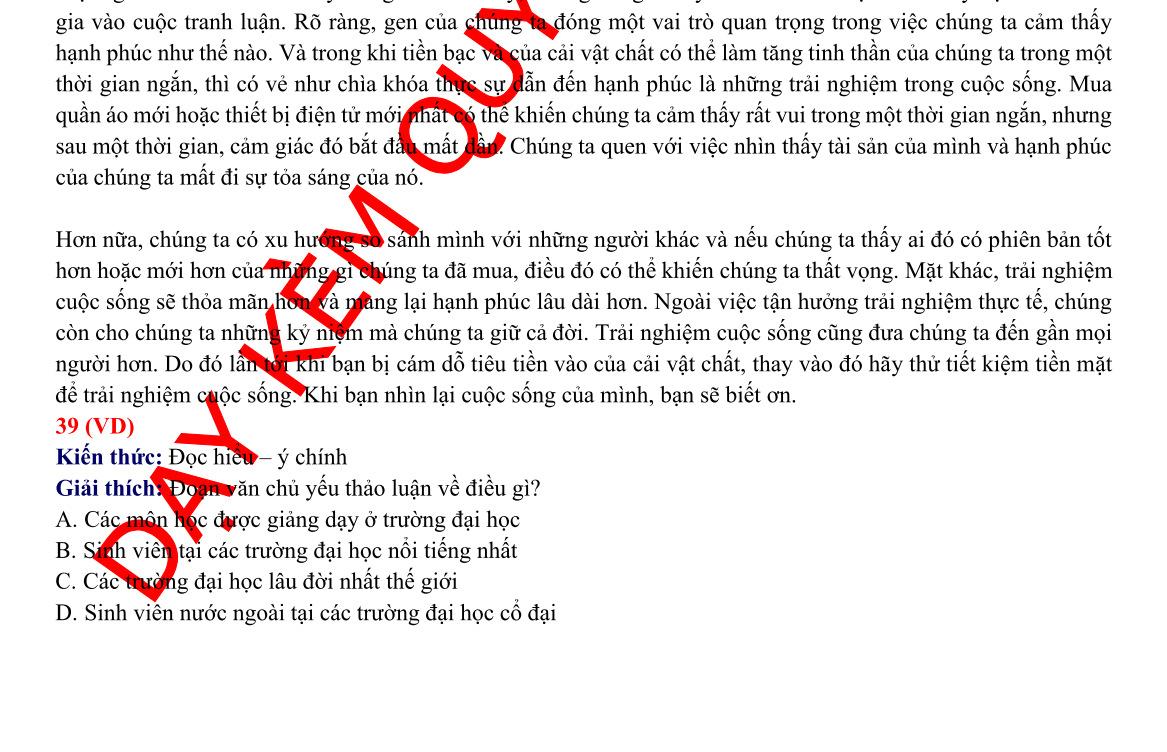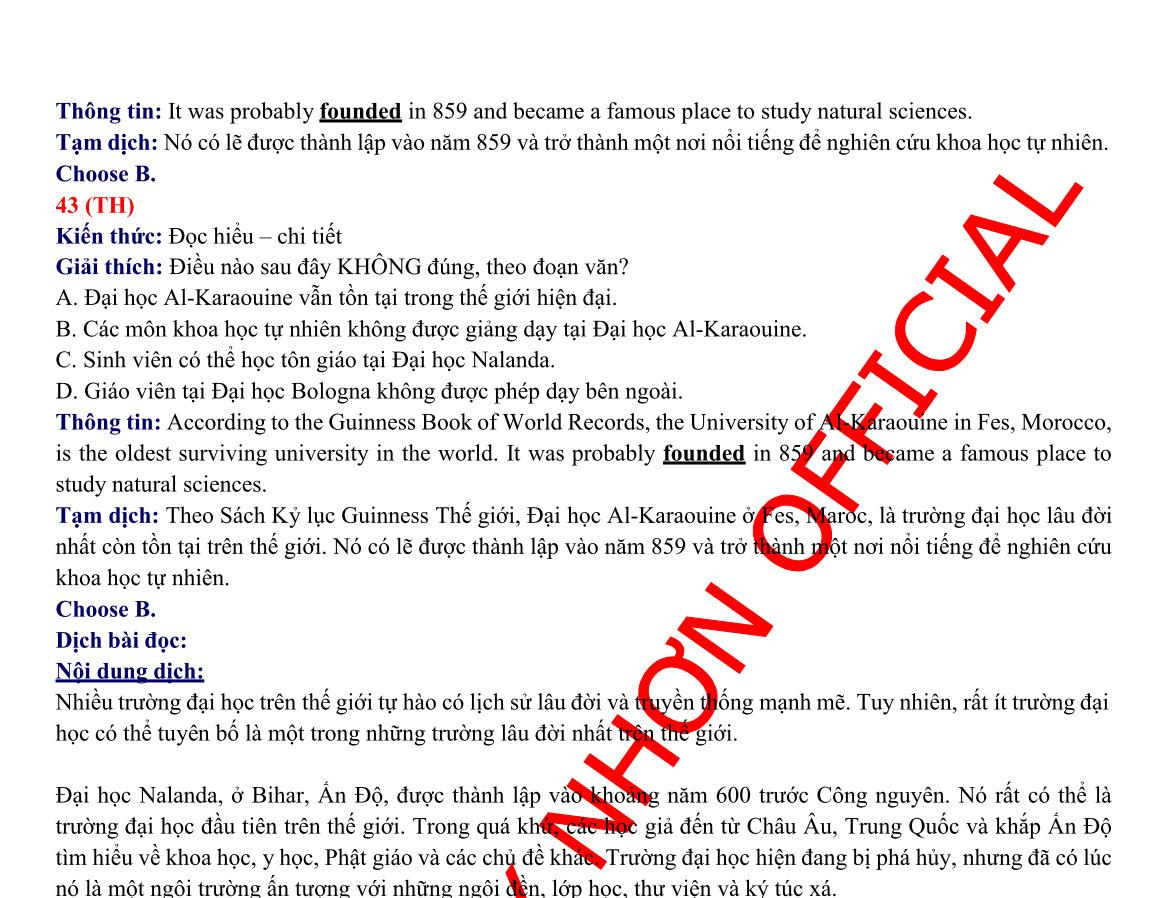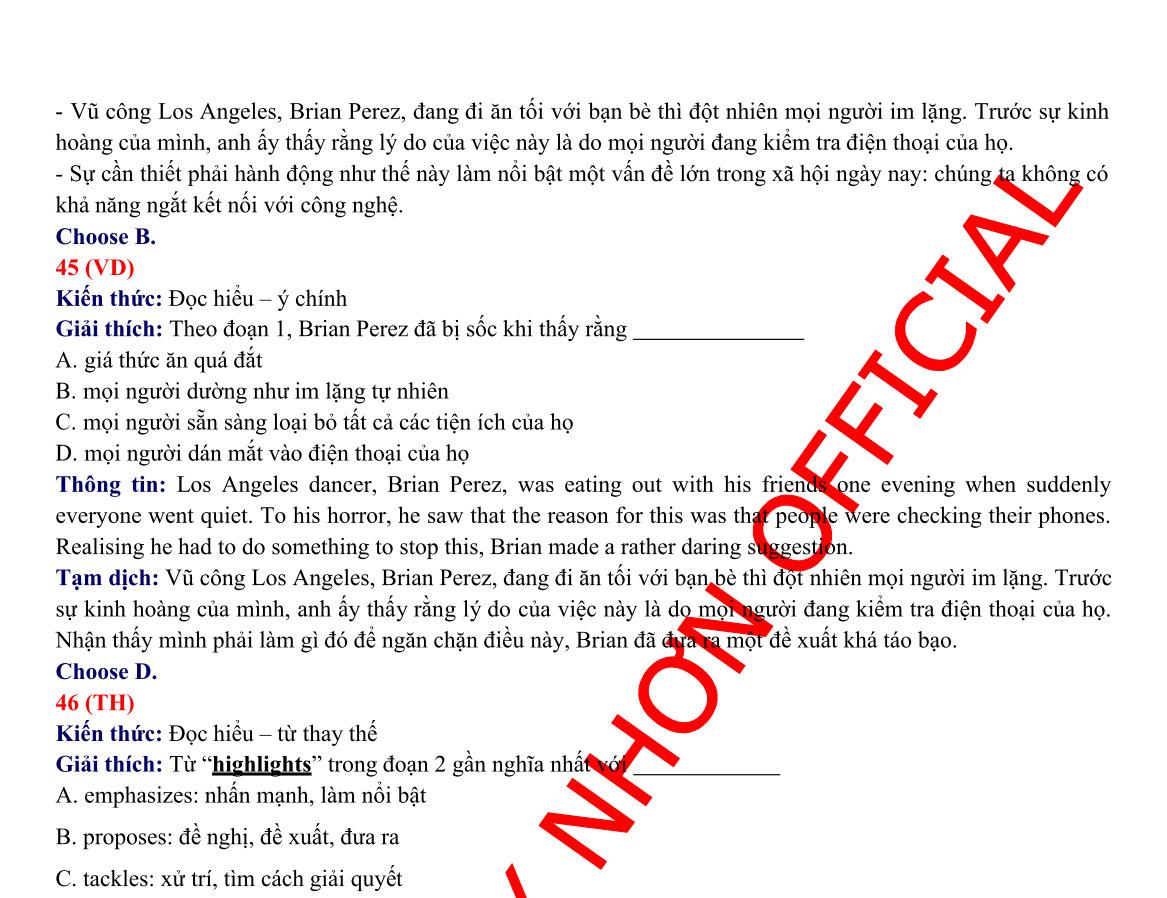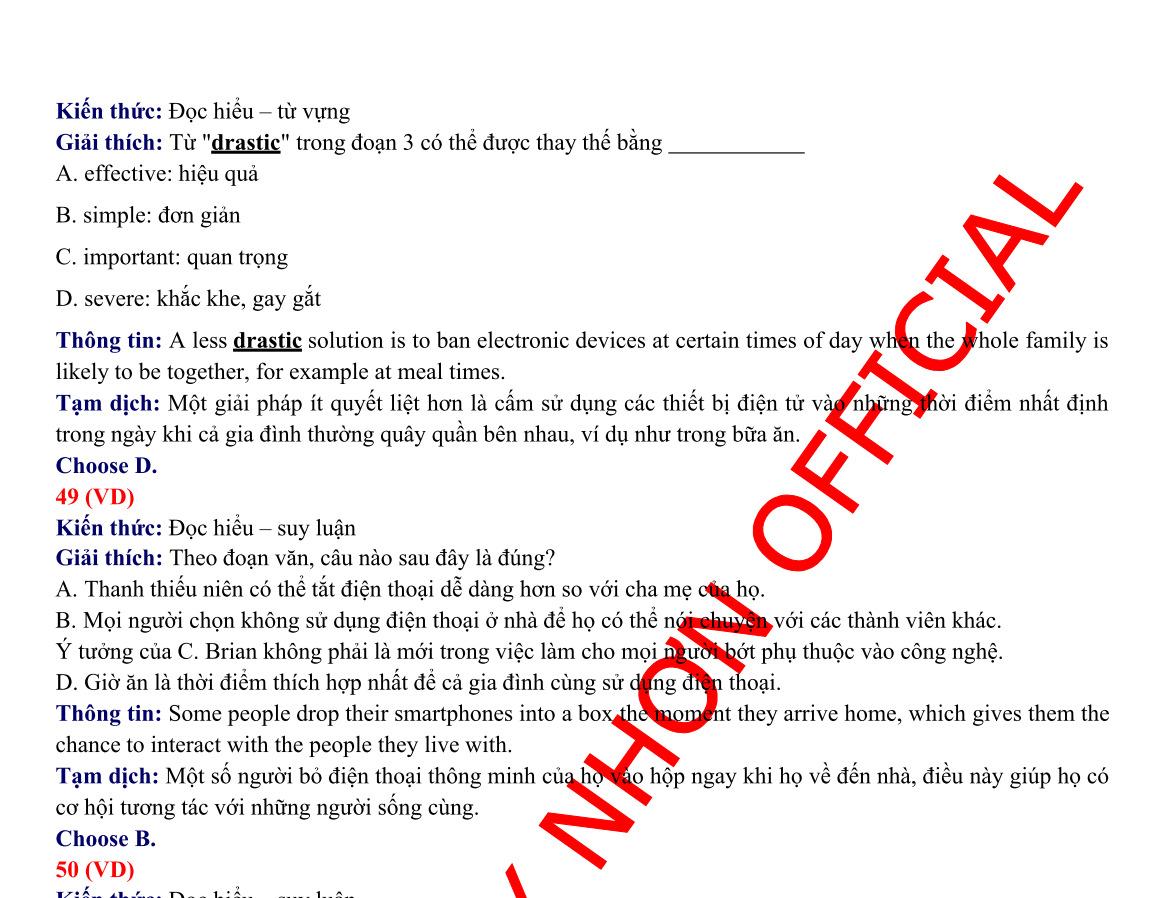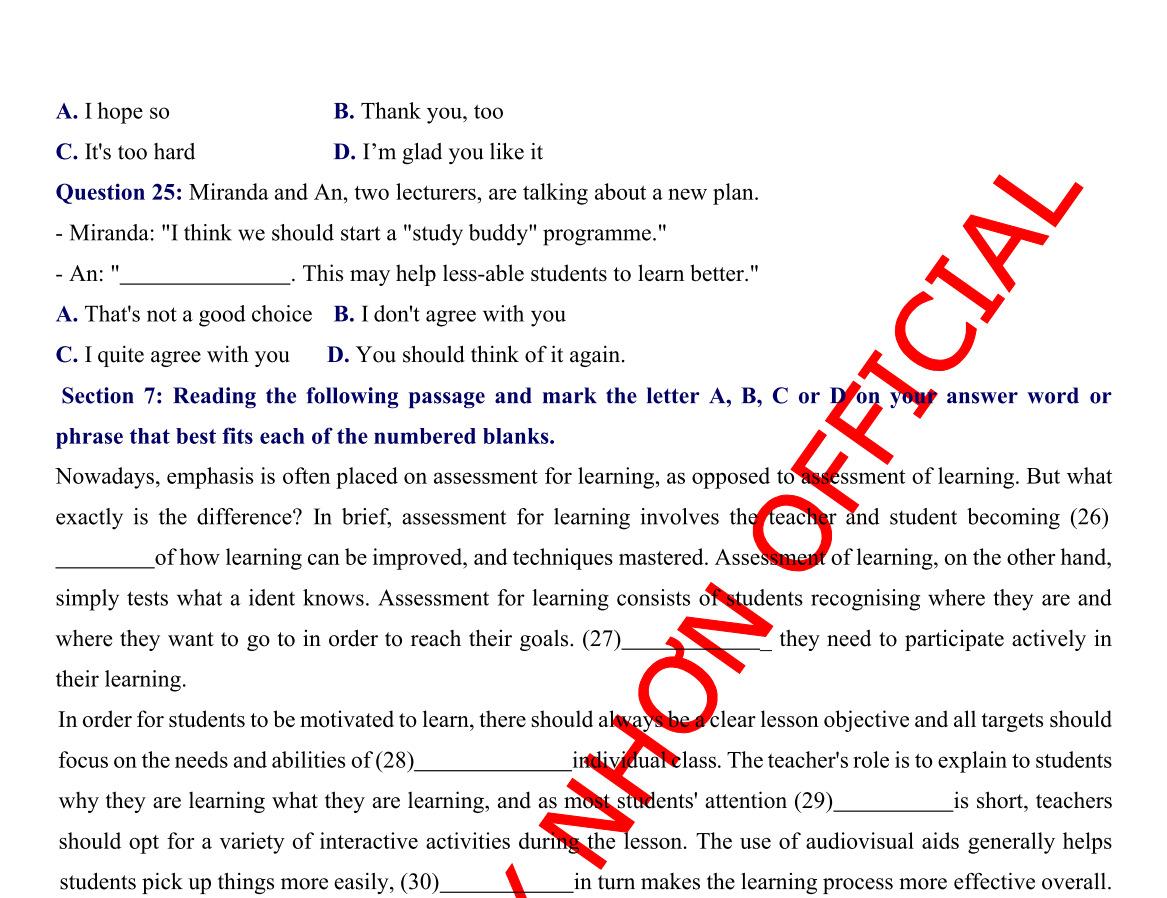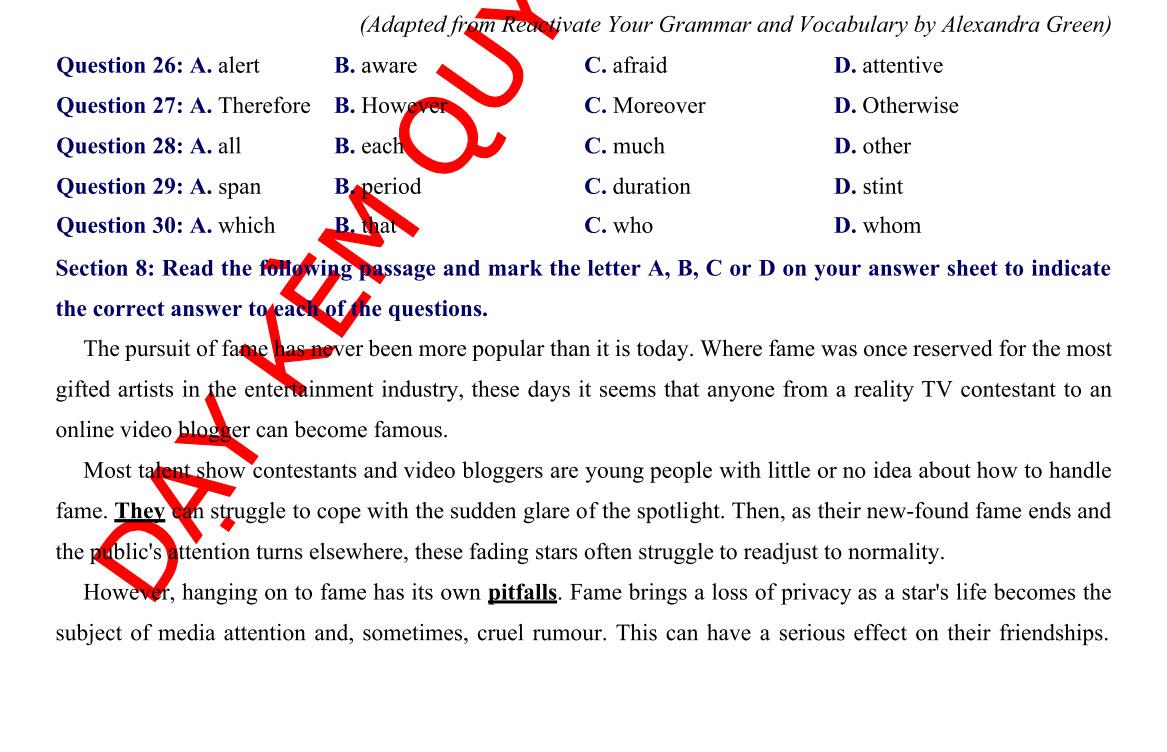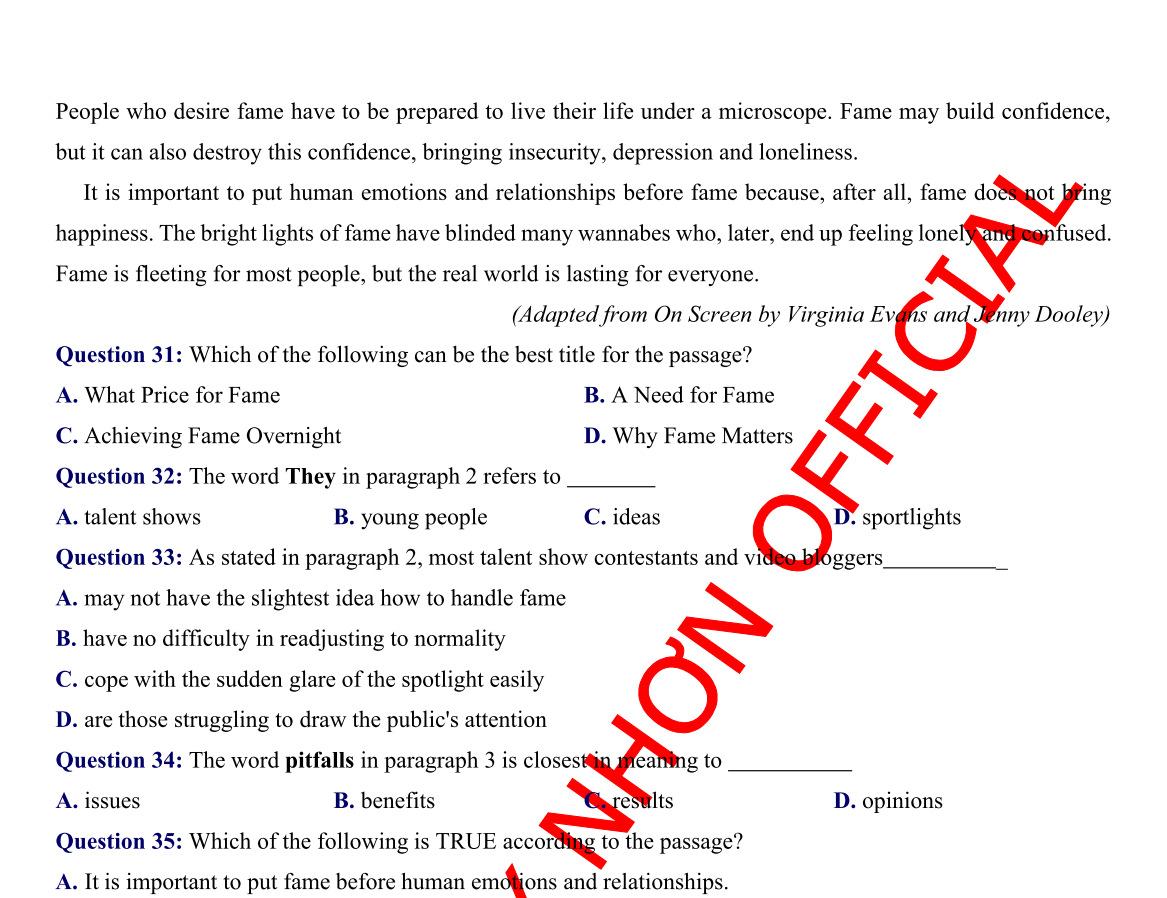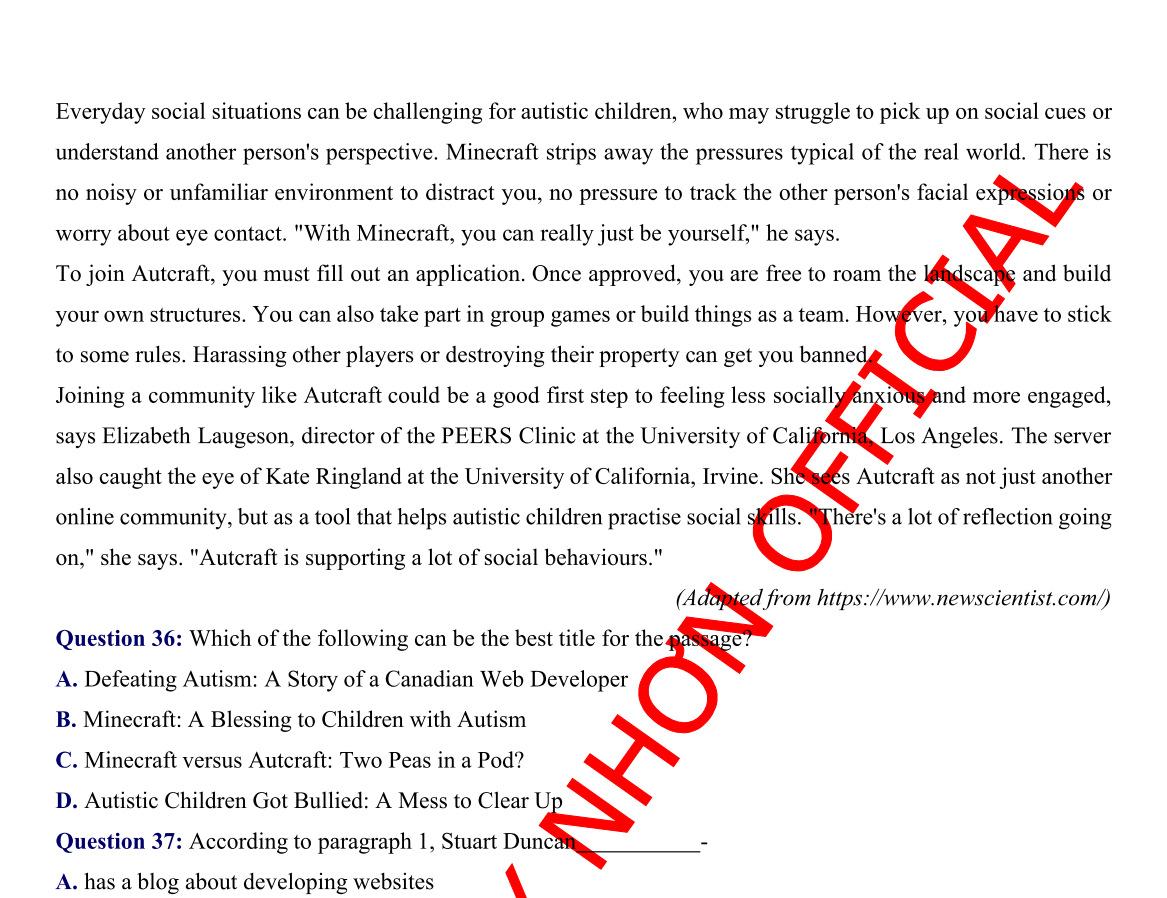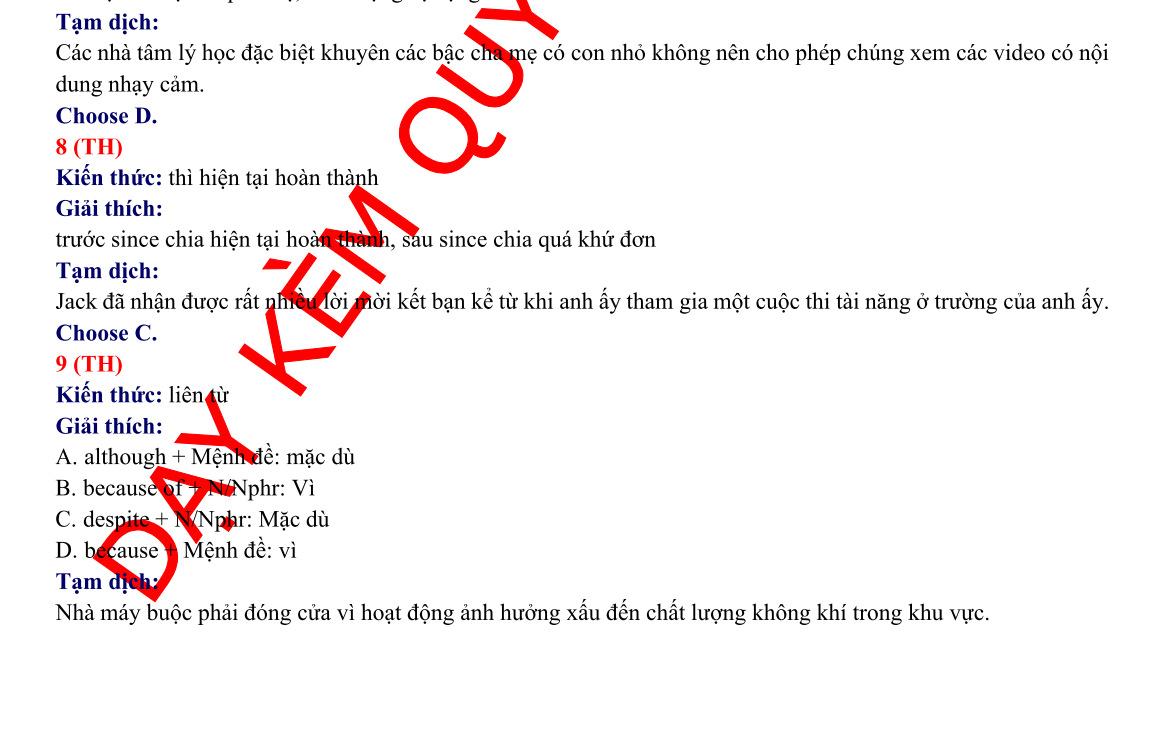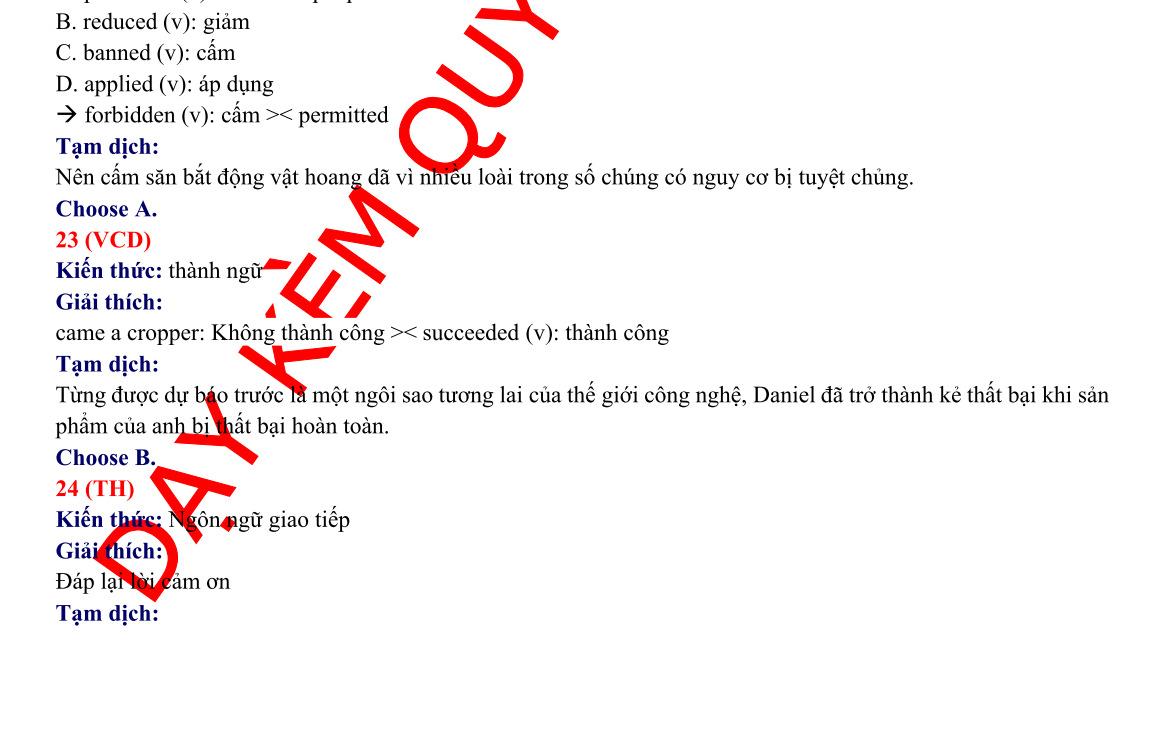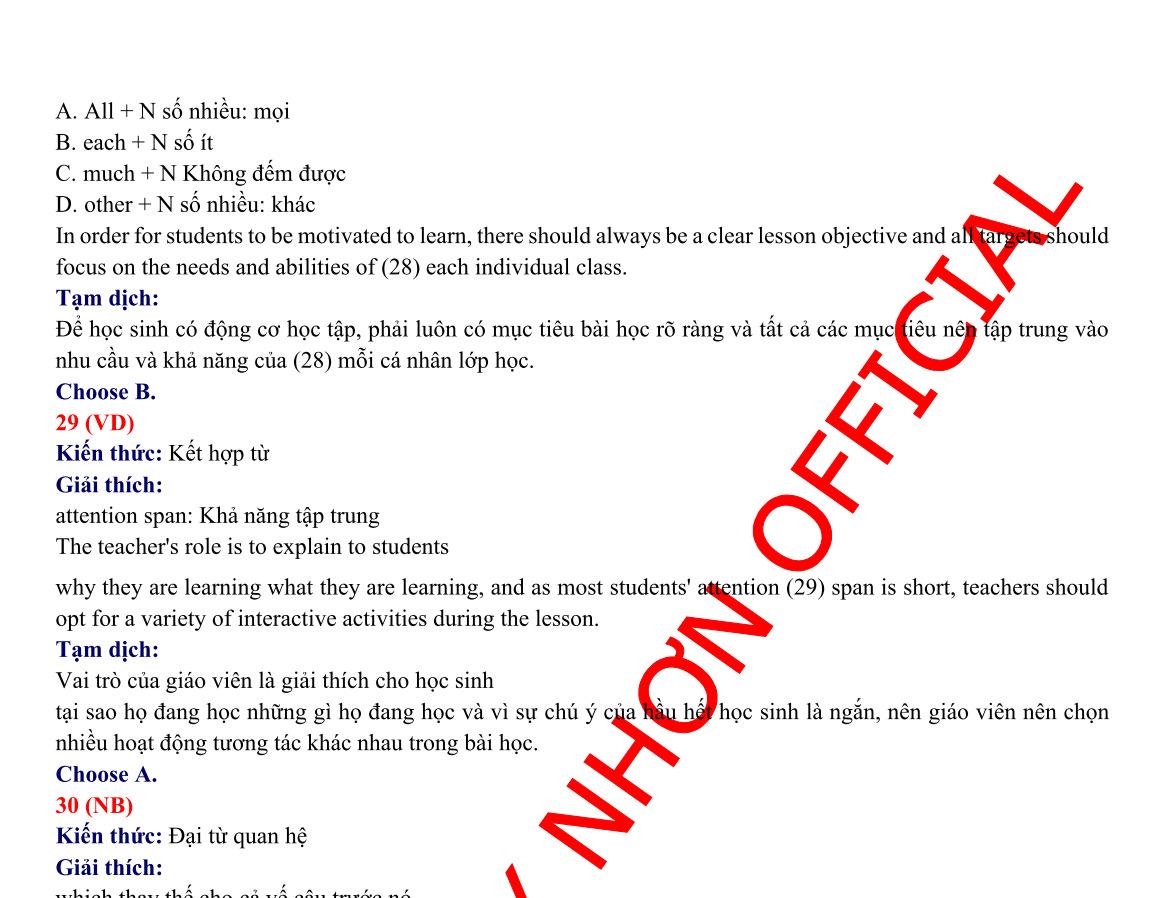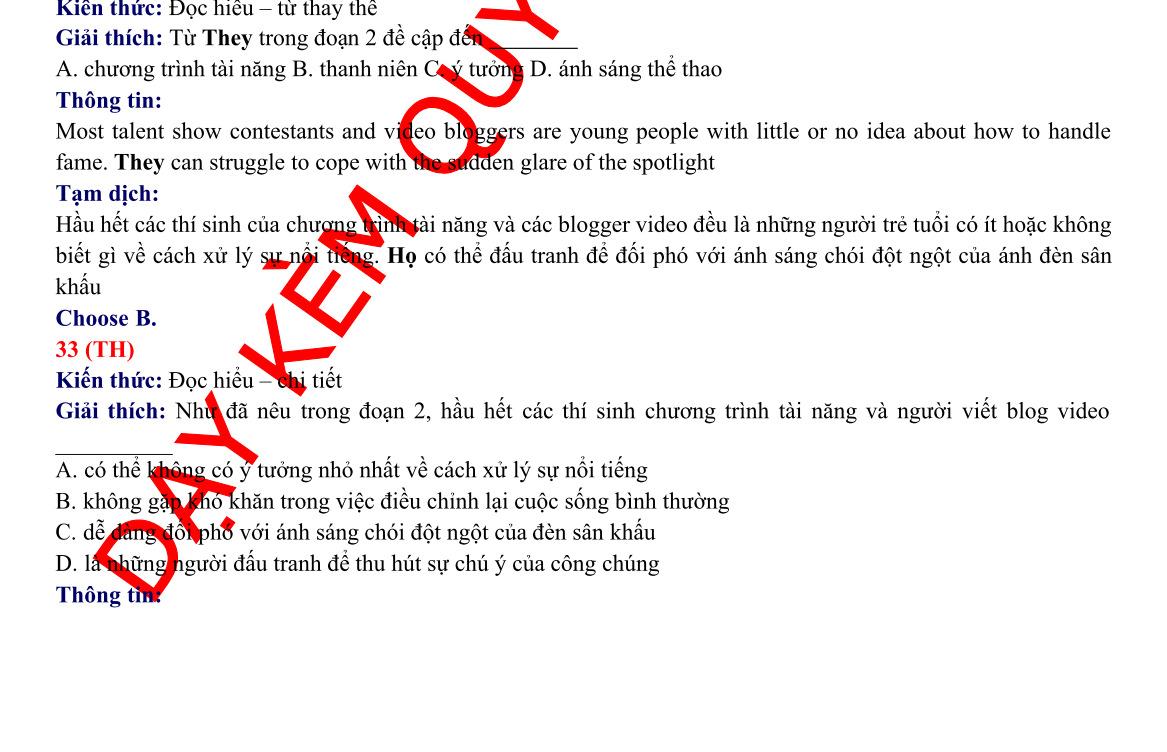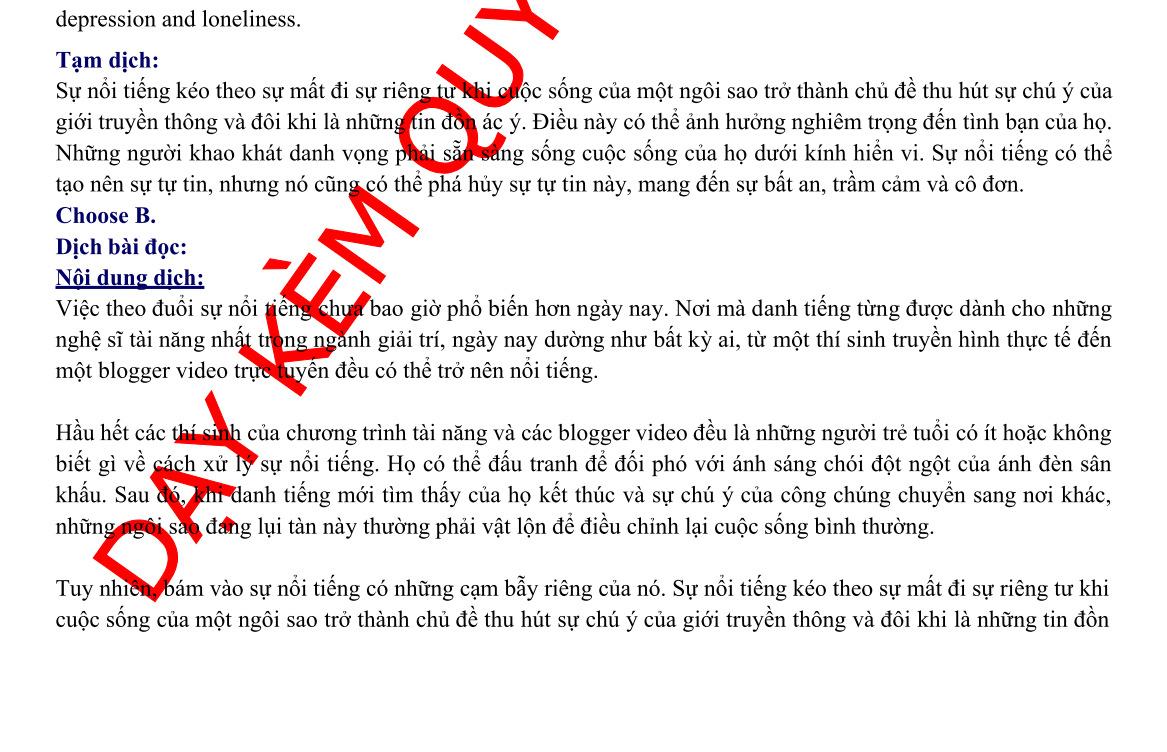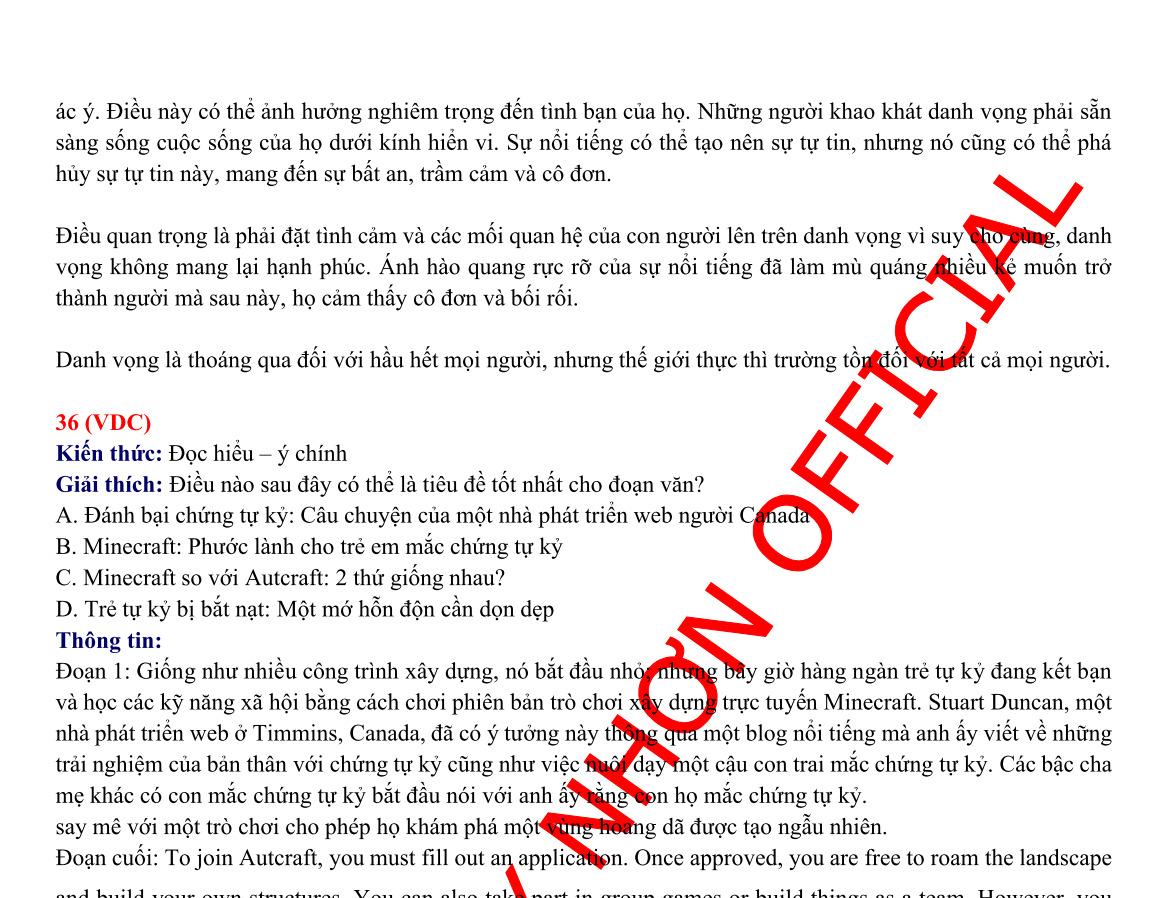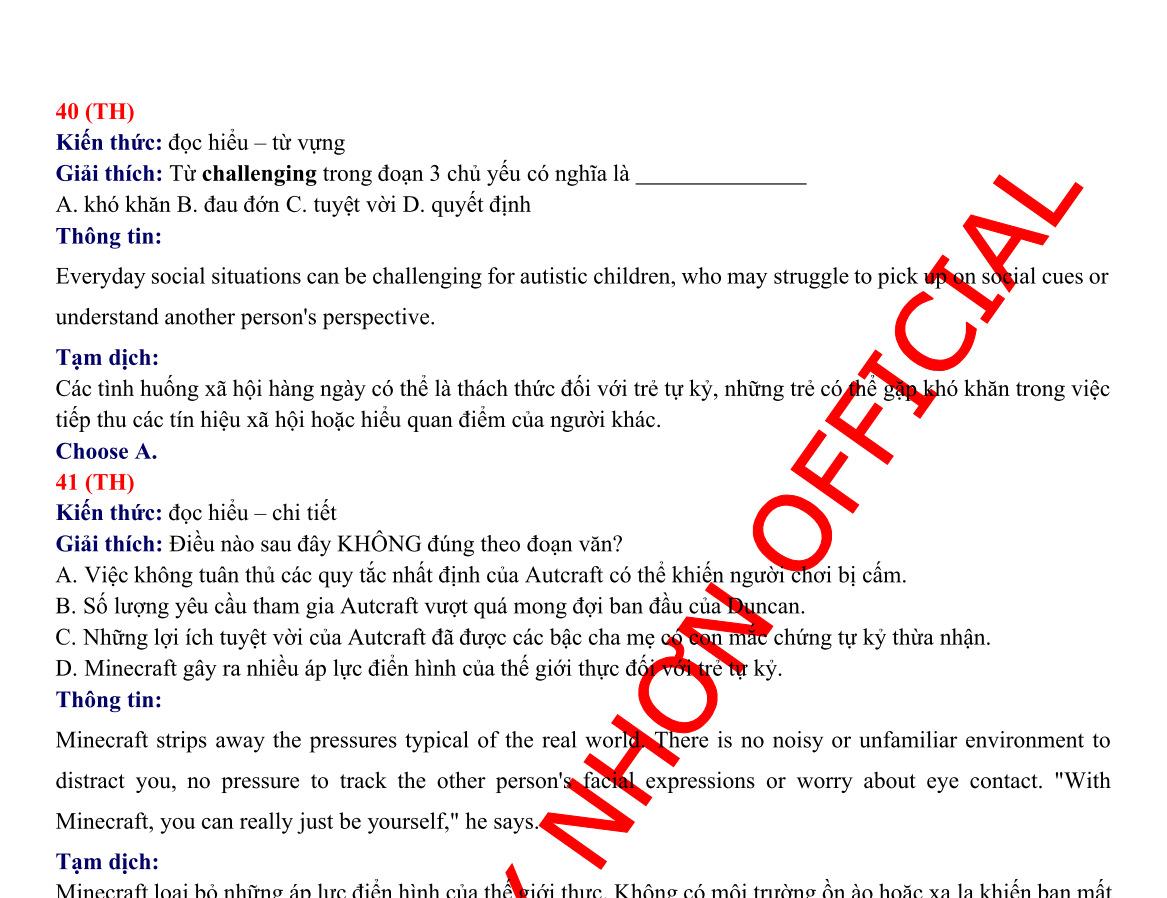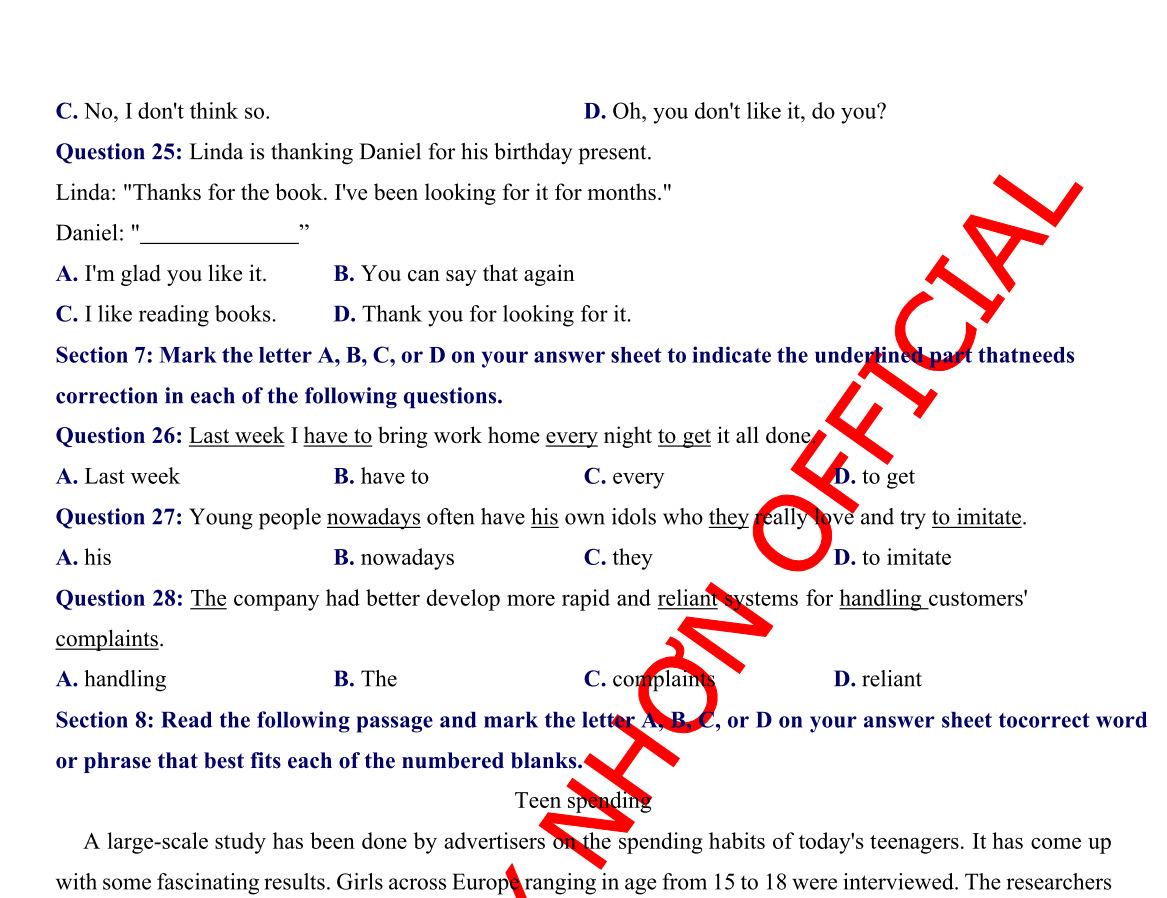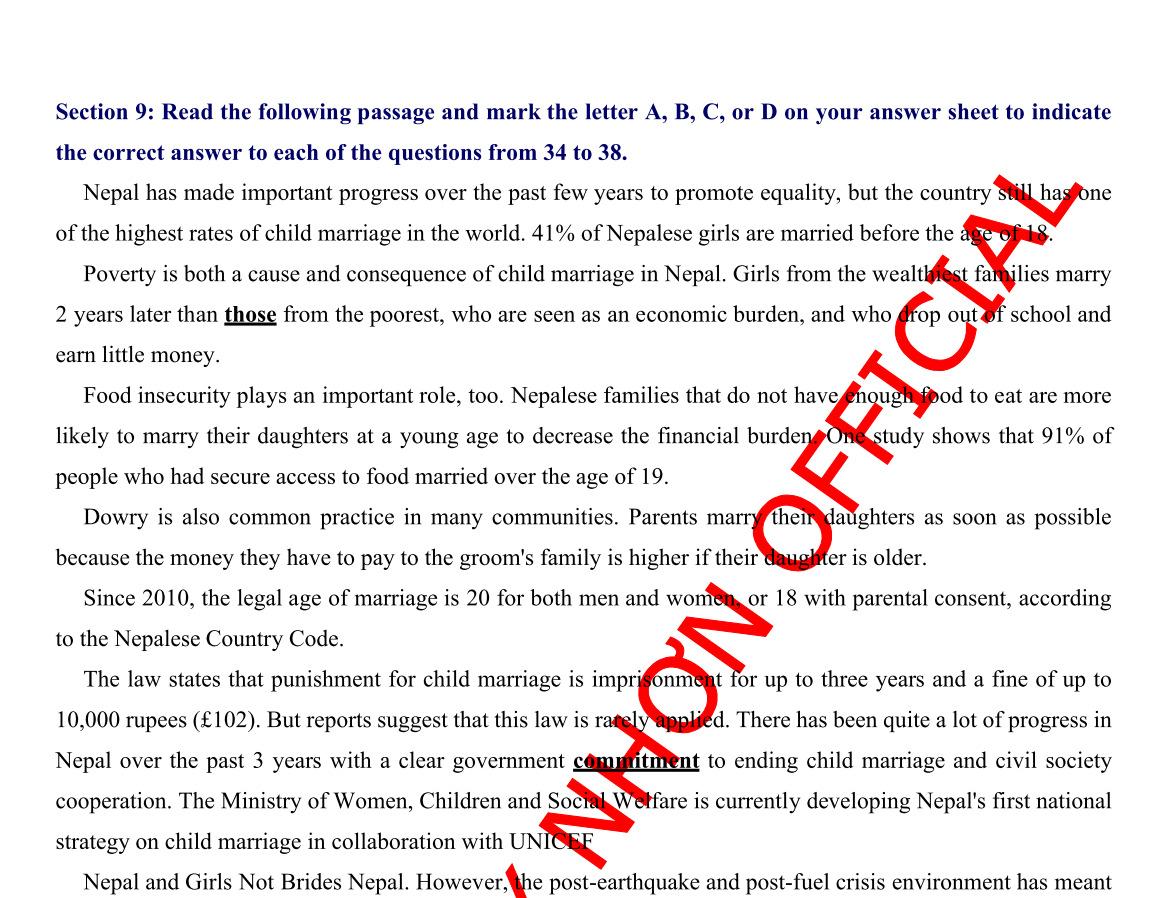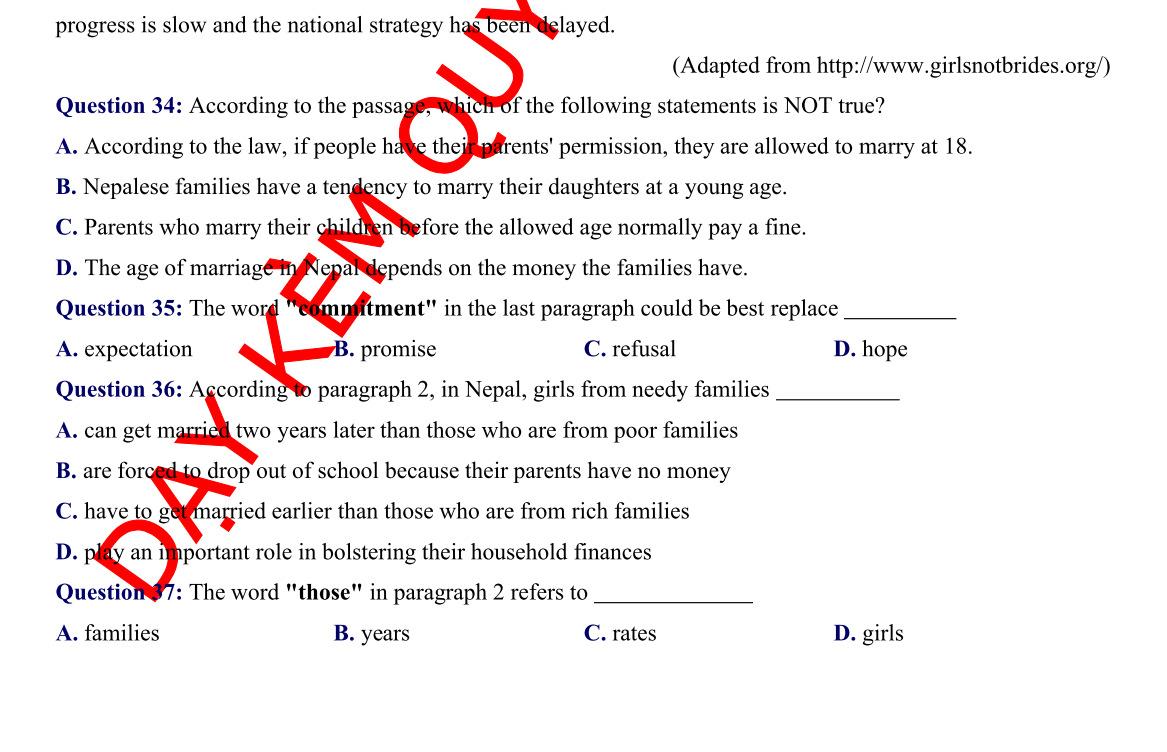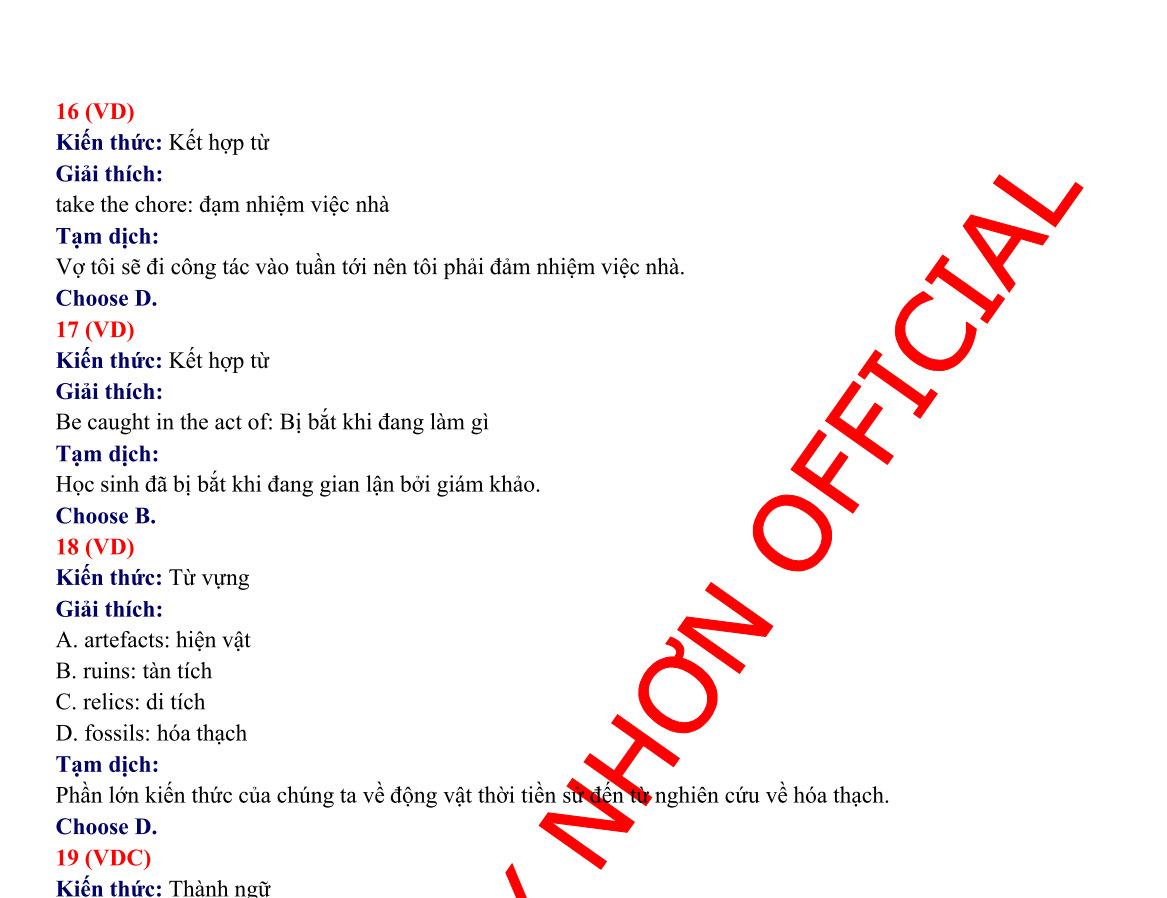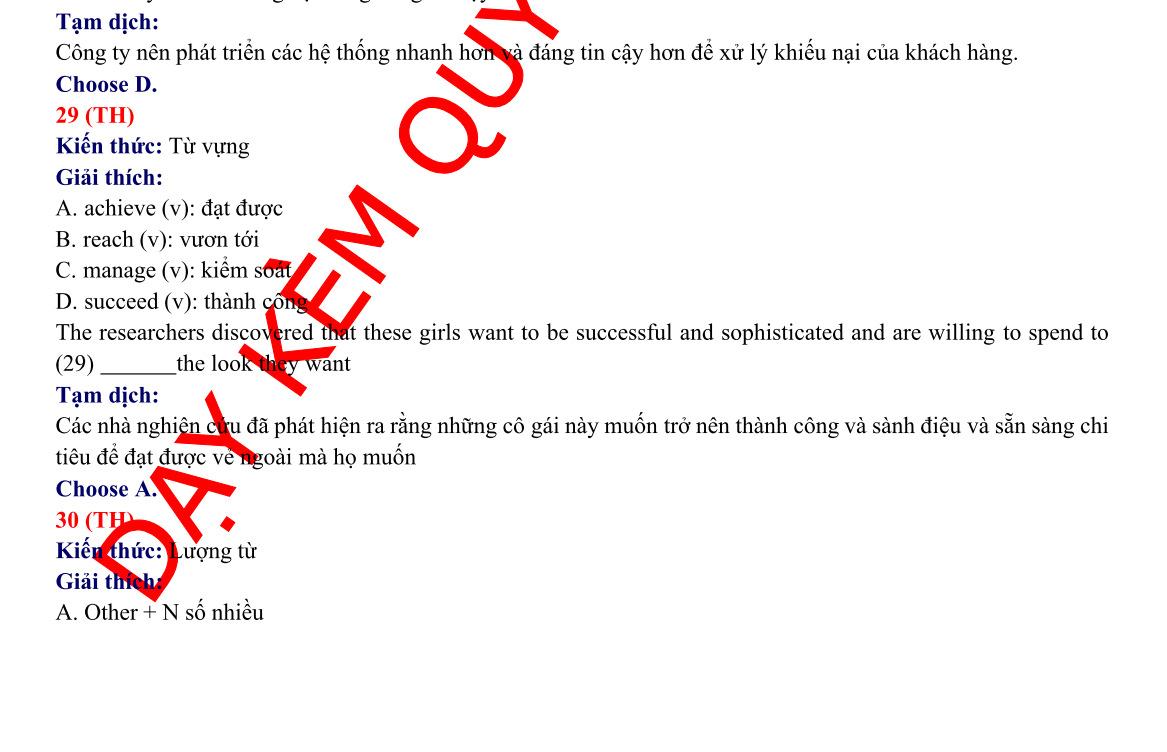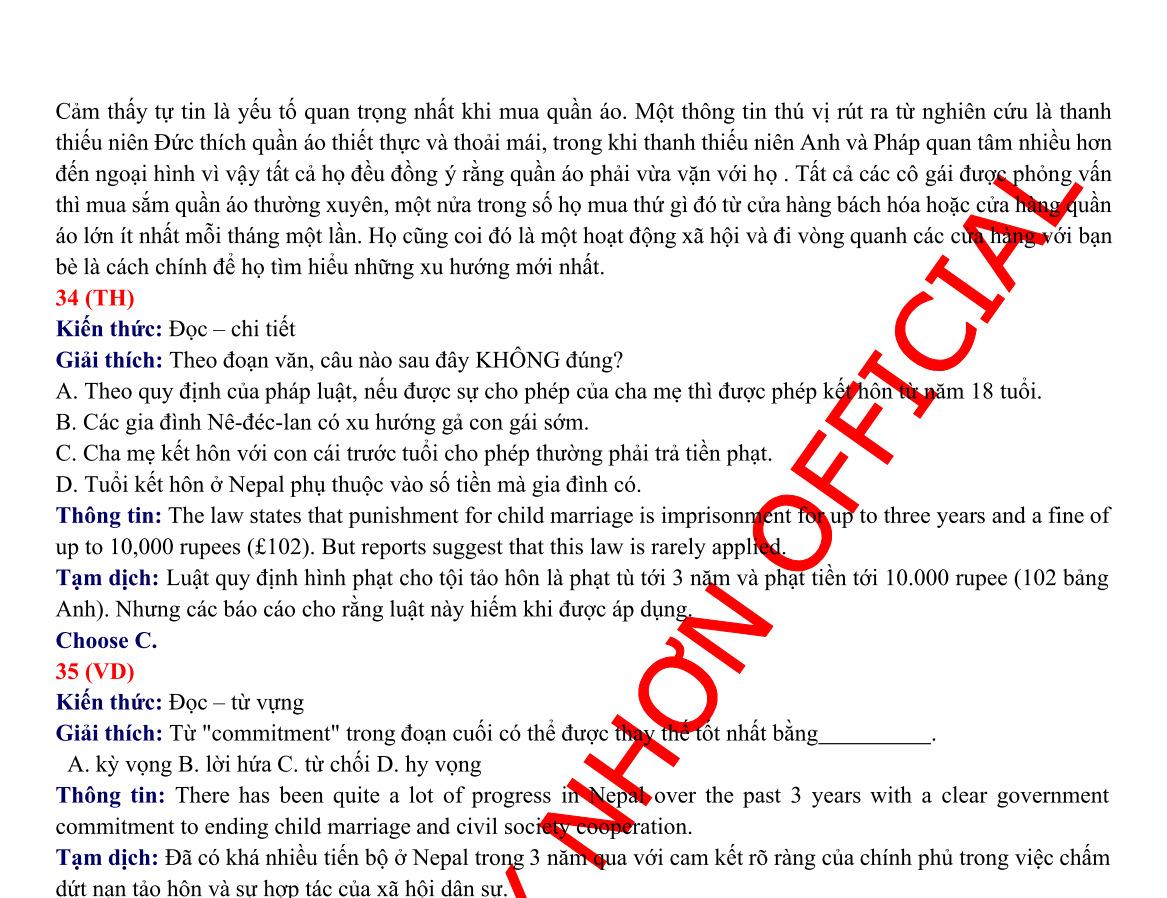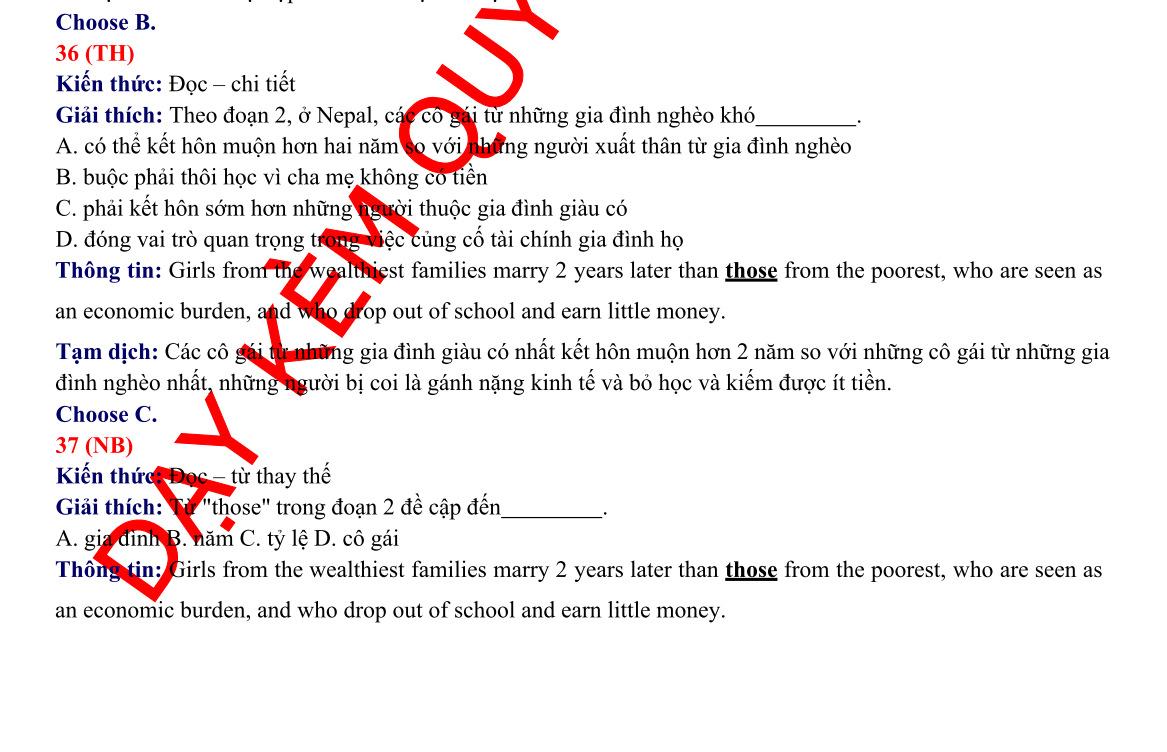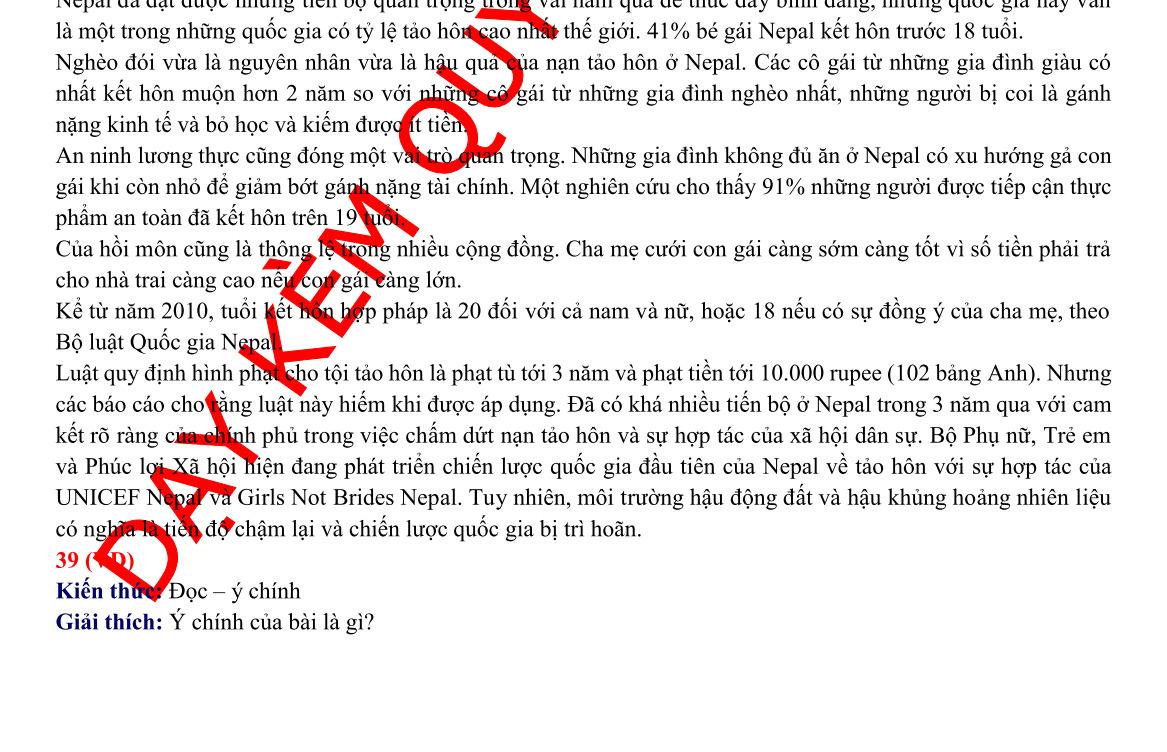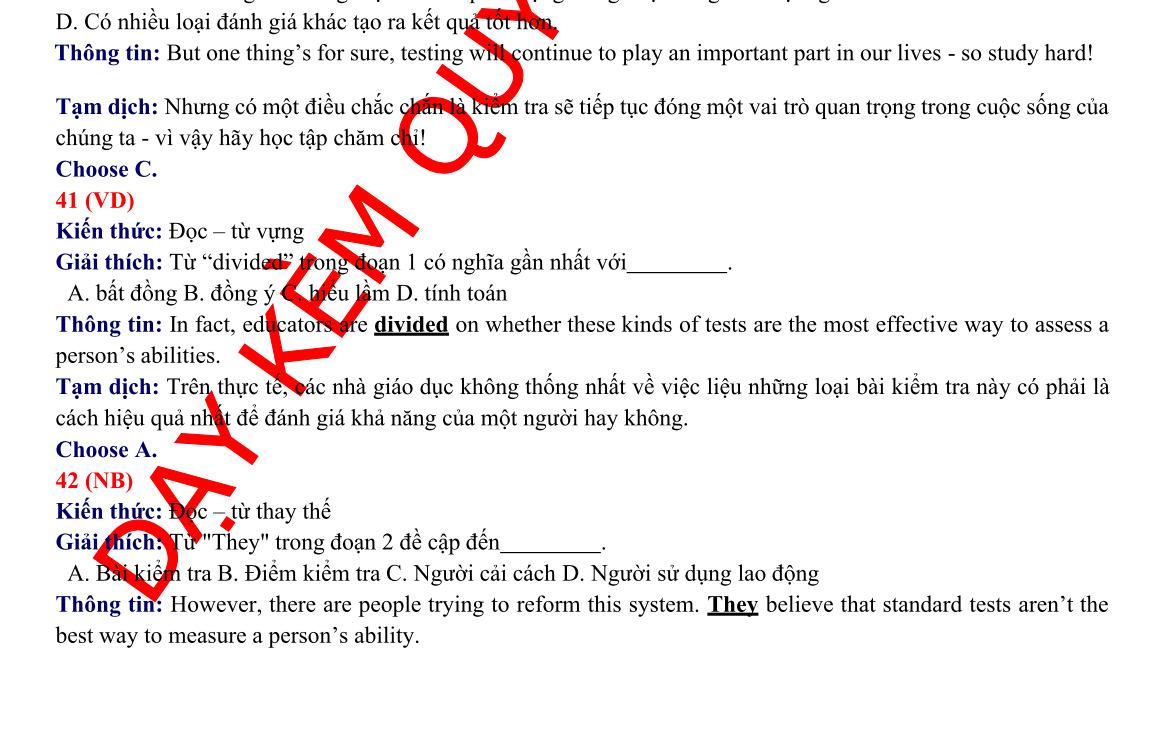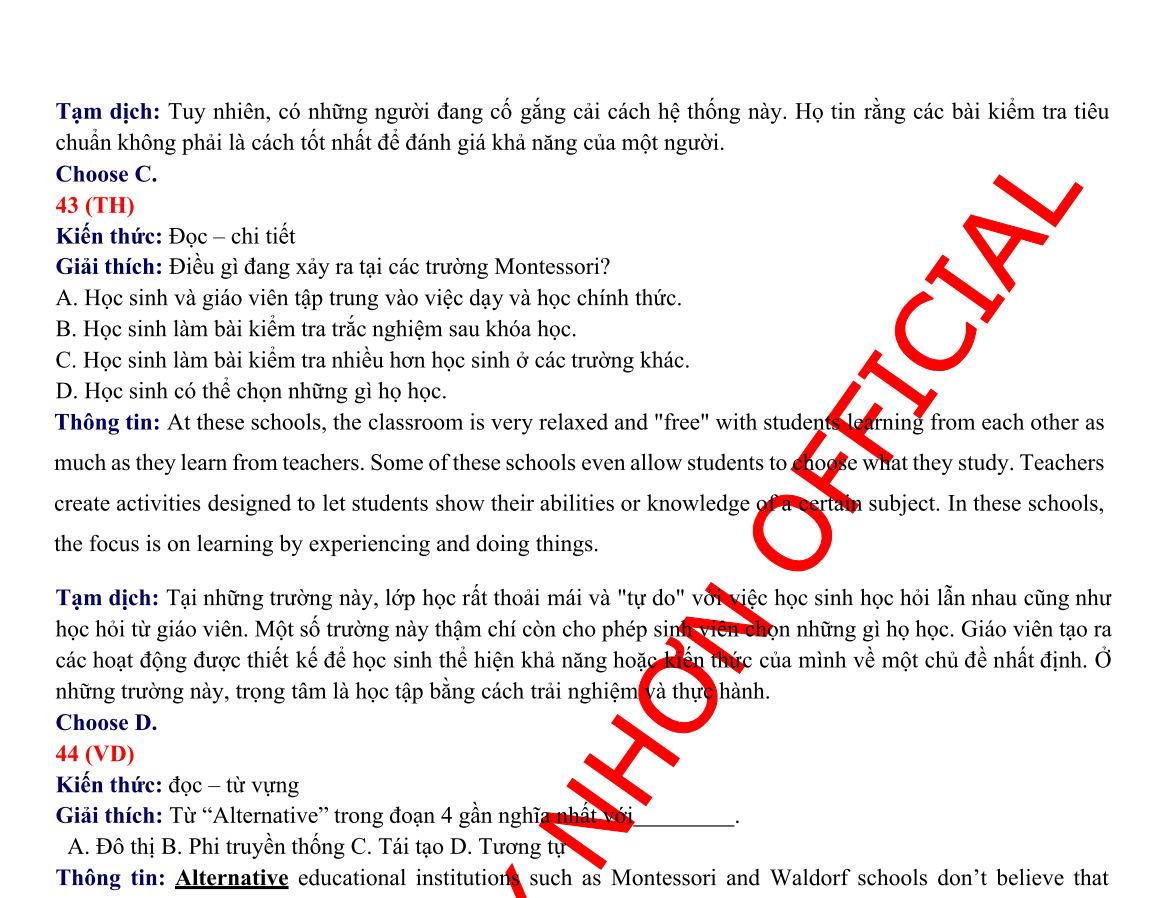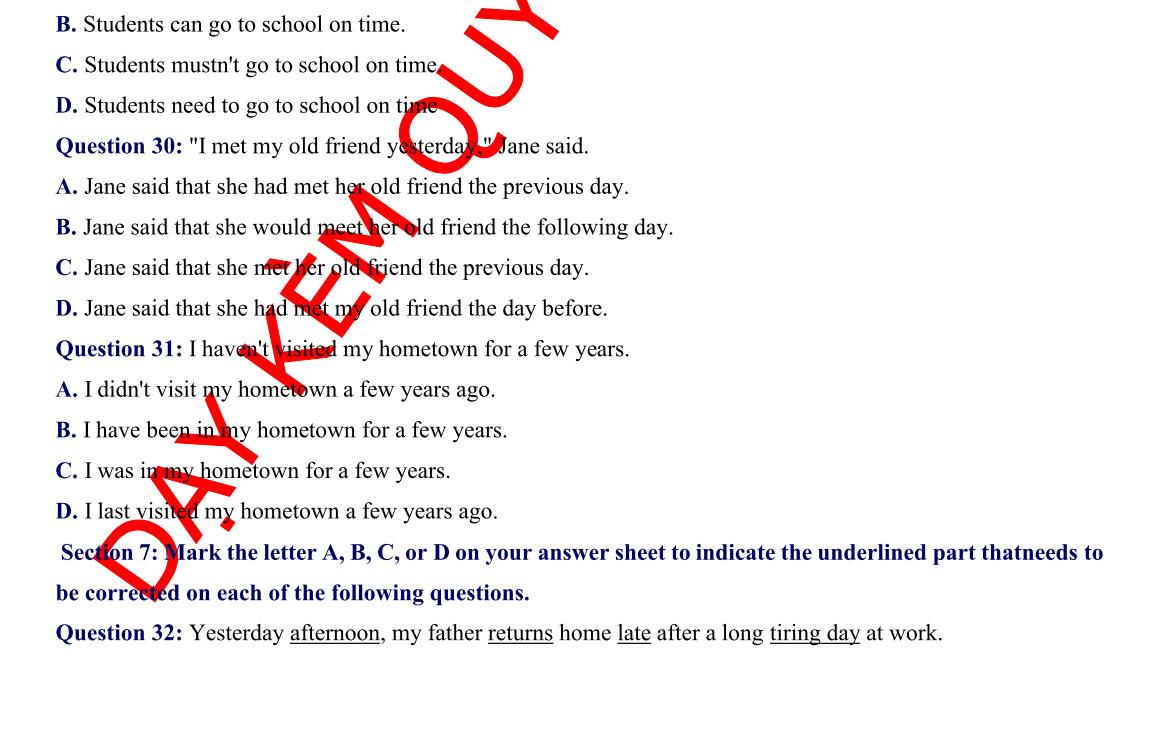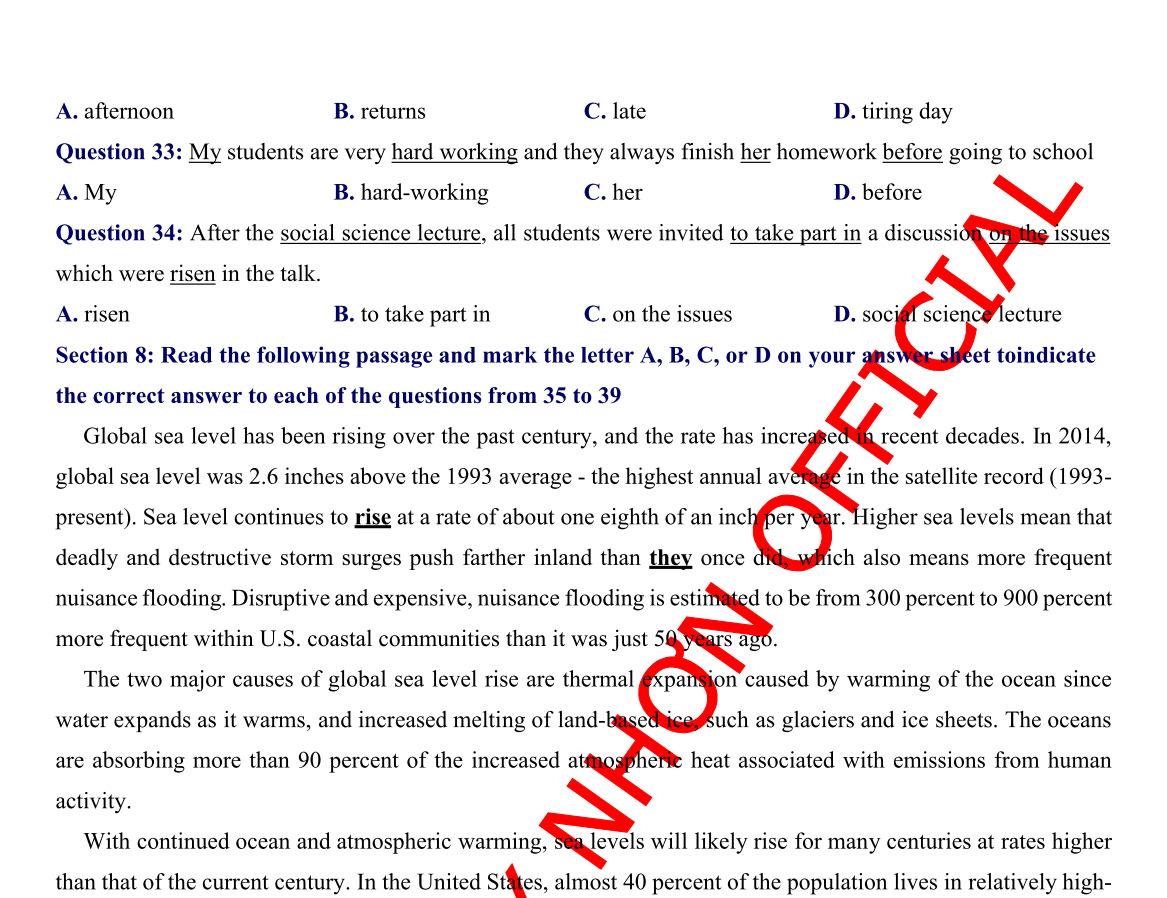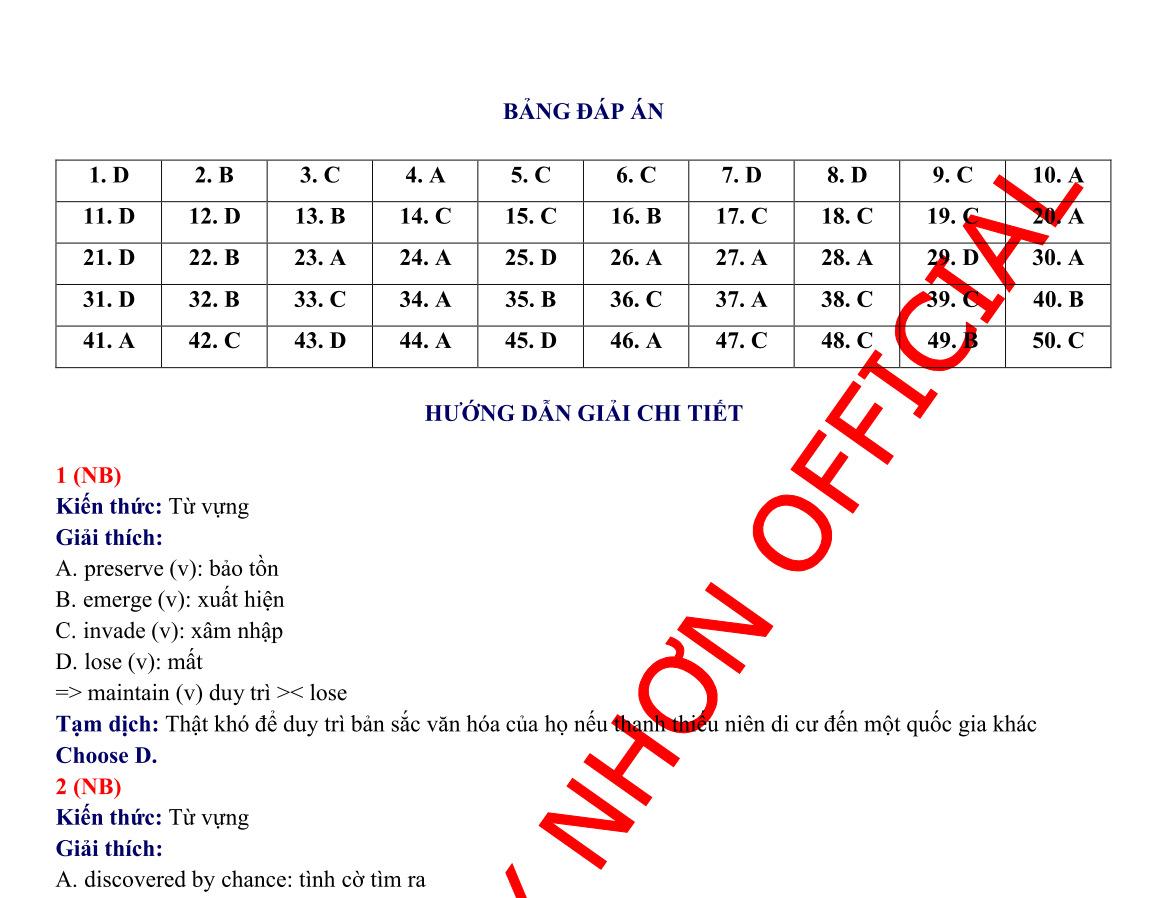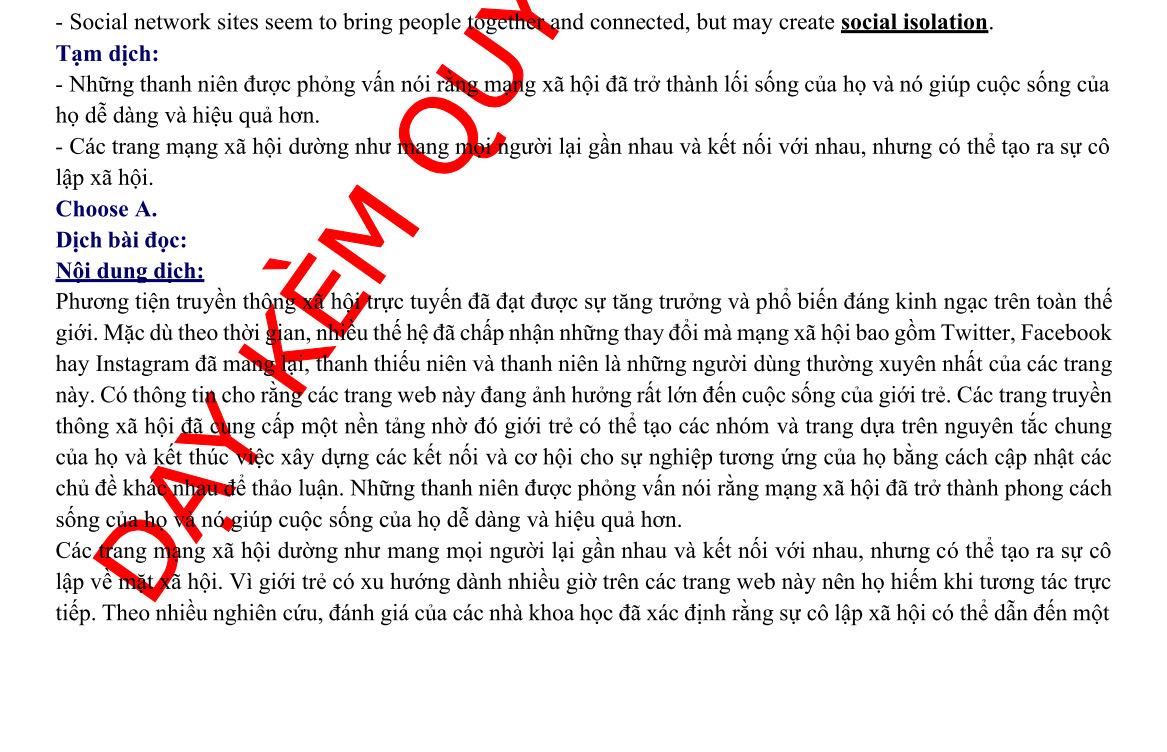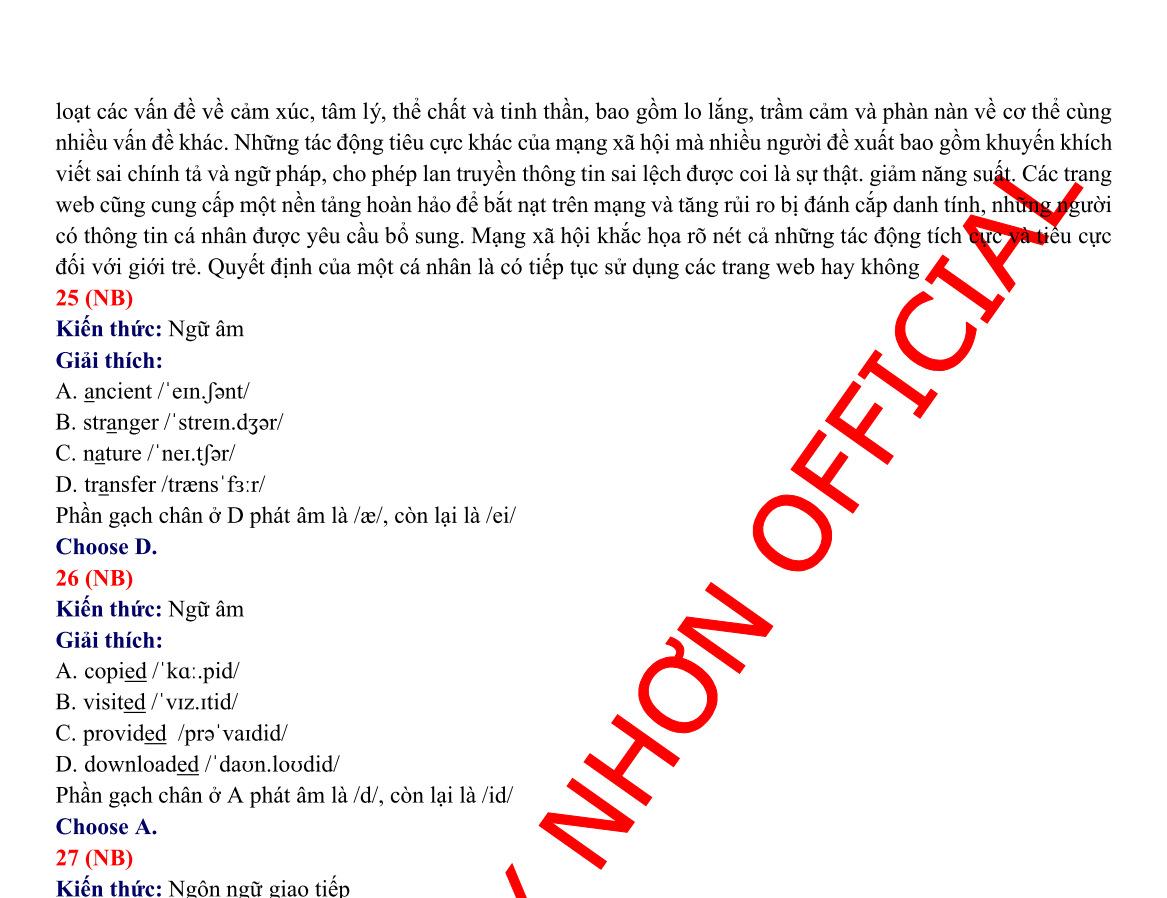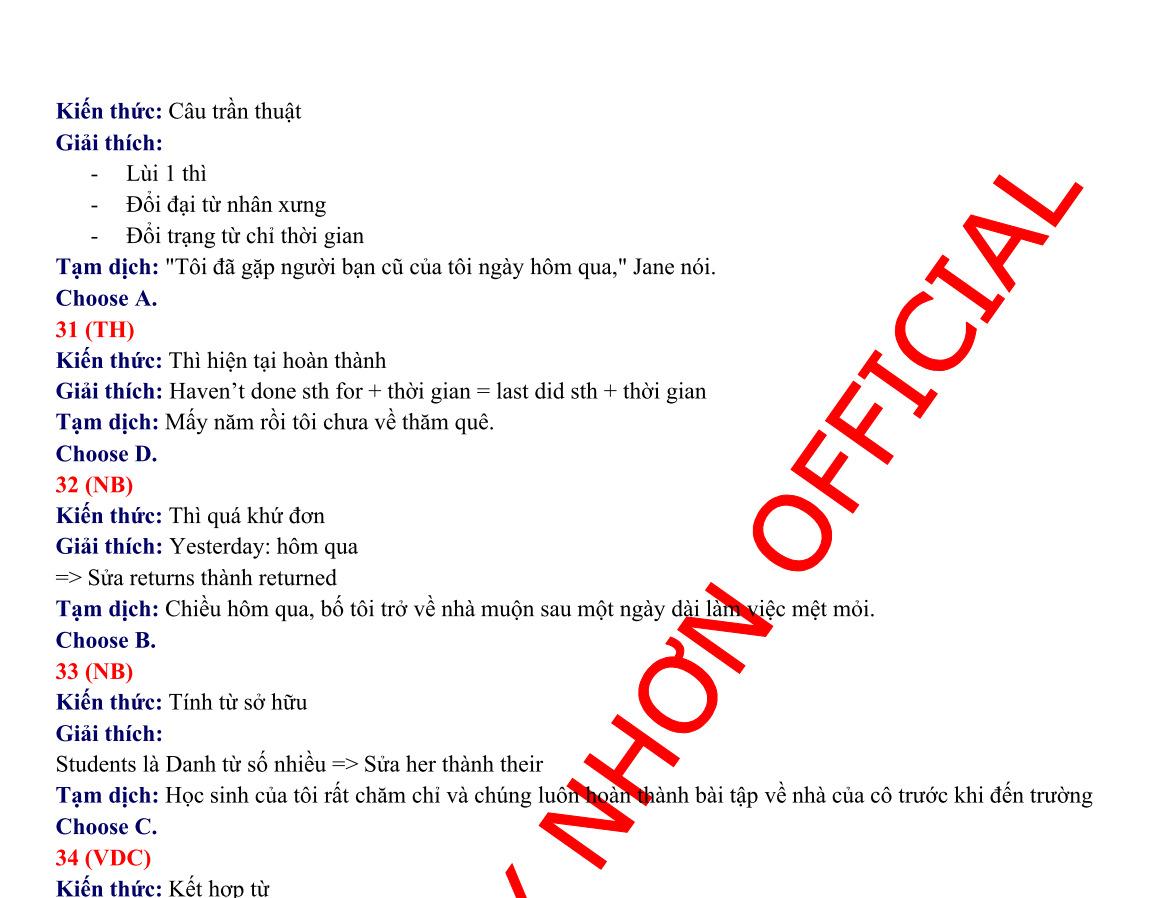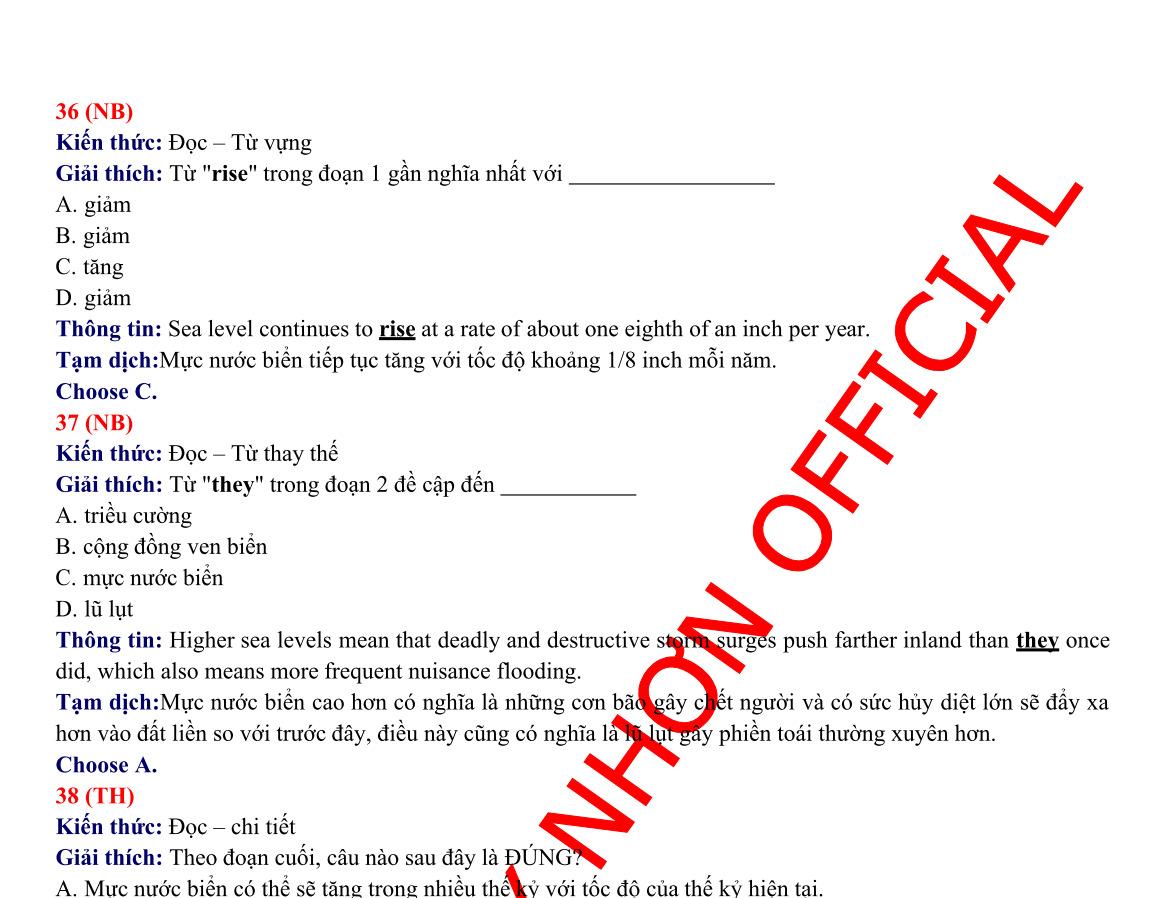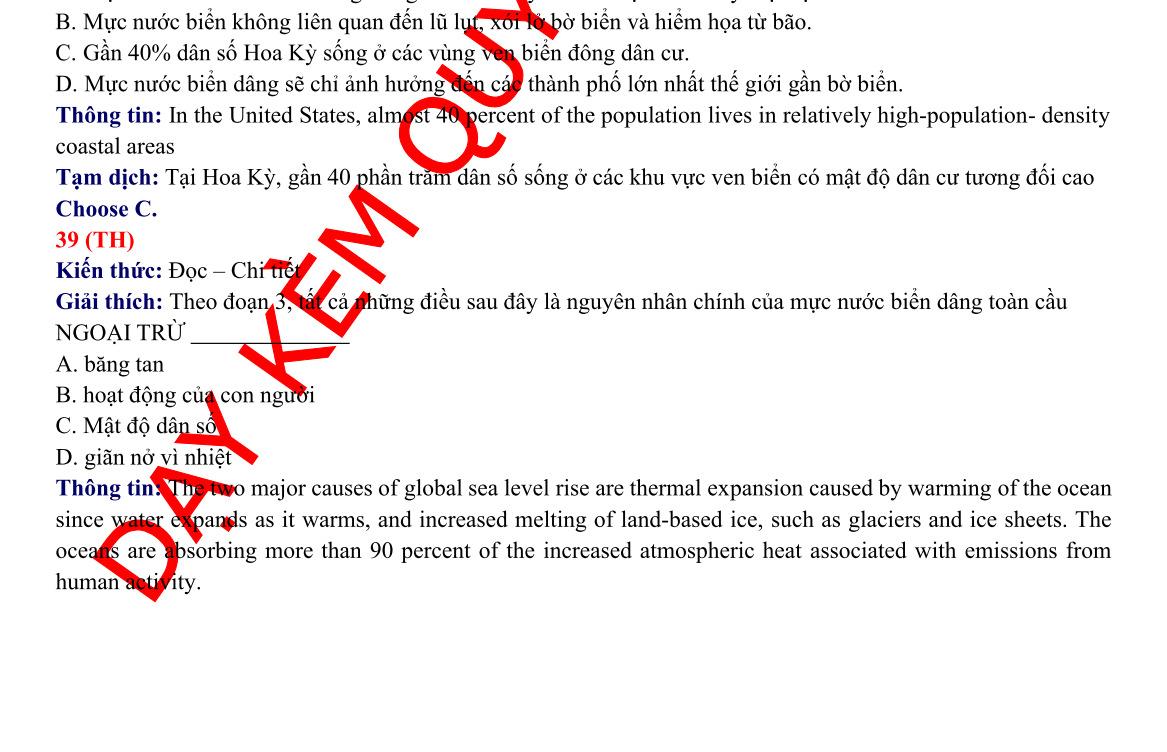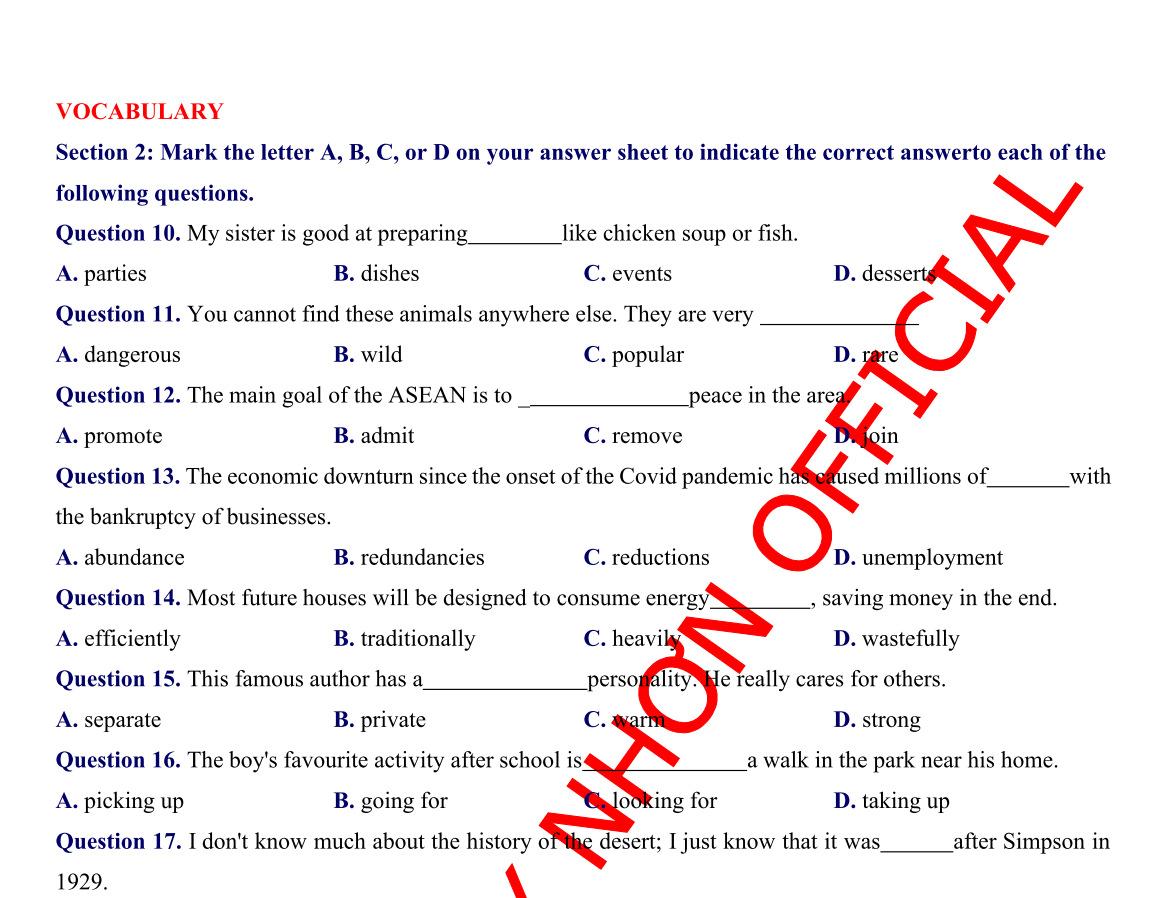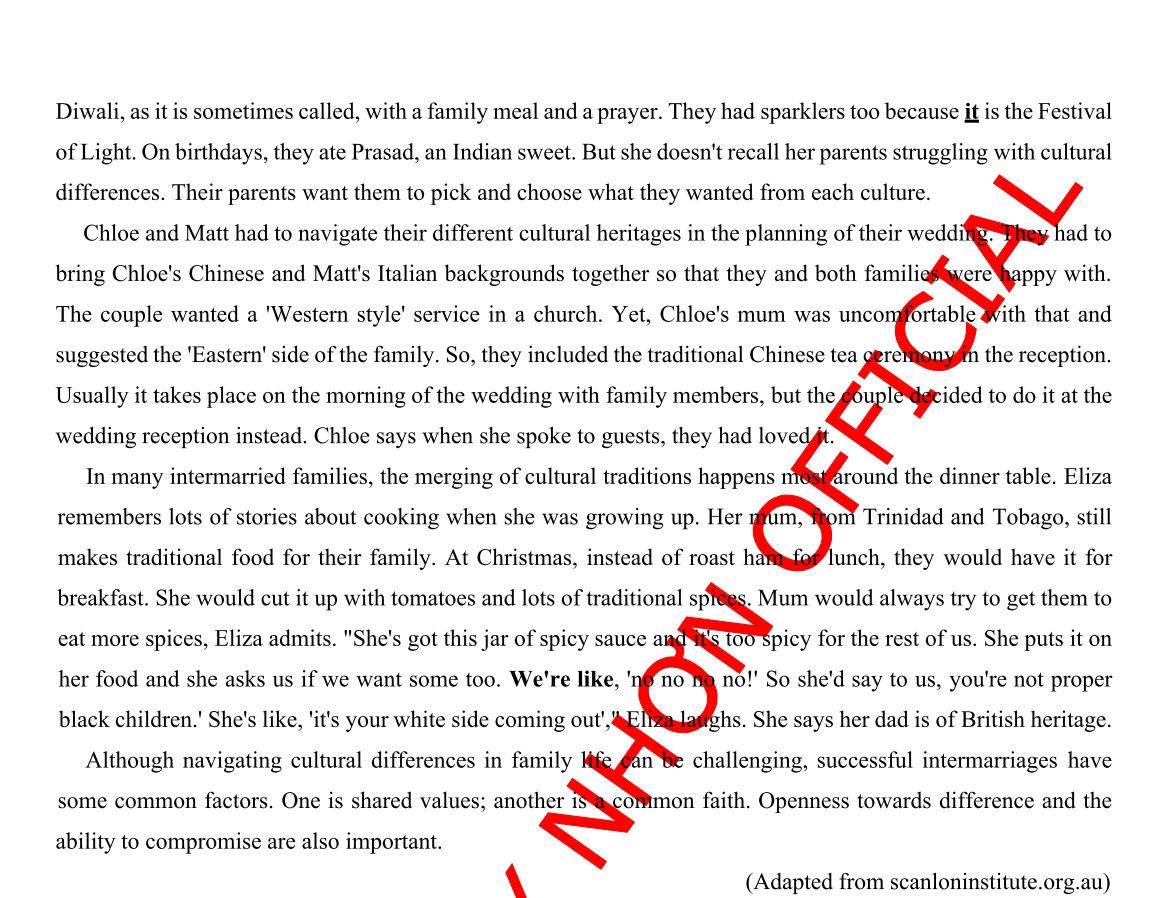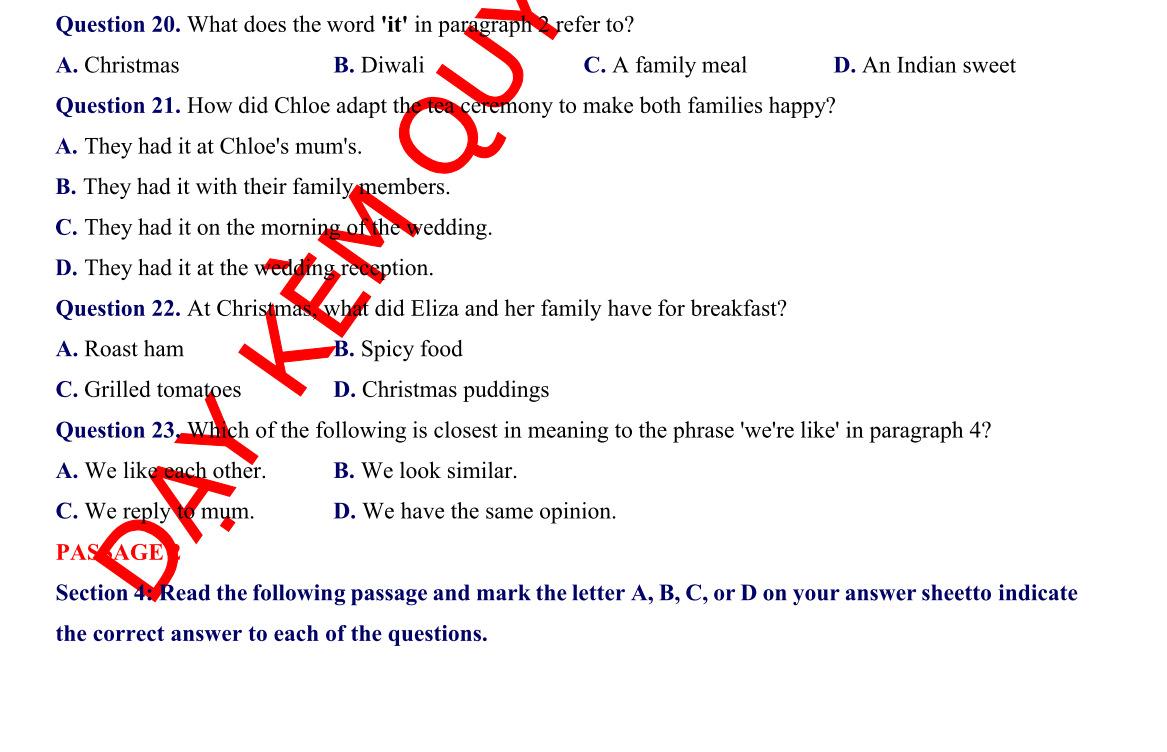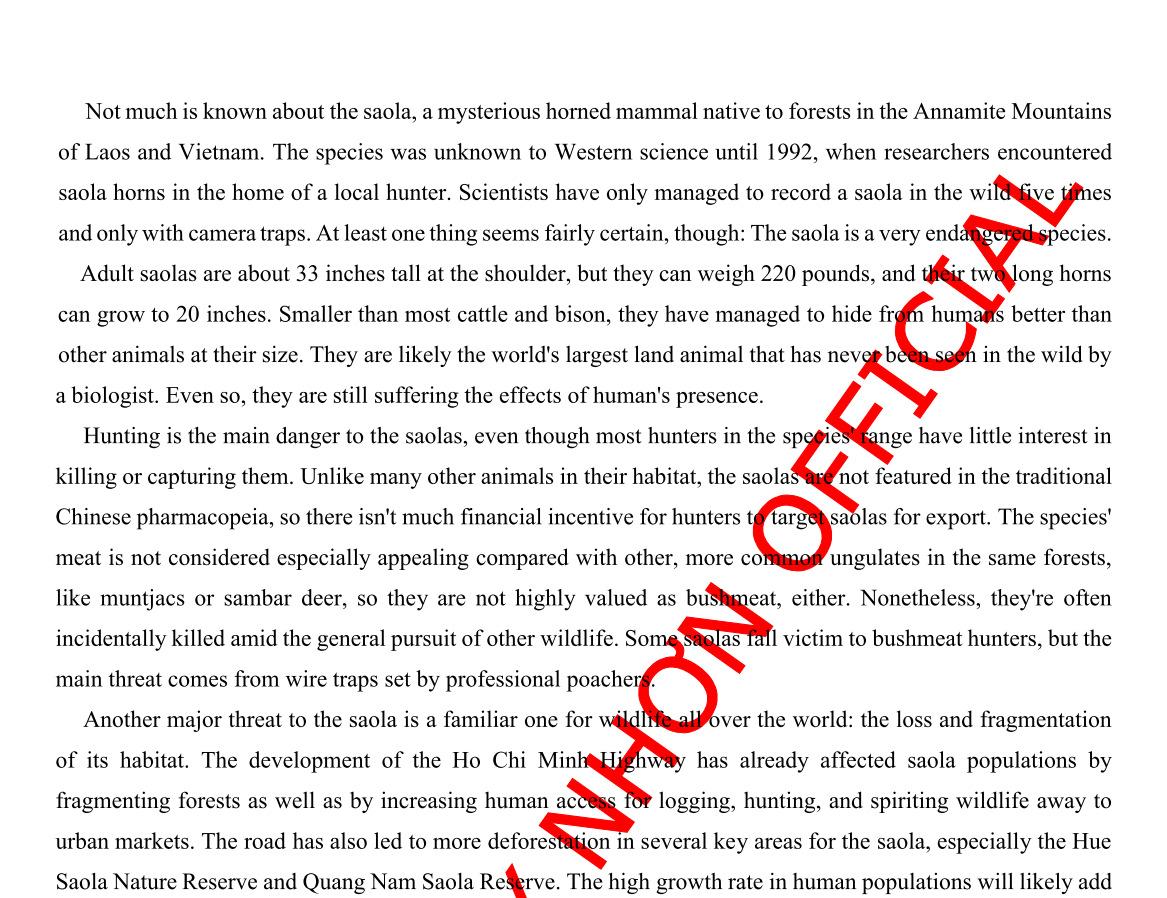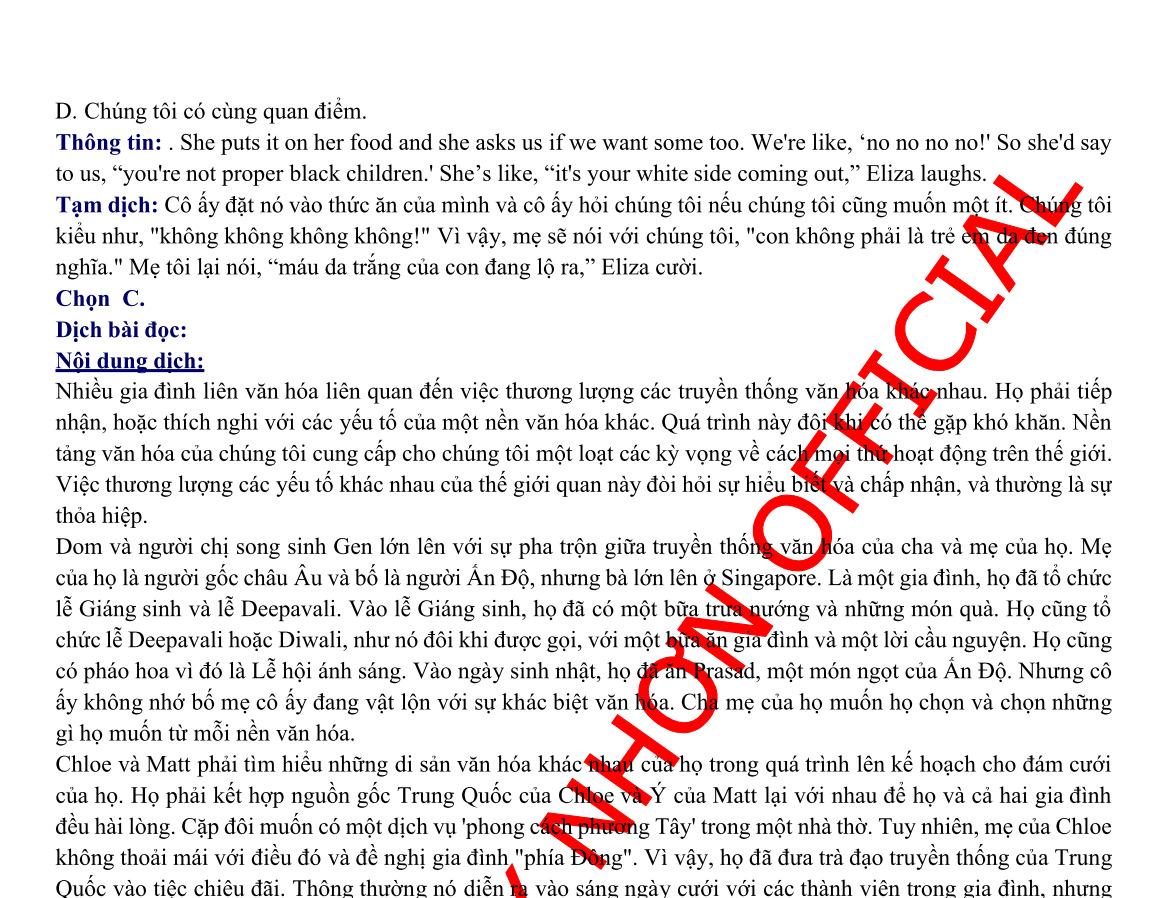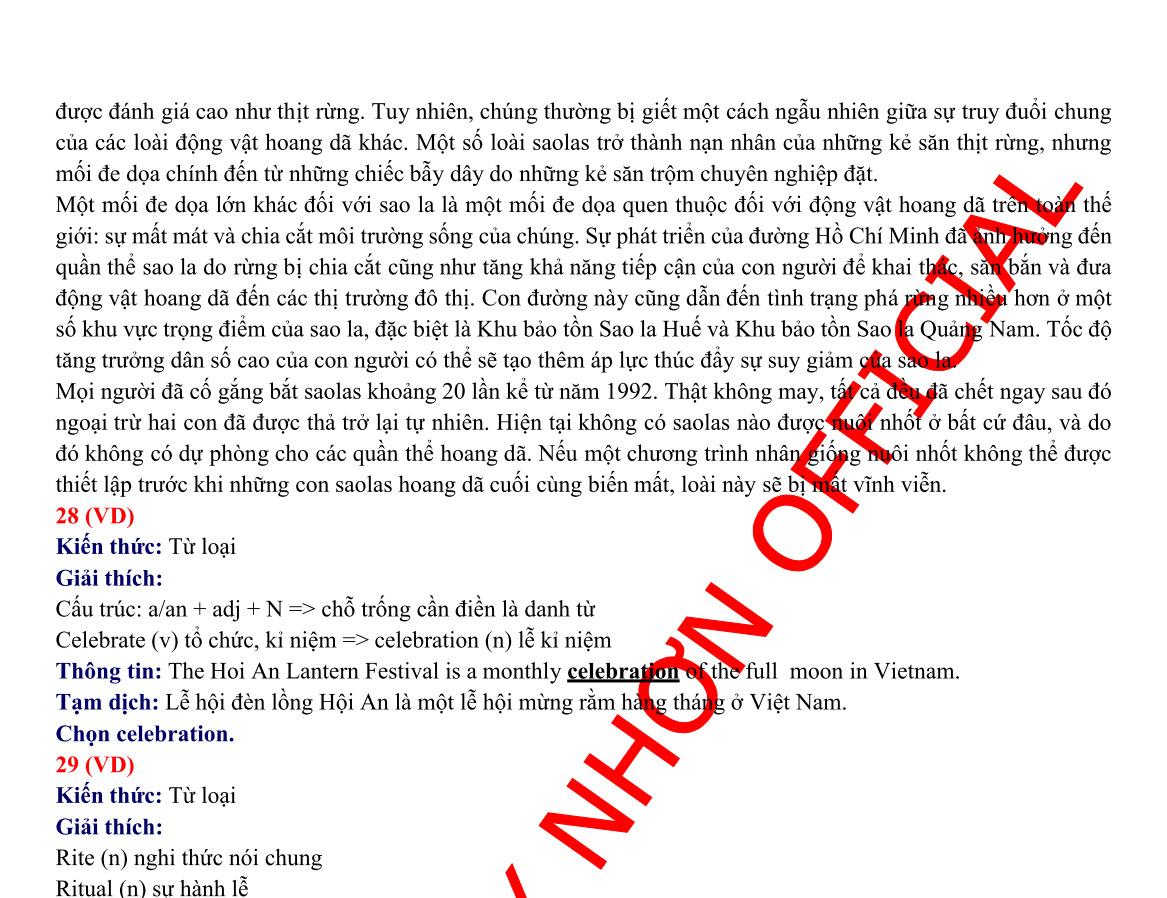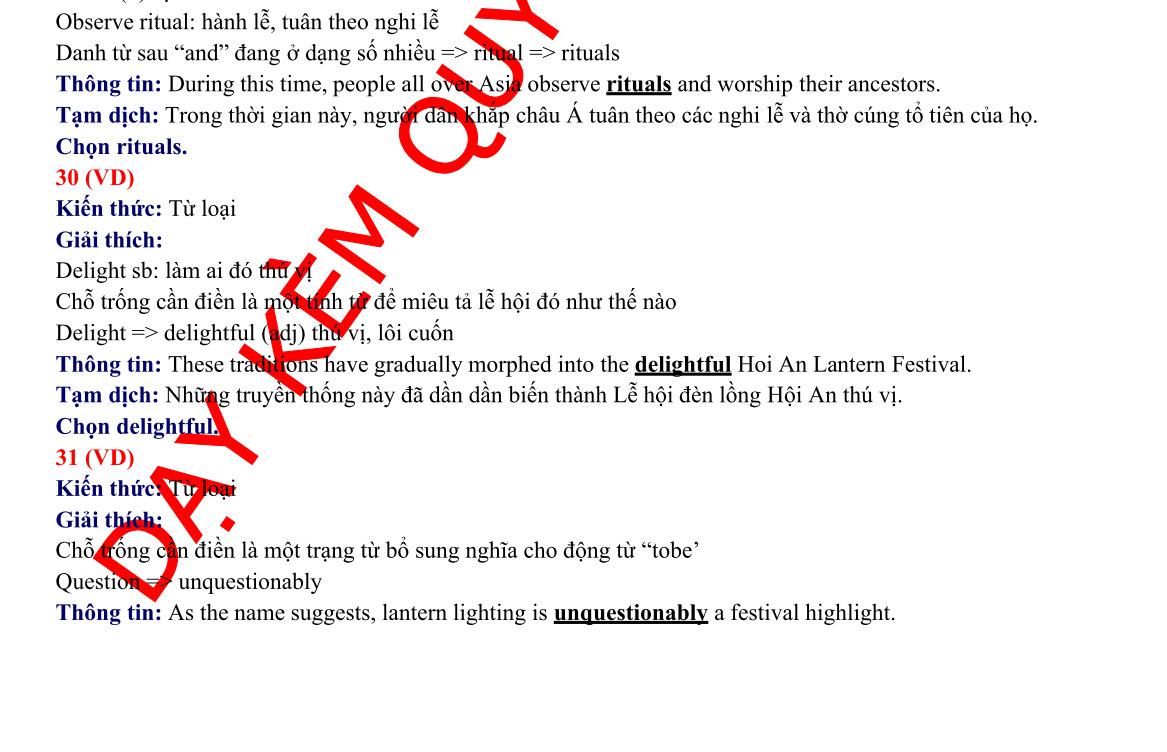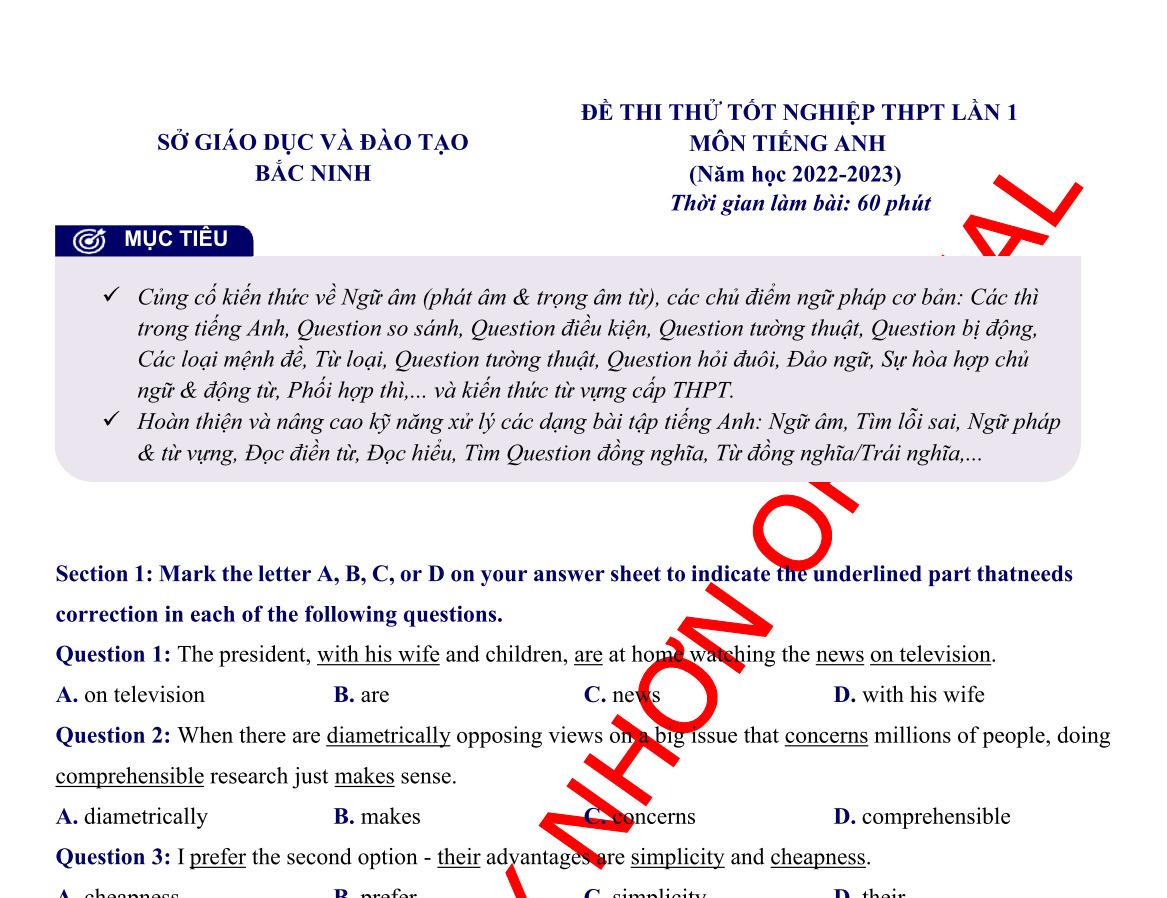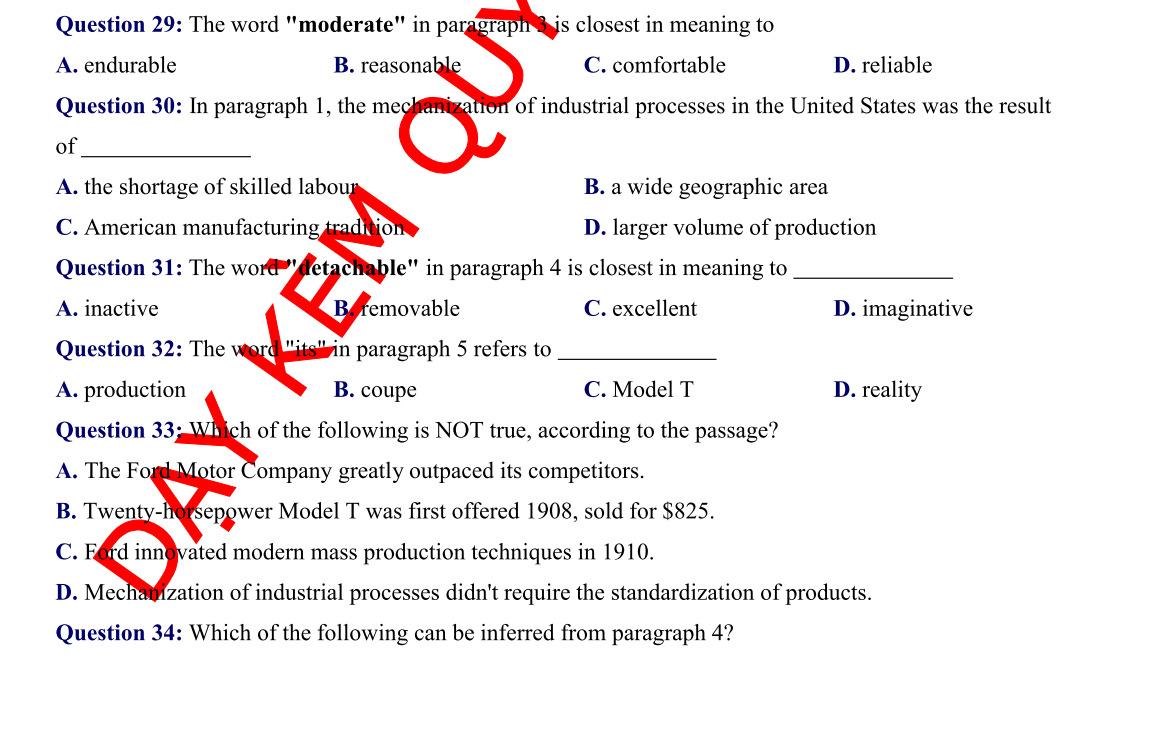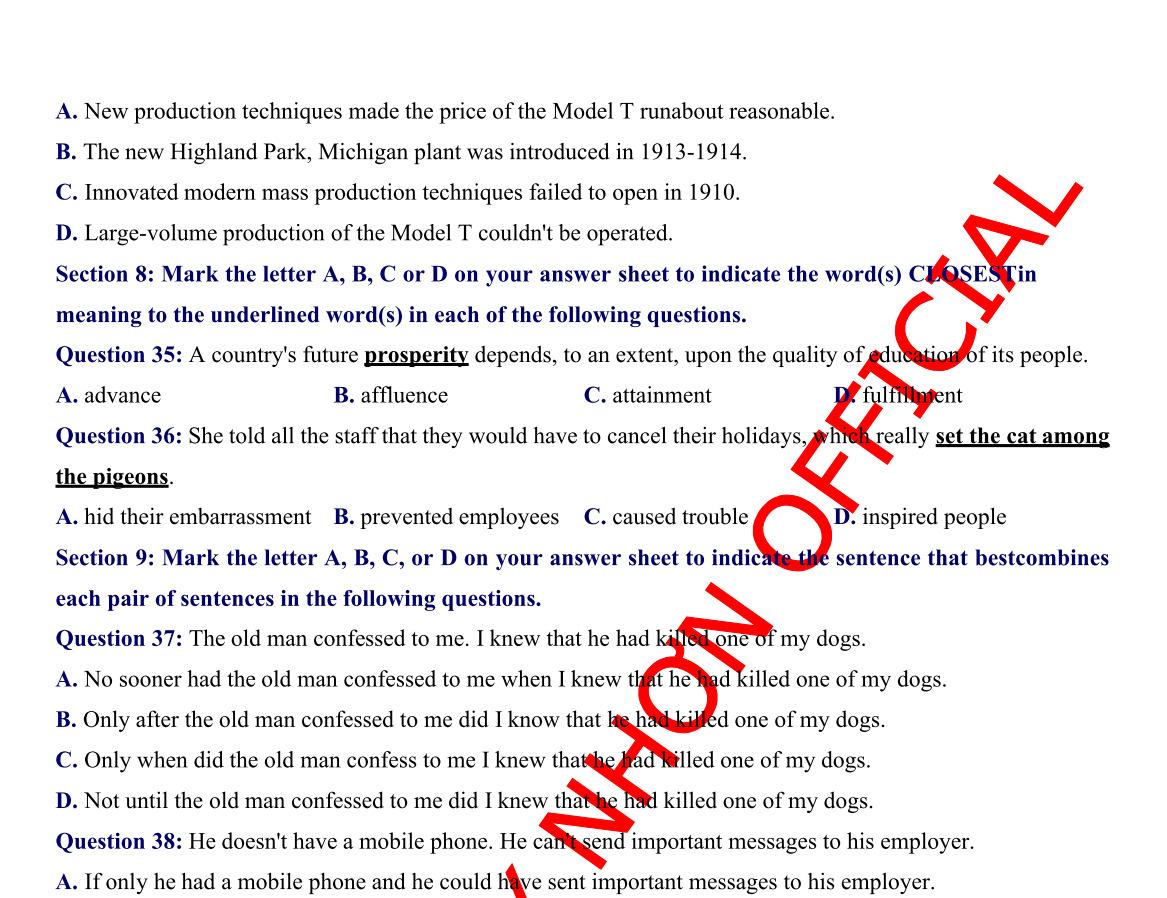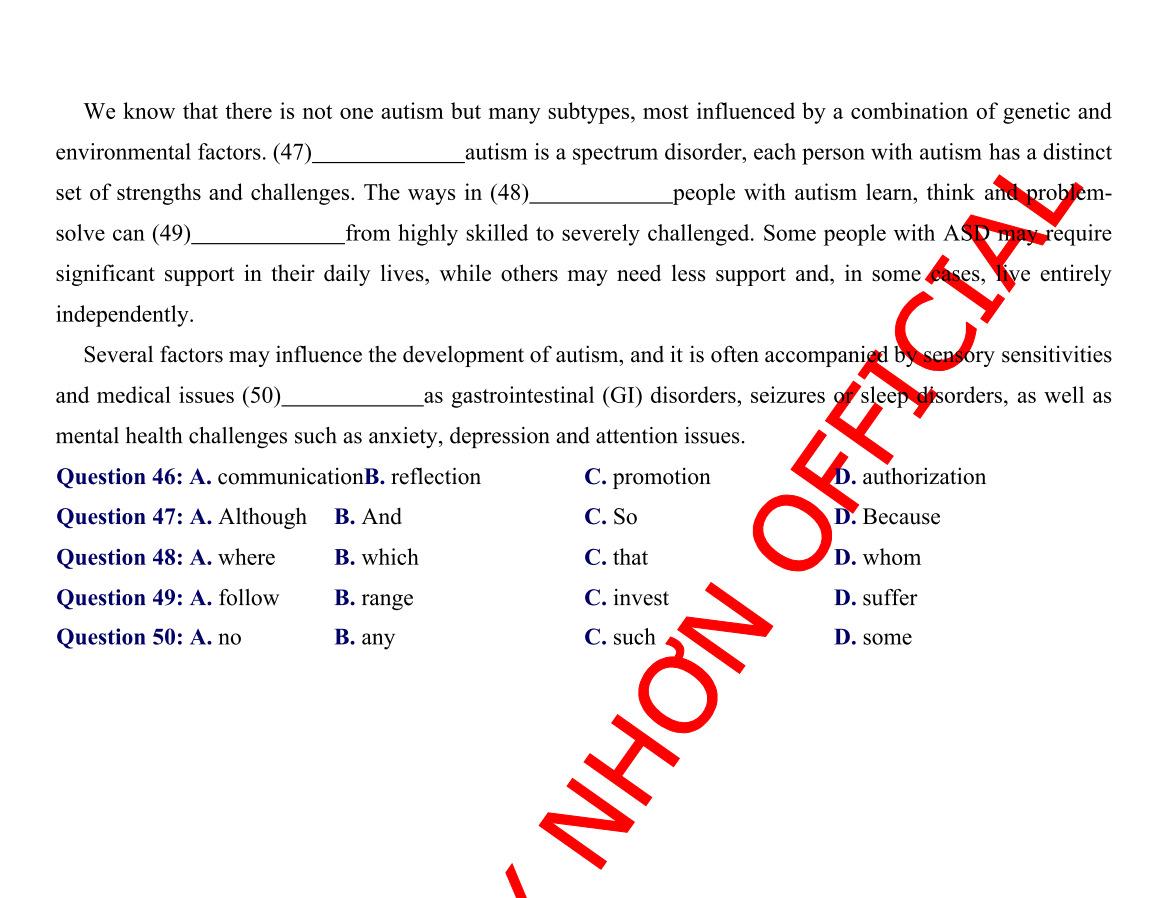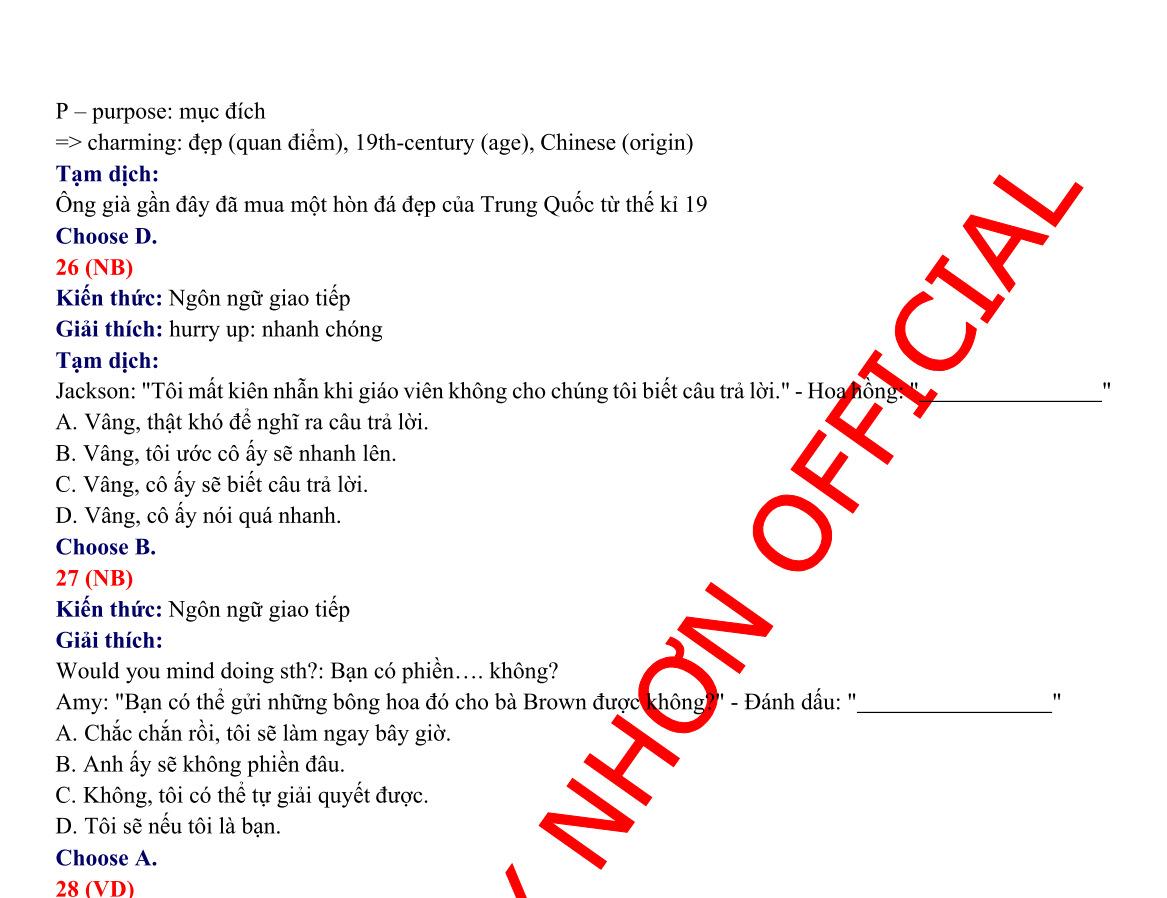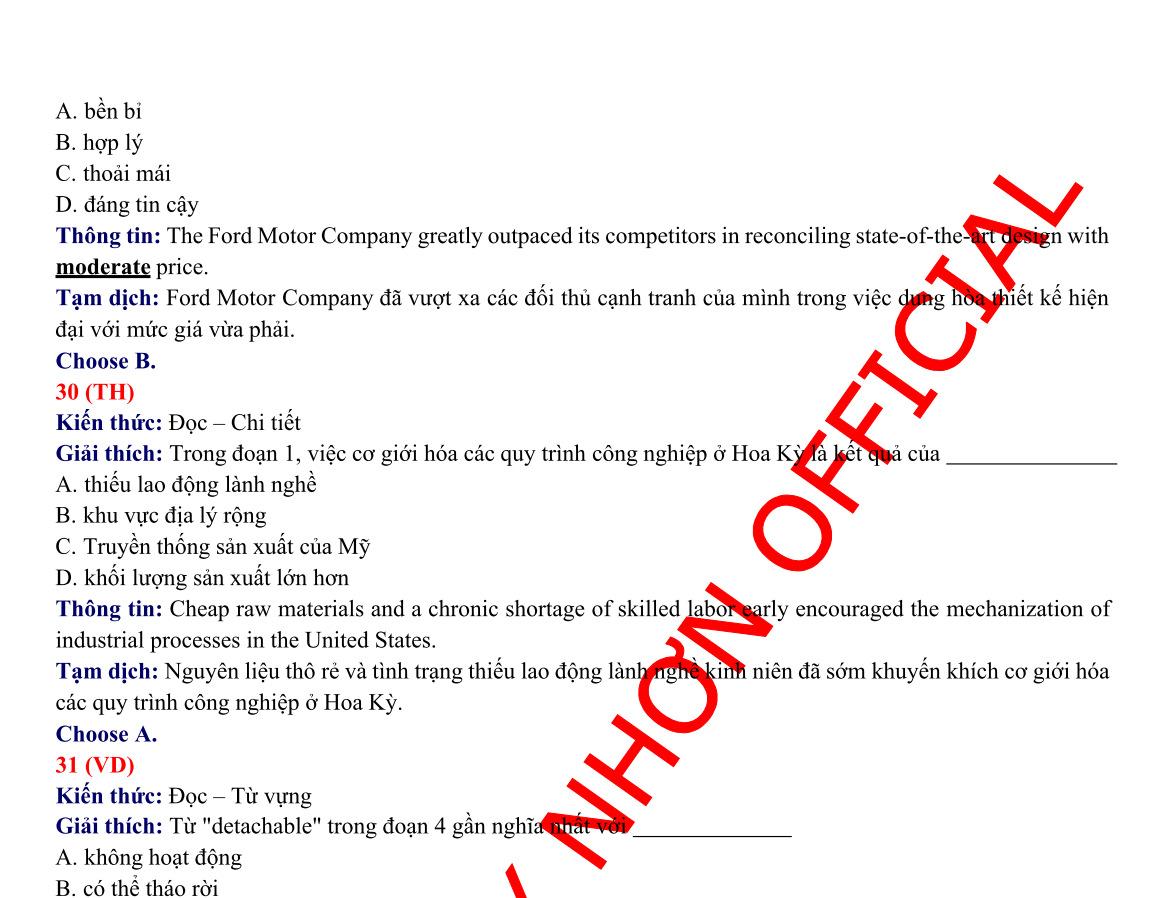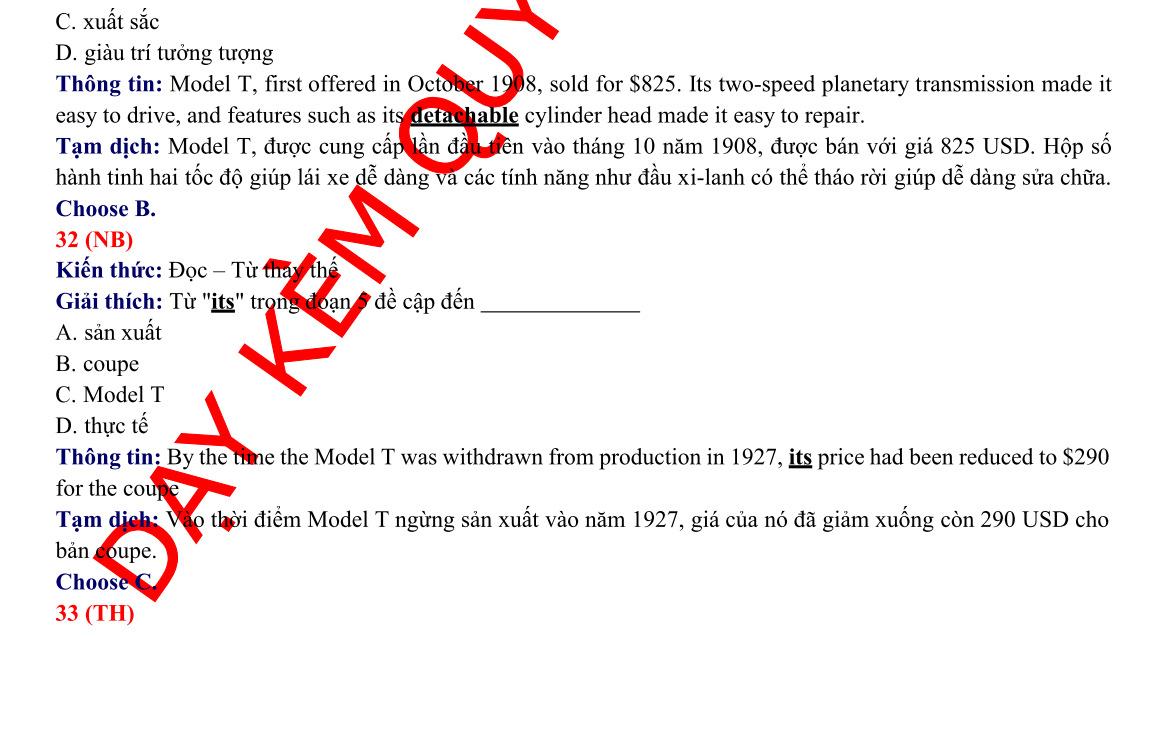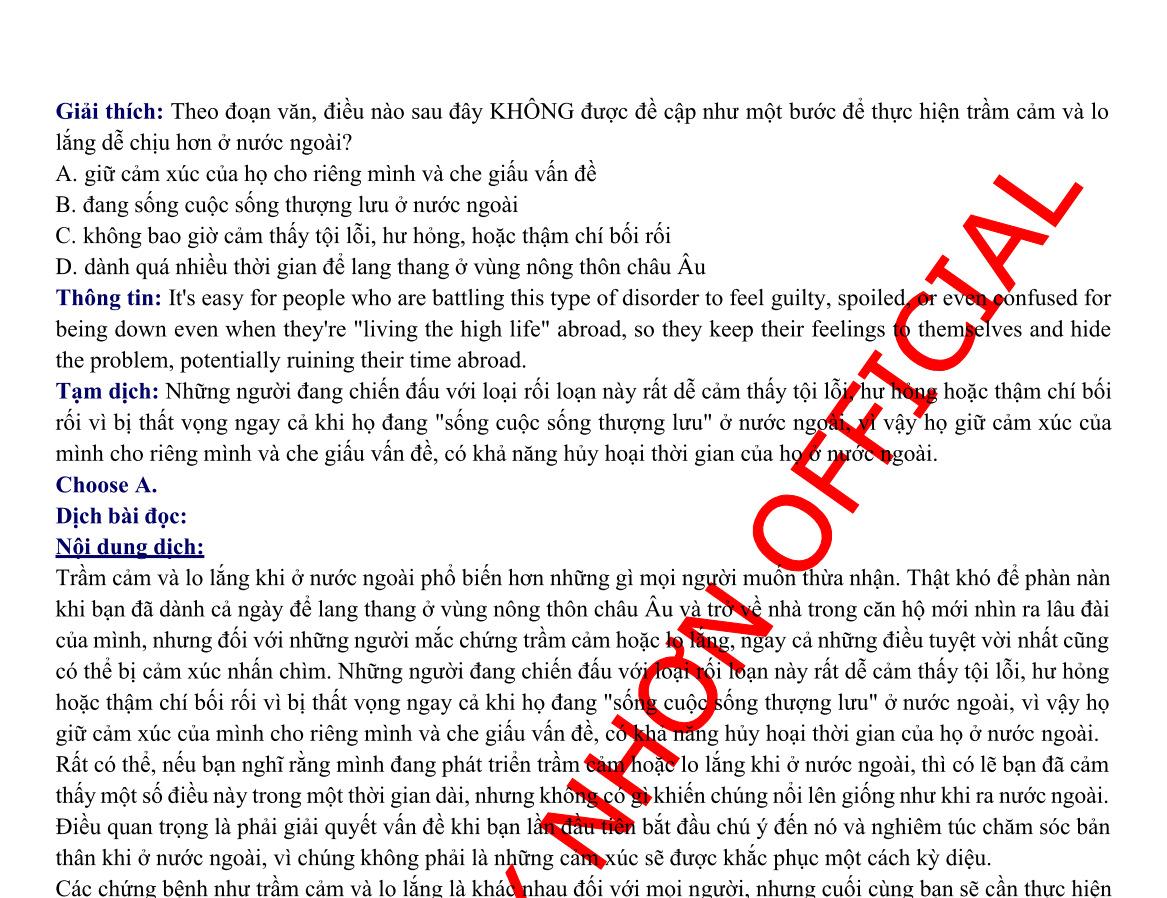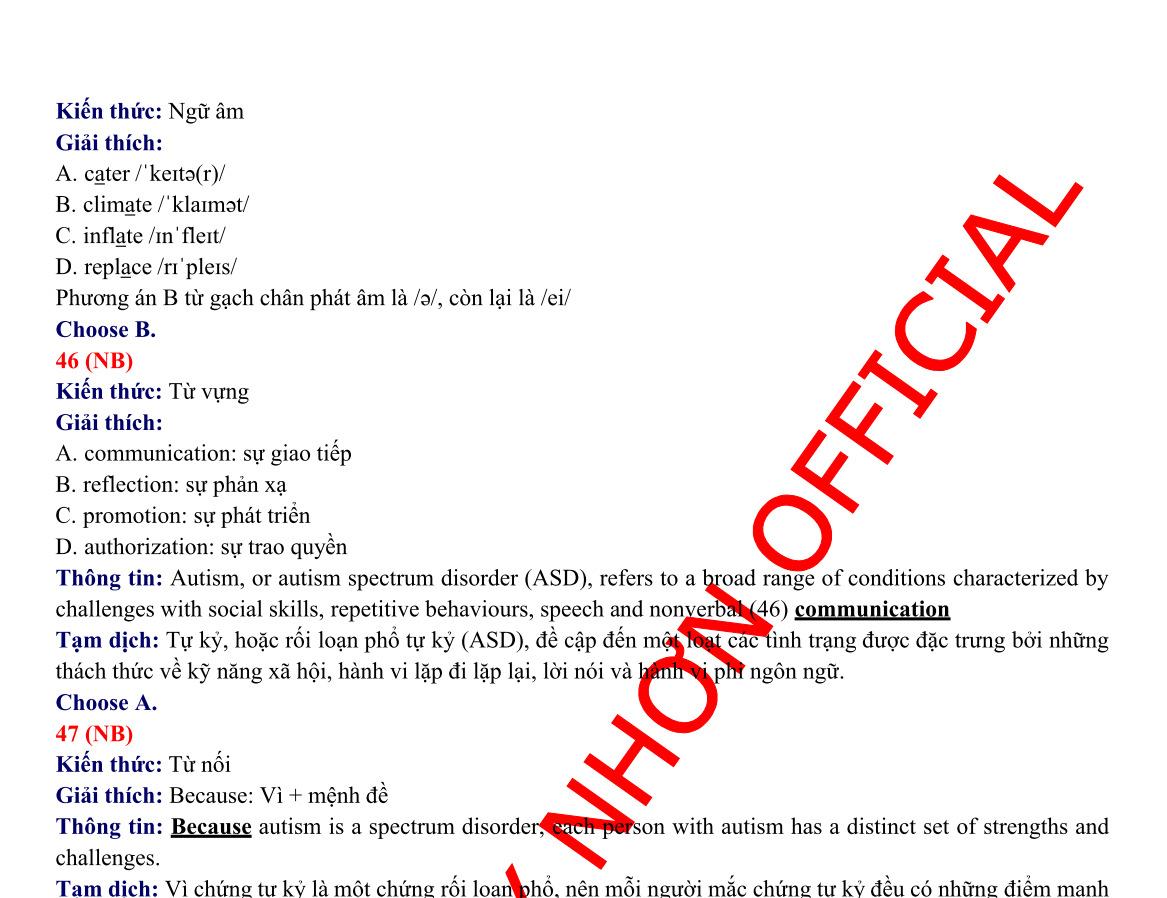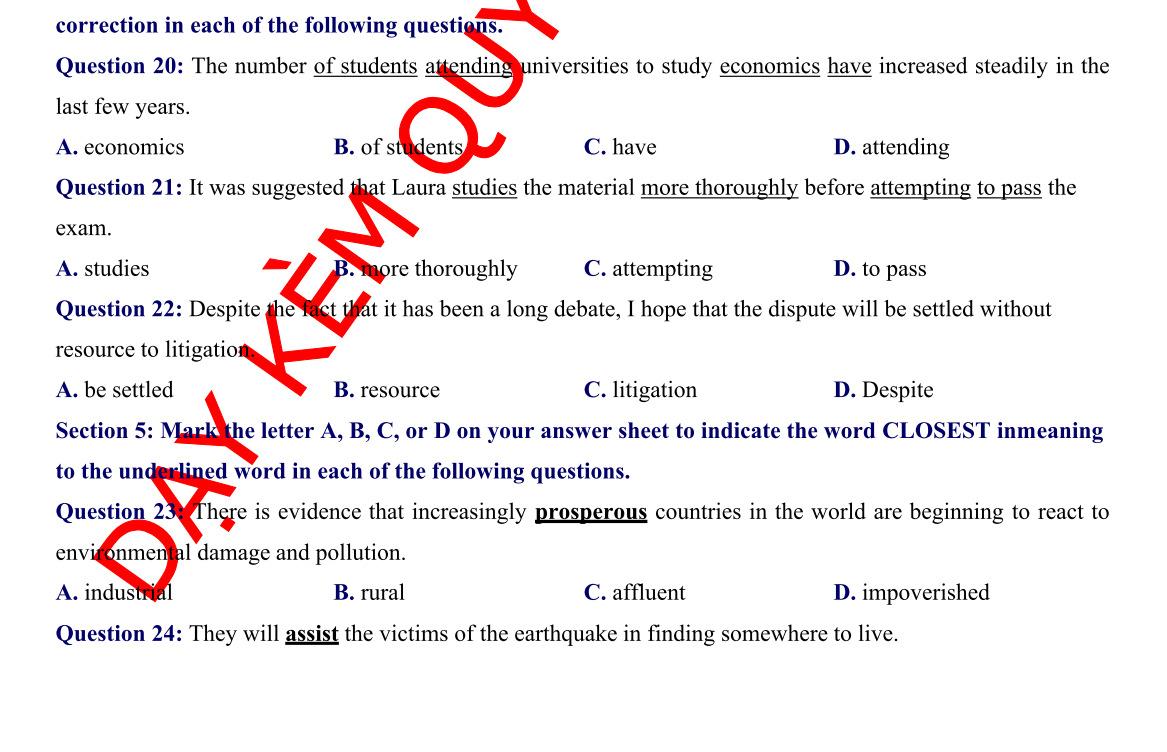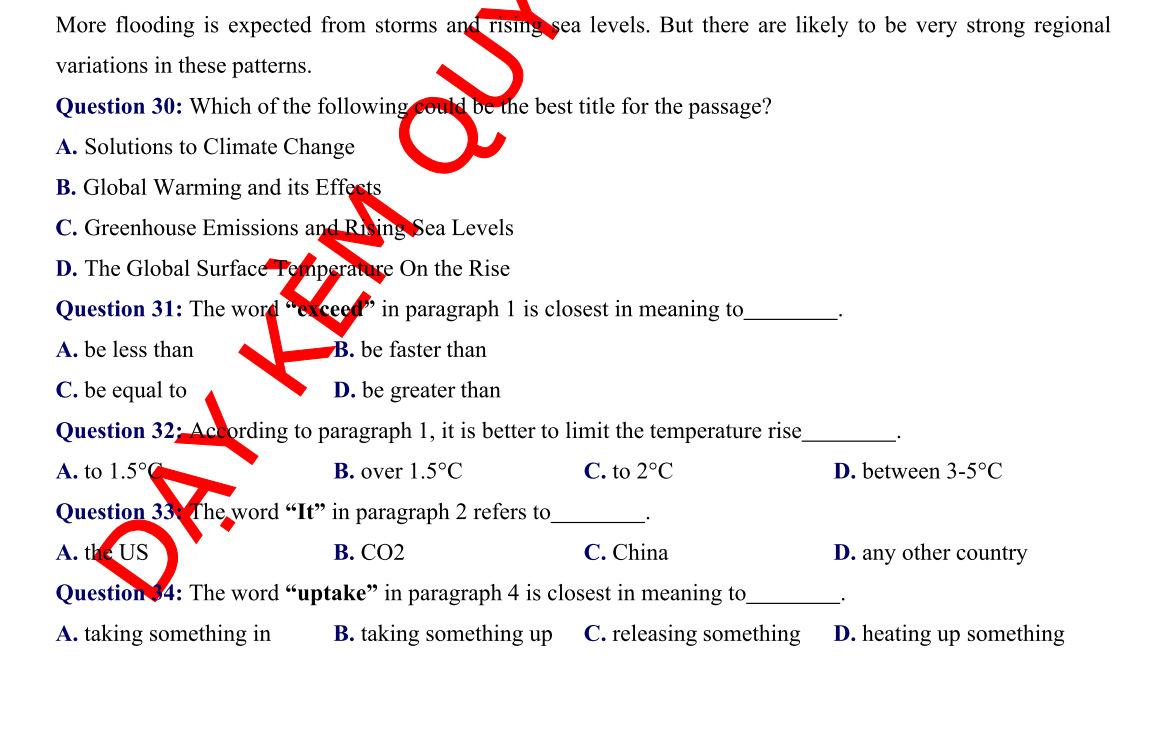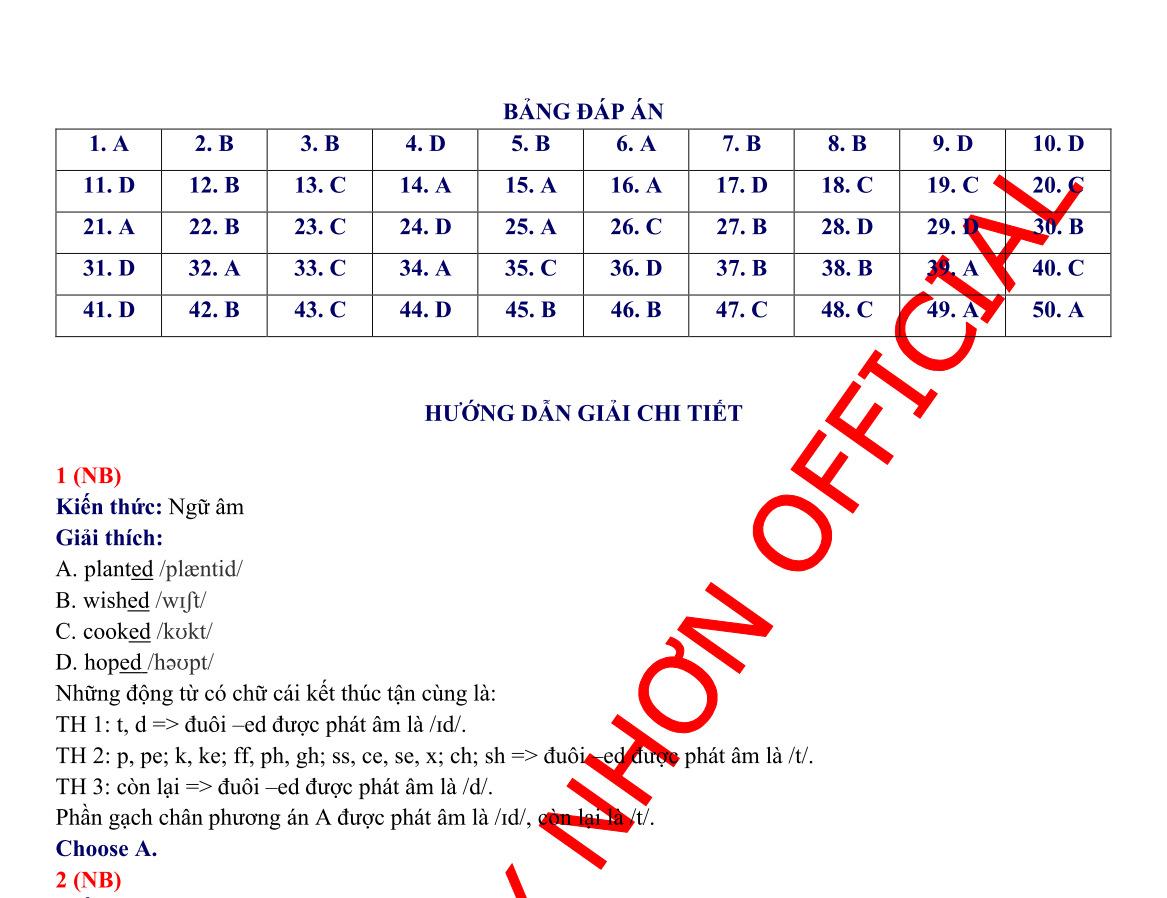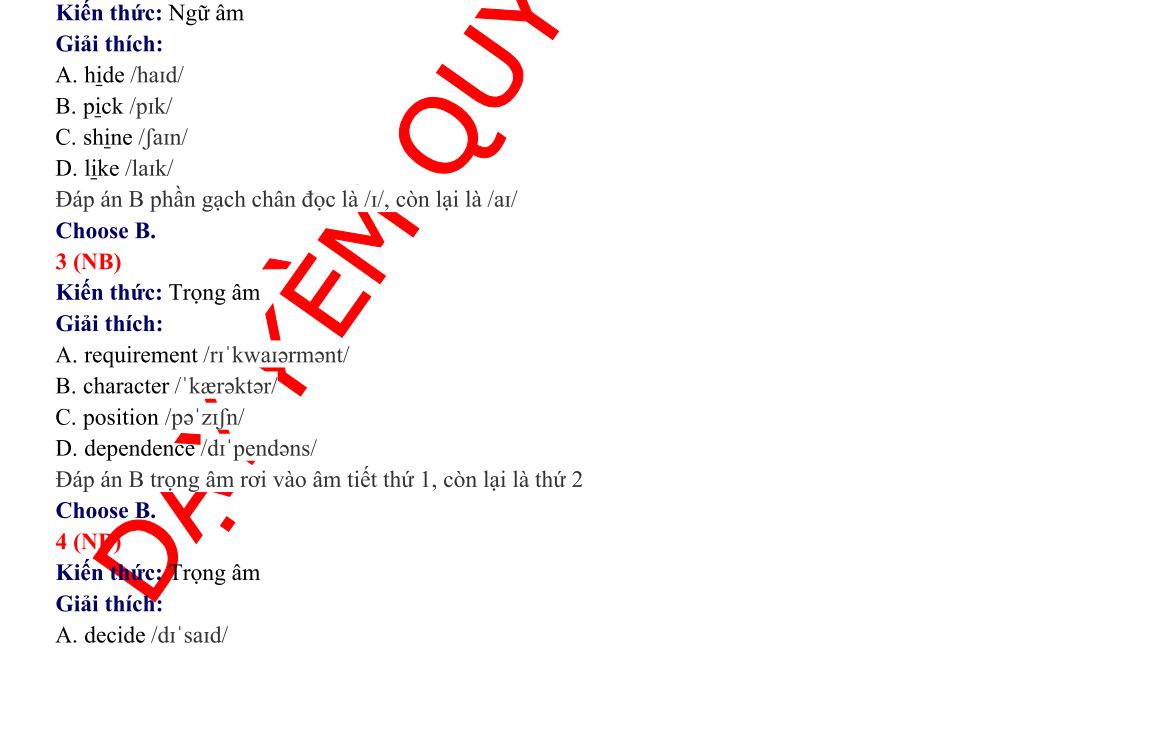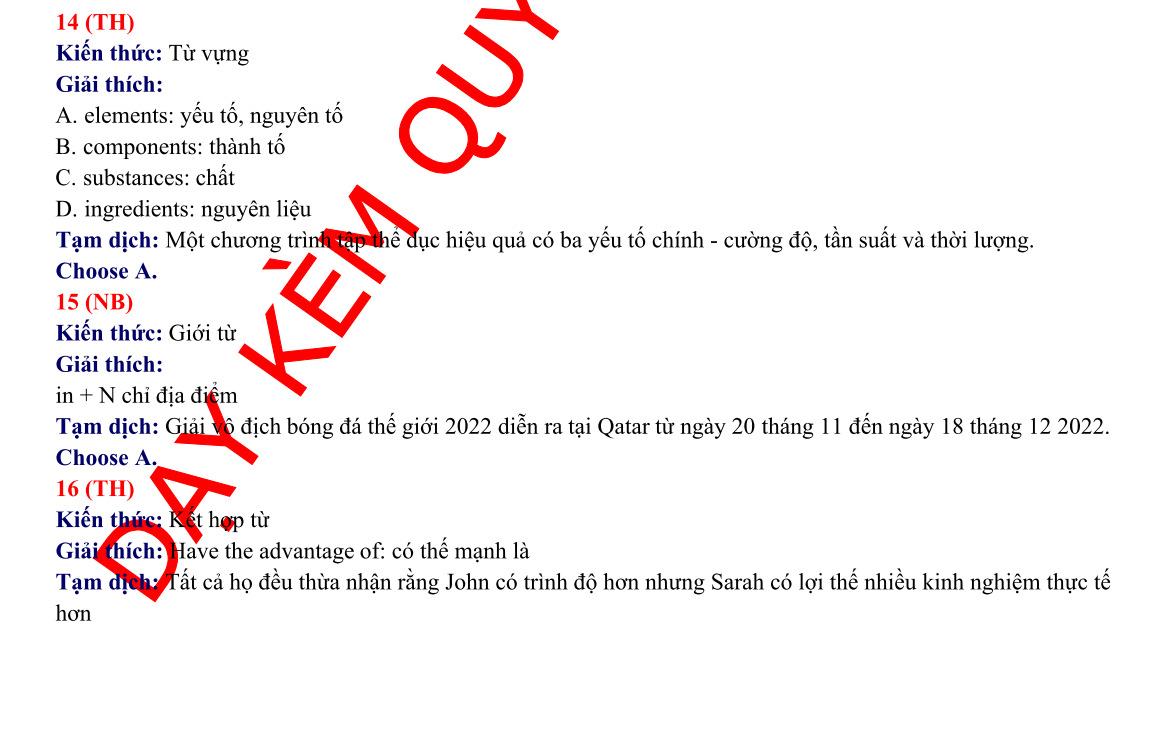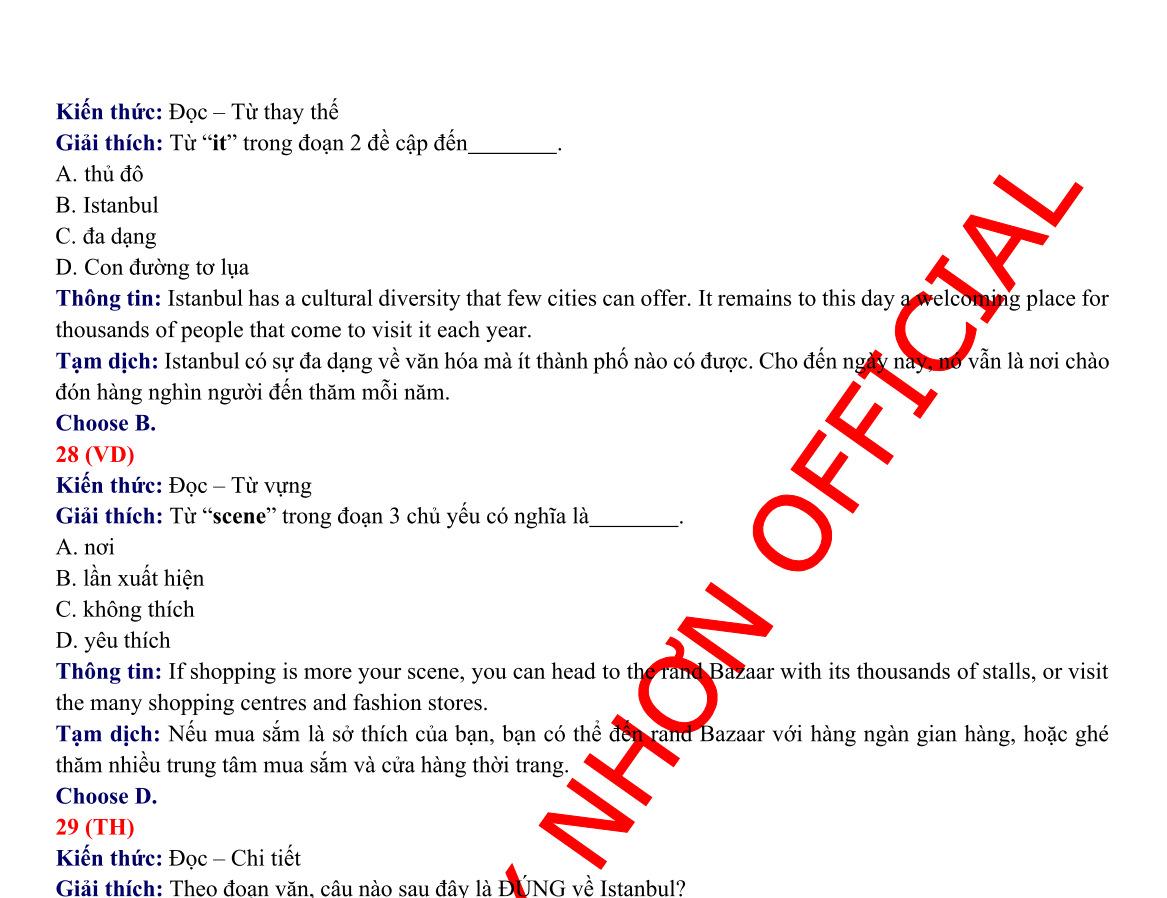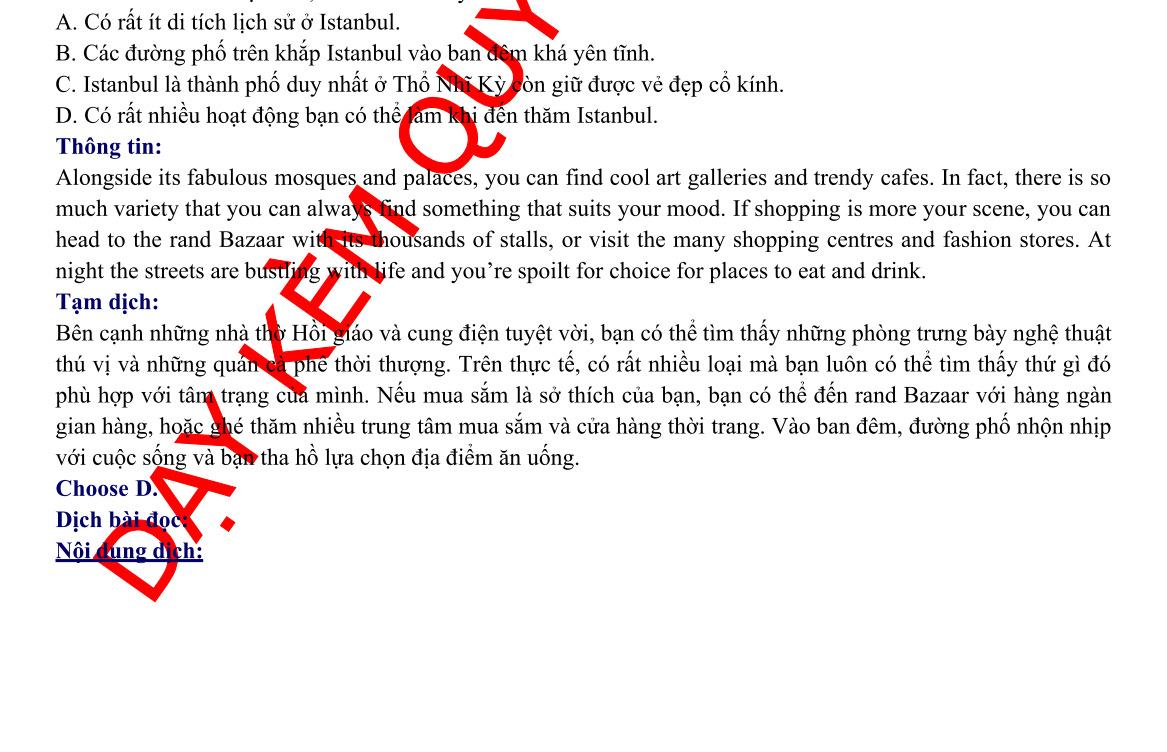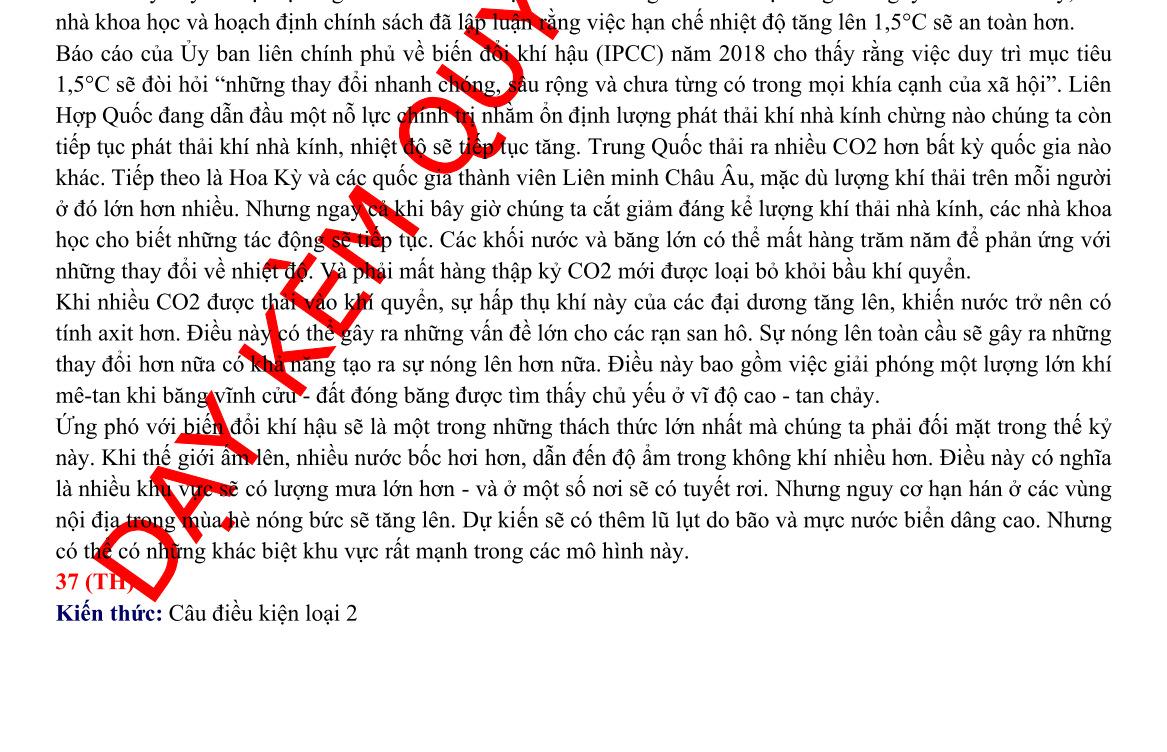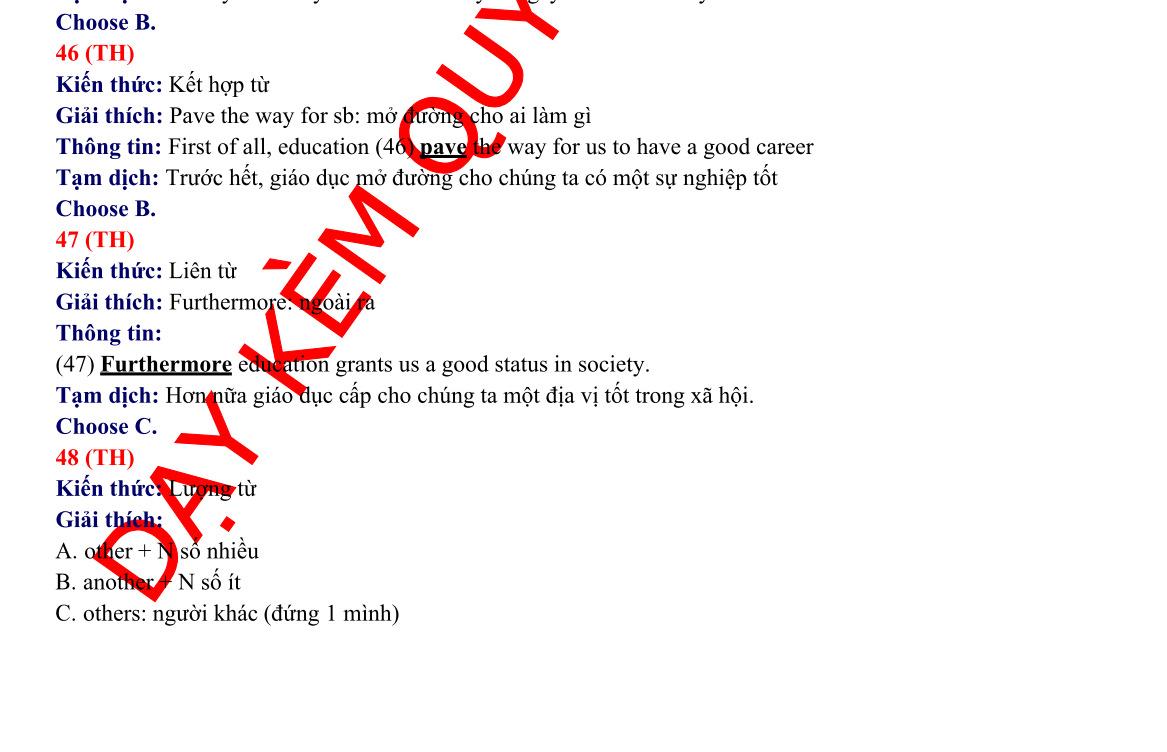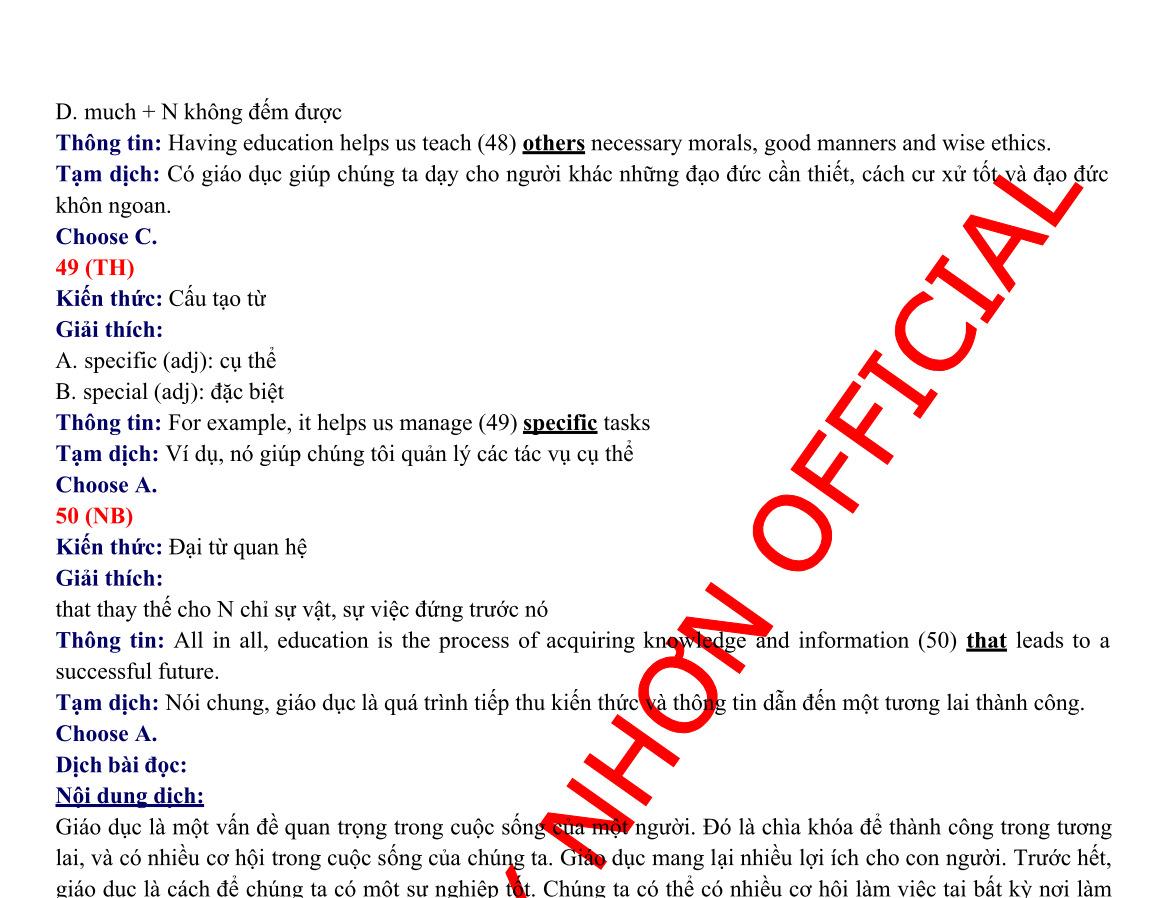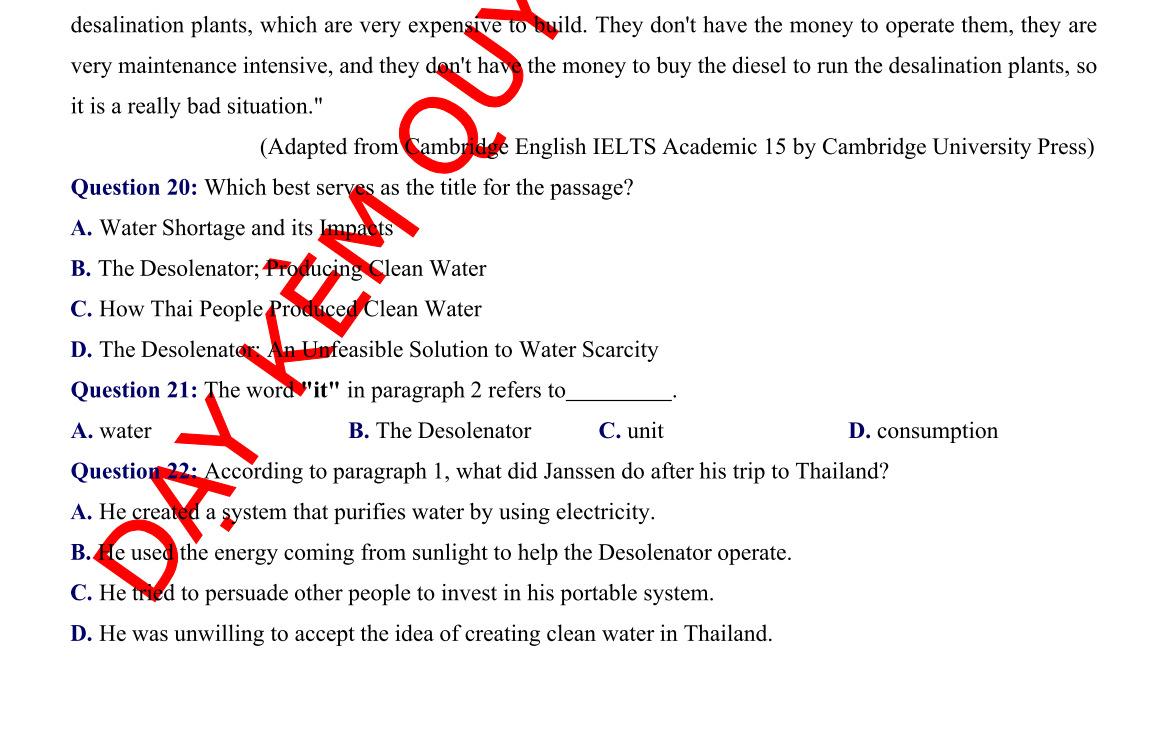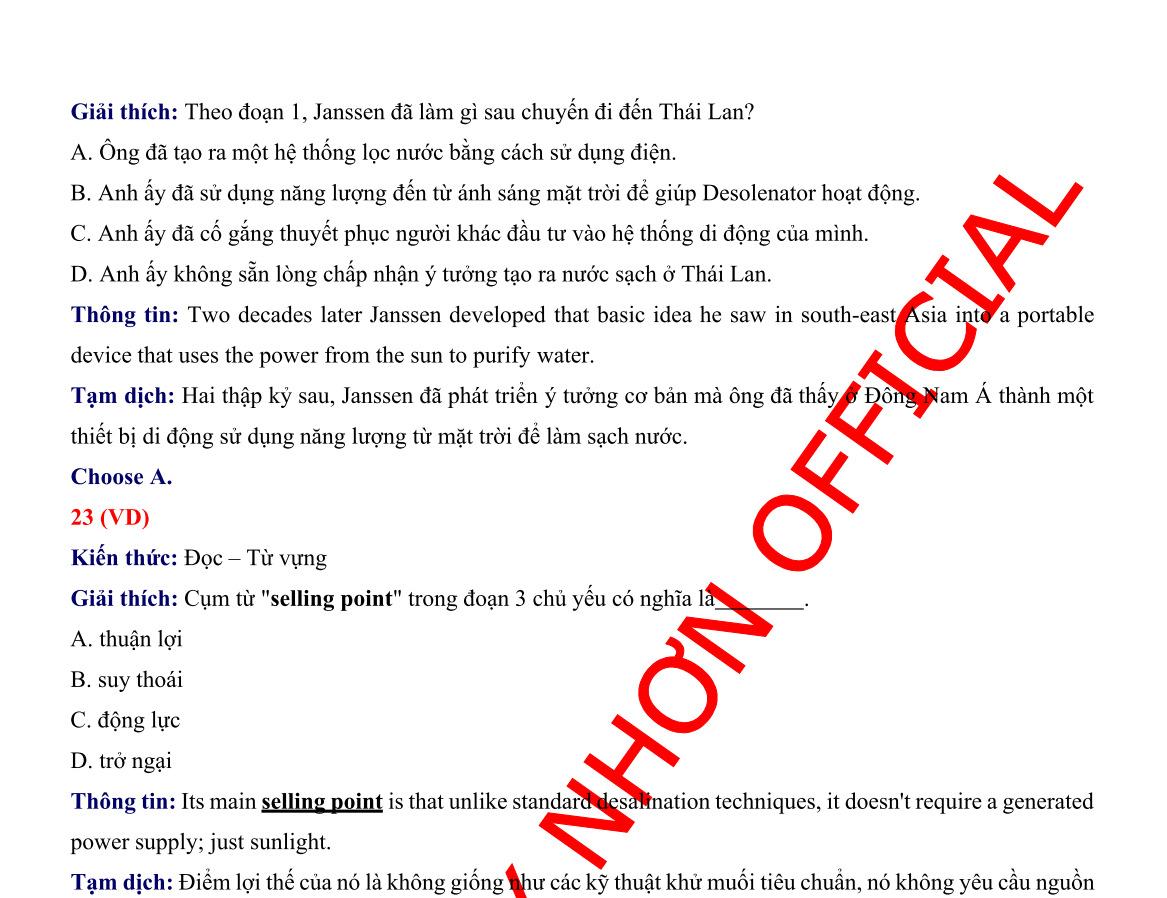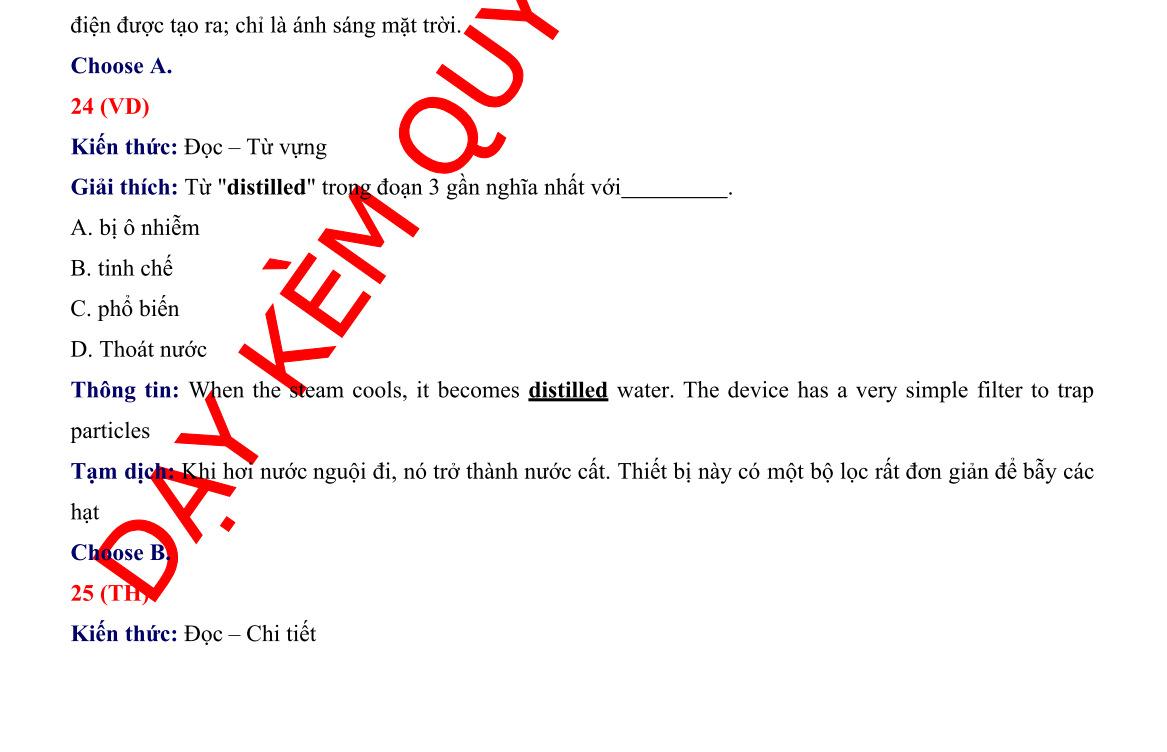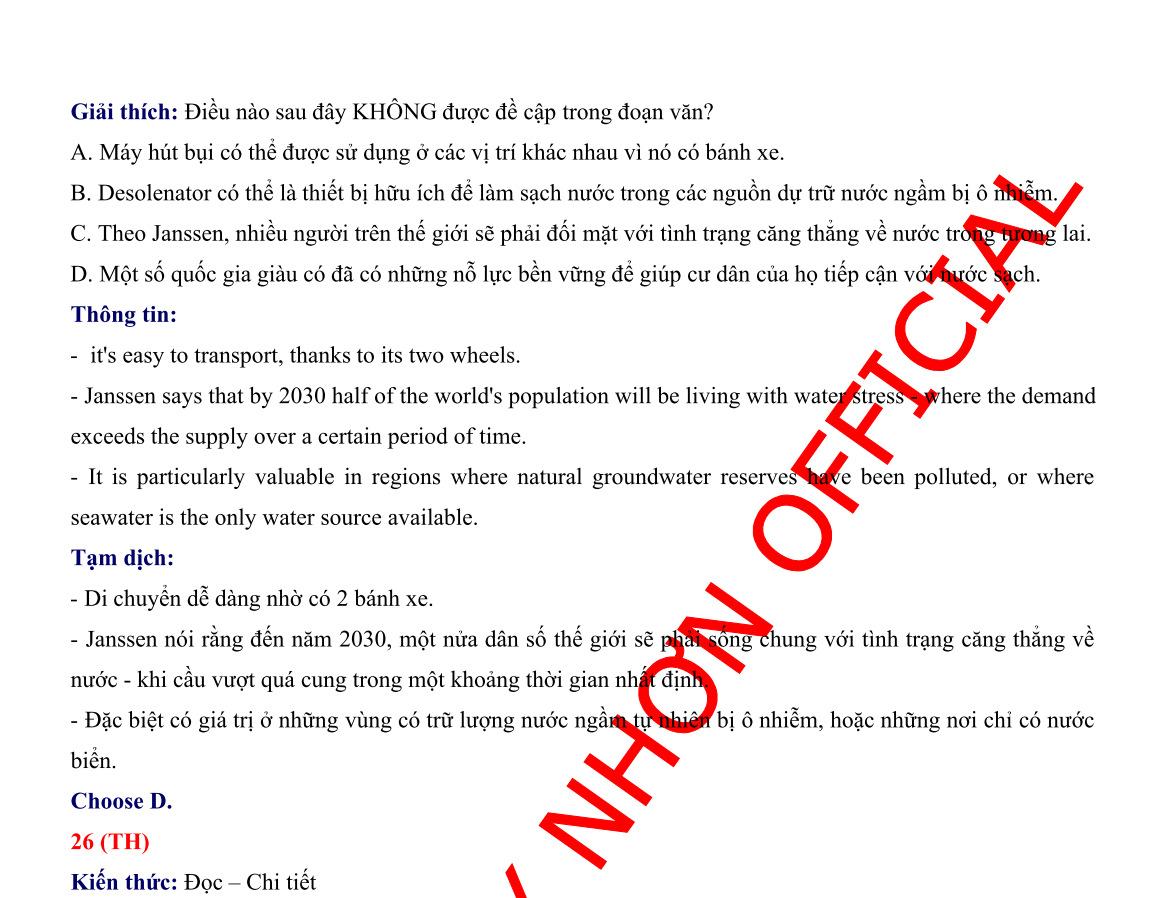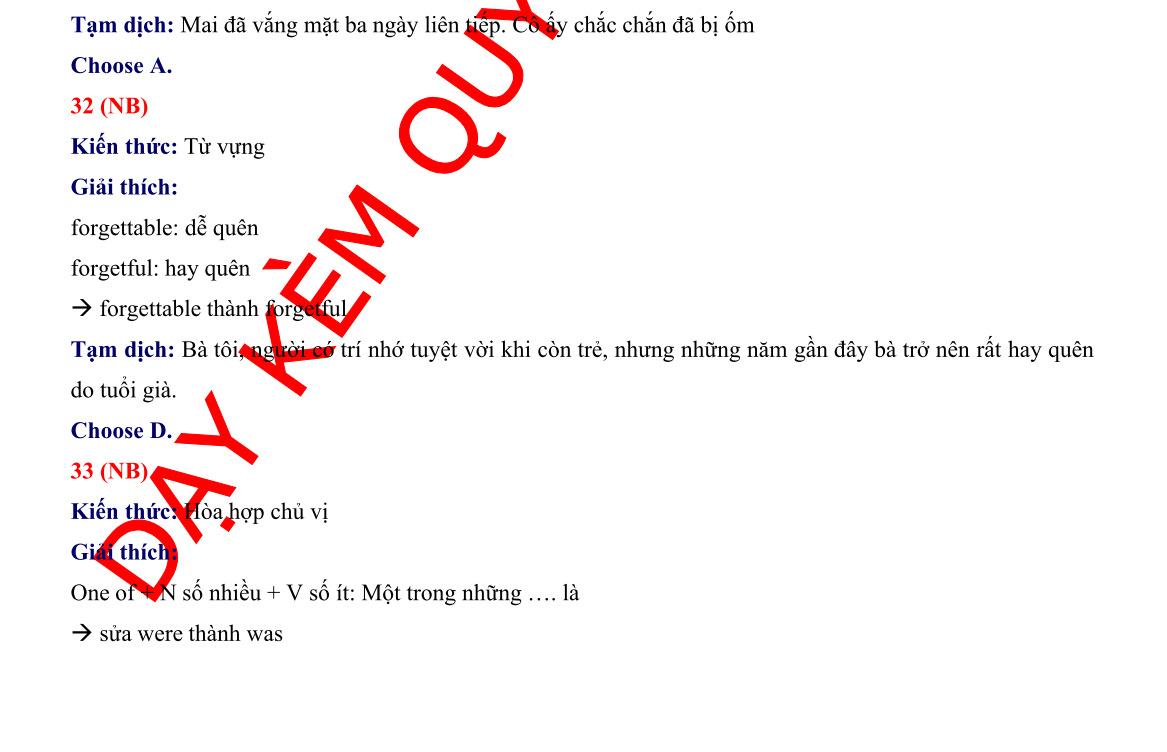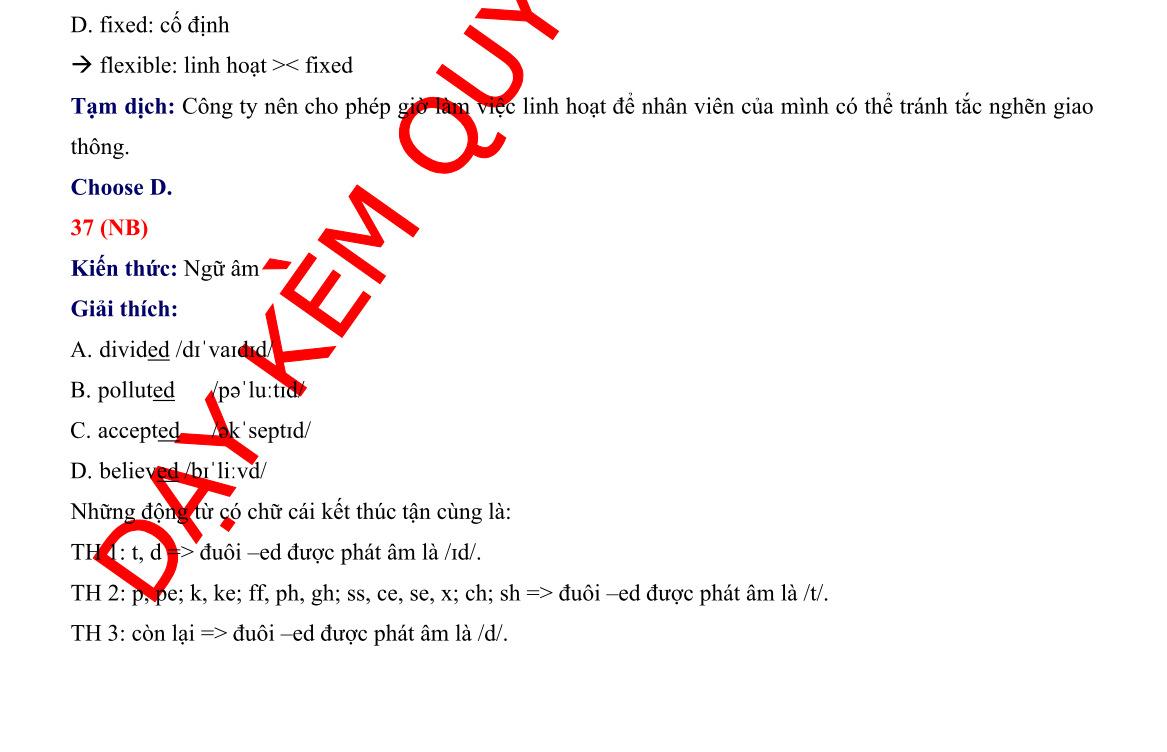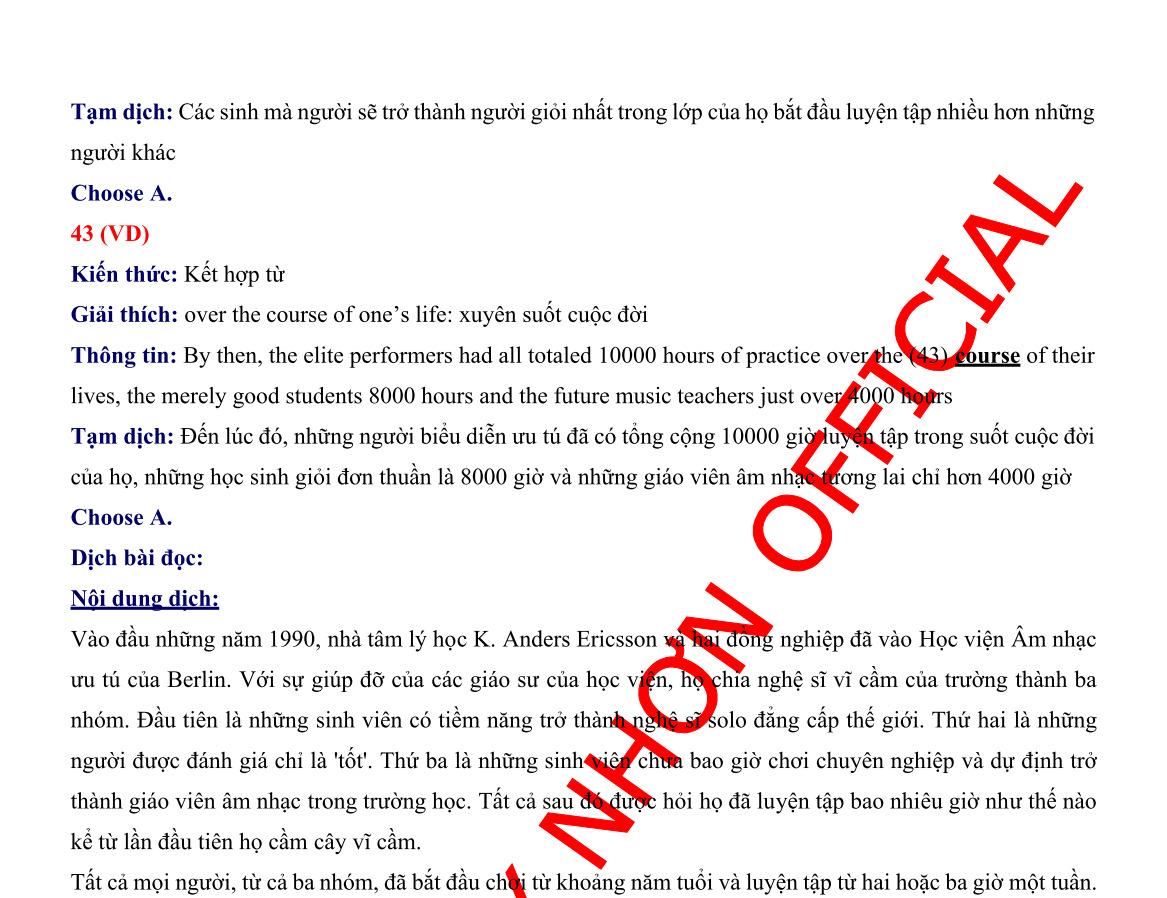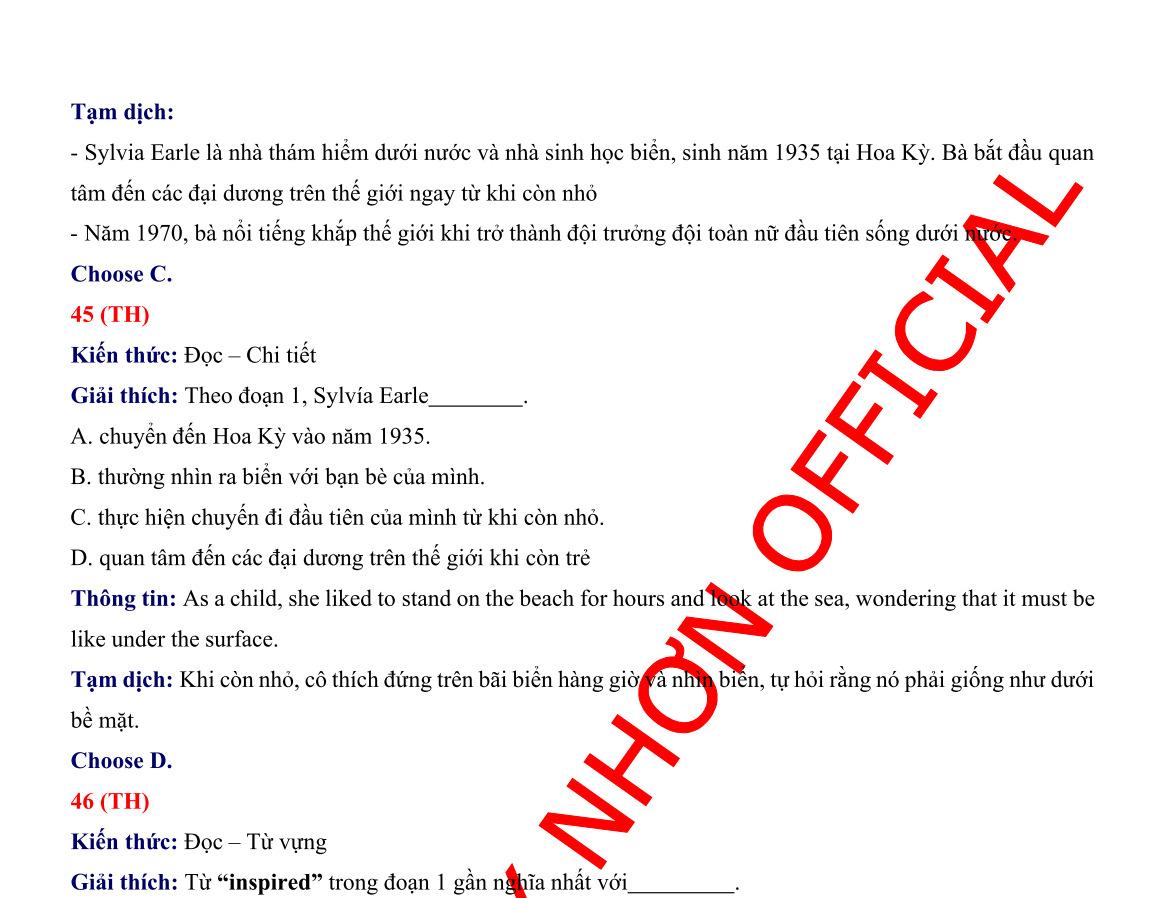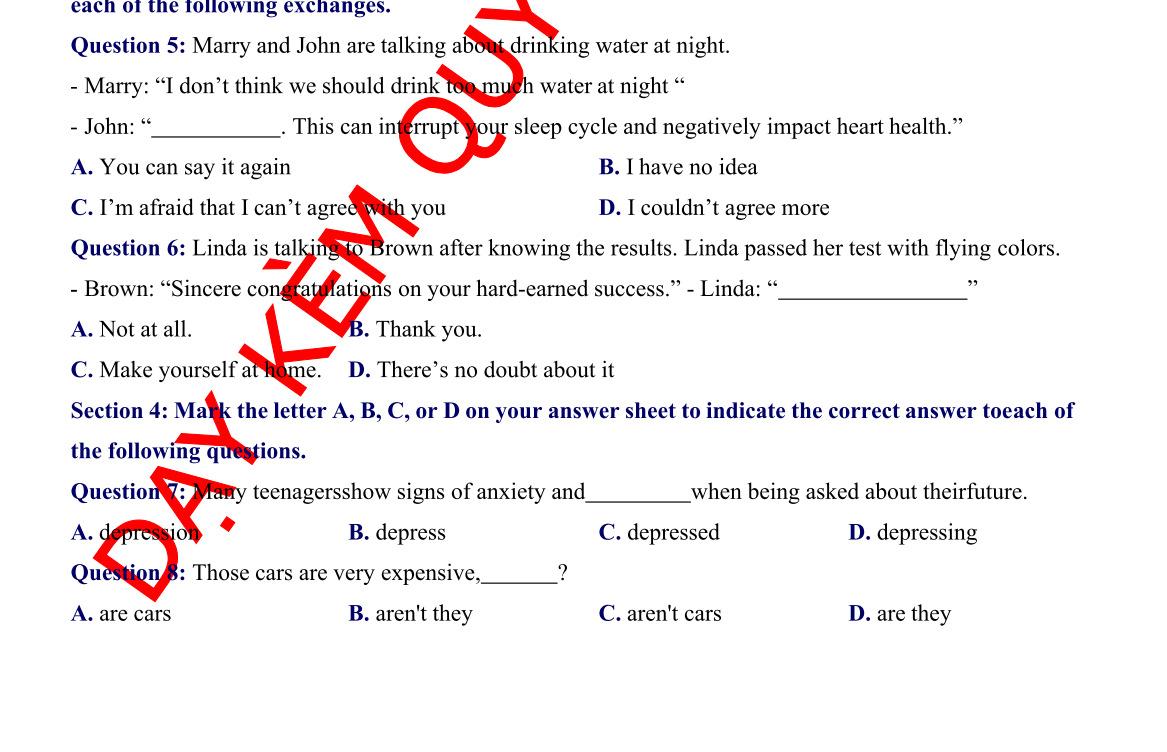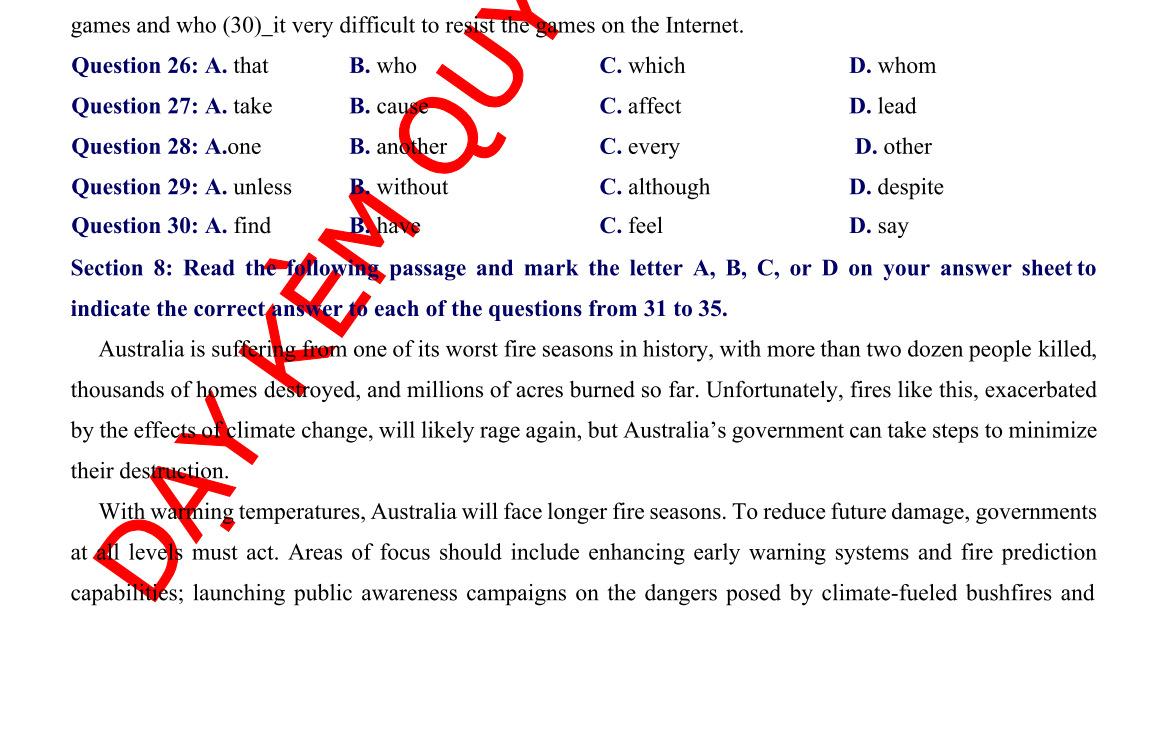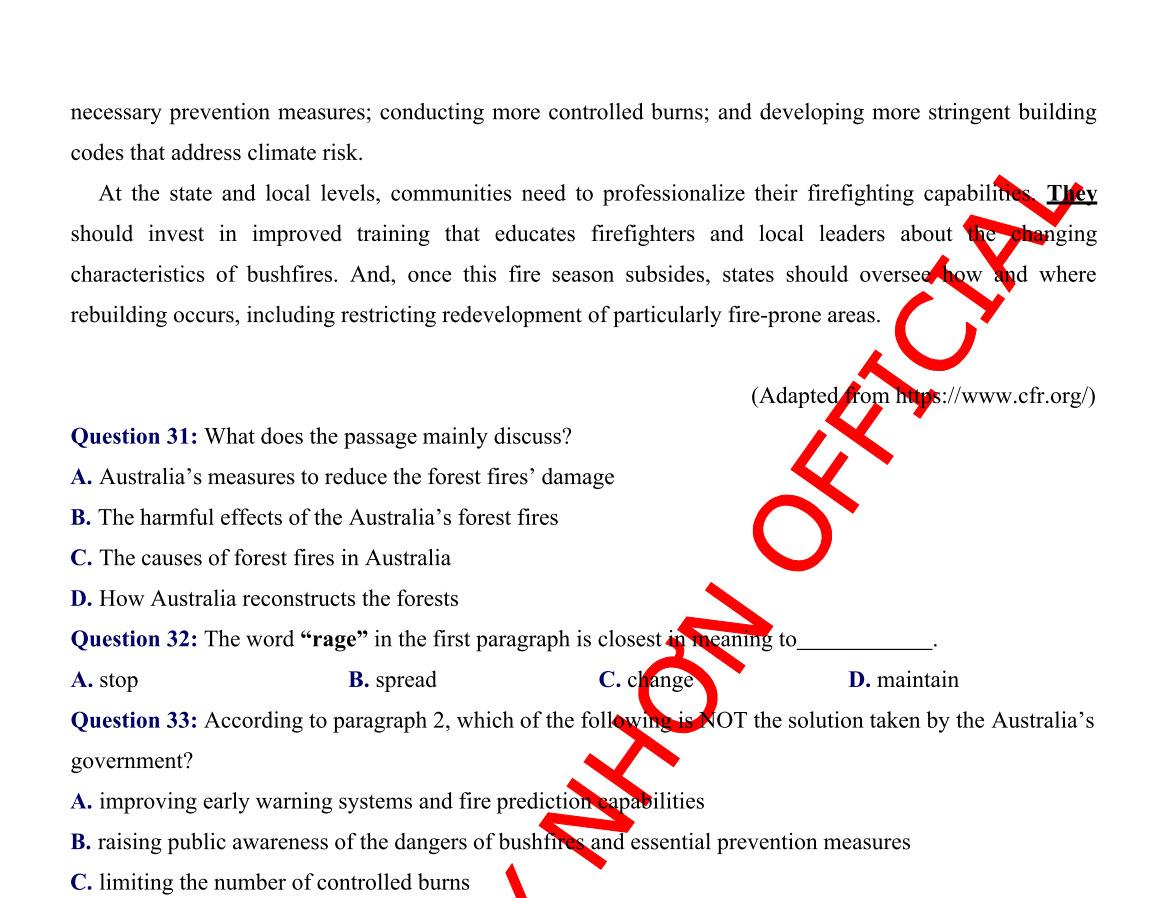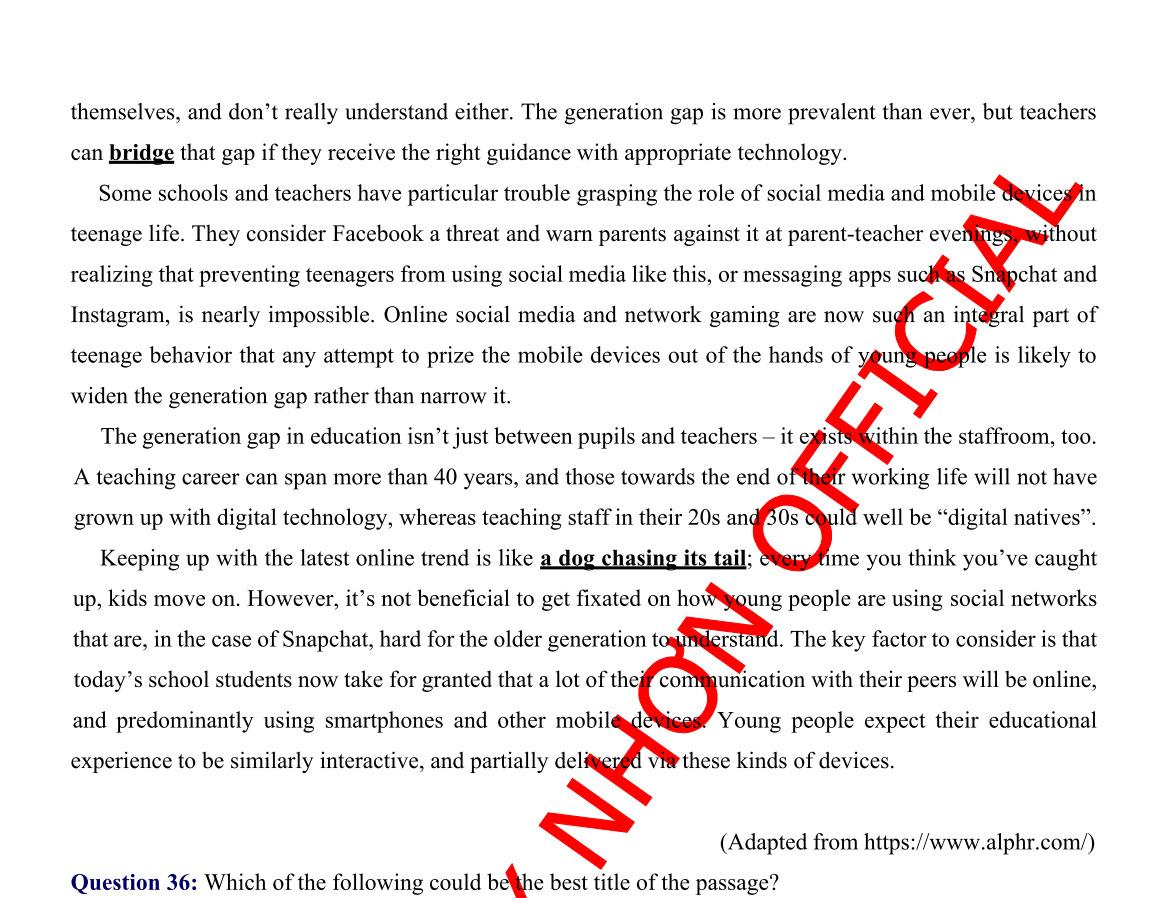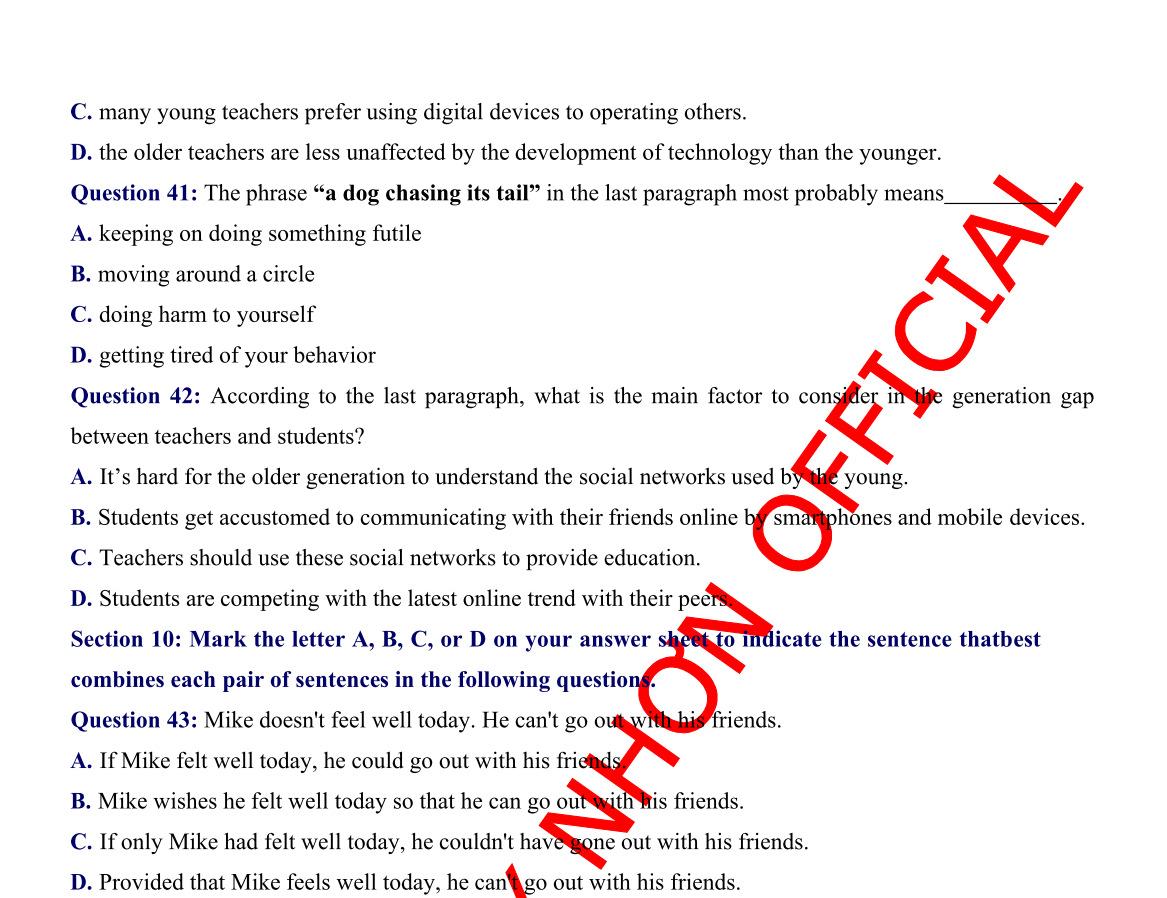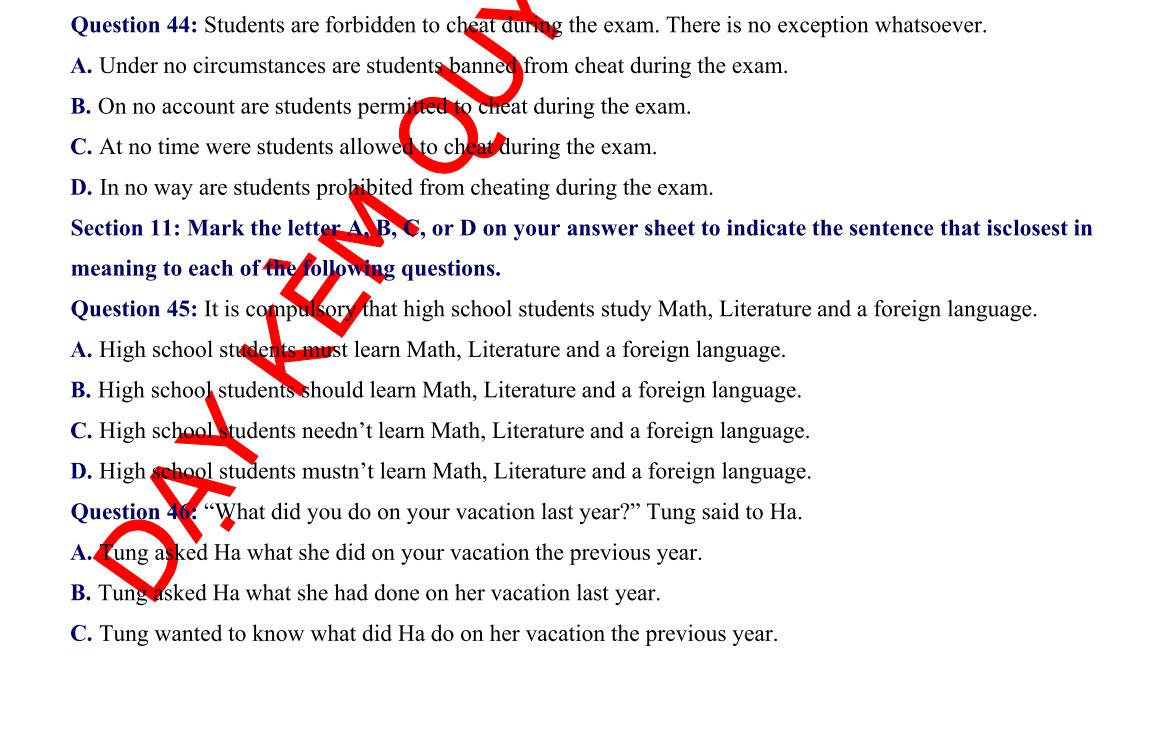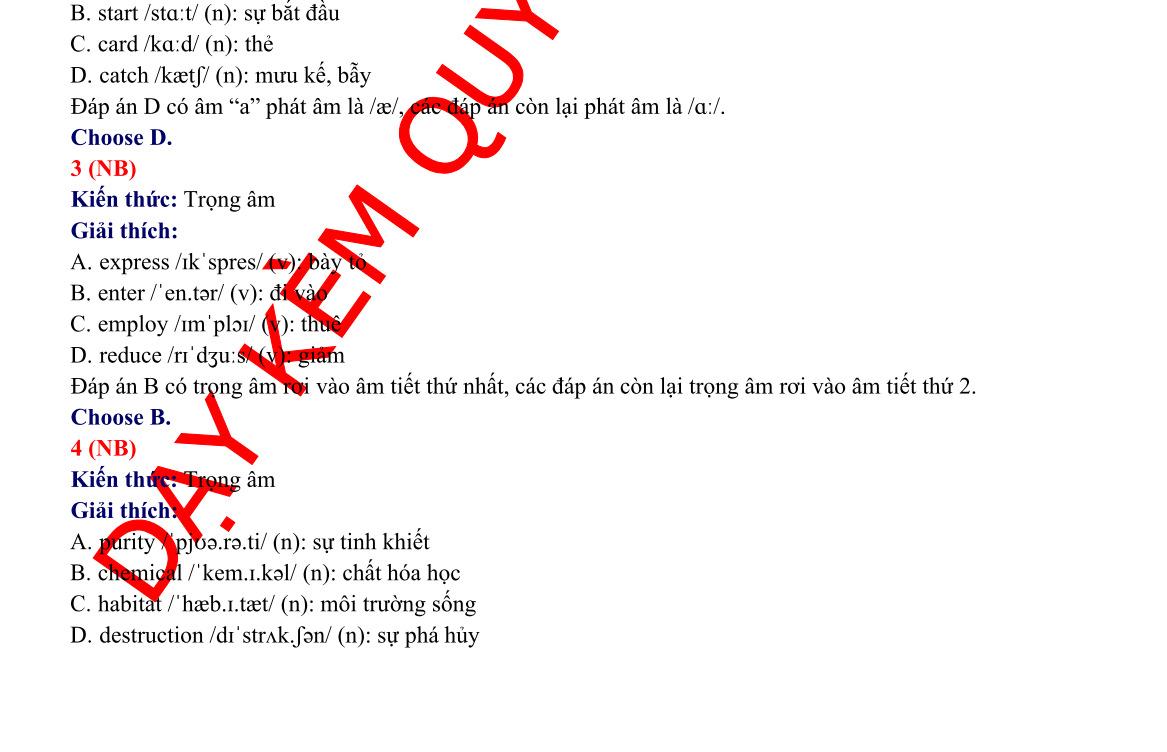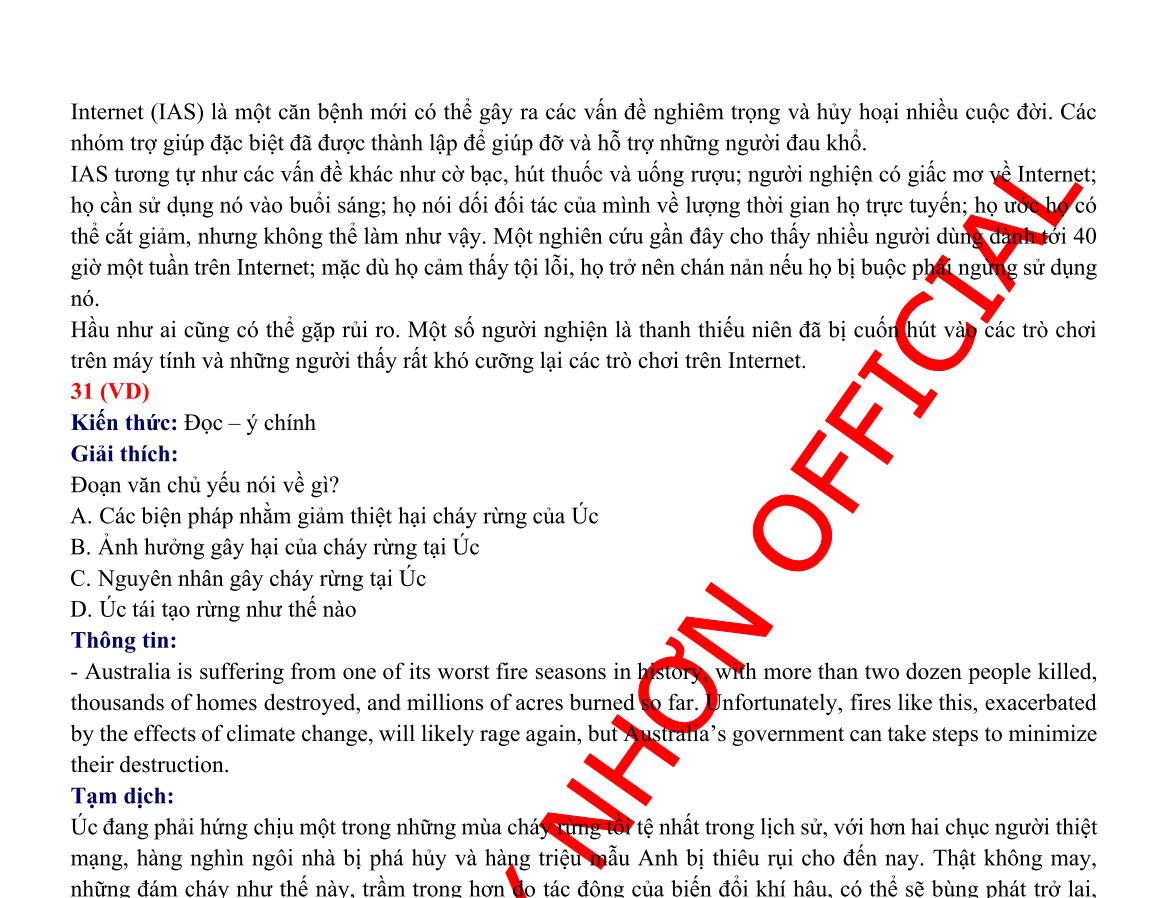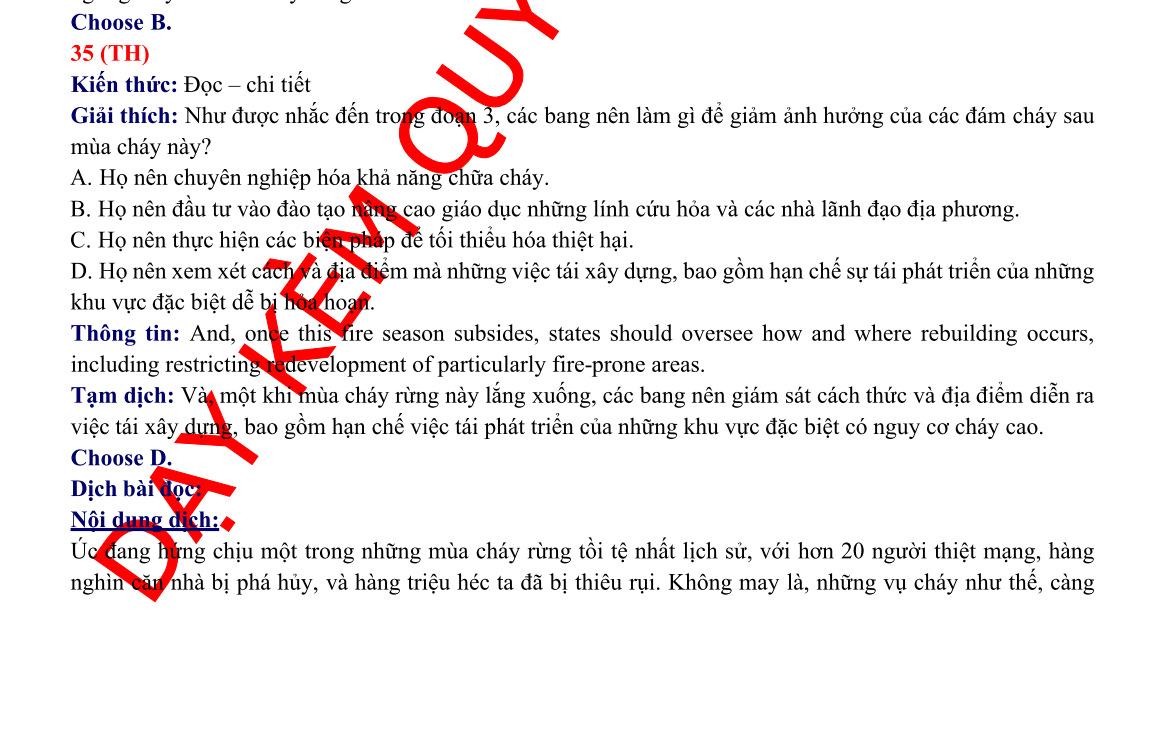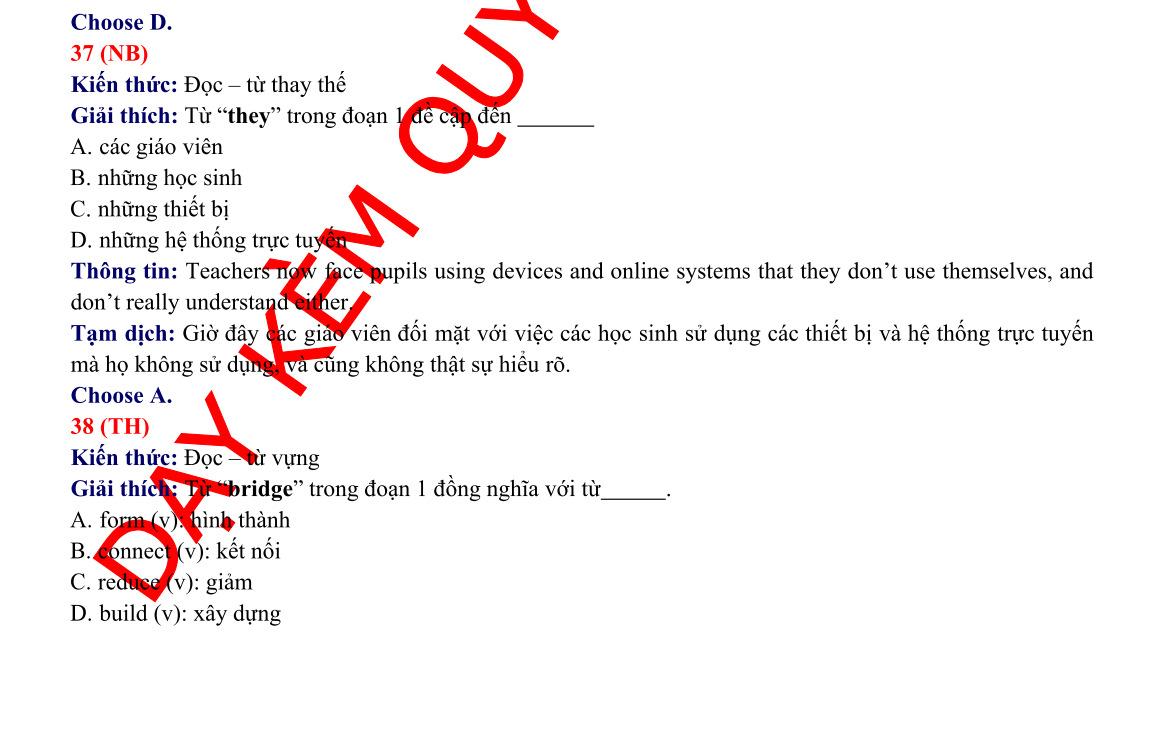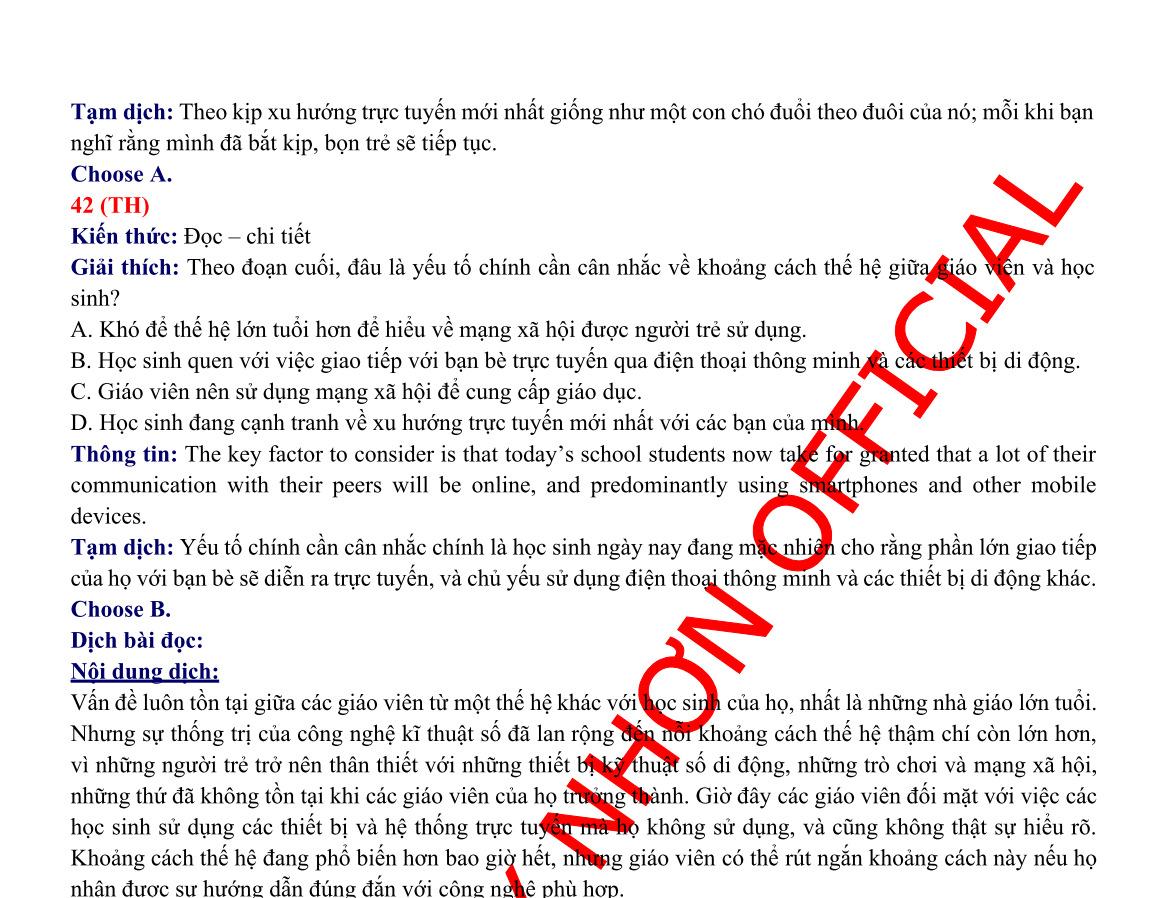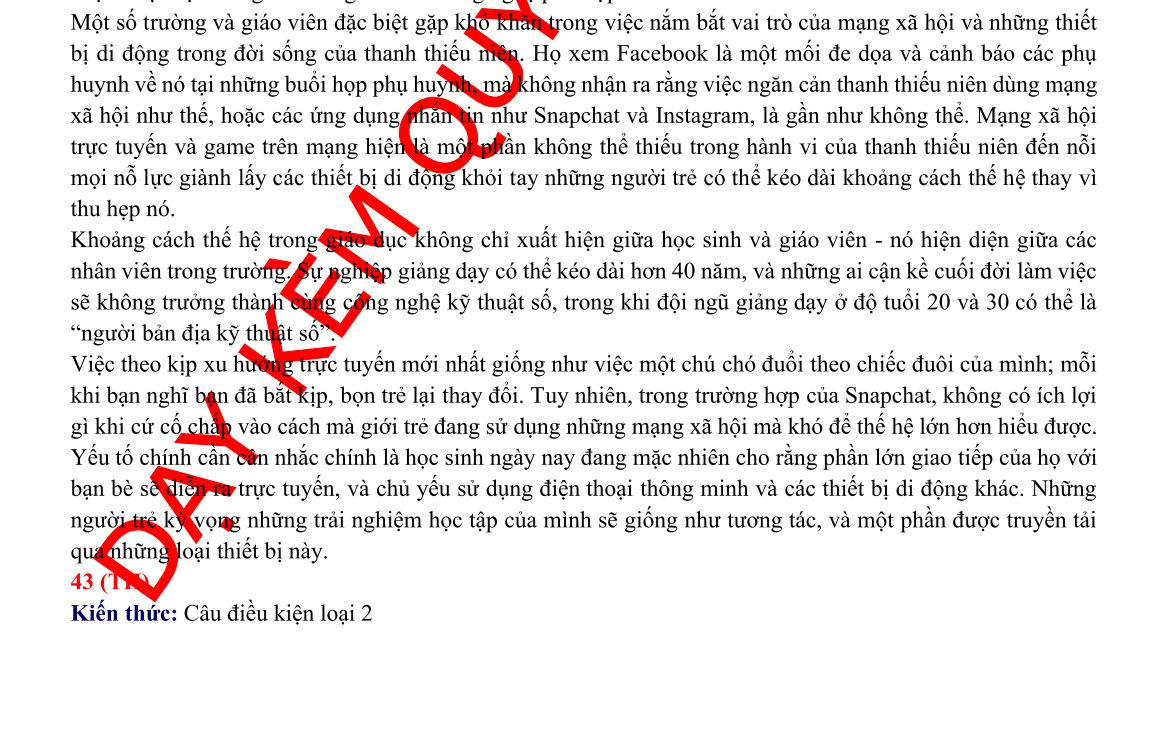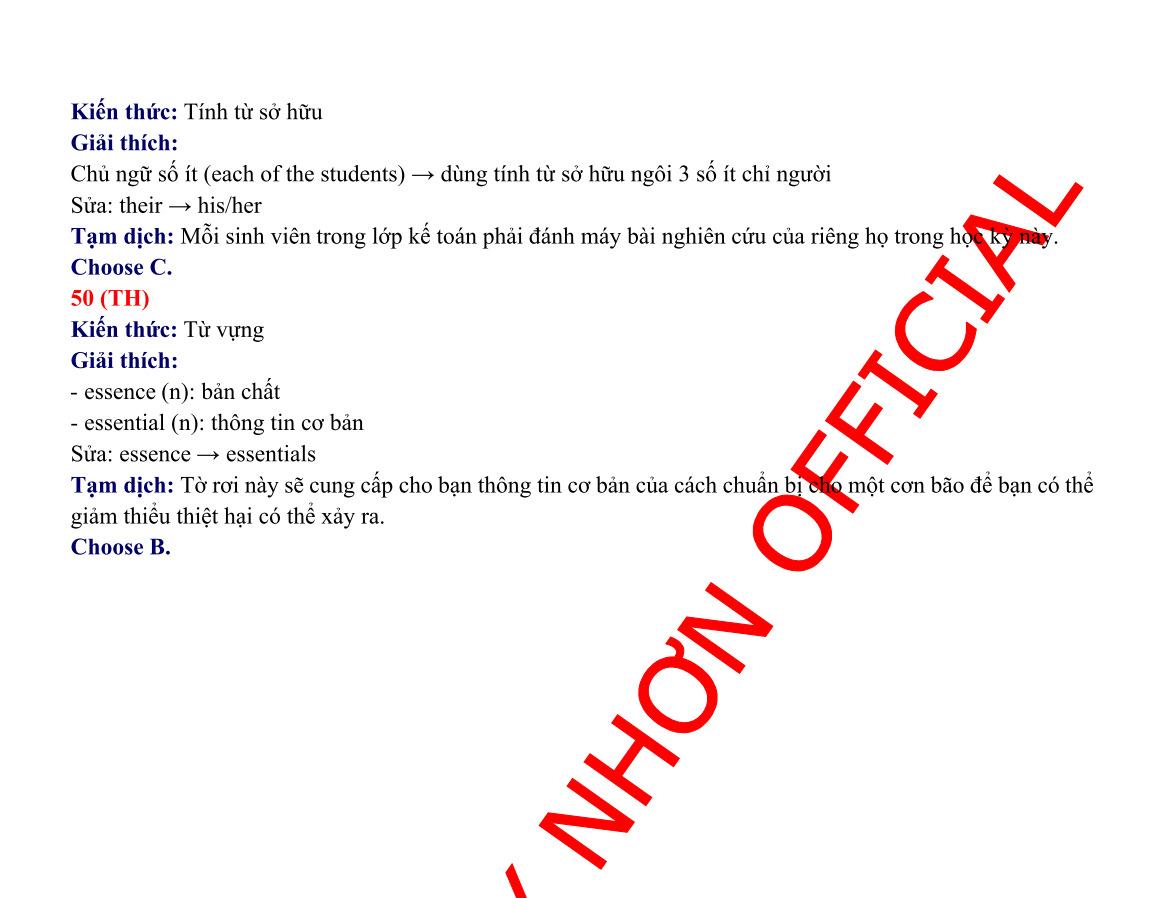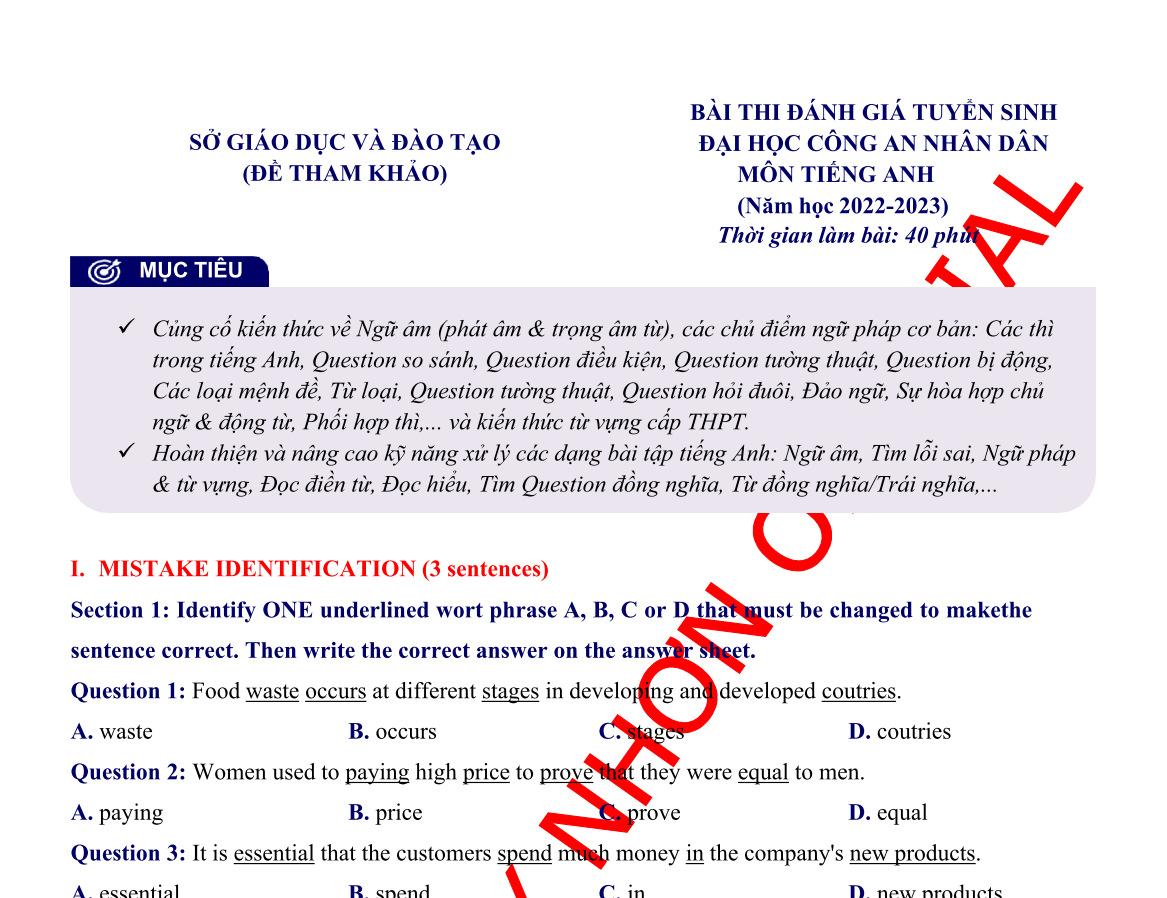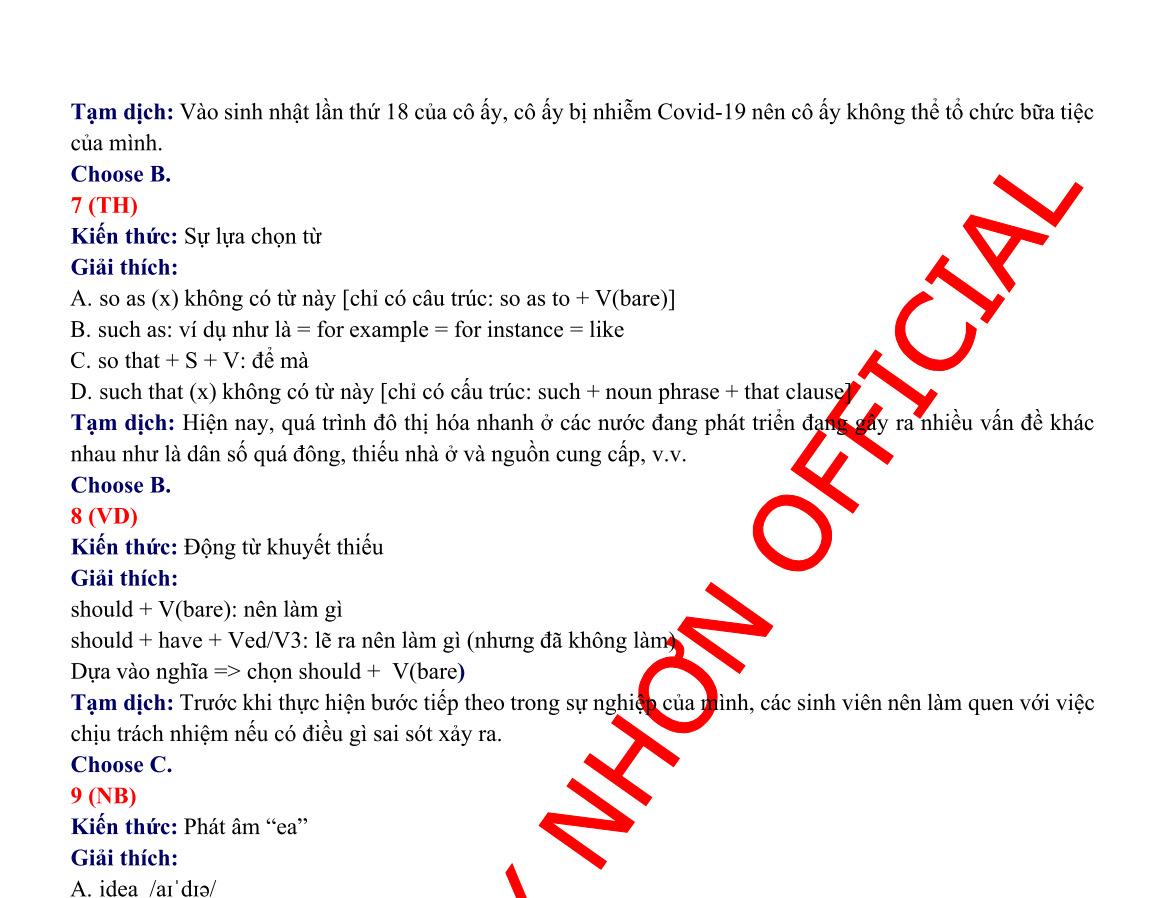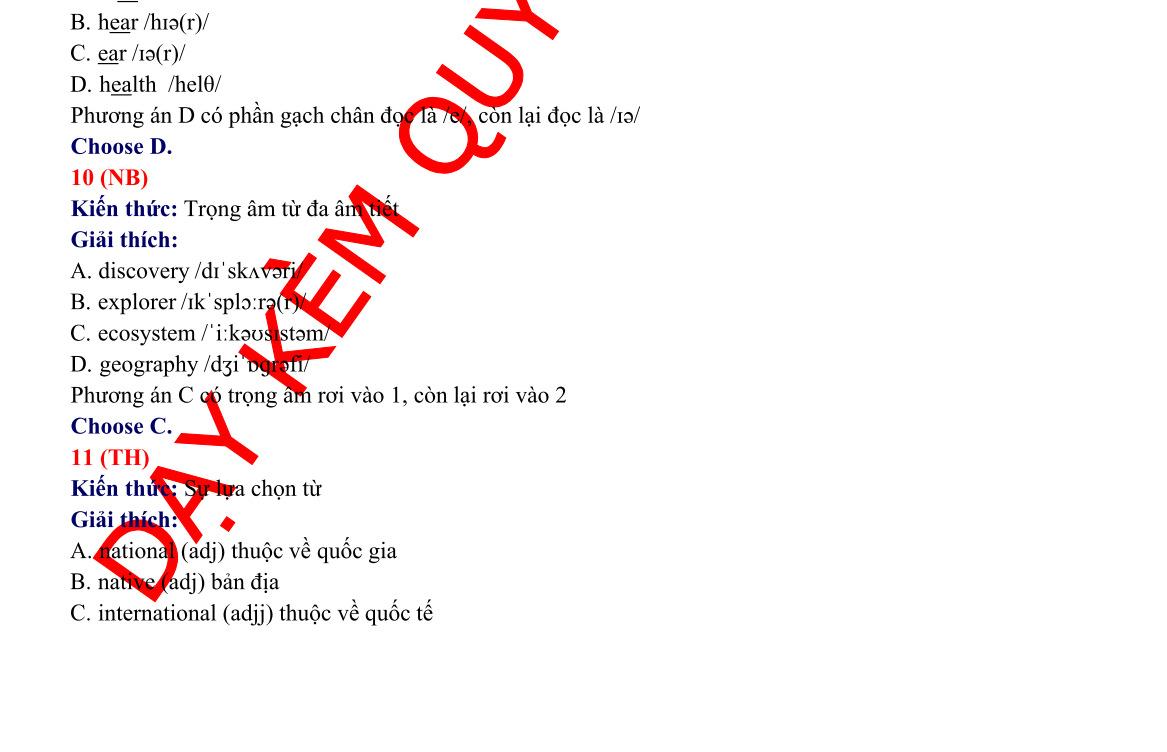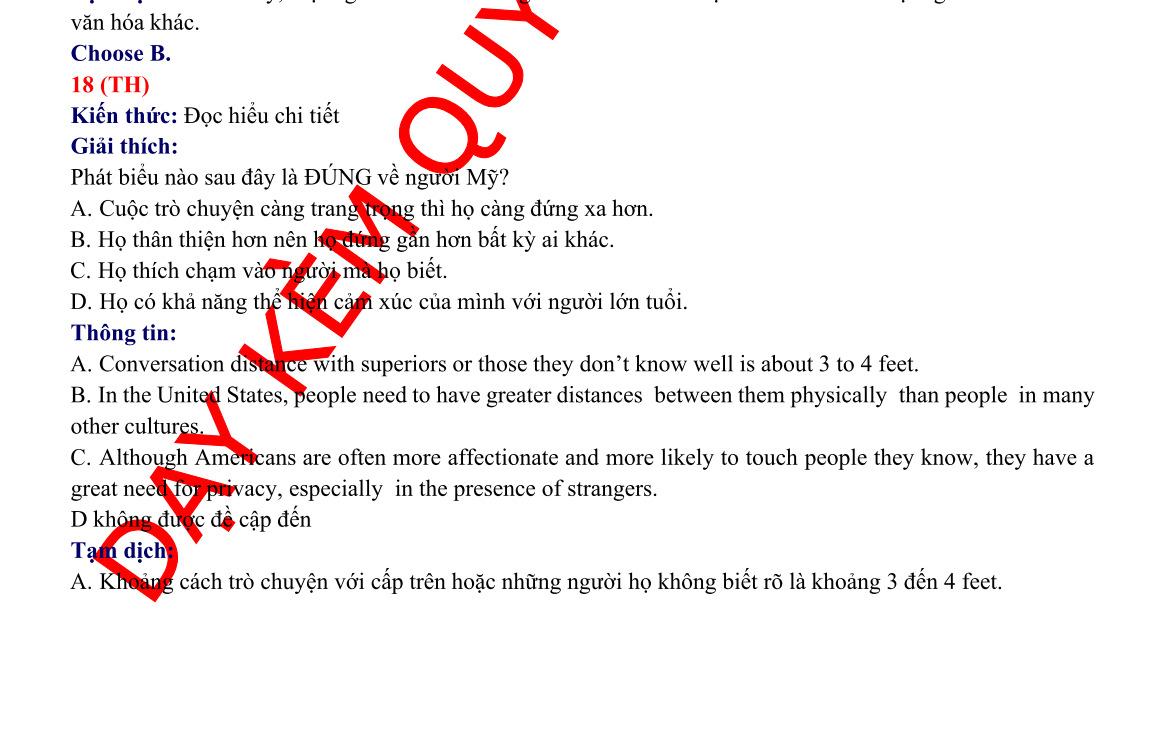

Hỗ trợ trực tuyến Fb www.facebook.com/DayKemQuyNhon Mobi/Zalo 0905779594 Tài liệu chuẩn tham khảo Phát triển kênh bởi Ths Nguyễn Thanh Tú Đơn vị tài trợ / phát hành / chia sẻ học thuật : Nguyen Thanh Tu Group 63 ĐỀ THI THỬ TỐT NGHIỆP THPT NĂM HỌC 2022-2023 - MÔN TIẾNG ANH - CÁC TRƯỜNG TRÊN CẢ NƯỚC - CÓ LỜI GIẢI (01-15) WORD VERSION | 2023 EDITION ORDER NOW / CHUYỂN GIAO QUA EMAIL TAILIEUCHUANTHAMKHAO@GMAIL.COM ĐỀ THI THỬ TỐT NGHIỆP THPT MÔN TIẾNG ANH Ths Nguyễn Thanh Tú eBook Collection vectorstock com/7952634
SỞ GIÁO DỤC VÀ ĐÀO TẠO HƯNGYÊN
THI THỬ TỐT NGHIỆP THPT LẦN 1
TRƯỜNGTHPTTRẦN QUANGKHẢI
MÔNTIẾNG ANH (Năm học2022-2023)
Thờigianlàmbài: 60 phút
Section1:MarktheletterA,B,CorDtoindicatetheword(s)CLOSESTinmeaningtotheunderlined word(s)ineach of thefollowing questions.
Question1: Whatthelecturerhasbeensayingisnotconvincingbecausehedoesn't backup hisopinionswith examples.
A. support B. protect C. moveback D. replace
Question2: Lackof waterandnutrientshas impeded thegrowthofthesecherrytomatoplants.
A. promoted B. assisted C. realized D. prevented
Section2:MarktheletterA,B,CorDtoindicatetheunderlinedpartthatneedscorrectionineachof the followingquestions.
Question3: Yesterday,forthefirsttimeinhislife, Mikerefusestofollowhisparents' advice.
A. first time B. refuses C. to follow
A. permissive B. employers C. discriminate
D. advice
Question4: Itisnotpermissiveforemployerstodiscriminateongroundsofage,sexandrace.
D. andrace
Question5: Somesnakes havehollowteethcalledfans that theyusetopoisonitsvictims.
A. Some B. called C. use
Section3:MarktheletterA,B,C,orDtoindicatethewordthatdiffersfromtheotherthreeinthe positionof theprimary stress in eachofthefollowing questions.
Question 6: A. environment B. eliminate C. academic
Question7: A. apply B. appear C. attend
D. its
D. biology
D. angle
Section4:ReadthefollowingpassageandmarktheletterA,B,C,orDtoindicatethecorrectwordor phrasethat best fits each the numbered blanks.
Althoughmany studentsaresick andtired of putting on theirschool uniformday after day,auniformdoes have itsadvantages.Forastart,studentshavenoneedtoworryaboutwhattoputonwhentheygetupinthemorning.
(8) itseemsthatchildrenwearingthesamecolorsandstylesofclothinggainasenseofbelonging,
DẠYKÈMQUYNHƠN OFFICIAL
ĐỀ
something(9) _improvesmoraleatschoolandreduceslevelsofviolence.Thistheoryhasbeen supported by a study at a school in Long Beach, California. Staff members there have noticed that since school uniform became compulsory, the number of arguments amongst pupils has dropped by as much as 91%. This suggeststhatstudentswhoarealldressedinthesamesimpleschoolshirtsandtrousersarelesslikely todisagree withone(10) .Ontheotherhand,CozetteBuckley,anEducationOfficerfromChicago,holds a rather different view, based on experience in her schools. In heropinion, school uniforms are not a permanent solutionbutonlya(11) aidtoplaygroundproblemsbecausetheydonotaddresstherealsource ofconflictbetweenchildren.Itseems,therefore,(12) bytheseconflictingfindings,thattheschool uniformdebate isn't closed yet!
Question 8: A. Consequently B. Therefore
Question9:A. where B. who
Question10: A. other B. another
Question11:A. current B. present
Question12: A. judging B. measuring
Moreover
whom
every
contemporary
deciding
However
that
each
temporary
working
Section 5: Mark the letter A, B, C, or D to indicate the word whose underlined part differs fromtheother threeinpronunciation ineach of thefollowing questions.
Question 13: A. followed B. attracted
Question14: A. tidy B. revise
arrived
final
delayed
liquid
Section6:MarktheletterA,B,CorDtoindicatethewordOPPOSITEinmeaningtotheunderlined word(s)ineach of thefollowing questions
Question15: Ifound thatcomputergame is detrimentalto the kidsrather than beneficial.
A. helpful B. depressing
harmful
Question16: Tomwas too wetbehind thecars to beinchargeofsuchadifficulttask.
A. fullofexperience B. lackofresponsibility C. withoutmoney
harmless
D. fullofsincerity
Section7:MarktheletterA,B,C,orDtoindicatethesentencethatbestcombineseachpairofsentencesin the following questions
Question17: Mycousin wastooill. Hecouldn'tsit fortheentrance examination lastweek.
Butformy cousin'sillness, hecouldn't sitfortheentranceexamination lastweek.
Suchillwas mycousin thathecouldn't sitfortheentranceexamination lastweek.
Hadmycousinbeen tooill,hecouldn't sitforthe entranceexaminationlastweek.
Soillwasmycousinthathecouldn'tsitforthe entranceexaminationlastweek.
Question18: Juliandroppedoutof college afterhisfirstyear. Nowheregretsit.
Julianregrettedhavingdroppedoutofcollege afterhisfirst year.
Julianregretshavingdroppedoutofcollegeafterhisfirst year.
Julianwisheshedidn'tdrop outof collegeafterhisfirst year.
DẠYKÈMQUYNHƠN OFFICIAL
OnlyifJulianhad droppedoutofcollegeafter hisfirstyear.
C.
D.
C.
D.
C.
D.
C.
D.
C.
D.
C.
D.
C.
D.
C.
D.
Section8:Readthefollowing passageandmarktheletterA,B,C,orDtoindicatetheanswertoeachof the questions.
Japanese Girls' Day-also known as the Doll's Festival-is celebrated on March 3 to pray for the health and happiness of young girls in Japan. Hinamatsuri, the name of the celebration in Japan, is marked by families displaying a set of hina dolls in the house and serving special delicacies that are ceremonially beautiful and delicious.
Traditionally, parents or grandparents of a newborn girl buy a set of hina dolls for the baby, unless they have special dolls that are inherited from generation to generation. From the end of February to March 3, hina dolls dressed in Japanese ancient costumes are displayed on tiered platforms that are covered with a red carpet. The costumed dolls represent the imperial court of the Heian period (A.D. 794 to 1185] and feature the emperor, empress,attendants,andmusicians dressed intraditional garb.
The dolls are displayed hierarchically with the emperor and empress at the top, which are set in front of a gilded screen representing the thrown. The number of dolls and their size vary from home to home, but five to seven platformsarecommon.
It is customary to put the dolls away as soon as the festival is over-there is a superstition that if the dolls are leftout, a family will have trouble marrying off their daughters. After the festival, some people release paper dollsinto the rivers prayingthat this will send awaysickness and bad fortune.
(Adaptedfromhttps://ivwiv.thespruceeats.com/)
Question19: Which ofthefollowing could be the main ideaof thepassage?
JapaneseGirls'Day.
Differenttypesofdollsforbaby
ProcedureofHinamatsuri.
Theway to display thedolls.
Question20: Whatwill be donewith thedollsafter thefestival?
beingsold
beingdisplayed inthegirls'room
beingthrownaway
beingstored
Question21: Whatdoes the word "this" inthelastparagraphreferto?
marryingofftheirdaughters
leavingout thehinadolls
puttingthedollsawayas soonas possible
puttingpaperdolls intotherivers
Question22: According to thepassage,the followingaretrueabout JapaneseGirls'Day,EXCEPT_
DẠYKÈMQUYNHƠN OFFICIAL
ItisorganizedonMarch 3toprayforhealth andhappinessofJapanese girls.
Somesets of hinadolls arepreservedto pass downtheyounger generation.
Beforethe festival,hinadollsinancient costumesarecoveredwitharedcarpet.
Thehinadollsare categorizedaccordingtotheirhierarchyintheimperial court.
Question 23: Theword "delicacies" inparagraph Iisclosestinmeaningto
A. rareflowers B. expensivefoods C. traditionalcakes D. beverages
Section9:Readthefollowing passageandmarktheletterA,B,C,orDtoindicatetheanswertoeachof the question
English teenagers are to receive compulsory cooking lessons in schools. The idea is to encourage healthy eating to fight the country's increasing obesity rate. It's feared that basic cooking and food preparation skills are beinglostas parents turnto pre-prepared conveniencefoods.
Cooking was once regarded as an important part of education in England---even if it was mainly aimed at girls.Inrecentdecadescookinghas progressively becomeaminoractivityinschools.Inmanycasestheschools themselves have given up cooking meals in kitchens in the schools. But the rising level of obesity has led to a rethinkabout thefoodthat children aregiven andthe skills they should betaught.
"What I want is to teach young people how to do basic, simple recipes like a tomato sauce, a bolognaise, a simple curry, a stir-fry, which they can use now at home and then in their later life”, said Ed Balls, the minister responsiblefor schools.
ThenewlessonsareduetostartinSeptember,butsomeschoolswithoutkitchenswillbegivenlongertoadapt. There is alsolikely to be a shortage of teachers with the right skills, since the trend has been to teach food technology rather than practical cooking. Also the compulsory lessons for hands on cooking will only be one houraweek foroneterm. But thewell-known cookerywriter, PruLeith, believesit will beworth it.
"If we'd done this thirty years ago we might not have the crisis we've got now about obesity and lack of knowledge about food and so on. Every child should know how to cook, not just so that they'll be healthy, but becauseit's alifeskill which is a real pleasure".
The renewed interest in cooking is primarily a response to the level of obesity in Britain which is among the highest in Europe, and according to government figures half of all Britons will be obese in 25 years if current trendsarenot stopped.
Question24: Thepassagemainly talks about thereason forobesity
thelost cookingskills
thehealthyeating
thecompulsorycookingclasses
Question25: Which ofthe followingisNOT the purposeforEnglishteenagers toreceivecookinglessons?
Toencourageteenagers toeat healthyfood.
Toreducethe country'sincreasingobesityrate.
Tostopparents fromturning topre-prepared convenience foods.
DẠYKÈMQUYNHƠN OFFICIAL
Topreventbasiccooking andfoodpreparationskills frombeinglost.
Question26: Theunderlinedword "progressively"in thesecond paragraphisclosest inmeaningto
A. all ofasudden B. little bylittle C. morethanever D. incontrast
Question27: Theunderlined phrase "abolognaise" inthepassageprobablymeans
A. adish B. acooker C. acookingclass D. askill
Question28: In whatwaywill cookinglessonsbenefit thestudents?
Theywillbehealthyandenjoy thepleasureofsuchalifeskillaswell. Theywillbeableto dosomebasic,simple recipeslikeatomatosauce. Theywill beabletomakefoodexperimentswith theknowledgeand skills. Theywill beableto control thelevelof obesity inthewholecountry.
Question 29: Theunderlined word "which" in thelastparagraph refersto therenewedinterest
Response
thelevelofobesityinBritain
Britain
Question30: It canbeinferredfrom thepassagethat cookinghasalwaysbeen animportantpartofschooleducationinEngland theobesityrateinBritainhasbeenrapidlygrowinginrecentdecades Englishteenagerswillhavetheircooking lessonstwiceaweek foroneyear thestudents willpay alotof moneyto theschoolforthe
Section10:MarktheletterA,B,C,orDtoindicatethesentencethatisclosestinmeaningtoeachofthe following questions.
Question31: It iscompulsory foryou toshow yourCOVID-19 vaccinationcertificate onyourarrival. Youcan'tshowyour COVID-19vaccination certificateonyourarrival.
Youneedn'tshow yourCOVID-19vaccinationcertificate onyourarrival.
YoumustshowyourCOVID-19vaccinationcertificate onyourarrival. Youshould showyourCOVID-19vaccination certificate onyourarrival.
Question 32: Tom said, "I'll give you this book back tomorrow, Mary."
ATom told MarythatIwouldgive you thatbook back thenext day.
B. Tomtold Marythat hewould give herthat bookback thenext day.
C. Tomtold Marythat hewouldn'tgiveher thatbook back thenext day.
D.Tomsaid to Marythatshewouldgive him thatbook back thenext day.
Question33: My parentslast tookus toourhomevillagetwoyearsago.
Myparents havetakenus to ourhome villagefortwoyears.
Myparentsdidn'ttakeustoourhome villagetwoyears ago.
Myparents haven'ttaken us toourhome villagefortwo years.
DẠYKÈMQUYNHƠN OFFICIAL
Myparentstook ustoourhomevillagein twoyears.
Section11:MarktheletterA,B,CorDtoindicatethecorrectanswertoeachofthefollowingquestions.
Question34: The ofoldbuildingsshouldbetakenintoconsideration.
A. preserve B. preserves C. preservative D. preservation
Question35: Yourbrotheris going tostudy abroad, ?
A. isn't it B. is he C. isn'the D. aren'tyou
Question36: Don'tlet my motherwatch anyof thosesadmovies. Shecriesat thedropof a
A. hat B. bag C. cat D. rag
Question 37: In thesedifficulttimes, thecompanymay haveto 100laborers
A. takeup B. turn down C. put off D. layoff
Question38: My cousin andI onthe computerwhen therewasapower cut.
A. hadplayed B. played C. wereplaying D. amplaying
Question 39: Thewoman bythepolicelastweek.
A. wasfreed B. werefreed C. hasbeenfreed D. hasfreed
Question40: Customers, abouttheserviceshould seethe manager.
A. complaining B. whocomplains C. complains D. were complained
Question41: Ourgroup anewmethodtocarryoutthesurveyintoteenagers'attitudestowards onlinelearning.
A. recruited B. employed C. occupied D. engaged
Question42: ,hewilltakeashower
A. By the timehegets home B. Whenhegot home
C. As soon as hegets home D. Afterhehadgot home
Question43: Wheneveryou'replanningto anewproduct,it'sessentialtoprovideexcellent customerservice.
A. initiate B. start C. declare D. launch
Question44: Most ofthisgrowth hadoccurredsince 1950and wasknown as thepopulation
A. growth B. explosion C. surplus D. density
Question45: PresidentHo Chi Minhwas bornin 1890 NgheAnprovince.
A. in B. of C. from D. on Question46: Shehas just bought painting.
A. aninterestingFrenchold B. anoldinterestingFrench
C. aFrenchinterestingold D. aninterestingoldFrench
Question 47: youstudy for theseexams, thebetter youwilldo.
A. Theharder B. the more C. Thehardest D. Themorehard
Question48: Ihaveto live on unemployment benefit Iam out of work.
A. becauseof B. even though C. because D. in spiteof
DẠYKÈMQUYNHƠN OFFICIAL
Section12:MarktheletterA,B,C,orDtoindicatethesentencethatbestcompleteseachofthefollowing exchanges.
Question49: Twostudentsareplanningfortheir weekend.
Ted:"HowaboutgoingcampinginCucPhuongNationalPark?"
Kate:" ”
A. Not atall B. Youcan makeit
C. Thatwouldbegreat D. Oh,that's aproblem
Question 50: Sueand Miraaretalking about theuseof mobilephonein class.
Sue:"Studentsshould notbeallowed tousemobilephonein class."
Mira:" . Thiswilldistract themfrom studying."
A. Noway! It'suseful B. Iquiteagree
C. Notreally D. I'mof theoppositeopinion
DẠYKÈMQUYNHƠN OFFICIAL
1 (TH)
Kiếnthức: Cụmđộngtừ
Giảithích: support: ủnghộ protect:bảovệ moveback:quay trởlại replace:thaythế
=>back up: hỗtrợ =support
Choose A.
2 (TH)
Kiếnthức: Từvựng
Giảithích:
A.promoted:thăngtiến
B.assisted:hỗtrợ
C.realized:nhận ra
D.prevented:ngănchặn
=>impeded:cản trở=prevented
HƯỚNGDẪNGIẢICHITIẾT
Tạmdịch: Nhữnggìgiảngviênđãnóilàkhôngthuyếtphụcvìanhtakhônghỗtrợýkiếncủamìnhvớicácví dụ.
Tạm dịch: Thiếunướcvàchất dinhdưỡng đãcảntrở sựphát triểncủanhững câycàchuabi này.
Choose D.
3(NB)
Kiếnthức: Thì quákhứ đơn
Giảithích:
Yesterday:hômqua
=>Sửa“refuses”thành “refused”
Tạm dịch: Hôm qua,lần đầutiêntrong đời,Miketừchối làmtheolời khuyêncủabốmẹ.
Choose B.
4 (TH)
Kiếnthức: Từvựng
Giảithích:
permissive:dễdãi
=>sửathànhpermitted
DẠYKÈMQUYNHƠN OFFICIAL
Tạm dịch: Người sửdụnglao độngkhôngđượcphépphânbiệt đốixửdựatrêntuổitác, giớitính vàchủngtộc.
ChooseA.
BẢNGĐÁPÁN 1.A 2.D 3. B 4.A 5.D 6.C 7.D 8.C 9.D 10. B 11. D 12. A 13. B 14. D 15. C 16. A 17. D 18. B 19. A 20. D 21. D 22. C 23. B 24. D 25. C 26. B 27. A 28. A 29. C 30. B 31.C 32. B 33.C 34.D 35.C 36.A 37.D 38.C 39.A 40.A 41. B 42. C 43. D 44. B 45. A 46. D 47. A 48. C 49. C 50. B
5(NB)
Kiếnthức: Sởhữucách
Giảithích:
SnakeslàNsốnhiều
=>sửaitsthànhtheir
Tạm dịch: Mộtsố loàirắn córăngrỗng gọilànanh màchúng dùngđểđầuđộcnạnnhâncủanó.
Choose D.
6(NB)
Kiếnthức: Trọngâm
Giảithích: environment/ɪnˈvaɪrənmənt/ eliminate/ɪˈlɪməˌneɪt/ academic/ækəˈdɛmɪk/ biology/baɪˈɑləʤi/
Đápán Ctrọng âmrơi vàoâm tiết thứ3, cònlại làâm tiết thứ2
Choose C.
7(NB)
Kiếnthức: Ngữâm
Giảithích: apply/əˈplaɪ/ appear/əˈpɪr/ attend/əˈtɛnd/ angle/ˈæŋɡəl/ Đápán Dtrọngâmrơi
Choose D.
8(NB)
Kiếnthức: Liêntừ
Giảithích:
Consequently:Hậu quảlà
Therefore:Dođó
Moreover:Hơnnữa
However:Tuynhiên
Thôngtin: Forastart,studentshavenoneedtoworryaboutwhattoputonwhentheygetupinthemorning.
Moreover itseems thatchildren wearingthe same colorsand stylesofclothinggain asenseof belonging
Tạmdịch: Đầutiên,họcsinhkhôngcầnphảilolắngvềviệcmặcgìkhithứcdậyvàobuổisáng.Hơnnữa,cóvẻ nhưnhững đứatrẻmặcquần áo có màu sắcvàkiểu dáng giống nhau sẽcócảm giácthân thuộc
Choose C.
9(NB)
Kiếnthức: Đạitừquanhệ
Giảithích:
where:thay thếcho N chỉ địađiểm
who: thay thếcho người
whom:thay thếchotân ngữ
that:thaythếchoN chỉngười hoặcvật
Thôngtin: something that improvesmorale at schoolandreduceslevelsofviolence.
Tạm dịch: mộtcáigì đócái màcải thiệntinh thầnở
DẠYKÈMQUYNHƠN OFFICIAL
vàoâm tiếtthứnhất,còn lạilàthứ2
trườngvàgiảmmứcđộbạo lực.
Choose D.
10(NB)
Kiếnthức: Lượngtừ
Giảithích:
A.other+Nsốnhiều
B.another+Nsốít
C.every+Nsốít
D.each+Nsốít
oneanother:Ngườikhác
Thôngtin: Thissuggeststhatstudentswho are alldressedinthe samesimple schoolshirtsandtrousersareless likelyto disagreewith one another
Tạm dịch: Điều này cho thấy rằng những học sinh mặc đồng phục áo sơ mi và quần dài đơn giản giống nhau sẽ
ít cókhảnăng không đồng ý với một người khác
Choose B.
11 (TH)
Kiếnthức: Từvựng
Giảithích: current:hiệntại present:bâygiờ
contemporary:đương đại temporary:tạmthời
Thôngtin: Inheropinion,schooluniformsarenotapermanentsolutionbutonlya temporary aidtoplayground problemsbecausethey do not addressthereal sourceofconflict betweenchildren.
Tạmdịch: Theoýkiến củacôấy,đồngphụchọcsinhkhôngphảilàmộtgiảipháplâudàimàchỉlàtạmthờitrợ giúpcho cácvấn đềởsân chơi vì chúng không giảiquyết đượcnguồn xung đột thựcsựgiữatrẻem.
Choose D.
12 (TH)
Kiếnthức: Từvựng
Giảithích: judging:phánxét measuring:ướclượng deciding:quyếtđịnh working:làmviệc
Thôngtin: Itseems,therefore, judging bytheseconflictingfindings,thattheschooluniformdebateisn'tclosed yet!
Tạmdịch: Dođó,cóvẻnhưquaphánxétnhữngpháthiệnmâuthuẫnnày,rằngcuộctranhluậnvềđồngphục họcsinh vẫn chưakết thúc!
Choose A.
Dịchbàiđọc:
Nội dungdịch:
DẠYKÈMQUYNHƠN OFFICIAL
Mặc dù nhiều học sinh phát ốm và mệt mỏi khi mặc đồng phục học sinh ngày này qua ngày khác, nhưng đồng phục vẫn có những ưu điểm của nó. Đầu tiên, học sinh không cần phải lo lắng về việc mặc gì khi thức dậy vào buổi sáng. Hơn nữa, có vẻ như những đứa trẻ mặc quần áo có màu sắc và kiểu dáng giống nhau sẽ có cảm giác thân thuộc, điều gì đó giúp cải thiện tinh thần ở trường và giảm mức độ bạo lực. Lý thuyết này đã được hỗ trợ bởimộtnghiêncứutạimộttrườnghọcởLongBeach,California.Cácnhânviênởđóđãnhậnthấyrằngkểtừkhi đồngphụchọcsinhtrởthành bắtbuộc,sốlượngcáccuộctranhcãigiữacác họcsinhđãgiảmtới91%. Điềunày
10
cho thấy rằng những sinh viên mặc đồng phục áo sơ mi và quần dài đơn giản giống nhau sẽ ít có khả năng bất đồng với nhau hơn. Mặt khác, Cozette Buckley, một Cán bộ Giáo dục từ Chicago, có quan điểm khá khác, dựa trên kinh nghiệm ở trường học của cô. Theo ý kiến của cô, đồng phục học sinh không phải là giải pháp lâu dài màchỉlàgiảipháptạmthờichocácvấnđềvềsânchơivìchúngkhônggiảiquyếtđượcnguồngốcxungđộtthực sựgiữatrẻem.Dođó,cóvẻnhưdựatrênnhữngpháthiệnmâuthuẫnnày,cuộctranhluậnvềđồngphụchọcsinh vẫnchưakết thúc!
13(NB)
Kiếnthức: Ngữâm
Giảithích: followed/ˈfɑloʊd/ attracted/əˈtræktəd/ arrived/əˈraɪvd/ delayed/dɪˈleɪd/Những động từ có chữ cái kết thúc tận cùng là:
TH1: t, d =>đuôi–ed đượcphát âm là /ɪd/.
TH 2: p, pe; k, ke; ff, ph, gh; ss, ce, se, x; ch; sh => đuôi –ed được phát âm là /t/.
TH3: còn lại =>đuôi –ed đượcphát âm là /d/.
Phầngạch chânphươngán Cđượcphátâm là /ɪd/,còn lạilà/d/. Choose B.
14(NB)
Kiếnthức: Ngữâm
Giảithích: tidy/ˈtaɪdi/ revise/ˈtaɪdi/ final/ˈfaɪnəl/ liquid/ˈlɪkwəd/
Đápán Dphần gạchchân phátâm là/i/, cònlại là/ai/
Choose D.
15(NB)
Kiếnthức: Từvựng
Giảithích: helpful:cóích depressing:sầumuộn harmful:cóhại harmless:vôhại
=>beneficial:cólợi><harmful
Tạm dịch: Tôithấy rằngtròchơimáy tínhcóhại chobọntrẻhơn làcólợi.
Choose C.
16(VD)
Kiếnthức: Thànhngữ
Giảithích:
wetbehind thecars: thiếu kinhnghiệm ><fullofexperience
Tạm dịch: Tomđãquáthiếukinh nghiệmđểđảmnhậnmột nhiệmvụ khó khănnhư vậy.
Choose A.
17 (TH)
Kiếnthức: Câughép
Giảithích:
DẠYKÈMQUYNHƠN OFFICIAL
11
So+Adj+that: Quáđếnnỗimà
Tạm dịch: Anh họcủatôi đãquáốm. Anhấy không thểtham gia kỳthi tuyển sinhvào tuần trước.
Choose D.
18 (TH)
Kiếnthức: Câuước
Giảithích:
Regrethaving donesth:Hốihận vìđã làmgì
Tạm dịch: Julian bỏhọcđạihọcsaunămđầu tiên.Bây giờanh hốihận.
Choose B.
19(VD)
Kiếnthức: Đọc–ýchính
Giảithích: Điềunào sauđâycó thểlàý chính của đoạnvăn?
Ngàynữsinh Nhật Bản.
Cácloại búp bê cho bé
ThủtụcHinamatsuri.
Cáchtrưngbàynhữngconbúpbê.
Thôngtin:
JapaneseGirls'Day-alsoknownastheDoll'sFestival-iscelebratedonMarch3toprayforthehealthand happinessofyoung girlsin Japan.
After the festival,somepeoplerelease paperdollsintotherivers prayingthatthiswillsendawaysicknessand badfortune.
Tạm dịch: NgàyBégáiNhậtBản-haycòngọilàLễhộibúpbê-đượctổchứcvàongày3tháng3đểcầusứckhỏevà hạnhphúcchocáccô gáitrẻở Nhật Bản.
Saulễhội,mộtsốngườithảbúpbêgiấyxuốngsôngcầunguyệnrằngđiềunàysẽxuađuổibệnhtậtvàxuixẻo.
Choose A.
20(TH)–0
Kiếnthức: Đọc–chi tiết
Giảithích: Sẽlàm gì vớinhững con búp bêsau lễhội?
A.đượcbán
B.đượctrưng bàytrongphòngcủacáccôgái
C.bịvứt bỏ
D.đượclưutrữ
Thôngtin:
Itiscustomarytoputthedollsawayassoonasthefestivalisover-there isa superstitionthatif thedollsareleft out,a family will havetrouble marrying offtheirdaughters.
Tạmdịch: Theophongtục,ngườitasẽcấtnhữngconbúpbêđingaysaukhilễhộikếtthúc-cómộtđiềumêtín rằngnếu nhữngcon búpbêbị bỏ đi, mộtgiađình sẽgặp khó khăn trong việcgảcongái củahọ.
Choose D.
21(NB)
Kiếnthức: Đọc–từthaythế
Giảithích: Từ"this"trongđoạn cuốiđềcập đếnđiềugì?
gảcongáicủahọ
bỏ búp bêhina
cấtbúp bêđi càngsớm càngtốt
DẠYKÈMQUYNHƠN OFFICIAL
thảbúp bêgiấy xuốngsông
12
Thôngtin: Afterthefestival,somepeoplereleasepaperdollsintotheriversprayingthat this willsendaway sicknessand bad fortune.
Tạmdịch: Saulễhội,mộtsốngườithảbúpbêgiấyxuốngsôngcầunguyệnrằngđiềunàysẽxuađuổibệnhtật vàxui xẻo.
Choose D.
22 (TH)
Kiếnthức: Đọc–chi tiết
Giảithích: Theođoạn văn, nhữngđiều sau đâyđúng vềNgàynữsinh NhậtBản, NGOẠITRỪ
Nóđượctổchứcvàongày 3tháng 3 đểcầu nguyện chosứckhỏevàhạnh phúccủa cáccô gái Nhật Bản.
Mộtsố bộ búp bêhina đượcbảo tồn đểtruyền lại cho thếhệtrẻ.
Trướclễhội, những conbúp bêhina trong trang phụccổ xưađượcphủmột tấm thảm đỏ.
Búpbêhina đượcphânloại theo thứbậctrongtriều đình.
Thông tin: From the end of February to March 3, hina dolls dressed in Japanese ancient costumes are displayed ontiered platforms that arecovered with ared carpet.
Tạmdịch: Từcuốitháng2đếnngày3tháng3,búpbêhinamặctrangphụccổxưacủaNhậtBảnđượctrưngbày trêncácbụcxếp tầng đượctrải thảm đỏ.
Choose C.
23(VD)
Kiếnthức: Đọc–từthaythế
Giảithích: Từ"delicacy"trongđoạnIgầnnghĩanhấtvới hoahiếm
Thôngtin: Hinamatsuri,thenameofthecelebrationinJapan,ismarkedbyfamiliesdisplayingasetofhinadolls inthehouseand serving special delicacies that areceremoniallybeautifuland delicious.
Tạmdịch: Hinamatsuri,têncủalễkỷ niệmở
búpbêhina trong nhàvàphụcvụ những món ngon đặcbiệt đẹp mắt vàngon miệng theo nghi lễ.
Choose B.
Dịchbàiđọc:
Nộidungdịch:
NgàybégáiNhậtBảnhaycòngọilàLễhộibúpbêđượctổchứcvàongày3tháng3đểcầunguyệnchosứckhỏe và hạnh phúc của các cô gái trẻ ở Nhật Bản. Hinamatsuri, tên của lễ kỷ niệm ở Nhật Bản, được đánh dấu bằng việc các gia đình trưng bày một bộ búp bê hina trong nhà và phục vụ những món ngon đặc biệt đẹp mắt và ngon miệngtheo nghi lễ.
Theo truyền thống, cha mẹ hoặc ông bà của một bé gái mới sinh mua một bộ búp bê hina cho em bé, trừ khi họ cónhữngconbúpbêđặcbiệtđượcditruyềntừthếhệnàysangthếhệkhác.Từcuốitháng2đếnngày3tháng3, búpbêhinamặctrangphụccổxưacủaNhậtBảnđượctrưngbàytrêncácbụcxếptầngđượctrảithảmđỏ.Những conbúpbêmặctrangphụcđạidiệnchotriềuđìnhthờiHeian(794đến1185sauCôngnguyên)vàcóhìnhhoàng đế,hoàng hậu, những người hầu cận vànhạcsĩmặctrang phụctruyền thống. Những con búp bê được trưng bày theo thứ bậc với hoàng đế và hoàng hậu ở trên cùng, được đặt trước một tấm bình phong mạ vàng tượng trưng chongười bị ném. Số lượng búp bê và kích thước của chúng khác nhau giữa cácnhà, nhưng phổ biếnlà có năm đến bảy bệ.
Theo phong tục, người ta sẽ cất những con búp bê đi ngay sau khi lễ hội kết thúc -có một điều mê tín rằng nếu những con búp bê bị bỏ đi, một gia đình sẽ gặp khó khăn trong việc gả con gái của họ. Sau lễ hội, một số người thảbúp bêgiấy xuống sông cầu nguyệnrằng điềunày sẽxuađuổi bệnhtậtvàxui xẻo.
DẠYKÈMQUYNHƠN OFFICIAL
thựcphẩmđắttiền bánhtruyềnthống
đồuống
NhậtBản,đượcđánhdấubằngviệccácgiađìnhtrưng bàymộtbộ
13
24(VD)
Kiếnthức: Đọc–ýchính
Giảithích: Đoạnvăn chủ yếunói về
nguyênnhânbéophì
kỹnăngnấuănbị mất
ănuốnglànhmạnh
cáclớp họcnấu ăn bắt buộc
Thôngtin:
Englishteenagersareto receivecompulsorycooking lessonsinschools Buttherisinglevelofobesityhasledtoarethinkaboutthefoodthatchildrenaregivenandtheskillsthey should betaught.
Tạm dịch:
Thanhthiếu niên Anh phải họcnấuăn bắt buộctrongtrường học
Nhưngmứcđộbéophìngàycàngtăngđãdẫnđếnviệcsuynghĩlạivềthứcănmàtrẻemđượccungcấpvà nhữngkỹ năng mà chúngnên đượcdạy.
Choose D.
25 (TH)
Kiếnthức: Đọc–chi tiết
Giảithích: Điều nàosau đâyKHÔNGphải làmụcđíchcho thanhthiếuniên Anhhọcnấuăn?
A.Đểkhuyến khích thanh thiếu niên ăn thứcăn lành mạnh.
B.Đểgiảmtỷ lệbéo phìngày càngtăng củađấtnước.
C.Đểngănchặnchamẹ chuyển sangthựcphẩm tiệnlợi chuẩnbịsẵn.
D.Đểtránh mấtđi cáckỹnăng nấu nướngvàchuẩnbị thứcăncơ bản.
Thông tin: English teenagers are to receive compulsory cooking lessons in schools. The idea is to encourage healthy eating to fight the country's increasing obesity rate. It's feared that basic cooking and food preparation skillsarebeing lost as parents turn to pre-preparedconveniencefoods.
Tạm dịch: Thanh thiếu niên Anh phải học nấu ăn bắt buộc ở trường học. Ý tưởng là khuyến khích ăn uống lành mạnh để chống lại tỷ lệ béo phì ngày càng tăng của đất nước. Người ta sợ rằng các kỹ năng nấu nướng và chuẩn
bị thức ăn cơ bản đang bị mất đi khi các bậc cha mẹ chuyển sang sử dụng các loại thực phẩm tiện lợi được chế biếnsẵn.
Choose C. 26(VD)
Kiếnthức: Đọc–từvựng
Giảithích: Từđượcgạchchân "progressively"trong đoạnthứhaigần nghĩanhất với bấtngờ
từngchút một hơnbao giờ hết ngượclại
Thôngtin:
CookingwasonceregardedasanimportantpartofeducationinEngland---evenifitwasmainlyaimedatgirls. Inrecent decades cooking hasprogressively become aminoractivity in schools.
Tạmdịch: NấuăntừngđượccoilàmộtphầnquantrọngtronggiáodụcởAnh,ngaycảkhinóchủyếudànhcho cácbégái. Trongnhữngthập kỷgần đây,nấuănđãdần trở thànhmột hoạt độngnhỏ trong trườnghọc.
Choose B.
27(VDC)
Kiếnthức: Đọc–từvựng
DẠYKÈMQUYNHƠN OFFICIAL
14
Giảithích: Cụm từđượcgạchchân "a bolognaise"trongđoạnvăn có thểcónghĩa là
mộtmón ăn
mộtcáibếp
mộtlớp họcnấu ăn
mộtkỹ năng
Thôngtin:
"WhatIwantistoteachyoungpeoplehowtodobasic,simplerecipeslikeatomatosauce,a bolognaise ,asimple curry,astir-fry
"Điềutôimuốnlàdạynhữngngườitrẻcáchlàmnhữngcôngthứccơbản,đơngiảnnhưsốtcàchua,bolognese, càriđơn giản,món xào.
Choose A.
28 (TH)
Kiếnthức: Đọc–chi tiết
Giảithích: Cácbài họcnấu ăn sẽmanglại lợi íchgì cho họcsinh?
Họsẽkhỏemạnh vàtận hưởng niềm vui củamột kỹ năng sống như vậy. Họsẽcóthểlàm mộtsố công thứccơ bản, đơngiản nhưsốtcàchua. Cácem có thểlàm thí nghiệm vềthứcănvới kiến thứcvàkỹ năng đãhọc. Họsẽcó thểkiểm soát mứcđộ béo phìtrên toàn quốc.
Thôngtin: Everychildshouldknowhowtocook,notjustsothatthey'llbehealthy,butbecauseit'salifeskill whichis a real pleasure".
Tạmdịch: Mọiđứatrẻđềunênbiếtnấuăn,khôngchỉđểchúngkhỏemạnhmàcònvìđólàmộtkỹnăngsống vàlà một niềm vui thựcsự".
Choose A.
29(NB)
Kiếnthức: Đọc–từthaythế
Giảithích: Từgạch dưới" which
tiền lãi mới
Phảnhồi
mứcđộ béo phìở Anh
Anh
"trongđoạncuối đềcậpđến
Thôngtin: TherenewedinterestincookingisprimarilyaresponsetothelevelofobesityinBritain which is amongthehighest in Europe
Tạmdịch: MốiquantâmmớiđốivớinấuănchủyếulàdomứcđộbéophìởAnhthuộchàngcaonhấtởchâu
Choose C.
30 (TH)
Kiếnthức: Đọc–chi tiết
Giảithích: Có thểsuy ratừđoạn văn rằng _
nấuăn luôn làmột phần quan trọngtrong giáodụchọcđường ở Anh
tỷlệbéo phìở Anhđãtăng nhanhtrong nhữngthậpkỷ gầnđây
Thanhthiếu niênAnhsẽhọcnấuănhailần mộttuần trong mộtnăm
cácsinh viên sẽtrảrấtnhiều tiềncho trường học
Thôngtin: If we'ddonethisthirty yearsagowemightnothave thecrisiswe'vegotnowaboutobesityandlack ofknowledgeabout foodand so on
Tạm dịch: Nếu chúng talàm điều nàybamươi năm trước, chúng tacóthểkhông gặp khủng hoảngnhư bâygiờ vềbéophì và thiếu kiến thứcvềthựcphẩm, v.v.
DẠYKÈMQUYNHƠN OFFICIAL
Âu
15
Choose B.
Dịchbàiđọc:
Nội dungdịch:
Thanh thiếu niên Anh phải học nấu ăn bắt buộc ở trường học. Ý tưởng là khuyến khích ăn uống lành mạnh để
chống lại tỷ lệ béo phì ngày càng tăng của đất nước. Người ta sợ rằng các kỹ năng nấu nướng và chuẩn bị thức ăncơbảnđangbịmấtđikhicácbậcchamẹchuyểnsangsửdụngcácloạithựcphẩmtiệnlợiđượcchếbiếnsẵn. NấuăntừngđượccoilàmộtphầnquantrọngtronggiáodụcởAnh,ngaycảkhinóchủyếudành chocácbégái.
Trong những thập kỷ gần đây, nấu ăn đã dần trở thành một hoạt động nhỏ trong trường học. Nhiều trường tự bỏ
nấu ăn tại bếp ăn của trường. Nhưng mức độ gia tăng của bệnh béo phì đã dẫn đến việc suy nghĩ lại về thức ăn màtrẻem đượccung cấpvànhững kỹ năng màchúng nên đượcdạy.
“Điều tôi muốn là dạy những người trẻcách làm những công thức cơ bản, đơn giản như sốt cà chua, bolognaise, món cà ri đơn giản, món xào, những thứ mà họ có thể sử dụng ngay bây giờ ở nhà và sau này trong cuộc sống saunày,”Ed nói Balls,bộ trưởng chịu trách nhiệmvềcáctrường học. Các bài học mới sẽ bắt đầu vào tháng 9, nhưng một số trường không có nhà bếp sẽ có nhiều thời gian hơn để thích nghi. Cũng có thể xảy ra tình trạng thiếu giáo viên có kỹ năng phù hợp, vì xu hướng dạy công nghệ thực phẩm hơn là dạy thực hành nấu ăn. Ngoài ra, các bài học bắt buộc về nấu ăn sẽ chỉ kéo dài một giờ một tuần trongmột họckỳ. Nhưngnhàvăn nấuăn nổi tiếng,Pru Leith, tin rằng nó sẽ đáng giá.
"Nếuchúngtalàmđiềunàybamươinămtrước,chúngtacóthểkhônggặpkhủnghoảngnhưbâygiờvềbéophì và thiếu kiến thức về thực phẩm, v.v. Mọi đứa trẻ đều nên biết nấu ăn, không chỉ để chúng khỏe mạnh , mà bởi vìđó làmột kỹnăng sống là một niềm vui thựcsự".
Mối quan tâm mới đối với nấu ăn chủ yếu là do mức độ béo phì ở Anh, vốn thuộc hàng cao nhất ở châuÂu, và theo số liệu của chính phủ, một nửa số người Anh sẽ bị béo phì trong 25 năm nữa nếu xu hướng hiện tại không bị dừnglại.
31(NB)
Kiếnthức: Đại từkhuyếtthiếu
Giảithích: compulsory:bắtbuộc=must
Tạm dịch: Bạn bắtbuộcphảixuấttrình giấychứng nhậntiêmchủng COVID-19khi đếnnơi.
Choose C.
32(NB)
Kiếnthức: Câutrầnthuật
Giảithích:
Đổingôi xưng hô
Lùi 1thì
Tạm dịch: Tom nói,"Tôisẽtrảlạibạn cuốnsáchnàyvàongày mai,Mary."
Choose B.
33(NB)
Kiếnthức: Thìhiệntạihoàn thành
Giảithích:
Aiđó đãkhông làm gìtrong1 khoảng thời gian
=>haven’t +PII+for/since+ thời gian
Tạm dịch: Bốmẹtôiđưachúngtôi vềquêlầncuối cáchđâyhai năm.
Choose C.
34 (TH)
Kiếnthức: Cấutạotừ
Giảithích: The+N+of
Tạm dịch: Sựbảo tồn củacáctòa nhàcũ nên đượcxem xét.
DẠYKÈMQUYNHƠN OFFICIAL
16
Choose D.
35(NB)
Kiếnthức: Câuhỏiđuôi
Giảithích: vếtrướcdấuphẩy làcâu khẳng định=>vếsaulà phủ định
Tạm dịch: Anhtrai của bạn sẽđidu học,phải không?
Choose C.
36(VD)
Kiếnthức: Thànhngữ
Giảithích: atthedropofahat: ngaylập tức
Tạm dịch: Đừng đểmẹtôi xembất kỳ bộphim buồn nào.Cô ấy khócngay lập tức
Choose A.
37 (TH)
Kiếnthức: Cụmđộngtừ
Giảithích:
takeup:chiếm
turndown: từchối
put off: hủy
layoff:sathải
Tạm dịch: Trongnhững thờiđiểm khókhăn này,công tycó thểphải sathải 100lao động
Choose D.
38 (TH)
Kiếnthức: Thìhiệntại hoànthànhtiếpdiễn
Giải thích: Một hành động đang sảy ra thì hành động khác xen vào
Tạm dịch: Anh họ của tôi và tôi đang chơi trên máytính thì bị cắt điện.
ChooseC.
39 (TH)
Kiếnthức: Câubịđộng
Giảithích: Câu bị độngở thì quákhứđơn
Tạm dịch: Người phụnữđãđượcthảtựdobởicảnh sáttuầntrước.
Choose A.
40 (TH)
Kiếnthức: Mệnhđềquan hệrút gọn
Giải thích: Câu chủ động =>bỏ đại từquan hệvàthay Ving
Tạm dịch: Kháchhàng,ngườiphànnànvềdịchvụnêngặpngườiquản lý.
Choose A.
41(VDC)
Kiếnthức: Kếthợptừ
Giảithích: employ amethod: đưaramột giải pháp
Tạmdịch: Nhómcủachúngtôiđưaramộtphươngphápmớiđểthựchiệncuộckhảosátvềtháiđộcủathanh thiếuniên đối với việchọctrựctuyến.
Choose B.
42(NB)
Kiếnthức: Mệnhđềchỉthời gian
Giảithích: Mệnhđềchỉthời giankhông ởthì tươnglai
Tạm dịch: Ngay khivề nhà, anhấysẽđitắm
ChooseC.
DẠYKÈMQUYNHƠN OFFICIAL
17
43(VD)
Kiếnthức: Kếthợptừ
Giảithích: Launchanew product:ramắt sảnphẩm mới
Tạm dịch: Bấtcứ khinàobạndựđịnhramắtmộtsảnphẩmmới, điềucầnthiếtlà cungcấpdịchvụ kháchhàng
xuấtsắc.
Choose D.
44 (TH)
Kiếnthức: Kếthợptừ
Giảithích: Population explosion: Sựbùng nổ dân số
Tạm dịch: Hầuhếtsựtăngtrưởng nàydiễn ratừnăm1950 vàđượcgọilàsựbùng nổdân số
Choose B.
45(NB)
Kiếnthức: Giớitừ
Giảithích: Giớitừchỉđịađiểm:in
Tạm dịch: ChủtịchHồ ChíMinh sinhnăm1890ởtỉnh NghệAn.
Choose A.
46(NB)
Kiếnthức: Trậttựtính từ
Giảithích:
Khi có nhiều tính từ cùng đứng trước 1 danh từ, sắp xếp chúng theo thứ tự: OSASCOMP + N. Trong đó:
O–opinion: quan điểm
S–size:kíchthước
A –age: độ tuổi (mới, cũ, trẻ, già,…)
S–shape: hình dạng
C–color:màu sắc
O –origin: nguồn gốc
M –material: chất liệu
P–purpose: mụcđích
=> interesting (quan điểm), old (tuổi), French (origin)
Tạm dịch: Cô ấy vừa mua bức tranh cũ đẹp của Pháp ChooseD.
47(NB)
Kiếnthức: Câusosánh kép
Giảithích: The+sosánh hơn,the +sosánhhơn
Tạm dịch: Bạn cànghọcchămchỉ chonhững kỳthi này,bạn sẽlàm tốthơn.
Choose A.
48(NB)
Kiếnthức: Liêntừ
Giảithích:
becauseof + N/Ving: Bởi vì
eventhough + mệnhđề: mặcdù
because +mệnh đề:mặcdù
inspite of+N/Ving: mặcdù
Tạm dịch: Tôiphải sốngbằng trợcấp thấtnghiệpbởivì tôikhông cóviệclàm.
Choose C.
49 (TH)
DẠYKÈMQUYNHƠN OFFICIAL
18
Kiếnthức: Ngônngữgiao tiếp
Giảithích: Đáplại lờigợiý
Tạm dịch: Haisinh viênđanglên kếhoạchchocuối tuầncủahọ.
Ted:"Đicắm trạiởvườn quốcgiaCúcPhươngthìsao?"
Kate:" ”
Hoàntoànkhông Bạncó thểlàm được Điềuđóthậttuyệt Ồ,đó là mộtvấn đề
Choose C.
50 (TH)
Kiếnthức: Ngônngữgiaotiếp
Giảithích: Thểhiện sựđồngý
Tạm dịch: SuevàMira đang nóivềviệcsửdụngđiện thoạidi độngtrong lớp.
Kiện:"Họcsinhkhôngđượcphép sửdụng điện thoạidi độngtrong lớp."
Mira:" . Điềunàysẽkhiếnhọmấttậptrungvào việchọc."
A.Khôngđời nào!Nó hữu ích
B.Tôihoàn toànđồng ý
C.Khônghẳn
D.Tôicó quanđiểm ngượclại
ChooseB.
DẠYKÈMQUYNHƠN OFFICIAL
19
SỞ GIÁO DỤC VÀ ĐÀO TẠO BẮCNINH TRƯỜNGTHPTHÀN THUYÊN
ĐỀ THI THỬ TỐT NGHIỆP THPT LẦN 1 MÔNTIẾNG ANH (Năm học2022-2023)
Thờigianlàmbài: 60 phút
Section1:MarktheletterA,B,CorDonyouranswersheettoindicatethewordwiththemainstress different fromthat ofthe otherthreewordsineach question.
Question1:A. ordinary B. decompose
Question2: A. index B. preface
C. emphasis
C. mature
D. calender
D. forward
Section2:MarktheletterA,B,C,orDonyouranswersheet toindicatethewordorphrasethatis OPPOSITE inmeaningto theunderlinedpart in eachof thefollowingquestions.
Question 3: We are looking for camp helpers who are hard-working, energetic, and able to organize activities foryoung children.
A. active B. reluctant
A. fluctuation B. unselfishness
C. dynamic
Question4: If you wantto getagoodresultin everywork,you shouldhavea constancy.
C. loyalty
D. passive
D. sympathy
Section3:MarktheletterA,B,C,orDonyouranswersheettoshowtheunderlinedpartthatneeds correction
Question5: Foodpriceshaveraisedsorapidlyinthepastfewmonthsthatsomefamilieshavebeenforcedto altertheir eating habits
A. raisedso rapidly B. that
C. forcedto
D. alter thei eating habits
Question6: LadyLibertyhaslongbeenasymboloffreeandhopetopeopleallovertheworld,buthaveever wondererdwhereshecame from?
A. long B. a
A. They B. good advice
C. free
Question 7: Theyreceived suchagoodadvicefromtheirteachers thattheyallstudiedverywell.
C. all
D. whereshecame
D. well
Section4:MarktheletterA,B,C,orDonyouranswersheet toindicatethewordorphrasethatis
CLOSESTinmeaning to theunderlined part ineach of thefollowing questions.
Question 8: The burning offossil fuelsemitsharmful gases,butpeople stillusethem forheatingand cooking.
A. enkindling B. extinguishing
C. incinerating
D. subduing
DẠYKÈMQUYNHƠN OFFICIAL
Question 9: We're allambitious-itseemsto run inthefamily
A. bein our blood B. beinthefamilyway
C. be achip offthe oldblock D. beflesh and blood
Section 5: Read the following passage and blacken the letter A, B, C, or D on your answer sheetto indicatethe correct answerto thefollowing questions.
Advertisinghelpspeoplerecognizeaparticularbrand,persuadesthemtotryit,andtriestokeepthemloyalto it.Brandloyaltyisperhapsthemostimportantgoalofconsumeradvertising.Whetherthey producecars,canned foods or cosmetics, manufacturers want their customers to make repeated purchases. The quality of the product willencourage this, of course, but so, too, willaffect advertising.
Advertising relies on the techniques of market research to identify potential users of a product. Are they homemakers or professional people? Are they young or old? Are they city dwellers or country dwellers? Such questions have a bearing on where and when ads should be played. By studying readership breakdowns for newspapers and magazines as well as televisionratings and other statistics, an advertising agency can decide on the best way of reaching potential buyers. Detailed research and marketing expertise are essential today when advertisingbudgets canrun into thousands of millions of dollars.
Advertising is a fast-paced, high-pressure industry. There is a constant need for creative ideas that will establish a personality for a product in the public's mind. Current developments in advertising increase the need fortalented workers.
In the past, the majorityof advertising was aimed at the traditional white family -breadwinner father, nonworking mother, and two children. Research now reveals that only about 6 percent of American households fit this stereotype. Instead, society is fragmented into many groups, with working mothers, single people and older people on the rise. To be most successful, advertising must identify a particular segment and aim its message towardthat group.
Advertising is also making use of new technologies. Computer graphics are usedto grab the attention of consumers and to help them see products in a new light. The use of computer graphics in a commercial for cannedgoods, for instance, gaveanew imageto thetin can.
Question 10: What does the passagemainlydiscuss?
Howto developa successful advertisingplan
Thecentralroleofadvertisinginsellingproducts
Thehistory ofadvertising in theUnited States
Newtechniquesandtechnologiesofmarketresearch
Question 11: Thephrase "inanew light" in boldtype inparagraph5 isclosest inmeaning to withtheuseofcolor enhancement
DẠYKÈMQUYNHƠN OFFICIAL
inamoreenergy-efficientway
moredistinctly differently
Question12: According toparagraph2,market researchincludes determiningtheprice ofaproduct hiringresearcherswithbackgroundsinmanyfields searchingfortalentedworkers studyingtelevisionratings
Question 13: Itcanbeinferredfromparagraph2thatadvertisers must encouragepeopleto trynewproducts aimtheirmessageathomemakersand professionalpeople knowabout thepeoplewhowill buy theproduct placeseveraladsnewspapersandmagazi
Question 14: Theword "this" inbold typeinparagraph 1refersto effectiveadvertising themostimportantgoal thequalityof theproduct repeatedlybuyingthe samebrand
Section6:MarktheletterA,B,CorDonyouranswersheettoindicatethecorrectanswertoeachof the following questions.
Question 15: Anne: "Makeyourself athome."-John:" ” Thanks!Sametoyou.
Notat all. Don'tmention it. It'sverykindofyou. Thankyou. Yes,canIhelpyou?
Question 16: Jack:"Wouldyouliketojoinourvolunteergroupthissummer?"-Jill:“ ”
A. Iwouldn't. Thank you. B. Yes,you’re agoodfriend
C. Do you think Iwould? D. Yes,I’dloveto.Thanks
Section7:MarktheletterA,B,C,orDonyouranswersheettoindicatethesentencethatisclosestin meaningto each ofthefollowing questions.
Question 17: "Could youread thisessay and givemeyouropinion onit?".
Hemade arequest tohis classmatethat sheread his essay andgive him heropinion
Heasked his classmateto read theessay and givehim opinionon it.
Heasked his classmatewhethershecould readhis essay andgavehim her opinion onit.
Heinvitedhis classmatetoread hisessayandgiveheropinion onit.
Question18: Smoking isnotpermitted inthisoffice.
A. Youcouldn'tsmokeinthisoffice. B. Yes,you'reagoodfriend
C. Youmustn't smokeinthis office. D. Yes,I'dloveto. Thanks.
DẠYKÈMQUYNHƠN OFFICIAL
Question 19: Shehasalways hadagoodrelationshipwith thechildren.
Shehasgot alotof childrenandrelativeswhoshealwaysgetsalongwith.
Shehardlygetsalongwellwiththechildren.
Thechildrenhavehadher astheir friendsandrelatives
Shehasalwaysgotonwellwiththechildren.
Section 8: Read the following passage and blacken the letter A, B, C or D on your answer sheetto indicatethe correctwordforeach of theblanks inthefollowing question.
Whyisitthatmanyteenagershavetheenergytoplaycomputergamesuntillateatnightbutcan'tfindtheenergy to get out of bed in time for school? According to a new report, today's generation of children are in danger of gettingso(20) sleepthattheyareputtingtheirmentalandphysicalhealthatrisk.Adultscaneasily surviveonseventoeighthours'sleepanight,(21)teenagersrequirenineortenhours.Accordingtomedical experts,oneinfiveyoungstersgetsanythingbetweentwoandfivehours'sleepanightlessthantheirparentsdid attheir age.
This(22) seriousquestionsaboutwhetherlackofsleepisaffectingchildren'sabilitytoconcentrateat school. The connection between sleep deprivation and lapses in memory, impaired reaction time and poor concentrationiswell(23) .Researchhasshownthatlosingaslittleashalfanhour'ssleepa nightcan have profound effects on how children perform the next day. A good night's sleep is also crucial for teenagers becauseitiswhiletheyareasleep(24)theyreleaseahormonethatisessentialfortheir'growthspurt'(theperiod duringteenageyearswhenthebodygrowsatarapidrate.It'struethattheycan,tosomeextent,catchuponsleep atweekends, but thatwon't help themwhen theyaredropping offto sleepin classon a Fridayafternoon.
Question
rises
organized
where
comes
established
that
Section9:MarktheletterA,B,C,orDonyouranswersheettoindicatethesentencethatbestcombines each pair ofsentences inthefollowingquestions.
Question25: Humanbeingshavedestroyedtheenvironmentforalongtime.Theyare nowpayingahighprice forthis.
Because having destroyed the environment for a long time, human beings are now paying a high price forthis.
Ondestroyingtheenvironment foralong time,theyarenowpayinga high priceforthis.
Afterbeingdestroyedforalong time,theenvironment isnowpaying ahighprice.
Havingdestroyed theenvironment foralong time, humanbeings arenow paying ahigh pricefor this.
Question 26: Thesubstanceisvery toxic.Protectiveclothingmustbe worn at alltimes.
DẠYKÈMQUYNHƠN OFFICIAL
Sincethesubstanceisvery toxic,soprotective clothingmust bewornatalltimes.
Thesubstanceissuchtoxicthat protectiveclothing must bewornatall times.
20: A.
B. little C. few D. much Question21:A. because B. so C.
D.
B.
C.
D. whereas
B.
C.
D.
Question24:A.
B.
C.
D. atwhich
less
or
whereas Question22:A.
raises
Question23:A.
acquired
arranged
which
Sotoxicis thesubstancethatprotectiveclothing mustbe wornat alltimes.
Thesubstanceistoo toxicto wearprotectiveclothingat alltimes.
Section10:MarktheletterA,B,CorDonyouranswersheettoindicatethecorrectanswertoeachof the following questions.
Question 27: Withhis goodsenseofhumour, Martin isquite withthe students
A. popular B. popularity
Question 28: Theparty, Iwastheguestofhonour,wasextremelyenjoyable.
A. to which B. at which
A. conducive B. accommodating
Question 30: Themoreyou practicespeaking inpublic,
common D. similar
atthat
Question 29: Weallwish tocreate afriendly and supportiveenvironment tolearning
detrimental
tothat
liable
A. thegreaterconfidence youbecome B. themoreyoubecome confidently
C. themoreyou become confident D. themoreconfidentyou become
Question 31: WhenIagreedto help,Ididn't know whatIwas myself in for
A. letting B. laying
putting
A. peek B. eye C. glimpse
Question 33: Noamount ofmoney canbuy truefriendship, ?
A. can'tit B. canit
bringing
Question 32: Yourstoreneedsaboldsign thatwill catch the of anyone walking down the street. That mayhelp to sell moreproducts.
flash
C. doesit
Question 34: Sincethe end ofthe war,theGovernment overfivethousand ofprisoners
A. havereleased B. hasbeenreleased
C. hasreleased
D. doesn’tit
D. released
Question35: Themanstandingnexttoourfatherisapersuasivespeakerwithanaturaltalent leadership.
A. in B. for
C. of
D. at
Question36: ThegreaterpartofLondon ofwood,butafterthegreatfire,widerstreetsandbrickhousses
A.is/ will build B. hadbeen/werebuilt C. was/ wouldbebuilt D. havebeen/arebuilt
Question 37: Shereallytreasuresthe car thatshe inheritsfromhergrandfather
A. bigoldgreenantique B. oldbiggreenantique
C. greenbigoldantique D. greenoldbigantique
Question 38: "Sorry forbeing late. Iwas inthetrafficformorethananhour”
A. held up B. carriedon C. put off
Question39: isproductedfromtheheatstoredintheearth’score
AGeothermalenergy B. Nuclear energy C. Solarenergy D. Waterenergy
Question 40: Peterlikesclassical music.His brother, , likeall kinds
DẠYKÈMQUYNHƠN OFFICIAL
D. takenafter
A. otherwise B. on theother hand C. furthermore D. consequently
C.
C.
D.
C.
D.
D.
C.
D.
Question 41: everymajorjudotitle,Markretiredfrominternationalcompetition.
A. Havingwon B. Whenhewon C. Winning
Section11:MarktheletterA,B,CorDonyouranswersheettoindicatethewordwhose underlinedpart ispronouned differentlyfromthe otherthreeineachquestion
Question 42: A. watches B. brushes C. indicates
Question43: A. one B. octopus C. orange
D. Onwinning
D. possesses
D. Waterenergy
Section12: ReadthefollowingpassageandblackentheletterA,B,C,orDonyouranswersheetcorrect answerto thefollowingquestions.
Of all modern instruments, the violin is apparently one of the simplest. It consists in essence of a hollow, varnishedwoodensoundbox,orresonator,andalongneckcoveredwithafingerboard,along whichfourstrings are stretched at high tension. The beauty of design, shape, and decoration is no accident. The proportions of the instrumentaredeterminedalmostentirelybyacousticalconsiderations.Itssimplicityofappearanceisdeceptive. About 70 parts are involved in the construction of a violin. Its tone and its outstanding range of expressiveness makeitanidealsoloinstrument.Nolessimportant,however,isitsroleasanorchestralandchamberinstrument. In combination with the ger and deep sounding members of the same family, the violins form the nucleus of the modernsymphony orchestra.
Theviolinhasbeeninexistencesinceabout1550.Itsimportanceasaninstrumentinitsownrightdatesfrom theearly1600's,whenitfirstbecame standard inItalianoperaorchestras.Itsstatureasanorchestralinstrument was raised further when in 1626 Louis XIII of France established at his court the orchestra known as Les vinqquatreviolons du Roy (TheKing's 24 Violins), which was to becomewidely famous later inthecentury.
Initsearlyhistory,theviolinhadadullandratherquiettoneresultingfromthefactthatthestrings werethink and were attached to the body of the instrument very loosely. During the eighteenth and nineteenth century, exciting technical changes were inspired by such composer-violinists as Vivaldi and Tartini. Their instrumental compositions demanded a fuller, clearer, and more brilliant tone that was produced by using thinner strings and a far higher string tension. Small changes had to bemade to the violin's internal structure and to the fingerboard so that they could withstand the extra strain. Accordingly, a higher standard of performance was achieved, in terms of both facility and interpretation. Left-hand technique was considerably elaborated, and new fingering patternson thefingerboard weredeveloped forvery high notes.
Question 44: All of the following are mentioned in the passage as contributing to the ability to play modern violinmusicEXCEPT
differentways to usethefingersto play very high notes morecomplicatedtechniquesfor thelefthand minoralterationstothestructureoftheinstrument
useof rarewood forthefingerboardand neck
Question 45: According to the passage, which of the following contributes a dull sound being produced by aviolin?
DẠYKÈMQUYNHƠN OFFICIAL
A. A smallbody B. Alongfingerboard
C. Thickstrings
Question46: Theword "standard" inparagraph2isclosestin meaningto
A. customary B. practical
D. High stringtension
C. possible
Question47: According to thepassage, earlyviolins weredifferent frommodern violinsin thatearly violins
A. wereheavier B. wereeasierto play
C. brokedown moreeasily D. producedsoftertones
Question48: "TheKing's24Violins" ismentionedtoillustrate howtheviolinbecamearenownedinstrument
D. unusual
whytheviolinwas consideredthe onlyinstrument suitableto beplayedbyroyalty
thesuperiorityof Frenchviolins
thecompetitioninthe1600'sbetweenFrenchandItalianorchestras
Question49: What isthe mainideapresentedin paragraph3?
Theviolin isprobably thebestknown andmost widely distributedmusical instrument inthe world. Theviolinhad reachedthe hightof itspopularity bythemiddle ofthe eighteenthcentury.
Thetechnique ofplaying theviolinhas remained essentiallythesame sincethe 1600's. Theviolin hasbeen modifiedto fitits evolvingmusical functions.
Question50: Theword "they" in paragraph3refersto
internalstructureand fingerboard
CivaldiandTartini
thinnerstrings and ahigherstring
smallchanges
DẠYKÈMQUYNHƠN OFFICIAL
1(NB)
Kiếnthức: Trọngâm
Giảithích: ordinary /ˈɔːdnri/
ĐápánB trọngâmrơi
Choose B.
2(NB)
Kiếnthức: Trọngâm
Giảithích: index /ˈɪndeks/ preface /ˈprefəs/ mature /məˈtʃʊr/ forward /ˈfɔːrwərd/
ĐápánC trọngâmrơi vàoâm
Choose C.
3(NB)
Kiếnthức: Từvựng
Giảithích:
A.active(adj): năng động
B.reluctant(adj): lưỡnglự
C.dynamic(adj): năng động
D.passive(adj):bịđộng
Tạm dịch:
HƯỚNGDẪNGIẢICHITIẾT
vàoâm tiếtcuối,còn lạilàâmtiếtđầu
‡ energetic(adj):năng nổ><passive
Chúngtôiđangtìmkiếmnhữngngườitrợgiúpcắmtrạichămchỉ,năngđộngvàcókhảnăngtổchứccáchoạt động
cho trẻ nhỏ.
Choose D.
4 (TH)
Kiếnthức: Từvựng
Giảithích:
DẠYKÈMQUYNHƠN OFFICIAL
A.fluctuation(n):sựdao động
BẢNGĐÁPÁN 1. B 2.C 3.D 4.A 5.A 6.C 7. B 8.C 9.A 10.D 11. D 12. D 13. C 14. D 15. C 16. D 17. C 18. C 19. D 20. B 21. D 22. C 23. B 24. B 25. D 26. C 27. A 28. B 29. A 30. D 31.A 32. B 33. B 34.C 35. B 36. B 37.A 38.A 39.A 40. B 41. A 42. C 43. A 44. D 45. C 46. A 47. D 48. A 49. D 50. A
decompose /ˌdiːkəmˈpəʊz/ emphasis /ˈemfəsɪs/ calendar /ˈkælɪndər/
tiếtcuối,còn lạilàâmtiếtđầu
B.unselfishness(n): sựkhôngích kỷ
C.loyalty(n): sựtrungthành
D.sympathy(n):sựđồngcảm
‡ constancy(n):sựkiênđịnh><fluctuation
Tạm dịch:
Nếubạnmuốnđạt được kếtquảtốttrongmọi côngviệc,bạn nêncómột sựkiênđịnh.
Choose A.
5(NB)
Kiếnthức: Câubịđộng
Giảithích:
raise (v): giơ (tay,…..)
rise(v): tăng ‡ sửa“raised”thành “risen)
Tạm dịch:
Giáthựcphẩmđãtăngquánhanhtrongvàithángquakhiếnmộtsốgiađìnhbuộcphảithayđổithóiquenăn uống.
Choose A.
6(NB)
Kiếnthức: Cấutạotừ
Giảithích:
free (adj): tự do
freedom(n):sựtựdo
‡ sửa“free”thành “freedom”
Tạm dịch:
Nữ Thần Tự Do từ lâu đã trở thành biểu tượng của sự tự do và hy vọng cho mọi người trên khắp thế giới, nhưng có baogiờ bạn tựhỏi mình bàấy đến từđâu không?
Choose C.
7(NB)
Kiếnthức: Mạotừ
Giảithích:
“advice”là Nkhông đếm được ‡ bỏmạo từ“a”
Tạm dịch:
Họ đãnhận đượcmột lời khuyên tốt từgiáo viên củahọ đểgiúp họ họctốt.
Choose B.
8(VDC)
Kiếnthức: Từvựng
Giảithích:
enkindling(n): nhennhóm extinguishing(n):dậptắt incinerating(n):đốt
subduing(n):sựkhuấtphục
‡ Burning (n): sựđốt =C
Tạm dịch:
Việcđốt nhiên liệuhóathạch thảirakhí độchại,nhưng mọi ngườivẫn sửdụng chúngđểsưởi ấmvànấu ăn.
ChooseC.
DẠYKÈMQUYNHƠN OFFICIAL
9(VDC)
Kiếnthức: Thànhngữ
Giảithích:
bein our blood: ditruyền trong giađình
bein thefamily way: tựnhiên nhưởnhà
beachip offthe old block: chanàocon nấy
befleshandblood: ngườichung huyếtthống
=>run in thefamily: di truyền trong giađình = bein our blood
Tạmdịch:
Tấtcảchúng tađềucó tham vọng -điềuđó dườngnhư ditruyền trong giađình.
Choose A.
10(VD)
Kiếnthức: Đọc–ýchính
Giảithích: Đoạn vănchủ yếuthảoluận điềugì?
Cáchphát triểnmột kếhoạchquảng cáothànhcông
Vaitròtrung tâmcủa quảng cáotrongviệcbánsảnphẩm
LịchsửquảngcáoởHoaKỳ
Kỹthuật vàcông nghệnghiên cứuthị trườngmới
Thông tin:
Advertising relies on the techniques of market research to identify potential users of a product
Advertisingis also making useof newtechnologies.
Tạm dịch:
Quảng cáo dựa trên các kỹ thuật nghiên cứu thị trường để xác định người dùng tiềm năng của sản phẩm
Quảngcáocũng đang sửdụng cáccông nghệmới.
Choose D.
11(VD)
Kiếnthức: Đọc–từvựng
Giảithích: Cụm từ"inanewlight"in đậmtrongđoạn 5 gầnnghĩa nhất với vớiviệcsửdụngtăng cường màusắc theocách tiếtkiệm nănglượng hơn rõrànghơn khácnhau
Thôngtin: Computergraphicsareusedtograbtheattentionofconsumersandtohelpthemseeproducts ina new light
Tạmdịch: Đồhọamáytínhđượcsửdụngđểthuhútsựchúýcủangườitiêudùngvàgiúphọnhìnnhậnsản phẩm dưới một góc nhìn mới.
Choose D.
12 (TH)
Kiếnthức: Đọc–chi tiết
Giảithích: Theo đoạn2, nghiêncứu thịtrường baogồm
A.xácđịnh giá củasản phẩm
B.thuêcácnhànghiêncứu có kinhnghiệm trongnhiềulĩnh vực
C.tìmkiếm công nhântài năng
D.nghiêncứuxếp hạngtruyềnhình
DẠYKÈMQUYNHƠN OFFICIAL
Thôngtin: Bystudyingreadershipbreakdownsfornewspapersandmagazinesaswellastelevisionratingsand otherstatistics, an advertisingagency can decideonthe best wayofreaching potential buyers.
10
Tạm dịch: Bằng cách nghiên cứu phân tích độc giả của các tờ báo và tạp chí cũng như xếp hạng truyền hình và
các số liệu thống kê khác, một công ty quảng cáo có thể quyết định cách tốt nhất để tiếp cận những người mua tiềm năng.
Choose D.
13 (TH)
Kiếnthức: Đọc–chi tiết
Giảithích: Có thểsuy ratừđoạn 2 rằng cácnhàquảng cáophải khuyếnkhích mọi ngườidùng thửsảnphẩm mới hướngthôngđiệp của họ đếnnhữngngười nộitrợ vànhữngngười chuyênnghiệp biếtvềnhững ngườisẽmua sảnphẩm
đặtmộtsốquảngcáotrênbáovàtạpchí
Thông tin:
Aretheyhomemakersorprofessionalpeople?Aretheyyoungorold?Aretheycitydwellersorcountrydwellers? Suchquestions haveabearing on whereand whenadsshould beplayed.
Tạm dịch:
Họlàngườinộitrợhaydânchuyênnghiệp?Họtrẻhaygià?Họlàcưdânthànhphốhaycưdânnôngthôn?
Nhữngcâu hỏi như vậy có liên quan đến việcnênphát quảng cáo ở đâu vàkhi nào.
Choose C.
14(NB)
Kiếnthức: Đọc–từthaythế
Giảithích: Từ"this"inđậm trongđoạn1 đềcậpđến quảngcáohiệuquả
mụctiêuquan trọngnhất chấtlượngsảnphẩm
liêntụcmuacùng mộtnhãn hiệu
Thông tin: Whether they produce cars, canned foods or cosmetics, manufacturers want their customers to make repeated purchases. The quality of the product will encourage this, of course, but so, too, will affect advertising.
Tạm dịch: Cho dù họ sản xuất ô tô, thực phẩm đóng hộp hay mỹ phẩm, các nhà sản xuất đều muốn khách hàng của họ mua hàng nhiều lần. Tất nhiên, chất lượng của sản phẩm sẽ khuyến khích điều này, nhưng như vậy cũng
sẽảnh hưởng đến quảngcáo.
Choose D.
Dịchbàiđọc:
Nội dungdịch:
Quảng cáo giúp mọi người nhận ra một thương hiệu cụ thể, thuyết phục họ dùng thử và cố gắng giữ họ trung thành với nó. Lòng trung thành với thương hiệu có lẽ là mục tiêu quan trọng nhất của quảng cáo của người tiêu dùng. Cho dù họ sản xuất ô tô, thực phẩm đóng hộp hay mỹ phẩm, các nhà sản xuất đều muốn khách hàng của họ mua hàng nhiều lần. Tất nhiên, chất lượng của sản phẩm sẽ khuyến khích điều này, nhưng như vậy cũng sẽ ảnhhưởng đến quảngcáo.
Quảng cáo dựa trên các kỹ thuật nghiên cứu thị trường để xác định người dùng tiềm năng của sản phẩm. Họ là ngườinộitrợhaydânchuyênnghiệp?Họtrẻhaygià?Họlàcưdânthànhphốhaycưdânnôngthôn?Nhữngcâu hỏi như vậy có liên quan đến việc nên phát quảng cáo ở đâu và khi nào. Bằng cách nghiên cứu phân tích độc giả của các tờ báo và tạp chí cũng như xếp hạng truyền hình và các số liệu thống kê khác, một công ty quảng cáo có thể quyết định cách tốt nhất để tiếp cận những người mua tiềm năng. Ngày nay, nghiên cứu chi tiết và chuyên môntiếp thị là rất cầnthiết khi ngân sách quảngcáocó thểlên tới hàng nghìntriệu đô la.
DẠYKÈMQUYNHƠN OFFICIAL
11
Quảngcáolàmộtngànhcónhịpđộnhanhvàáplựccao.Luôn cónhucầuvềnhữngýtưởngsángtạosẽthiếtlập cá tính cho một sản phẩm trong tâm trí công chúng. Những phát triển hiện tại trong ngành quảng cáo làm tăng nhucầu vềnhững người lao động tài năng.
Trong quá khứ, phần lớn quảng cáo nhắm vào gia đình da trắng truyền thống -cha là trụ cột gia đình, mẹ không đilàmvàhaicon.Nghiêncứuhiệnchothấychỉcókhoảng6%hộgiađìnhMỹphùhợpvớikhuônmẫunày.Thay vàođó,xãhộibịphânchiathànhnhiềunhóm,vớicácbàmẹđangđilàm,nhữngngườiđộcthânvànhữngngười lớntuổiđang giatăng.Đểthànhcôngnhất, quảngcáo phảixácđịnh được mộtphân khúccụthểvàhướng thông điệpcủanó tới nhóm đó.
Quảng cáo cũng đang sử dụng các công nghệ mới. Đồ họa máy tính được sử dụng để thu hút sự chú ý của người tiêudùngvàgiúphọnhìnnhậnsảnphẩmdướimộtgócnhìnmới.Chẳnghạn,việcsửdụngđồhọamáytínhtrong quảngcáo đồ hộp đãmang lại một hình ảnh mớicho hộp thiếc.
15(NB)
Kiếnthức: Ngônngữgiao tiếp
Giảithích: Đáplạilờimời
Tạm dịch: Anne:"Hãy tựnhiênnhưởnhà." -John:" "
Cảmơn! Bạn cũngthếnhé.
Khônghề.Đừng đề cập đếnnó.
Bạnthật tốt. Cảmơnbạn.
Vâng,tôi cóthểgiúpgì chobạn?
Choose C.
16(NB)
Kiếnthức: Ngônngữgiao tiếp
Giảithích: Đáplạilờimời
Tạm dịch: Jack: "Bạncómuốn thamgianhóm tìnhnguyện của chúngtôi vàomùahènàykhông?"
-Jill: “ ”
Tôisẽkhông. Cảmơn bạn.
Vâng,bạn là mộtngười bạn tốt
Bạncónghĩ rằngtôisẽ?
Vâng,tôi rất thích.Cảm ơn
Choose D.
17 (TH)
Kiếnthức: Câutrầnthuật
Giảithích: Trầnthuật trongcâunghivấn
Tạm dịch: Anh ấyhỏibạncùnglớpliệucôấycóthể đọc bàiluậncủaanhấyvà choanhấyýkiếncủa côấyvề nó.
Choose C.
18(NB)
Kiếnthức: Độngtừkhuyếtthiếu
Giảithích:
permit:chophép
‡ benot permitted: không cho phép =musn’t: cấm
Tạm dịch:
Bạnkhôngđượchútthuốctrongvăn phòngnày.
Choose C.
19 (TH)
Kiếnthức: Cụmđộngtừ
DẠYKÈMQUYNHƠN OFFICIAL
12
Giảithích: get on well with sb =haveagoodrelationship with sb: có mỗiquan hệtốt vớiai
Tạm dịch: Côấy luônhòathuận vớilũtrẻ.
Choose D.
20(NB)
Kiếnthức: Lượngtừ
Giảithích:
A.less+ Nkhông đếmđược: ít
B.little+Nkhôngđếm được: ít(có thểđứngtrướcso)
C.few+N:nhiều
D.much+Nkhôngđếmđược:nhiều
Thôngtin: Accordingtoa newreport,today'sgenerationofchildrenareindanger ofgettingso little sleepthat theyareputting their mental and physical health at risk.
Tạmdịch: Theomộtbáocáomới,thếhệtrẻemngàynayđanggặpnguyhiểmkhingủquáítkhiếnchúnggặp nguy hiểm vềsứckhỏetinh thần vàthểchất.
Choose B.
21(NB)
Kiếnthức: Từnối
Giảithích: because:vì so: vì thế or:hoặc whereas:trongkhiđó
Thôngtin: Adultscaneasilysurviveonseventoeighthours'sleepanight, whereas teenagersrequirenineor tenhours.
Tạmdịch: Ngườilớncóthểdễdàngsốngsótsaubảyđếntámgiờngủmỗiđêm,trongkhiđóthanhthiếuniên cần chínhoặcmười giờ.
Choose D. 22(NB)
Kiếnthức: Từvựng
Giảithích:
A.rises(v):tăng
B.comes(v):đến
C.raises(v):làmrấylên
D.whereas:trongkhiđó
Thôngtin: This raises seriousquestionsaboutwhetherlackofsleepisaffectingchildren'sabilitytoconcentrate atschool.
Tạmdịch: Điều này làmrấy lên câu hỏi nghiêm
trẻở trường hay không.
Choose C. 23(VD)
Kiếnthức: Kếthợptừ
Giảithích:
Bewellestablished:đượchìnhthành
DẠYKÈMQUYNHƠN OFFICIAL
Thôngtin: Theconnectionbetweensleepdeprivationandlapsesinmemory,impairedreactiontimeandpoor concentrationis well established
túcvềviệcthiếungủ cóảnhhưởng đếnkhảnăng tập trungcủa
13
Tạmdịch: Mốiliênhệgiữathiếungủvàmấttrínhớ,suygiảmthờigianphảnứngvàkémtậptrungđược(23) hìnhthành tốt với nhau.
Choose B.
24(NB)
Kiếnthức: Câuchẻ
Giảithích: Cấutrúc: Itis…..that ……
Thông tin: It is while they are asleep that they release a hormone that is essential for their 'growth spurt'
Tạm dịch: Trong khi ngủ họ tiết ra một loại hormone cần thiết cho 'sự phát triển vượt bậc' của họ
ChooseB.
Dịchbàiđọc:
Nội dungdịch:
Tạisaonhiều thanhthiếu niêncó nănglượng đểchơi tròchơimáy tínhcho đếntận đêmkhuya nhưngkhông thể
tìmthấynănglượngđểrakhỏigiườngchokịpgiờhọc?Theomộtbáocáomới,thếhệtrẻemngàynayđanggặp nguy hiểm khi ngủ quá ít sẽ khiến chúng gặp nguy hiểm về sức khỏe tinh thần và thể chất. Người lớn có thể dễ dàngsốngsótsaubảyđếntámgiờngủmỗiđêm,trongkhiđóthanhthiếuniêncầnchínhoặcmườigiờ.Theocác chuyêngia y tế,cứ5 trẻthìcó 1 trẻngủ ít hơn từ2 đến 5 tiếng mỗi đêm sovớichamẹở độ tuổi củachúng.
Điềunàylàmrấylêncâu hỏinghiêmtúcvềviệcthiếungủcóảnhhưởngđếnkhảnăngtậptrungcủatrẻởtrường hay không. Mối liên hệ giữa thiếu ngủ và mất trí nhớ, suy giảm thời gian phản ứng và kém tập trung là liênkết với nhau. Nghiên cứu đã chỉ ra rằng việc mất ngủ dù chỉ nửa tiếng mỗi đêm có thể ảnh hưởng sâu sắc đến cách trẻ em thể hiện vào ngày hôm sau. Một giấc ngủ ngon cũng rất quan trọng đối với thanh thiếu niên vì trong khi ngủ thì họ tiết ra một loại hormone cần thiết cho 'sự phát triển vượt bậc' của họ (giai đoạn trong những năm tuổi thiếuniênkhicơthểpháttriểnvớitốcđộnhanhchóng.Đúnglàởmộtmứcđộnàođó,họcóthểngủbùvàocuối tuần,nhưng điều đó sẽkhông giúp ích gì chohọ khi họ ngủ quêntrong lớp vào chiều thứSáu.
25(VD)
Kiếnthức: Rút gọnmệnhđề
Giảithích: Rútgọn mệnhđềcùng chùngữởcâuchủđộng
Tạm dịch: Đãhủy hoạimôi trườngtrong mộtthời giandài, conngười hiệnđang phảitrảgiáđắt choviệcnày.
Choose D.
26 (TH)
Kiếnthức: Mệnhđề
Giảithích: Cấu trúc: S+tobe +so +adj+ that +mệnh đề
Tạm dịch: Chấtđộchạiđếnmứcquầnáobảo hộphảiđượcmặcmọilúc.
Choose C.
27(NB)
Kiếnthức: Từvựng
Giảithích:
A.popular(adj): đượcyêu mến
B.popularity(n):sựphổbiến
C.common(adj):phổbiến
D.similar(adj):giống
Tạm dịch: Vớikhiếu hàihướccủamình, Martinđượccácsinh viênyêumến
Choose A.
28(NB)
Kiếnthức: Mệnhđềquanhệ
Giảithích:
DẠYKÈMQUYNHƠN OFFICIAL
thatkhông đứng sau giới từ ‡ loại C vàD
14
atwhich =where
Tạm dịch: Bữatiệc,nơi màtôi làkháchmời danh dự, cựckỳ thúvị.
Choose B.
29(VDC)
Kiếnthức: Từvựng
Giảithích: conducive +to:Có lợicho accommodating(adj)=helpful detrimental(adj):cóhại liable(adj):đángtin
Tạm dịch: Tấtcảchúngtađềumong muốntạoramột môitrườngthân thiệnvàhỗtrợ đểhọctập
Choose A.
30(NB)
Kiếnthức: Sosánhkép
Giảithích:
Cấutrúc: Themore +Mệnhđề, Themore+adj
Tạm dịch: Bạncàng thựchành nói trướcđám đông,bạn càng trởnên tựtin hơn
Choose D.
31(VD)
Kiếnthức: Kếthợptừ
Giảithích:
Letoneself inforsth:dính líu bảnthân vàođiều gìkhó khăn
Tạm dịch: Khitôiđồngý giúp đỡ,tôi không biếtmình đãgây khókhăn cho chínhmình vì điều gì
Choose A.
32(VD)
Kiếnthức: Kếthợptừ
Giảithích:
Catchtheeyeofsb: thuhút sựchú ý củaai
Tạmdịch: Cửahàngcủabạncầnmộtbảnghiệuinđậmđểthuhútsựchúýcủabấtkỳaiđangđibộtrênphố.
Điềuđó có thểgiúp bánđượcnhiều sản phẩm hơn.
Choose B.
33(NB)
Kiếnthức: Câuhỏiđuôi
Giảithích:
Vếtrướcdấuphẩylà câuphủđịnh
‡ Câu hỏiđuôi ở dạngkhẳng định
Tạm dịch: Không cósố tiềnnào cóthểmuađượctìnhbạn chânchính, phảikhông?
Choose B.
34(NB)
Kiếnthức: Thìhiệntạihoàn thành
Giảithích: “since”:dấuhiệunhậnbiếtthìHTHT
Tạm dịch: Kểtừkhi chiếntranh kếtthúc, Chínhphủđãgiamgiữhơn 5.000tù nhân
Choose C.
35(NB)
Kiếnthức: Giớitừ
Giảithích: talent for+N/Ving: có tàinăng làm gì
DẠYKÈMQUYNHƠN OFFICIAL
15
Tạmdịch: Ngườiđànôngđứngcạnhchachúngtôilàmộtdiễngiảcósứcthuyếtphụcvớitàinănglãnhđạobẩm sinh.
Choose B.
36(NB)
Kiếnthức: Thìquákhứ hoànthành
Giảithích:
Sự việc xảy ra trước quá khứ chia thì QKHT
Sựviệcxảyratrongquá khứchia thìQKĐ
Tạmdịch: PhầnlớnLuânĐônđãđượcxâybằnggỗ,nhưngsautrậnhỏahoạnlớn,đườngphốrộnghơnvànhà gạch đãđượcxây
Choose B.
37(NB)
Kiếnthức: Trậttựtính từ
Giảithích:
Khi có nhiều tính từ cùng đứng trước 1 danh từ, sắp xếp chúng theo thứ tự: OSASCOMP + N. Trong đó:
O–opinion: quan điểm
S–size:kíchthước
A –age: độ tuổi (mới, cũ, trẻ, già,…)
S–shape: hình dạng
C–color:màu sắc
O –origin: nguồn gốc
M –material: chất liệu
P–purpose: mụcđích
Ë big: to(kích thước),old (tuổi),green (màusắc)
Tạm dịch: Côấy thựcsựtrântrọng chiếcxecũ, to,màu xanhmà côấyđượcthừakếtừôngcủacôấy
Choose A.
38(VD)
Kiếnthức: Cụmđộngtừ
Giảithích: heldup:bịmắckẹt carriedon:tiếnhành putoff: hoãn takenafter: giống (đặcđiểm ditruyền trong giađình)
Tạm dịch: "Xinlỗi vìđến muộn.Tôi đã bịkẹt xetrong hơnmột giờ”
Choose A.
39(NB)
Kiếnthức: Từvựng
Giảithích:
A.Geothermalenergy:nănglượngđịanhiệt
B.Nuclearenergy:nănglượnghạtnhân
C.Solarenergy: nănglượng mặttrời
D.Water energy: nănglượng nước
Tạm dịch: Nănglượng địanhiệtđượctạoratừnhiệtđượclưutrữtrong lõitráiđất
Choose A.
40(NB)
Kiếnthức: Từvựng
DẠYKÈMQUYNHƠN OFFICIAL
16
Giảithích: otherwise:nếukhôngthì ontheother hand:mặtkhác furthermore:hơnnữa consequently:hậuquả là
Tạm dịch: Peterthíchnhạccổ điển.Emnó, mặtkhác, thíchđủkiểu
Choose B.
41(VD)
Kiếnthức: Rút gọnmệnhđề
Giảithích: Rút gọnmệnh đềcùngchủ ngữởdạng chủ động
Tạm dịch: Đãchiếnthắng mọidanh hiệujudolớn, Marknghỉ thiđấu quốc tế.
Choose A.
42(NB)
Kiếnthức: Ngữâm
Giảithích: watches /wɒtʃiz/ brushes /brʌʃiz/ indicates /ˈɪndɪkeɪts/
D. possesses /pəˈzesiz/
Đápán Cphần gạchchân phát âmlà /s/,còn lạilà/iz/
Choose C.
43(NB)
Kiếnthức: Ngữâm
Giảithích: one /wʌn/ octopus /ˈɑːktəpʊs/ orange /ˈɒrɪndʒ/ office /ˈɑːfɪs/
ĐápánAphần gạchchânphát âmlà/ʌ/, cònlạilà/ɑ/
Choose A.
44 (TH)
Kiếnthức: Đọc–chi tiết
Giải thích: Tất cả những điều sau đây được đề cập trong đoạn văn như góp phần vào khả năng chơi hiện đại nhạcvĩ cầmNGOẠITRỪ
A.các cách khácnhau để sửdụngcácngóntay để chơi cácnốtcao
B.kỹthuậtphứctạp hơnchotaytrái
C.nhữngthay đổi nhỏ đối với cấu trúccủanhạccụ
D.sửdụnggỗ quýcho cầnđànvàcầnđàn
Thôngtin:
Smallchangeshadtobemadetotheviolin'sinternalstructureandtothefingerboardsothattheycouldwithstand theextrastrain.
Left-handtechniquewasconsiderablyelaborated,andnewfingeringpatternsonthefingerboardweredeveloped forveryhigh notes
Tạm dịch: Những thay đổi nhỏ đã được thực hiện đối với cấu trúc bên trong của đàn vĩ cầm và bảng điều khiển ngóntayđểchúngcóthểchịuđượclựccăngthêm.Kỹthuậttaytráiđãđượctrauchuốtđángkểvàcáccáchmới đểsửdụng ngón taytrênbàn phím đãđượcphát triển cho cácnốt rất cao.
DẠYKÈMQUYNHƠN OFFICIAL
17
Choose D.
45 (TH)
Kiếnthức: Đọc–chi tiết
Giải thích: Theo đoạn văn, điều nào sau đây góp phần tạo ra âm thanh buồn tẻ
mộtcây đàn vi-ô-lông?
A.Thânđànnhỏ
B.Cầnđàndài
C.Dâydày
D.Độcăngdâycao
Thôngtin: Initsearlyhistory,theviolinhadadullandratherquiettoneresultingfromthefactthatthestrings werethick
Tạm dịch: Tronglịch sửban đầu, đànvi-ô-lông cóâm sắcbuồntẻvàkháyên tĩnhdo dâyđàn dày.
Choose C.
46(VD)
Kiếnthức: Đọc–từvựng
Giảithích: Từ"standard"trongđoạn 2gầnnghĩa nhấtvới
A.thông thường
B.thựctế
C.có thể
D.bấtthường
Thông tin:
Theviolinhasbeeninexistencesinceabout1550.Itsimportanceasaninstrumentinitsownrightdatesfromthe early1600's, when it firstbecame standard inItalian operaorchestras.
Tạm dịch:
Đànvĩ cầm đã tồntại từkhoảng năm 1550.Tầmquan trọng củanónhư một nhạccụ theođúngnghĩa củanó bắt đầutừ đầu những năm1600, khi nó lần đầutiên trở thành tiêu chuẩntrongcácdàn nhạcoperacủaÝ.
Choose A.
47 (TH)
Kiếnthức: Đọc–chi tiết
Giảithích: Theođoạnvăn,nhữngcâyvĩcầmthờikỳđầukhácvớinhữngcâyvĩcầmhiệnđạiởchỗnhữngcây vĩcầm thời kỳđầu
nặnghơn dễchơi hơn
phávỡ dễdàng hơn
tạo raâm thanh nhẹnhàng hơn
Thôngtin: Theirinstrumentalcompositionsdemandedafuller,clearer,andmorebrillianttonethatwasproduced byusing thinner strings and afar higher string tension.
Tạmdịch: Cáctácphẩm nhạccụcủahọyêucầuâmsắcđầyđủhơn,rõrànghơnvàrựcrỡhơnđượctạorabằng cáchsử dụng dây mỏnghơn vàđộ căng dâycao hơn nhiều.
Choose D.
48 (TH)
Kiếnthức: Đọc–chi tiết
Giảithích: "TheKing's24 Violins" đượcđềcậpđểminh họa làmthếnàoviolin trở thànhmột nhạccụnổi tiếng
DẠYKÈMQUYNHƠN OFFICIAL
tạisaovĩ cầmđượccoi lànhạccụ duynhất phù hợpđểchơi bởihoàng gia
ưuthếcủađàn violinPháp
18
cuộccạnh tranhvào nhữngnăm 1600giữadànnhạcPhápvàÝ
Thông tin:
Its stature as an orchestral instrument was raised further when in 1626 Louis XIII of France established at his court the orchestra known as Les vinq-quatre violons du Roy (The King's 24 Violins), which was to become widelyfamous later in thecentury.
Tạm dịch:
Tầm vóc của nó với tư cách là một nhạc cụ dành cho dàn nhạc đã được nâng cao hơn nữa khi vào năm 1626, Louis XIII của Pháp đã thành lập tại triều đình của mình dàn nhạc được gọi là Les vinq-quatre violons du Roy (24cây vĩ cầm củanhàvua), dàn nhạcnày đãtrởnên nổitiếng rộng rãi vào cuối thếkỷ này.
Choose A.
49(VD)
Kiếnthức: Đọc–ýchính
Giảithích: Ýchính đượctrình bày trongđoạn 3 làgì?
A.Đànvĩ cầmcó lẽlà nhạccụnổi tiếngnhất vàđượcphân phốirộng rãinhất trênthếgiới.
B.Violonđãđạtđến mứcphổbiến caonhấtvào giữathếkỷ thứmườitám.
C.Kỹthuật chơivĩ cầm vềcơ bản vẫngiữnguyênkểtừnhữngnăm 1600.
D.Đànvĩ cầm đãđượcsửađổi đểphù hợp vớicácchứcnăng âm nhạcđang phát triển củanó.
Thôngtin: Duringtheeighteenthandnineteenthcentury,excitingtechnicalchangeswereinspiredbysuch composer-violinistsas Vivaldi and Tartini.
Tạmdịch: Trongsuốtthếkỷ18và19,nhữngthayđổithúvịvềkỹthuậtđãđượctruyềncảmhứngbởinhững nhàsoạn nhạc-nghệsĩvĩcầm như Vivaldi vàTartini.
Choose D.
50(VD)
Kiếnthức: Đọc–từthaythế
Giảithích: Từ"they"trongđoạn 3 đềcập đến cấutrúcbên trongvà bàn phím
CivaldivàTartini dâymỏng hơnvàdâycao hơn thayđổi nhỏ
Thôngtin: Smallchangeshadtobemadetotheviolin'sinternalstructureandtothefingerboardsothat they couldwithstandtheextrastrain.
Tạm dịch: Những thay đổi nhỏ đã được thực hiện đối với cấu trúc bên trong của đàn vĩ cầm và bảng điều khiển ngón tayđểchúng có thểchịu đượclựccăng thêm.
Choose A.
Dịchbàiđọc:
DẠYKÈMQUYNHƠN OFFICIAL
Nội dungdịch: Trong tất cả các nhạc cụ hiện đại, violin rõ ràng là một trong những nhạc cụ đơn giản nhất. Về bản chất, nó bao gồm một hộp âm thanh hoặc bộ cộng hưởng bằng gỗ rỗng, được đánh vecni, và một chiếc cổ dài được bao phủ bởi bàn phím, dọc theo đó bốn dây được kéo căng ở độ căng cao. Vẻ đẹp của thiết kế, hình dáng và trang trí không phải ngẫu nhiên mà có. Tỷ lệ của nhạc cụ được xác định gần như hoàn toàn bởi những cân nhắc về âm học.Sựxuấthiệnđơngiảncủanólàlừađảo.Khoảng70bộphậnliênquanđếnviệcchếtạomộtcâyvĩcầm.Giai điệuvàphạmvibiểucảmvượttrộikhiếnnótrởthànhmộtnhạccụđộctấulýtưởng.Tuynhiên,khôngkémphần quantrọng làvai tròcủanónhư mộtnhạccụthính phòngvàdànnhạc. Kếthợp vớiđàn ger vàcácthànhviên có âmtrầm trongcùng mộthọ, đàn vĩ cầm tạothànhhạt nhân củadàn nhạcgiaohưởnghiện đại.
19
Đàn vĩ cầm đã tồn tại từ khoảng năm 1550. Tầm quan trọng của nó với tư cách là một nhạc cụ có từ đầu những
năm 1600, khi nó lần đầu tiên trở thành tiêu chuẩn trong các dàn nhạc opera của Ý. Tầm vóc của nó với tư cách
là một nhạc cụ dành cho dàn nhạc đã được nâng cao hơn nữa khi vào năm 1626,Louis XIII của Pháp đã thành
lập tại triều đình của mình dàn nhạc được gọi là Les vinq-quatre violons du Roy (24 cây vĩ cầm của nhà vua), dànnhạcnày đãtrở nênnổi tiếng rộng rãi vào cuối thếkỷnày.
Trong lịch sử ban đầu của nó, đàn vĩ cầm có âm sắc buồn tẻ và khá trầm lắng do dây đàn được thiết kế và gắn vàothânđànrấtlỏnglẻo.Trongsuốtthếkỷ18và19,nhữngthayđổithúvịvềkỹthuậtđãđượctruyềncảmhứng bởi những nhà soạn nhạc-nghệ sĩ vĩ cầm như Vivaldi và Tartini. Các tác phẩm nhạc cụ của họ yêu cầu âm sắc đầy đủ hơn, rõ ràng hơn và rực rỡ hơn được tạo ra bằng cách sử dụng dây mỏng hơn và độ căng dây cao hơn nhiều.Nhữngthayđổinhỏđãđượcthựchiệnđốivớicấutrúcbêntrong củađànvĩ cầmvàbảngđiều khiểnngón tay để chúng có thể chịuđược lực căng thêm. Theo đó, một tiêu chuẩn cao hơn về hiệu suất đã đạt được, cả về cơ sở vật chất và diễn giải. Kỹ thuật tay trái đã được trau chuốt đáng kể và các kiểu ngón tay mới trên bàn phím đãđượcphát triểncho cácnốt rất cao.
DẠYKÈMQUYNHƠN OFFICIAL
20
SỞ GIÁO DỤC VÀ ĐÀO TẠO BẮCNINH
ĐỀ THI THỬ TỐT NGHIỆP THPT LẦN 1 (ĐỀTHI GIỮA HỌCKÌ 1 –LỚP 12)
MÔN TIẾNG ANH
(Nămhọc2022-2023)
Thờigianlàm bài:60phút
Section 1: Read the following passage and mark the letter A, B, C or D on your answer sheet toindicate the correct answertoeach of thefollowingquestions.
Trees are useful to man in three very important ways; they provide him with wood and other products, they givehim shade, and theyhelp to prevent drought and floods.
Unfortunately, in manyparts of the world man has not realized that the third of these services is the most important. In his eagerness to draw quick profit from the trees, he has cut them down in large numbers, only to findthat without them he has lost thebest friendshehad.
Two thousand years ago a rich and powerful country cut down its trees to build warships, with which to gain itselfanempire.Itgainedtheempirebutwithoutitstrees,itssoilbecamehardandpoor.When theempirefellto pieces,the country founditself faced byfloodsand starvation.
Eventhoughagovernmentrealizestheimportanceofaplentifulsupplyoftrees,itisdifficultforittopersuade thevillagertoseethisThevillagerwantswoodtocookhisfoodwith,andhecanearnmoneybymakingcharcoal orsellingwoodtothetownsman.Heisusuallytoolazyortoocarelesstoplantandlookaftertrees.Sounlessthe governmenthas agood systemof control, or can educatethepeople, theforestswillslowly disappear.
This does not only mean that there will be fewer trees. The results are even more serious. For where there are trees their roots break the soil up, allowing the rain to sink in and also bind the soil, thus preventing it being washed away easily, but where there are no trees,the soil becomes hard and poor. The rain falls on hard ground andflowsawayonthesurface, causingfloodsandcarryingawaywithittherichtopsoil,inwhichcropsgrowso well.When all the topsoil is gone, nothing remainsbut aworthless desert.
Question1. Inthe writer'sopinion, or theforestsslowlydisappear. governmentmustrealizetheseriousresults peopleshouldn'tdraw benefits fromthetree measuresmustbetaken unlesstreesnever arecutdown
Question2. Theword “bind" in thepassageprobablymeans
DẠYKÈMQUYNHƠN OFFICIAL
A. to makestay together B. tomakewet C. to washaway
Question3. In thelasttwo paragraphs,thewriterwantedtomakeitclearthat wherethereareno trees,the landmight becomedesert slowly floodswillmaketheland becomedesert wherethere aremanytrees, therearefewer floods wherethere arenotrees, thesoil becomeshardandpoor
Question4. It'sa greatpitythat inmanyplaces manisonly interested inbuildinganempire manhasn'trealised theimportanceoftrees tohim manhasn'tfoundout thathehas lostalltrees manisnoteagerto makeprofitsfromtrees
D. toimprove
Question5. Treesareusefultomanmainlyinthreeways,themostimportantofwhichisthattheycan
A. makehimdrawquickprofitfromthem
C. keephim fromthehotsunshine
B. enablehim tobuildwarships
D. protecthimfrom droughtandfloods
Section2:MarktheletterA,B,C,orDonyouranswersheettoindicatetheunderlinedpartthatneeds correction ineach of thefollowing questions.
Question 6. Nutritionistsrecommend that foods from each of the four basicgroups be eatenon a regularlydaily basis.
A. basic B. regularly C. Nutritionists
D. beeaten
Question7. Afterbeingenrolledattheuniversityattheageofseventeen,Freud studiedthephysiology,biology andanatomy.
A. the B. beingenrolled C. at
D. studied Question8. Thereweretoomanybooks ontheshelves thatIdidn't knowwhichoneto choose.
A. too B. were C. on
Question9. Shewon't comehomewhenshehasn'tfinished allthe paperwork. Shewon'tcomehomeuntilshehasn'tfinished allthepaperwork. Shewon'tcomehomeuntilshehasfinished allthepaperwork.
D. which
Section3:MarktheletterA,B,C,orDonyouranswersheettoindicatethesentencethatisCLOSESTin meaning to thesentencegivenineach of thefollowing questions .
Shewon'tcomehomeuntilshewillfinish allthepaperwork. Shewon'tcome home until shewillhavefinishedall thepaperwork.
Question10. Hersonhasstudiedabroadforfour years.
It'sfouryearssincehersonstudiedabroad.
Hersonlast studiedabroadwasfouryearsago.
DẠYKÈMQUYNHƠN OFFICIAL
Thelasttimehersonstudiedabroadwasfouryears.
It'sfouryearsagosincehersonstudiedabroad.
Question11. You hadbetterdrink aglass ofwateras soonasyou wakeupeachmong
Itisunnecessarythatyou drinkaglassofwater assoonasyou wakeupeachmorning
Itis vital thatyou shouldn't drinkaglass ofwateras soonas you wakeup each morning
Itisimportantthatyouhadbetterdrinkaglassofwaterassoonasyou wakeupeach morning
Itis agood ideathatyou drink aglass of water as soon asyou wakeup each morning
Section4:ReadthefollowingpassageandmarktheletterA,B,CorDonyouranswersheettoindicatethe correct answertoeach of thefollowingquestions.
Whenpeopleheartheword"city",theyusuallyimagineconcrete,neonsigns,andlotsofairpollution.Thanks to some clever and concerned architects, this image is starting to change. The concept of green cities aims to bring some beauty from rural environments into urban areas. It is not only about looking better though. Green cities are also trying to improve the efficiency of cities and raise the standard of living for people who stay in them.
The term "green cities" refers to cities where builders take into account several environmental factors before those cities are constructed or redesigned. For starters, green cities are designed to be more physically appealing than traditional cities from the past. In addition, the mobility of citizens should be considered, so public transportation can be more convenient and travel time to work can be reduced. Energy sources should also be evaluatedwith thegoal of minimizing air pollution.
When it comes to going green, the city of Barcelona is far ahead of its time. Since 1859, its designers have consciously tried to create sustainable urban designs. Then in 1992, the city received a well-deserved makeover before hosting the Olympic Games. In recent years, Barcelona has upgraded its transportation system. This has reduced air pollution and more workers are using public transportation instead of their own vehicles. Barcelona also boasts one of the best recycling programs in the world. Visitors will find clear color coded trash bins throughoutthecity where they can putall oftheirmaterials.
Question12. Which ofthe followingisNOT agoal thatagreen citybuilder wouldhave?
A. Keepingthe airnice andgreen.
C. Paintingeverybuildinggreen.
Question13. Whatis trueaboutBarcelona?
A. Ithasneverbeenredesigned
C. Itisoneoftheoldestgreen cities.
B. Helpingcitizensfeelmorecomfortable.
D. Makingthecitylooknatural.
B. Itis theonly greencity inEurope.
D. Itdoesn'tallowvisitorstodrivecars.
Question14. Allof thefollowing aretrue aboutBarcelonaEXCEPT
Visitorscanputall theirtrashinonecolorfultrashbin. morepeople haveused publictransportation airpollutionhasbeen reduced
itis said by some tohaveoneof thebestrecycling programs in the world
DẠYKÈMQUYNHƠN OFFICIAL
Question15. Whatdoestheterm "mobility" inparagraph2mean?
A. Howvisitorsmove around.
C. Thefeelingsvisitorshave.
Question16. Theword"they" inparagraph3refersto
A. some dustbinsin thecity
C. thosewhorun thecity
B. Howmuch moneytourists spend.
D. Theopinions of people.
B. peoplewho collectdustbins
D. people whowant tothrowoutthetrash
Question17. Green citiesbringall ofthefollowing benefitsEXCEPT tomakegreen citieslook muchbetter thantheoldones toraisetheefficiencyofconcretebuilding toraisethelivingstandardsforurbancitizens tobringnaturalbeauty tourbanareas
Question18. Whenconstructing orredesigninggreen cities,wetry tomaketransportationmorecostly toreducethecostof solutionstothe problemofairpollution touseeco-friendlysourcesof energy tomakeenergy sourcesmoreappealing
Section5:MarktheletterA,B,CorDontheanswersheettoindicatethewordwhoseunderlinedpart differsfrom the otherthreeinpronunciationineach ofthefollowingsentences.
Question19. A. allowed B. called
Question20.A. romantic B. compose
Question21. AfterPatrice'sparty.
C. shared
C. progress
D. motivated
D. overcome
Section6:MarktheletterA,BCorDonyouranswersheettoindicatethemostsuitableresponseto complete each ofthefollowing exchanges.
Dick:"Ienjoyed myselfsomuch at your birthday party."
Patrice:" ”
A. Oh, I'mgladtohearthat.
C. Congratulations!
Question22. AtLinda's newhouse.
Sandra:"Whatalovelyhouseyouhave."
Linda:“ ”
A. Noproblem B. Ithink so
B. Oh,that’skind ofyou
D. It’sapleasure
C. Never mind. D. Thank you.Hopeyouwilldropin.
Section7:MarktheletterA,B,C,or Donyouranswersheettoindicatethewordor phrasethatis
CLOSEST inmeaning to theunderlined part ineach of thefollowing questions.
Question23. I takemy hatoffto Ian-without himwe'd haveneverfinished thisproject ontime.
A. admire B. congratulate C. encourage
DẠYKÈMQUYNHƠN OFFICIAL
D. welcome
Question24. Traditionalagriculturalmethods,whichcausenodamagetotheenvironment,employedbythe local peoplearehighly sustainable.
A. hazardous B. long-lasting C. renewable
D. eco-friendly
Section8:MarktheletterA,B,C,orDonyouranswersheettoindicatethewordthatdiffersfrom the otherthreeinthepositionofprimarystress ineach of thefollowingquestions.
Question25.A. maintain B. weather
Question26. A. economic B. disadvantage
C. provoke
C. environment
OPPOSITEinmeaning totheunderlined part ineach of thequestions.
D. debate
D. sanitation
Section9:MarktheletterA,B,C,or Donyouranswersheettoindicatethewordor phrasethatis
Question27. Thetoys haveto be intact in their original boxes orthey'renotworth anything.
A. damaged B. outdated C. perfect
A. along timeagoand unforgettable
C. tracedbackto the ancientpeople
D. chaotic
Question28. AlthoughValentine'sDayhasbecomeaglobalindustrywithmorethaneightymillionrosessold worldwide,theorigins ofthe day areunclear and lost in the mists of time
B. newenoughfor everyonetoconfirm
D. stillamystery toeverybody
Section10:MarktheletterA,B,C,orDonyouranswersheettoindicatethecorrectanswertoeachof thefollowingquestions.
Question29. Shewas that herchildrenshould havethebest possibleeducation.
A. determination B. determined
C. determine
D. determiner Question30. Urbanization programsarebeing in many parts of the worlds, espcially in densely populatedregions with limited land and resources.
A. carriedout B. struggled for
C. broughtback
A. polluted B. pollutants C. polluters
D. happened Question31. Manyscientistsblameglobalwarmingonindustrial that trap infrared the heat intheatmosphereratherthan letting it escapeintospace.
D. pollution
Question32. Mydaughtersarelike thesedays-onelovesbaseballandtheotherloves ballet.
A. chalkand cheese B. partandparcel C. ups anddowns
D. salt andpepper Question33. My familylivein smallhouse.Thereisnodiningroomsowehave dinnerin kitchen.
A. a/noarticle/the B. a/ the/the C. a/a/ the
D. the/ noarticle/ the Question34. Hiseldest brother,John, hada careerinthediplomaticservice.
A. distinguished B. generous C. respectful
DẠYKÈMQUYNHƠN OFFICIAL
D. talented Question35. awarenessofenvironmentalissuesiskeytokeepingsustainablelivingattheforefront ofpeople's minds,and anopportunity to educatepeople andspread theworld to helpprotectnature.
A. Causing B. Raising C. Producing
D. Rising
Question36. isademographicandsocialprocesswherebypeoplemovefromurbanareastorural areas.
A. Development B. Counterurbanization C. Industrialization D. Urbanization Question37. Unsafe ,oneoftheworld'slargesthealthandenvironmentalproblems,isresponsible for775,000 deathseachyear.
A. progress B. discrimination C. sanitation
D. conservation Question38. WhileSteveJobs _athighschool,hemetSteveWozniak,whoalsoloved electronics.
A. studied B. was studying C. isstudying
D. hadstudied Question39. Heinsisted that thebaby _afterhisgrandfather.
A. benamed B. names C. isnamed
D. name Question40. Manyfamilieshaveaddedlow-flowtoiletandreducedgardenwatering, can reduce theirwaterusageand savemoney.
A. what B. which C. that
D. why Question41. The bookisbothlivelyand andrepresentsauseful contribution tothe literaturein thesubject.
A. worldwide B. long-term C. thought-provoking
D. fast-growing Question42. Aftermovingtocities,ruralpeople becomeless Theystarttogetusedtochangesand newideas.
A. prestigious B. conservative C. traditional
D. progressive Question43. Thewindmillisstill ingoodworking order ithas not beenused sincethe1950s.
A. although B. because C. if D. so
Section11:MarktheletterA,B,C,orDonyouranswersheettoindicatethesentencethatbestcombineseach pair ofsentences in the following sentences.
Question44. Ilast sawher2 yearsago. ShewasworkinginNew York then.
WhenIsawher 2years ago, sheworked inNew York.
WhenIwaslastseeing her2yearsago,sheworkedinNew York.
WhenIwaslastseeingher 2yearsago,she was workinginNewYork.
WhenIlast sawher 2 years ago,shewasworking inNew York.
Question45. Weleft a messageforhis neighbor.Wewanted himto knowwe'd come.
Weleftamessage forhis neighboralthough wewantedhim toknow we'dcome.
Weleft amessageforhisneighbor so thathe wouldknow we'd come.
Weleftamessage for hisneighbor inorder for hetoknow we'dcome.
Weleftamessagefor hisneighbor sothat wewantedhim toknow we'd come.
DẠYKÈMQUYNHƠN OFFICIAL
Section12: ReadthefollowingpassageandmarktheletterA,B,C,orDonyouranswersheet tochoosethe wordorphrasethat bestfits each of the numbered blanks.
Waterisindeedessentialforalllifeon,in,andabovetheEarth.Thisisimportanttoyoubecauseyouaremade up(46) ofwater.Thinkofwhatyouneedtosurvive,reallyjustsurvive.Food?Water?Air? Facebook?Naturally,everyonewouldconcentrateonwaterhere.Waterisofmajorimportancetoalllivingthings insome(47) upto90%oftheirbodyweightcomesfromwater.Upto60%ofthe humanadult bodyis water.
(48) Mitchell and others (1945), the brain and heart are composed of 73% water, and the lungs areabout 83%water. Theskin (49) 64% water, muscles and kidneys are 79%, and even the bonesare watery: 31%.
Eachdayhumansmustconsumeacertainamountofwatertosurvive.Ofcourse,thisvariesaccordingtoageand genderandalsoby(50)_ someonelives.Generally,anadultmaleneedsabout3liters(3.2quarts) perdaywhileanadultfemaleneedsabout2.2liters(2.3quarts)perday.Allofthewaterapersonneedsdoesnot haveto comefrom drinking liquids, as someof this wateris contained in thefoodweeat.
Question 46. A. most B. mostly
Question48. A. AccordingtoB. Becauseof
Question49. A. includes B. makes
Question50. A. what B. that
nearly
DẠYKÈMQUYNHƠN OFFICIAL
almost Question47.A. people B. organisms
C.
D.
C. regions D. cases
C. Inspiteof D. Thanksto
C. contains D. consists
C. which D. where
1(VDC)
Kiếnthức: Đọchiểu
Giảithích:
BẢNGĐÁPÁN
HƯỚNGDẪNGIẢICHITIẾT
Theoý kiến củangười viết, ,hoặcnhữngkhurừng dầnbiếnmất chínhphủ phảinhận ranhữngkết quảnghiêm trọng conngười không nênkiếm lợi từcây cối cácbiện pháp phải đượcthựchiện trừkhi câykhông baogiờ bịchặthạ
=>Ýchínhcủađoạnvăn:tácgiảnêuthựctrạngcâycốiđangbịchặtphávìnhiềumụcđíchkhácnhau,từđódẫn đến những hệ quả là đất bị xói mòn, sa mạc hóa => từ đó nêu thông điệp là phải thực hiện các biện pháp nếu khôngthì cáckhu rừng sẽdần biến mất.
=> Tác giả không nói rằng không nên kiếm lợi từ cây cối hay phải ngừng chặt cây, ngoài ra đoạn 4 cũng đã nêu rằngchính phủđãnhận thứcđượctầm quan trọngcủacây xanh.
Thông tin: So unless the government has a good system of control, or can educate the people, the forests will slowlydisappear.
Tạm dịch: Vì vậy, trừ khi chính phủ có một hệ thống kiểm soát tốt, hoặc có thể giáo dục người dân, các khu rừngsẽdần biến mất.
Choose C.
2(VD)
Kiếnthức: Đọchiểu
Giảithích:
Từ“bind”trongbài đọccóthểmangnghĩalà tomakestaystronger:làmchomạnh mẽ,cứngcáphơn tomakewet:làm ẩm ướt
towashaway: rửatrôi
toimprove:cảithiện
=>bind = makestaytogether: liên kết lại,dán chặt lại
Thôngtin: Forwheretherearetreestheirrootsbreakthesoilup,allowingtheraintosinkinandalso bind the soil, thus preventing it being washed away easily, but where there are no trees, the soil becomes hard and poor.
Tạmdịch: Đốivớinhữngnơicócâycối,rễcủachúngxớiđất,chophépnước mưachìmxuốngvàliênkếtđất, dođóngănchặnviệcnóbịcuốntrôimộtcáchdễdàng,nhưngnơikhôngcócây,đấttrởnênkhôcứngvàbạc màu.
DẠYKÈMQUYNHƠN OFFICIAL
1. C 2. A 3. A 4. B 5. D 6. B 7. B 8. A 9. B 10. A 11. D 12. C 13. C 14. A 15. A 16. D 17. B 18. B 19. D 20. B 21.A 22.D 23.A 24. B 25. B 26.C 27.A 28. B 29. B 30.A 31. B 32. A 33. A 34. A 35. B 36. B 37. C 38. B 39. A 40. B 41. C 42. B 43. A 44. D 45. B 46. A 47. B 48. A 49. C 50. D
Choose A.
3(VDC)
Kiếnthức: Đọchiểu
Giảithích:
Tronghaiđoạn cuối,ngườiviết muốnlàm rõrằng .
A.nơinàokhông cócây,đất dầndầnbiến thànhsamạc
B.lũlụt sẽlàmcho đất trởthành samạc
C.nơinào có nhiềucây,thì cóít lũ lụt
D.nơinàokhôngcócây,đấttrởnên khôcằn
Thông tin: For where there are trees their roots break the soil up, allowing the rain to sink in and also bind the soil, thus preventing it being washed away easily, but where there are no trees, the soil becomes hard and poor. The rain falls on hard ground and flows away on the surface, causing floods and carrying away with it the rich topsoil,inwhich cropsgrowso well.Whenall thetopsoilis gone,nothingremains butaworthlessdesert.
Nội dung hai đoạn cuối: nếu tiếp tục chặt phá rừng => đất trở nên khô cằn, nước mưa không chìm xuống và giữ được đất => lũ lụt cuốn đi lớp đất màu mỡ => rừng biến thành sa mạc. Câu C tác giả không đề cập đến, còn câu B,Dchỉ là một phần trong ý mà tácgiảmuốn nói.\
Tạm dịch: Đối với những nơi có cây cối, rễ của chúng xới đất, cho phép nước mưa chìm xuống và liên kết đất, do đó ngăn chặn việc nó bị cuốn trôi một cách dễ dàng, nhưng nơi không có cây, đất trở nên khô cứng và bạc màu.Mưarơitrênmặt đấtcứngvàchảy trênbềmặt,gâyralũlụtvàmang theolớpđấtmặtmàumỡ,nơimàcây trồngphát triển rất tốt. Khi tất cảlớp đất mặt đã biến mất,không còn gì ngoài một sa mạcvô giá trị.
Choose A.
4(VD)
Kiếnthức: Đọchiểu
Giảithích:
Thậtđáng tiếckhi ở nhiều nơi, .
A.conngười chỉquan tâmđến việcxây dựng đế chế
B.conngười chưanhậnratầm quantrọng củacâyđối vớimình
C.conngười chưanhận thấyđượcrằngmình đã mất đitoàn bộ câycối
D.conngười khôngthiết thakiếm lợinhuận từcâyxanh
Thôngtin: Eventhoughagovernmentrealizestheimportanceofaplentifulsupplyoftrees,itisdifficultforit topersuadethe villager to seethis.
Tạmdịch: Mặcdùchínhphủnhậnratầmquantrọngcủanguồncungcấpcâyxanhdồidào,thậtkhóđểthuyết phụcngườidân nhìn thấy điều này.
Choose B.
5(VD)
Kiếnthức: Đọchiểu
Giảithích:
Câycối rấthữu ích cho conngười chủ yếutheo bacách, trongđó quan trọngnhất làchúng cóthể
A.làmcho conngười kiếmđượclợinhuận nhanhchóng từchúng
B.chophépcon ngườichếtạotàuchiến
C.giữconngườitranh khỏiánhnắng mặttrờinóngbức
D.bảovệcon ngườikhỏi hạn hánvàlũ lụt
Thôngtin:
DẠYKÈMQUYNHƠN OFFICIAL
Trees are useful to man in three very important ways: they provide him with wood and other products, they give himshade, and they helpto prevent drought and floods.
Unfortunately,inmanypartsoftheworldmanhasnotrealizedthatthethirdoftheseservicesisthemost important.
Tạm dịch:
Câyxanhrấthữuíchchoconngườitheobacáchrấtquantrọng:chúngcungcấpchomộtngườigỗvàcácsản phẩmkhác, chúngcho người đó bóngmát, vàgiúp ngăn chặn hạn hán vàlũ lụt. Thậtkhôngmay,ởnhiềunơitrênthếgiới,conngườiđãkhôngnhậnrarằnglợiíchthứbatrongsốđólàquan trọngnhất.
ChooseD.
Dịch bài đọc
Nộidungdịch:
Câycốihữuíchchoconngườitheobacáchrấtquantrọng:chúngcungcấpchoconngườigỗvàcácsảnphẩm khác,chúngcho con người bóng mát, và chúng giúpngăn chặn hạn hán vàlũ lụt.
Thật không may, ở nhiều nơi trên thế giới, con người đã không nhận ra rằng dịch vụ thứ ba trong số các dịch vụ này là quan trọng nhất. Với mong muốn thu được lợi nhuận nhanh chóng từ những cái cây, anh ta đã chặt chúng vớisốlượnglớn,chỉđểthấyrằngnếukhông cóchúng,anhta đãmấtđinhữngngười bạnthânnhấtmà mìnhcó. Hai nghìn năm trước, một quốc gia giàu có và hùng mạnh đã chặt cây của mình để đóng tàu chiến, nhờ đó có được một đế chế. Nó đã giành được đế chế, nhưng không có cây cối, đất đai của nó trở nên khô cằn và cằn cỗi. Khiđếchếsụp đổ, đất nướcphải đối mặt với lũ lụt vànạn đói.
Mặcdùchínhphủnhậnratầmquantrọngcủaviệccungcấpnhiềucâyxanh,nhưngrấtkhóđểthuyếtphụcngười dân nhìn nhận điều này. Người dân làng muốn có củi để nấu thức ăn và anh ta có thể kiếm tiền bằng cách làm thanhoặcbángỗchongườidânthịtrấn.Anhấythườngquálườibiếnghoặcquábấtcẩntrongviệctrồngvàchăm sóc cây cối. Vì vậy, trừ khi chính phủ có một hệ thống kiểm soát tốt, hoặc có thể giáo dục người dân, các khu rừngsẽdần biến mất.
Điều này không chỉ có nghĩa là sẽ có ít cây hơn. Kết quả thậm chí còn nghiêm trọng hơn. Vì nơi nào có cây thì rễ của chúng phá đất ra, cho phép mưa thấm vào và cũng kết dính đất lại, do đó đất không bị rửa trôi dễ dàng, nhưngnơikhôngcócây thìđấttrởnênkhôcứng.Mưarơitrênmặt đấtcứngvàchảyđi trênbềmặt,gâyralũlụt và cuốn theo lớp đất mặt màu mỡ, nơi cây trồng phát triển rất tốt. Khi tất cả lớp đất mặt biến mất, không còn gì ngoài mộtsa mạcvô giátrị.
6(TH)
Kiếnthức: Từdễgây nhầmlẫn
Giảithích: Onaregular/dailybasis:thườngxuyên,đềuđặn
Vì đã có từ “daily” rồi nên việc có cả “regularly” làm câu thừa từ và không phù hợp
Sửa:bỏ regularly
Tạmdịch: Cácnhàdinhdưỡngkhuyênrằngnênăncácloạithựcphẩmtừmỗitrongbốnnhómcơbảnhàngngày Choose B.
7(TH)
Kiếnthức: Rútgọn mệnhđềtrạngngữ
Giảithích:
Khi2mệnhđềcócùngchủngữvàởdạngchủđộng,chúngtacóthểlượcbỏchủngữvàchuyểnđộngtừthành V_ing(nếu 2 hànhđộngxảy rađồngthời)/Having+VP2 (nếu2 hành độngkhôngxảy rađồng thời)
Sửa:being enrolled=>enrolling
Tạmdịch: Saukhighidanhvàotrườngđạihọcởtuổimườibảy,Freudđãnghiêncứuvềsinhlýhọc,sinhhọc vàgiải phẫu học.
Choose B.
8(TH)
DẠYKÈMQUYNHƠN OFFICIAL
10
Kiếnthức: Cụm từcốđịnh
Giảithích:
Cấu trúc: so…that…: quá đến nỗi mà
Sửa:too =>so
Tạm dịch: Đãcó quánhiều sáchtrên giáđến nỗimà tôikhông biếtnên chọnquyển nào
Choose A.
9 (TH)
Kiếnthức: Sựphối hợpthì
Giảithích:
Câugốc: Cô ấysẽkhôngvềnhàkhi cô ấychưahoàn thành tấtcảcácthủtụcgiấy tờ.
Côấysẽkhôngvềnhàchođếnkhi côấychưahoànthànhtấtcảcácthủtụcgiấytờ. =>Khôngphùhợpnghĩa
Cô ấy sẽkhông vềnhàcho đến khi hoàn thànhtất cảcácthủ tụcgiấy tờ.
Côấy sẽkhông vềnhàcho đến khicôấy sẽhoànthành tất cảcácthủ tụcgiấy tờ.=>Không phùhợpnghĩa
Côấy sẽkhông vềnhàcho đến khicôấy sẽhoànthành tất cảcácthủ tụcgiấy tờ.=>Không phùhợpnghĩa
Tạm dịch: Cô ấy sẽkhông vềnhàcho đếnkhi hoàn thành tất cả cácthủ tụcgiấy tờ.
Choose B.
10 (TH)
Kiếnthức: Thì củađộngtừ
Giảithích:
Câugốc: Contrai côấyđãdu họcbốn năm.
A.Đãbốn nămkểtừkhicontrai côấy đi duhọc.
B.Contrai cô ấy đidu họclần cuối cáchđây 4 năm.=>Không phù hợp nghĩa
C.Lầncuối cùng con trai côấyhọcở nướcngoài làbốnnăm. =>Không phù hợp nghĩa
D.Đólà bốnnăm trướckểtừkhicon trai côấy đidu học. =>Không phùhợp nghĩa
Tạm dịch: Đãbốnnămkểtừkhi contrai côấyđi duhọc.
Choose A.
11 (TH)
Kiếnthức: Độngtừkhuyếtthiếu
Giảithích:
Câugốc: Bạnnên uốngmột cốcnướcngay saukhi thứcdậyvào mỗibuổi sáng
Bạnkhông cần phảiuống một cốcnướcngay khithứcdậy vàomỗi buổi sáng=>Không phùhợpnghĩa Điềuquantrọnglàbạnkhôngnênuốngmộtlynướcngaykhithứcdậy vàomỗibuổisáng =>Khôngphùhợp nghĩa
Điềuquantrọnglàbạnnênuốngmộtcốcnướcngaysaukhithứcdậyvàomỗibuổisáng=>Khôngphùhợp nghĩa
Bạnnênuống mộtcốcnướcngay saukhi thức dậy vàomỗi buổisáng
Tạm dịch: Bạnnên uốngmột cốcnướcngay saukhi thứcdậyvào mỗibuổi sáng
Choose D.
12(VD)
Kiếnthức: Đọchiểu
Giảithích:
Điềunàosau đâyKHÔNGphải làmụctiêu màngườixây dựngthànhphốxanhsẽcó?
Giữcho bầukhông khí luôntrong xanh.
Giúpcôngdân cảmthấy thoảimáihơn.
Sơnmàu xanhcho mọitòanhà.
DẠYKÈMQUYNHƠN OFFICIAL
Tạovẻtựnhiênchothành phố.
11
Thôngtin: Theterm“greencities”referstocitieswherebuilderstakeintoaccountseveralenvironmentalfactors before those cities are constructed or redesigned. For starters, green cities are designed to be more physically appealingthantraditionalcitiesfromthepast.Inaddition,themobilityofcitizensshouldbeconsidered,sopublic transportation can be more convenient and travel time to work can be reduced. Energy sources should also be evaluatedwith thegoal of minimizing air pollution.
Tạmdịch: Thuậtngữ“thànhphốxanh”ámchỉđếnnhữngthànhphốmànhữngnhàxâydựngphảitínhtoánđến các yếu tố môi trường trước khi thành phố được xây dựng hoặc tái thiết kế. Trước hết, những thành phố xanh được thiết kế cảnh quan hấp dẫn hơn những thành phố truyền thống trong quá khứ. Thêm vào đó, sự đi lại thuận lợi của công dân cũng được cân nhắc, vì vậy giao thông công cộng có thể trở nên thuận tiện hơn và thời gian đi đến nơi làm việc có thể được rút ngắn. Các nguồn năng lượng cũng được tính toán với mục tiêu giảm thiểu ô nhiễm khôngkhí.
Choose C.
13(VDC)
Kiếnthức: Đọchiểu
Giảithích:
Điềugì làđúngvềBarcelona?
A.Nóchưabao giờ đượcthiết kếlại
B.Nólàthànhphố xanhduynhất ởchâu Âu.
C.Nólàmột trongnhững thành phố xanhlâu đời nhất.
D.Nókhông cho phépdu khách láixeô tô.
Thôngtin: When itcomestogoing green,the city ofBarcelonais far aheadof itstime.
Tạm dịch: Khinhắcđến“sốngxanh”,thành phốBarcelonađãtiến xavượtbậctrong lĩnhvựcnày.
Choose C.
14(VDC)
Kiếnthức: Đọchiểu
Giảithích: Tấtcảnhữngđiềusau đây đềuđúng
vềBarcelonaNGOẠITRỪ
dukhách cóthểbỏtấtcảráccủahọ vàomột thùngrácđầy màusắc. nhiềungười đãsửdụngphương tiệngiao thông côngcộng ônhiễm không khí đãgiảm mộtsố ngườinói rằngcó mộttrongnhữngchương trìnhtái chếtốt nhấttrên thếgiới
Thôngtin: Visitorswillfindclear,color-codedtrashbinsthroughoutthecitywheretheycanputalloftheir materials.
Tạmdịch: Dukháchsẽtìmthấynhữngthùngrácsạchsẽcómãđượctômàukhắpthànhphốđểhọcóthểvứt rácvào đó.
Choose A.
15(VD)
Kiếnthức: Đọchiểu
Giảithích: Thuật ngữ“mobility”trong đoạn2 có nghĩalàgì?
Cáchdu khách dichuyển xung quanh.
Kháchdulịchtiêu baonhiêutiền.
Nhữngcảmxúc màdu kháchcó.
Ýkiến củamọi người.
=>mobility: sựlưu động, khảnăng di chuyển dễdàng
DẠYKÈMQUYNHƠN OFFICIAL
Thôngtin: Inaddition,the mobility ofcitizensshouldbeconsidered,sopublictransportationcanbemore convenientand travel timeto work canbereduced.
12
Tạmdịch: Thêmvàođó,sựđilạithuậnlợicủacôngdâncũngđượccânnhắc,vìvậygiaothôngcôngcộngcó thểtrở nên thuận tiện hơn vàthời gian đi đến nơi làm việccó thểđượcrútngắn.
Choose A.
16(VD)
Kiếnthức: Đọchiểu
Giảithích:
Từ“they”trong đoạn 3 đềcập đến một sốthùng ráctrong thành phố ngườithugomthùngrác nhữngngười điềuhành thànhphố nhữngngườimuốnvứtrác
Thôngtin: Visitorswillfindclear,color-codedtrashbinsthroughoutthecitywhere they canputalloftheir materials.
Tạmdịch: Dukháchsẽtìmthấycácthùngráccómãmàurõràngkhắpthànhphốnơihọcóthểbỏtấtcảcácvật liệucủamình.
Choose D.
17(VDC)
Kiếnthức: Đọchiểu
Giảithích:
Thànhphốxanhmanglạitất cảnhữnglợi íchsauNGOẠITRỪ làmcho cácthành phốxanh trôngđẹp hơn nhiềuso vớinhững thànhphố cũ nângcao hiệuquảxâydựngbêtông nângcao mứcsốngchodân thành thị
manglại vẻđẹp tựnhiên cho đô thị
Thôngtin: Whenpeopleheartheword“city”,theyusuallyimagineconcrete,neonsigns,andlotsofairpollution. Thankstosomecleverandconcernedarchitects,thisimageisstartingtochange.Theconceptofgreencitiesaims tobringsomebeautyfromruralenvironmentsintourbanareas.Itisnotonlyaboutlookingbetterthough.Green cities are also trying to improve the efficiency of cities and raise the standard of living for people who stay in them.
Tạm dịch: Khi mọi người nghe thấy từ “thành phố”, họ thường hình dung ra bê tông, biển hiệu đèn neon và rất nhiều ô nhiễm không khí. Nhờ một số kiến trúc sư thông minh và quan tâm, hình ảnh này đang bắt đầu thay đổi. Khái niệm thành phố xanh nhằm mục đích mang một số vẻ đẹp từ môi trường nông thôn vào khu vực thành thị. Nókhôngchỉlàvềnhìntốthơnmặcdù.Cácthànhphốxanhcũngđangcốgắngcảithiệnhiệuquảcủacácthành phốvànâng cao mứcsống cho những người sống trong đó.
Choose B.
18(VD)
Kiếnthức: Đọchiểu
Giảithích:
Khixây dựnghoặcthiếtkếlại cácthànhphố xanh,chúng tôi cốgắng
A.đểlàm chogiao thôngvậntải tốnkém hơn
B.đểgiảm chi phí cho cácgiải pháp cho vấn đềônhiễm không khí
C.sửdụng cácnguồnnăng lượng thân thiệnvới môi trường
D.đểlàm chocácnguồnnăng lượnghấp dẫnhơn
Thôngtin: Energysources shouldalsobeevaluated withthegoalof minimizingairpollution.
Tạm dịch: Cácnguồnnăng lượng cũngcần đượcđánhgiá với mụctiêugiảm thiểu ônhiễm không khí. ChooseB.
DẠYKÈMQUYNHƠN OFFICIAL
13
Dịch bài đọc
Nộidungdịch:
Khimọingườingheđếntừ“thànhphố”,họthườnghìnhdungrabêtôngcốtthép,biểnhiệuđènneon,vàônhiễm khôngkhínghiêmtrọng.Nhờvàonhữngkiếntrúcsưtậntâmvàthôngminh,hìnhảnhnàyđangbắtđầuthayđổi.
Khái niệm về thành phố xanh dựa trên mục đích mang vẻ đẹp môi trường thôn quê đến với khu vực đô thị. Nó khôngchỉđơnthuầnlàviệcthànhphốtrôngđẹphơn.Mànhữngthànhphốxanhnàyđangcốgắngcảithiệnhiệu suấtlàm việcvàtăng mứcsống cho người dânở đây. Thuật ngữ “thành phố xanh” ám chỉ đến những thành phố mà những nhà xây dựng phải tính toán đến các yếu tố môi trường trước khi thành phố được xây dựng hoặc tái thiết kế. Trước hết, những thành phố xanh được thiết kế cảnh quan hấp dẫn hơn những thành phố truyền thống trong quá khứ. Thêm vào đó, sự đi lại thuận lợi của công dân cũng được cân nhắc, vì vậy giao thông công cộng có thể trở nên thuận tiện hơn và thời gian đi đến nơi làm việc có thể được rút ngắn. Các nguồn năng lượng cũng được tính toán với mục tiêu giảm thiểu ô nhiễm không khí.
Khi nhắc đến “sống xanh”, thành phố Barcelona đã tiến xa vượt bậc trong lĩnh vực này. Kể từ năm 1859, những nhà thiết kế thành phố đã cố gắng tạo ta những thiết kế đô thị bền vững. Sau đó vào năm 1992, thành phố đã đạt được sự thay đổi xứng đáng trước khi đăng cai tổ chức Thế vận hội. Trong những năm gần đây, Barcelona đã nâng cấp hệ thống giao thông. Điều này làm giảm thiểu ô nhiễm không khí bởi vì ngày càng nhiều người lao độngsửdụngphươngtiệncôngcộngthayvì phươngtiệncánhâncủachínhhọ.Barcelonacũngtăngcườngmột trong các dự án tái chế tốt nhất trên thế giới. Du khách sẽ tìm thấy những thùng rác sạch sẽ có mã được tô màu khắpthành phốđểhọ cóthểvứt rácvào đó.
19(NB)
Kiếnthức: Phátâm
Giảithích: allowed/əˈlaʊd/ called/kɔːld/ shared/ʃeəd/ motivated/ˈməʊtɪveɪtɪd/ =>PhươngánDcóphầngạchchânđượcphátâmlà/ɪd/,khácvớicácphươngáncònlạicóphầngạchchânđược phát âmlà /d/.
Choose D.
20(NB)
Kiếnthức: Phátâm
Giảithích: romantic/rəʊˈmæntɪk/ compose/kəmˈpəʊz/ progress/ˈprəʊɡres/ overcome/ˌəʊvəˈkʌm/
=>PhươngánBcóphần gạchchânđượcphátâmlà/ə/,khácvớicácphươngáncònlạicóphầngạchchânđược phátâm là /əʊ/.
Choose B. 21 (TH)
Kiếnthức: Tình huốnggiaotiếp
Giảithích:
SaubữatiệccủaPatrice.
Dick: "Tôi đã rất tận hưởng tại bữa tiệc sinh nhật của bạn."
Patrick:" "
DẠYKÈMQUYNHƠN OFFICIAL
14
Ồ,tôi rấtvui khi ngheđiều đó.
Ồ,bạn thật tốt =>Không phù hợp nghĩa
Xin chúcmừng!=>Khôngphù hợp nghĩa
Đólà một niềm vinh hạnh củatôi =>Không phù hợp nghĩa
Tạmdịch: Saubữatiệc củaPatrice.
Dick: "Tôi đã rất tận hưởng tại bữa tiệc sinh nhật của bạn."
Patrick:"Ồ, tôi rất vui khinghe điều đó."
Choose A.
22 (TH)
Kiếnthức: Tìnhhuốnggiao tiếp
Giảithích:
Tạingôi nhàmới củaLinda.
Sandra: “Thật là một ngôi nhà đáng yêu của bạn.”
Linda:“ ”
Khôngthànhvấn đề.=>Khôngphù hợpnghĩa
Tôinghĩ vậy.=>Không phù hợp nghĩa
Đừngbận tâm =>Khôngphù hợp nghĩa
Cảmơn bạn. Hyvọngbạn sẽghévào.
Tạm dịch: Tạingôi nhàmớicủaLinda.
Sandra: “Thật là một ngôi nhà đáng yêu của bạn.”
Linda: “Cảm ơn bạn. Hy vọng bạn sẽ ghé vào.”
ChooseD.
23 (TH)
Kiếnthức: Từđồng nghĩa
Giảithích:
A.ngưỡngmộ
B.chúcmừng
C.khuyếnkhích
D.chàomừng
=>Take(one's) hat offto(someoneor something): thánphụcai =admire
Tạm dịch: Tôi ngả mũ trước Ian –nếu không có anh ấy, chúng tôi sẽ không bao giờ hoànthành dự án này đúng hạn.
Choose A.
24 (TH)
Kiếnthức: Từđồng nghĩa
Giảithích: nguyhiểm
lâudài
tái tạo
thânthiện vớimôi trường
=>sustainable(adj) bềnvững =long-lasting
Tạm dịch: Cácphươngphápcanh tác truyềnthống, khônggâyhại đếnmôitrường, đượcngười dân địaphương sửdụng có tính bền vữngcao.
Choose B.
25(NB)
Kiếnthức: Trọngâm
DẠYKÈMQUYNHƠN OFFICIAL
15
Giảithích: maintain/meɪnˈteɪn/ weather/ˈweðə(r)/ provoke/prəˈvəʊk/ debate/dɪˈbeɪt/
=>Phương ánB cótrọngâmrơi vàoâm tiết1, khácvới cácphương áncòn lạitrọng âmrơi vàoâmtiết2.
Choose B.
26(NB)
Kiếnthức: Trọngâm
Giảithích:
A.economic/ˌiːkəˈnɒmɪk/
B.disadvantage/ˌdɪsədˈvɑːntɪdʒ/
C.environment/ɪnˈvaɪrənmənt/
D.sanitation/ˌsænɪˈteɪʃn/
=>Phương ánC cótrọngâmrơi vàoâm tiết2, khácvới cácphương áncòn lạitrọng âmrơi vàoâmtiết3.
Choose C.
27 (TH)
Kiếnthức: Từtráinghĩa
Giảithích:
A.hưhỏng
B.lỗi thời
C.hoànhảo
D.hỗnloạn
=>intact (adj)còn nguyênvẹn ><damaged
Tạm dịch: Đồchơi phảicòn nguyên vẹntrong hộpban đầuhoặcchúng khôngcó giátrị gì.
Choose A.
28 (TH)
Kiếnthức: Từtráinghĩa
Giảithích: mộtthời gian dài trướcđây vàkhông thểnào quên đủmới đểmọingườixácnhận cónguồngốctừngườicổđại vẫncòn là một bíẩnđối với mọi người
=> the mists of time: một thời gian dài trước đây và rất khó để nhớ rõ >< new enough for anyone to confirm
Tạmdịch: MặcdùNgàyValentineđãtrởthànhmộtngànhcôngnghiệptoàncầuvớihơn80triệubônghồng được bántrêntoànthếgiới,nhưngnguồngốccủangàynàykhôngrõràngvàẩngiấutrongthờigiandàivàkhó đểnhớ rõ.
Choose B.
29 (TH)
Kiếnthức: Từloại
Giảithích:
Sauđộng từtobe“was”ta dùngtính từ
Tạm dịch: Côđãquyếttâm rằngconcáicủacô nêncó nềngiáo dụctốt nhấtcóthể.
Choose B.
30(VD)
Kiếnthức: Cụmđộngtừ
DẠYKÈMQUYNHƠN OFFICIAL
16
Giảithích: carriedout:hoànthành,tiến hành struggledfor:đấutranh,chốnglại broughtback: gợilại happened:xảyra
Tạmdịch: Các chươngtrìnhđôthịhóa đangđượcthực hiệnởnhiềunơitrênthếgiới,đặcbiệtlàởnhữngvùng đông dân cư nhưng hạn chếvềđất đai vàtài nguyên.
Choose A.
31 (TH)
Kiếnthức: Từvựng
Giảithích: polluted(adj)bịô nhiễm pollutant(n)chất gây ônhiễm polluter(n)người gâyô nhiễm pollution(n) sựô nhiễm
Tạmdịch: Nhiềunhàkhoahọcđổlỗichosựnónglêntoàncầulàdocácchấtônhiễmcôngnghiệpgiữnhiệt hồngngoại trongkhí quyển thay vì đểnó thoát rangoài không gian
Choose B.
32(VD)
Kiếnthức: Thànhngữ
Giảithích: chalkandcheese:khácnhau,khácbiệt partandparcel:khăngkhít, khôngthểtách rời
upsanddowns: khoảngthờigian gianthăngtrầm salt and pepper:(tóc)lốm đốm đen, xám và trắng
Tạm dịch: Cáccon gáicủatôi ngày nay khácnhau -một đứathích bóng chày vàđứakiathích múabalê.
Choose A.
33 (TH)
Kiếnthức: Mạotừ
Giảithích:
KhingườinóiđềcậpđếnmộtđốitượngchunghoặcchưaxácđịnhđượcthìchúngtadùngMạotừbấtđịnhA, An. =>asmall house
Havedinner:ăntối
Chúngtasửdụng'The'khidanhtừchỉđốitượng/sựvậtđượccảngườinóivàngườinghebiếtrõđốitượngnào đó.=>the kitchen
Tạm dịch: Giađìnhtôi sốngtrongmột ngôinhànhỏ.Khôngcó phòngăn nênchúngtôi ăntối trongbếp.
Choose A.
34(VD)
Kiếnthức: Cụm từcốđịnh
Giảithích: xuấtsắc
hàophóng
tôn trọng
tàinăng
=>distinguishedcareer: sựnghiệpxuấtsắc
Tạm dịch: Anhcảcủaông, John,đãcómột sựnghiệpxuất sắctrong ngànhngoại giao.
DẠYKÈMQUYNHƠN OFFICIAL
17
Choose A.
35 (TH)
Kiếnthức: Sựkếthợptừ
Giảithích:
Raiseawareness:nângcaonhậnthức
Tạm dịch: Nâng cao nhận thức về các vấn đề môi trường là chìa khóa để duy trì cuộc sống bền vững ở vị trí hàng đầu trong suy nghĩ của mọi người, đồng thời là cơ hội để giáo dục mọi người và truyền bá thông điệp giúp bảovệthiên nhiên.
Choose B.
36 (TH)
Kiếnthức: Từvựng
Giảithích: sựpháttriển
phảnđô thị hóa
côngnghiệp hóa
đô thị hóa
Tạmdịch: Phảnđôthịhóalàmộtquátrìnhnhânkhẩuhọcvàxãhội,theođómọingườidichuyểntừkhuvực thành thịđến khu vựcnông thôn.
Choose B.
37(TH)
Kiếnthức: Từvựng
Giảithích: tiếnbộ
phânbiệt đốixử vệsinh
bảotồn
Tạm dịch: Vệsinhkhôngantoàn, một trong nhữngvấnđề sứckhỏe vàmôitrườnglớnnhấtthếgiới,lànguyên nhân gây ra775.000 catửvong mỗi năm.
Choose C.
38 (TH)
Kiếnthức: Thì củađộngtừ
Giảithích:
Dùngthìquákhứtiếpdiễnđểdiễn tảhànhđộngđangxảyratrong quákhứthìcóhànhđộngkhácxenvào,hành độngđang xảy rachia thìquákhứtiếp diễn, hànhđộng xen vào chia thì quákhứđơn.
Tạm dịch: KhiSteveJobsđanghọctrunghọc, ôngđãgặp SteveWozniak, ngườicũng yêuthích điệntử.
Choose B.
39 (TH)
Kiếnthức: Thứcgiảđịnh
Giảithích:
S+insist/ask/advise/…+that+S+(should) +V0…
Tạm dịch: Anhấy khăng khăng rằng đứabéđượcđặt theo tên củaông nội.
Choose A.
40 (TH)
Kiếnthức: Đạitừquanhệ
Giảithích: Dùngđại từquan
DẠYKÈMQUYNHƠN OFFICIAL
18
hệ“which”đểlàmtừnối
Tạmdịch: Nhiềugiađìnhđãthêmnhàvệsinhdòngchảythấpvàgiảmtướivườn,điềunàycóthểlàmgiảm lượng nướcsửdụng vàtiết kiệm tiền.
Choose B.
41 (TH)
Kiếnthức: Từvựng
Giảithích: trêntoàn thếgiới
lâudài
kích thích tư duy pháttriểnnhanh
Tạmdịch: Cuốnsáchvừasốngđộngvừakíchthíchtưduy,vàlàmộtđónggóphữuíchchovănhọctrongchủ đềnày.
Choose C.
42 (TH)
Kiếnthức: Từvựng
Giảithích: uy tín bảothủ truyềnthống lũytiến
Tạm dịch: Sau khi chuyển đến các thành phố, người dân nông thôn trở nên ít bảo thủ hơn. Họ bắt đầu làm quen vớinhững thay đổi và những ý tưởng mới.
Choose B.
43 (TH)
Kiếnthức: Liêntừ
Giảithích: although:mặcdù because:bởivì if:nếu so:vì vậy
Tạm dịch: Cốixay gió vẫnhoạt động tốtmặcdùnóđãkhông đượcsửdụng từnhững năm 1950.
Choose A.
44 (TH)
Kiếnthức: Thì củađộngtừ
Giảithích:
Câugốc: Lầncuối cùngtôi nhìn thấycô ấylà 2 nămtrước. Lúcđó côấy đang làmviệcởNew York.
Khitôigặp côấy 2năm trước,cô ấylàmviệcởNew York.=>Saithì
Khitôi gặpcôấy lầncuối cáchđây 2 năm,côấy làmviệcởNew York.=>Sai thì
Khitôi gặpcôấylần cuốicách đây2 năm,cô ấy đanglàm việcở New York. =>Sai thì
Khitôigặpcôấylầncuối cáchđây2 năm,côấy đanglàmviệcởNew York.
Tạm dịch: Khi tôigặpcôấy lầncuốicách đây2năm, côấyđang làmviệc ở NewYork.
Choose D.
45 (TH)
Kiếnthức: Liêntừ
Giảithích:
DẠYKÈMQUYNHƠN OFFICIAL
19
Câugốc:Chúngtôiđãđểlạitinnhắnchongườihàngxómcủa anhấy.Chúngtôimuốnanhấybiếtchúngtôisẽ đến.
A.Chúngtôiđãđểlạilờinhắnchongườihàngxómcủaanhấymặcdùchúngtôimuốnanhấybiếtrằngchúng tôisẽđến. =>Không phùhợp nghĩa
B.Chúngtôi đãđểlại lờinhắn cho người hàng xóm củaanh ấy đểanhấy biết chúng tôi sẽđến.
C.Chúngtôiđãđểlạitinnhắnchohàngxómcủaanhấyđểanhấybiếtchúngtôisẽđến.=>Saicấutrúc:inorder to…
D.Chúngtôiđãđểlạitinnhắnchohàngxómcủaanhấyđểchúngtôimuốnanhấybiếtrằngchúngtôisẽđến. =>Sainghĩa
Tạm dịch: Chúngtôi đãđểlại lờinhắn cho ngườihàng xóm củaanhấyđểanh ấybiết chúngtôi sẽđến.
Choose B.
46 (TH)
Kiếnthức: Lượngtừ
Giảithích:
Mostlyof: phần lớn
Thôngtin: Thisis importantto youbecauseyouaremadeup mostly of water.
Tạm dịch: Điềunày quantrọngđối vớibạnvì cơthểbạnđượctạothànhtừhầuhếtnước.
Choose A.
47 (TH)
Kiếnthức: Từvựng
Giảithích:
A.người
B.sinh vật
C.vùng
D.trườnghợp
Thôngtin: Waterisofmajorimportancetoalllivingthings;insome organisms ,upto90%oftheirbodyweight comesfrom water.
Tạmdịch: Nướccótầm quantrọnglớnđốivớimọisinhvậtsống;ởmộtsốsinhvật,tới90%trọng lượngcơthể củachúng là từnước.
Choose B.
48 (TH)
Kiếnthức: Liêntừ
Giảithích:
A.accordingto:theonhư…
B.becauseof:bởivì
C.in spiteof: mặcdù
D.thanksto: nhờco…
Thôngtin: Accordingto Mitchellandothers(1945),thebrainandheartarecomposedof73%water,andthe lungsareabout 83%water.
Tạmdịch: TheoMitchellvànhữngngườikhác(1945),nãovàtimbaogồm73%lànước,vàphổicókhoảng 83%là nước.
Choose A. 49(TH)
Kiếnthức: Từvựng
Giảithích: baogồm
DẠYKÈMQUYNHƠN OFFICIAL
20
làmcho chứa baogồm
Thôngtin: Theskin contains 64%water, musclesandkidneysare79%,andeven thebonesarewatery:31%.
Tạm dịch: Dachứa64% nước, cơvàthận là79%,thậmchí xươngcũng chứanước: 31%.
Choose C.
50 (TH)
Kiếnthức: Đạitừquanhệ
Giảithích:
Dùngđạitừquan hệ “where”đểthaythế chotrạng từchỉnơichốn
Thôngtin: Ofcourse,thisvariesaccordingtoageandgender, andalsoby where someonelives.
Tạm dịch: Tất nhiên, điều này thay đổi tùy theo độ tuổi và giới tính, cũng như theo nơi sống của một người nào đó.
ChooseD.
Dịch bài đọc
Nộidungdịch:
Nước thực sự cần thiết cho mọi sự sống trên, trong và trên Trái đất. Điều này quan trọng với bạn vì cơ thể bạn chủ yếu là nước. Hãy nghĩ về những gì bạn cần để tồn tại, thực sự chỉ cần tồn tại. Món ăn? Nước uống? Hàng không? Facebook? Đương nhiên, mọi người sẽ tập trung vào nước ở đây. Nước có tầm quan trọng lớn đối với mọi sinh vật sống; ở một số loài orgianism, tới 90% trọng lượng cơ thể của chúng là từ nước. Có tới 60% cơ thể ngườitrưởng thành lànước.
Theo Mitchell và những người khác (1945), não và tim bao gồm 73% là nước, và phổi có khoảng 83% là nước.
Dachứa64%nước,cơ vàthận là 79%, thậm chí xương cũng chứanước: 31%.
DẠYKÈMQUYNHƠN OFFICIAL
Mỗi ngày con người phải tiêu thụ một lượng nước nhất định để tồn tại. Tất nhiên, điều này thay đổi tùy theo độ tuổivàgiớitính,cũngnhưtheonơisốngcủamộtngườinàođó.Thôngthường,namgiớitrưởngthànhcầnkhoảng 3lít(3,2lít)mỗingàytrongkhiphụnữtrưởngthànhcầnkhoảng2,2lít(2,3lít)mỗingày.Tấtcảlượngnướcmà mộtngườicầnkhôngnhấtthiếtphảiđếntừviệcuốngchấtlỏng,vìmộtphầnnướcnàycótrongthựcphẩmchúng taăn.
21
TRƯỜNG THPT YÊN THẾ TỈNHBẮC GIANG
ĐỀ THI THỬ TỐT NGHIỆP THPT LẦN 1 MÔNTIẾNG ANH (Năm học2022-2023)
Thờigianlàm bài:60phút
Section1:MarktheletterA,B,C,orDtoindicatethewordthatdiffersfromtheotherthreeinthe positionof theprimary stress ineach ofthefollowing questions.
Question 1: A. private B. protect C. reform D. regard
Question2:A. accurate B. important C. endanger D. erosion
Section2:MarktheletterA,B,C,orDonyouranswersheet toindicatetheword(s)OPPOSITEin meaning to theunderlined word(s)in each of thefollowingquestions.
Question3: Someofthepassengerslooked green aroundthegills after thetrip!Theirfaces turnedpale.
A. confident B. attractive C. energetic D. exhausted
Question4: NooneisquitesurewhyWaltDisney dressed themouseintheshortswithtwobuttonsandgave himthe yellow shoes.
A. woreout B. madeup C. took off D. put on
Section3:Markthe letterA,B,C,orD toindicate thewordwhose underlinedpartdiffersfromtheother threeinpronunciation ineach of thefollowing questions.
Question5:A. conserved B. borrowed C. invited
Question6:A. academic B. behave C. grade
Question7: Youcouldn't give meahelpinghand, ?
A. Do you B. could you C. don't you
Question8: Thetelephones byAlexander GrahamBell
D. complained
D. examination
Section4:MarktheletterA,B,CorDtoindicatethecorrectanswertoeachofthefollowing questions.
D. couldn't you
A. invented B. isinventing C. was invented D. isinvented
Question9: Weshould makefull use _theInternetasit isanendless sourceofinformation.
A. from B. in C. of D. with
Question10: Thebetter thequalityofhealthcare, the lifeexpectancy.
A. the morehigh B. the higher C. the highest
Question11: Shehas just bought
DẠYKÈMQUYNHƠN OFFICIAL
D. higher
A. abrand-newbeautifulSwisswatch
C. aSwissbrand-newbeautifulwatch
B. aSwissbeautifulbrand-new watch
D. abeautifulbrand-new Swisswatch
Question12: When wecame in, they _ themeal forus.
A. preparing B. prepare C. prepared
D. werepreparing Question13: Thehouse feltterribly cold thefactthatthe centralheatinghadbeenonallday.
A. in spite of B. becauseof
D. because Question14: hewill tell us about thematch.
C. although
A. Whenhe arrives B. Whilehehadarrived C. Untilhewasarriving
D. Afterhearrived Question15: TheexistenceofsuchacentreisexpectedtohelpASEANmembersfacilitateassistancetoany country _by adisaster.
A. to hit B. hit C. hitting
D. hits Question16: WHO'smainactivitiesarecarryingoutresearchonmedical_ international health care.
A. development B. developing
C. develops
D. develop Question17: Jackhasanamazingly memoryandcaneasilyrecallthecapitalsofthreehundred differentcountries in theworld.
A. attentive B. reactive
A. bringabout B. hold up
C. tentative
D. retentive Question18: Suchapproachesshouldbesupportedandmainstreamedinhealthinterventionsinorderto positivebehaviorchange.
D. put off Question19: Wehavedecidedto standardsin this city. ourresearchintoenvironmentalwastetoensurehighhealth
A. exaggerate B. outweigh
C. setoff
D. broaden Question20: Winningthecupin1998wasjusta then. inthepan-theyhaven'twonthematchsince
A. blaze
C. boost
B. flash
C. flame
D. light Section 5: Read the following passage and mark the letter A, B, C, or D to indicate the answer toeachof the question.
Scientists have identified two ways in which species disappear. The first is through ordinary or "background" extinctions,wherespeciesthatfailtoadaptareslowlyreplacedbymoreadaptablelifeforms.Thesecondiswhen large numbers of species go to the wall in relatively short periods of biological time. There have been five such extinctions,eachprovokedbycataclysmicevolutionaryeventscausedbysomegeologicaleruption,climateshift, orspacejunkslammingintotheEarth.Scientistsnowbelievethatanothermassextinctionofspeciesiscurrently underway –and this time human fingerprints are on thetrigger.
DẠYKÈMQUYNHƠN OFFICIAL
How are we are doing it? Simply by demanding more and more space for ourselves. In our assault on the ecosystemsarounduswehaveusedanumberoftools,fromspearandguntobulldozerandchainsaw.Certain
especiallyrichecosystemshaveprovedthemostvulnerable.InHawaiimorethanhalfofthenativebirdsarenow gone-some50species. SuchcarnagehastakenplaceallacrosstheislandcommunitiesofthePacificand Indian oceans. While many species were hunted to extinction, others simply succumbed to the "introduced predators' thathumans brought with them: thecat, thedog, the pig, and therat.
Todaythetempoofextinctionispickingupspeed.Huntingisnolongerthemajorculprit,althoughrarebirdsand animals continue to be butchered for their skin, feathers, tusks, and internal organs, or taken as savage pets. Today the main threat comes from the destruction of the habitat of wild plants, animals, and insects need to survive. The draining and damming of wetland and river courses threatens the aquatic food chain and our own seafood industry. Overfishing and the destruction of fragile coral reefs destroy ocean biodiversity. Deforestation is taking a staggering toll, particularly in the tropics where the most global biodiversity is at risk. The shinking rainforest cover of the Congo and Amazon river basins and such place as Borneo and Madagascar have awealth of species per hectare existing nowhere else. As those precious hectares are drowned or turned into arid pasture andcropland, such species disappearforever.
Source:FinalCountdownPracticeTestsby D.F Piniaris,HeinleCengageLearning,2010
Question21: Whatdoesthe passagemainly discuss?
Thetempo ofextinction ofspeciestoday
Thetwowaysin whichspeciesdisappear
Deforestationasamajorcauseofmass extinctionsof species
Humanactivityand itsimpact ona massextinction ofspecies
Question22: Theword “assault” in paragraph2is closestin meaningto
A. development B. influence
C. attack
Question23: Allof thefollowingarementioned asaform ofhabitat destruction EXCEPT
cuttingdownforests
huntingrarebirdsandanimals
destroyingcoralreefs
dammingwetlandsandrivers
D. effort
Question24: WhatwasthemainthreattobiodiversityinHawaiiandotherislandsinthePacificandIndian oceansuntil recently?
humanassaulton ecosystems
vulnerablerichecosystems
toolsused byhuman beings
huntersandintroducedpredators
Question25: Theword “them” inparagraph2refersto
A. oceans B. predators
C. humans
Question26: Which isnolonger consideredamajor causeofthemassextinctionunder waycurrently?
DẠYKÈMQUYNHƠN OFFICIAL
thebuildingofdamsacrossrivers
D. species
thekilling of animalsfortheirbody parts thedestructionofhabitatsofspecies theshrinkingofrainforestsin thetropics
Question27: Theword “butchered” inparagraph 3isclosestin meaningto
A. killed B. cooked C. traded D. raised
Question28: It canbeinferredfrom thepassagethat it'simpossibleforscientiststo identifythecausesofmass extinctionsofspecies huntingisthemajorcontributingfactorthat speedsuptheextinctionofspecies thecurrentmass extinctionis differentfromthe otherfive inthatit iscaused byhumans habitatdestructionmakesaminorcontributiontothecurrentmass extinctionofspecies
Section6:MarktheletterA,B,C,orDtoindicatethesentencethatisclosestinmeaningtoeachofthe followingquestions.
Question29: Therearepossibly ahundred people at themeeting. Thereshould beahundredpeopleat themeeting. Theremaybe ahundred peopleat themeeting.
Theremustbeahundred peopleatthemeeting. Thereought tobeahundredpeopleatthemeeting.
Question30: "Iwill neverforget our first dating," Annasaid.
Annsaidthatshe willneverforget theirfirstdating.
Annsaidthat shewould neverforgetour firstdating.
Annsaidthatshewouldneverforgettheirfirstmeeting.
Annsaidthatshewillneverforgetour meeting.
Question31: Thelasttime shetookherchildrentothezoo wastwo months ago.
Shedidn't takeher children tothezoo two months ago.
Shehastakenherchildrentothezoo fortwomonths.
Shehadtwo monthsto takeherchildrento the zoo.
Shehasn'ttaken herchildrento thezoofor twomonths.
Section 7: Read the following passage and mark the letter A, B, C, or D to indicate the answer toeachof the question.
There are many African tribes but, for many people, the Masai are the most well-known. They are famous for their bright red clothing and their ceremonies with lots of music and dancing. Probably, one of the most colorful ceremoniesis thefestivalof"Eunoto," when the teenageboys of theMasaibecomemen.
Eunoto lasts for many days and Masai people travel across the region to get to a special place near the border between Kenya and Tanzania. The teenage boys who travel with them are called "warriors." Thisis a traditional namefrom the past whenyoung men fought with othertribes.
DẠYKÈMQUYNHƠN OFFICIAL
Atthebeginningoftheceremony,theteenagerspainttheirbodieswhiletheirmothersstarttobuildaplacecalled the "Osingira," a sacred room in the middle of the celebrations. Later, the senior elders from different tribes will sitinsidethisplaceand,atdifferenttimes,theboysgoinsidetomeet them.Laterintheday,theboysrunaround theOsingira, going fasterand fastereach time.
The teenagers also have to alter their appearance at Eunoto. Masai boys' hair is very long before the ritual but they have to cut it off. In Masai culture, hair is an important symbol. For example, when a baby grows into an infant, the mother cuts the child's hair and gives the child a name. At a Masai wedding, the hair of the bride is alsocut offasshebecomes awoman. And so, at Eunoto, theteenageboy'smothercuts his hairoffat sunrise. On the final day, the teenagers meet the senior elders one moretime. They get this advice: "Now you are men, use your heads and knowledge." Then, people start to travel back to their homes and lands. The teenagers are no longerwarriors. Theyareadult men and nowtheywill getmarried and havechildren.
Laterinlife,they willbe theleaders oftheircommunities.
(Adaptedfrom "Life"byJohn Hughes,Helen Stephensonand Paul Dummett)
Question32: What isthe passagemainly about?
ThejourneybyMasaiteenageboysto the festivalofEunoto
ThereasonsfortheMasai'spopularityoverotherAfricantribes Theceremony thatmarks thebeginningofMasaiboys' adulthood
Theimportanceof EunotoinAfrican people'slives
Question33: Theword "them"in paragraph3refersto
A. theirmothers B. the boys C. differenttribes D. theseniorelders
Question34: Theword “alter" inparagraph 4isclosestinmeaningto
A. differ B. distinguish C. maintain D. change
Question35: According to thepassage, whatdo theteenageboys doat Eunoto?
A. Changingtheirclothes B. Fightingwithothertribes
C. Paintingtheir bodies D. Receivingnewnames
Question36: Accordingtothepassage,which ofthefollowingis TRUE?
TheMasai teenageboys aregivenadvicefromseniorelders beforeattending Eunoto.
Eunotoisthe ceremonyforboth Masaiteenage boys andgirls.
TheMasaiteenageboyswillbecome adultsandgetmarried after attendingEunoto.
Eunotolastsforadayacrosstheregion betweenKenyaandTanzania.
Section8:MarktheletterA,B,C,orDtoindicatethesentencethatbestcompleteseachofthefollowing exchanges.
Question37: Georgeis asking his mum.
George:"Isit okayif Istayat myfriendJack's houseovernight?"
George'smum: . Youhaven't done yourchores."
DẠYKÈMQUYNHƠN OFFICIAL
A. It'sokay B. Idon'tthink you can C. That'strue D. Ofcourse
Question38: Lucyis talking toHuong, her Vietnamesefriend, about airpollution in Hanoi.
Lucy:"Isthere anythingwecandoaboutthetoxicairpollutioninHanoi recently?"
Huong: “ buttheonly thingwecan do is toavoid outdoors and wear masks.”
A. That'seasy B. Iwould say yes
C. You'retelling me D. Idon't think Iknow theanswer
Section9:MarktheletterA,B,CorDtoindicatetheunderlinedpartthatneedscorrectionineachof the followingquestions.
Question39: Mrs. Mai,along withhis friendsfrom Vietnam, is planningto attendthe festival.
A. to attend B. is C. alongwith D. his friends
Question40: Mymotherandherfriendsalwayswent outtogetherevery weekend
A. went B. and C. together D. friends
Question 41: A currentsurvey indicatesthat lower income tax on overtime earningsmight act as a stimulantto industry.
A. indicates B. current C. earnings D. stimulant
Section 10: Read the following passage and mark the letter A, B, C, or D to indicate the correctwordor phrasethat best fits each the numbered blanks.
In such a costly and competitive society and world, no one of us can live without money. We need money to fulfillourbasicneedsofthelifesuchasbuyingfood,and(42) manybasicnecessitiesoflifewhich arealmostimpossibletobuywithoutmoney.Peopleinthesociety(43) arerichandhaveproperty are looked as honourable and respectful person of the society however a poor person is seen as hatred without anygood impression.
Moneyincreasesthepositionofthepersoninthesocietyand(44) agoodimpressiontohim.All ofus want to berich byearning moremoney through good job orbusiness in order to fulfil all the increasingdemands ofthemodern age. (45) . only few people get this chance of completing their dreamsof beingamillionaire.
So, money is the thing of great importance all through the life. Money is required by everyone whether he/she is rich or poor and living in urban areas or rural areas. People in the urban areas are earning more money than the peoplelivinginbackwardorruralareasasthepeopleoftheurbanareashavemore(46) to thetechnologies and getmoreopportunity becauseof theeasysources.
Question 42: A. few
B. some
Question43: A. which B. who
Question44: A. gives B. takes
Question45:A. However B. Moreover
(Adaptedfromhttps://www.indiacelebrating.com)
C. many
C. what
C. does
C. Besides
D. other
D. where
D. draws
DẠYKÈMQUYNHƠN OFFICIAL
D. Therefore
Question46:A. way B. access
C. order
D. exit
Section 11: Mark the letter A, B, C, or D to indicate the sentence that best combines each pair of sentencesinthe following questions.
Question47: Wealmostgaveup hope.At that time, therescueparty arrived. Itwasnotuntiltherescueparty arrivedthatwe gaveuphope.
Onlyaftertherescue party arriveddidwegive up hope.
Wewereontheverge of giving uphope whenthe rescuepartyarrived. Hadtherescuepartynot arrived,wewouldn't havegivenuphope.
Question48: John gotaterminal illness.Hecouldn't getout of the bedonhis own.
John'sillness istoo terminalforhimto get outof thebed onhis own.
Nosoonerhad John'sillness gotterminal thanhecouldnot getout ofthebedonhis own.
Wereit notforhis terminalillness, John wouldbeableto get outof bedonhis own.
Suchwas John'sillness that hecould nevergetout ofthebedon his own.
Section12:MarktheletterA,B,CorDtoindicatetheword(s)CLOSESTinmeaningtothe underlinedword(s)ineach of thefollowing questions.
Question49: RayKurzweilsuggeststhatexponentialtechnologicaldevelopmentwillleadtothe inevitable rise ofartificial intelligence.
A. unavoidable B. invisible
A. respect B. rudeness
C. inapplicable
Question50: His bosshas hadenough ofhis impudence,anddoesn't wantto hirehim anymore.
C. obedience
D. unrecognizable
D. agreement
DẠYKÈMQUYNHƠN OFFICIAL
1(NB)
Kiếnthức: Trọngâm
Giảithích:
A.private/ˈpraɪvət/
B.protect/prəˈtekt/
C.reform/rɪˈfɔːm/
D.regard/rɪˈɡɑːd/
=>Phương ánAcótrọngâmrơi vào âmtiết 1khácvớicácphương án cònlạicó trọngâm rơivào âm tiết2.
Choose A.
2(NB)
Kiếnthức: Trọngâm
Giảithích:
A.accurate/ˈækjərət/
B.important/ɪmˈpɔːtnt/
C.endanger/ɪnˈdeɪndʒə(r)/
D.erosionerosion
=>Phương ánAcótrọngâmrơi vào âmtiết 1khácvớicácphương án cònlạicó trọngâm rơivào âm tiết2.
Choose A.
3(TH)
Kiếnthức: Từtráinghĩa
Giảithích:
greenaroundthe gills:xanhxao,ốmyếu
tựtin hấpdẫn
trànđầynănglượng
kiệtsức
=>greenaroundthegills><energetic
Tạm dịch: Một sốhànhkhách trôngxanh xaosauchuyến đi!Mặthọ táiđi.
Choose C.
4(TH)
Kiếnthức: Từtráinghĩa
Giảithích:
woreout: làm hỏng,mòn
madeup: trangđiểm
tookoff:cởi bỏ(quầnáo)
HƯỚNGDẪNGIẢICHITIẾT
DẠYKÈMQUYNHƠN OFFICIAL
BẢNGĐÁPÁN 1.A 2.A 3.C 4.C 5.C 6.A 7.A 8.C 9.C 10. B 11. D 12. D 13. A 14. A 15. B 16. A 17. D 18. A 19. D 20. B 21. B 22. C 23. B 24. D 25. C 26. B 27. A 28. C 29. B 30. C 31.D 32.C 33.D 34.D 35.C 36.C 37. B 38.D 39.D 40.A 41. C 42. D 43. B 44. A 45. A 46. B 47. C 48. D 49. A 50. B
puton: mặc(quần áo)
=>dress(v)mặc(quầnáo) ><takeoff
Tạmdịch: KhôngairõtạisaoWaltDisneylạimặcchochúchuộtchiếcquầnđùicóhaicúc vàđiđôigiày màu vàngcho chúchuột.
Choose C.
5(NB)
Kiếnthức: Phátâm
Giảithích: conserved/kənˈsɜːvd/ borrowed/ˈbɒrəʊd/ invited/ɪnˈvaɪtɪd/ complained/kəmˈpleɪnd/
=>PhươngánCcóphầngạchchânđượcphátâmlà/ɪd/,khácvớicácphươngáncònlạicóphầngạchchânđược phát âmlà /d/.
Choose C.
6(NB)
Kiếnthức: Phátâm
Giảithích: academic/ˌækəˈdemɪk/ behave/bɪˈheɪv/ grade/ɡreɪd/ examination/ɪɡˌzæmɪˈneɪʃn/
=>PhươngánAcóphầngạchchânđượcphátâmlà/ə/,khácvớicácphươngáncònlạicóphầngạchchânđược phátâm là /eɪ/.
Choose A.
7(TH)
Kiếnthức: Câuhỏiđuôi
Giảithích:
Mệnh đề chính ở dạng phủ định => câu hỏi đuôi ở dạng khẳng định
Mệnh đề chính dùng trợ động từ “couldn’t” => câu hỏi đuôi: could
Tạm dịch: Bạn không thểgiúp tôi mộttay phải không?
Choose B.
8(TH)
Kiếnthức: Câubịđộng
Giải thích: Cấu trúc câu bị động ở thì quá khứ: S + was/were + VP2
Tạm dịch: Điện thoại được phát minh bởi Alexander Graham Bell
ChooseC.
9(TH)
Kiếnthức: Sựkếthợptừ
Giảithích: makefulluse of: tận dụng
Tạm dịch: Chúng tanêntận dụngInternet vìnólànguồnthôngtin vôtận.
Choose C.
10 (TH)
Kiếnthức: Sosánh
Giảithích: Cấutrúcsosánhkép (càng…càng…):The+sosánhhơn +S+V,the+sosánhhơn+S+V
Tạm dịch: Chấtlượngchăm sócsứckhỏe càngtốt thìtuổithọcàngcao.
DẠYKÈMQUYNHƠN OFFICIAL
Choose B.
11 (TH)
Kiếnthức: Trật tựcủatínhtừ
Giảithích: Trậttựcủatínhtừtrongcâu:OpSASCOMP(Opinion:Quanđiểm–Size:kíchcỡ-Age:tuổitác–
Shape:hình dạng–Color:màu sắc–Origin: nguồngốc–Material: chất liệu–Purpose: mụcđích)
Tạm dịch: Côấy vừamua mộtchiếcđồnghồ ThụySĩmới tinhrất đẹp
Choose D.
12 (TH)
Kiếnthức: Thì củađộngtừ
Giảithích: Dùngthìquákhứtiếpdiễnđểdiễntảhànhđộngđangxảyratrongquákhứthìcóhànhđộngkhác xenvào, hành động đangxảy rachiathìquákhứtiếp diễn, hành động xen vàochia thì quá khứđơn.
Tạm dịch: Khichúng tôibướcvào,họ đangchuẩnbịbữaănchochúngtôi.
Choose D.
13 (TH)
Kiếnthức: Liêntừ
Giảithích: inspite of+N/Ving: mặcdù becauseof+N/Ving:bởi vì although+clause:mặcdù because+clause:bởi vì
Tạm dịch: Cănnhàcảmthấy lạnh khủngkhiếp mặcdù thựctếlàhệthốngsưởitrungtâmđãđượcbậtcảngày.
Choose A.
14 (TH)
Kiếnthức: Sựphối hợpthì
Giảithích: Sựphốihợpthìvới“when”(diễntảhànhđộngxảyranốitiếpnhautrongtươnglai);When+S+ V(HTĐ),S +V(TLĐ)
Tạm dịch: Khianhấyđến, anhấy sẽ cho chúngtôi biếtvềtrậnđấu.
Choose A.
15 (TH)
Kiếnthức: Rút gọnmệnhđềquanhệ
Giảithích: Có3cách rútgọn mệnhđềquanhệ
+ Ving: khi động từ trong mệnh đề quan hệ mang nghĩa chủ động.
Ex:Theboy who sits next to you is my friend.
=>Theboy sittingnext to youis my friend.
+ VP2: khi động từ trong mệnh đề quan hệ mang nghĩa bị động.
Ex:Thebridgewhich was built in1980 is100 meters long.
=>Thebridgebuilt in 1980 is 100 meters long.
+ To V: Khi xuất hiện các từ only hoặc số thứ tự: first, second….
Ex:Sheis thelast woman that comes tomeeting.
=>Sheisthelast womanto cometo meeting.
Trongcâu:whichwashit=>hit.
Tạmdịch: SựtồntạicủamộttrungtâmnhưvậyđượcmongđợiđểgiúpđỡcácthànhviênASEANtạođiềukiện thuậnlợi hỗ trợ bất cứquốcgia nào bị tàn phábởithiên tai.
Choose B.
16 (TH)
DẠYKÈMQUYNHƠN OFFICIAL
10
Kiếnthức: Từloại
Giảithích: Dùng danhtừsautính từ“medical”.
Tạmdịch: CáchoạtđộngchínhcủaWHOlàthựchiệnnghiêncứuvềpháttriểnytếvàcảithiệnchămsócsức khỏequốctế.
Choose A.
17(VD)
Kiếnthức: Cụm từcốđịnh
Giảithích: retentivememory: trí nhớdai, trínhớ tốt
Tạm dịch: Jackcómộttrínhớđángkinhngạc vàcóthểdễ dàngnhớlạithủđôcủaba trămquốc giakhácnhau trênthếgiới.
Choose D.
18 (TH)
Kiếnthức: Cụmđộngtừ
Giảithích: bringabout:manglại holdup: làm trì hoãn setoff: khởi hành putoff:trìhoãn
Tạmdịch: Cáchtiếpcậnnhưvậynênđượchỗtrợvàlồngghéptrongcáccanthiệpsứckhỏeđểmanglạisựthay đổihành vi tích cực.
Choose A.
19 (TH)
Kiếnthức: Từvựng
Giảithích: exaggerate(v):thổiphồng outweigh(v): nặng hơn, có nhiều ảnh hưởng hơn boost(v): đẩymạnh,tăng tốc broaden (v):mởrộng
Tạmdịch: Chúngtôiđãquyếtđịnhmởrộngnghiêncứucủamìnhvềchấtthảimôitrườngđểđảmbảotiêuchuẩn caovềsứckhỏeở thànhphố này.
Choose D.
20(VD)
Kiếnthức: Thànhngữ
Giảithích: aflashinthe pan:thành côngđột ngộtnhưng chỉlà nhấtthời, chớpnhoáng
Tạm dịch: Vôđịch cúpquốcgia năm1998 chỉlàchớp nhoáng-họchưathắngtrận nào kểtừđó.
Choose B.
21(VDC)
Kiếnthức: Đọchiểu
Giảithích:
Đoạnvăn chủ yếuthảo luận vềcái gì?
Tốcđộ tuyệtchủng củacácloàivật ngàynay
Haicáchmàcácloàivật biếnmất
Phárừng lànguyên nhânchính dẫnđến sự tuyệt chủnghàng loạtcủacácloàivật
Hoạtđộng củacon ngườivà tácđộng củanó đến sựtuyệtchủng hàng loạt củacácloài vật
Thôngtin: Scientistshaveidentifiedtwowaysinwhichspeciesdisappear.
Tạm dịch: Cácnhàkhoa họcđãxácđịnhđượchai cách màcácloài vật biến mất.
DẠYKÈMQUYNHƠN OFFICIAL
11
Choose B.
22(VD)
Kiếnthức: Đọchiểu
Giảithích:
Từ“assault”ở đoạn 2 gần nghĩa nhất với . assault(n): sựtấn công,công kích development(n)sựphát triển influence(n): sự ảnhhưởng attack(n):sựtấncông effort(n):sựnỗlực
=>assault= attack
Thôngtin: Inour assault ontheecosystemsarounduswehaveusedanumberoftools,fromspearandgunto bulldozerand chainsaw.
Tạm dịch: Trong cuộctấn côngvàocáchệsinhtháixung quanh chúngta,chúng tađãsửdụngmộtsố côngcụ, từgiáo vàsúng cho đếnmáyủi và cưamáy.
Choose C.
23(VDC)
Kiếnthức: Đọchiểu
Giảithích:
Tấtcảnhững điều sau đâyđượcđềcập đến nhưmột hình thứchủy hoại môitrường sống NGOẠITRỪ việcchặtphá rừngviệc sănbắn cácloài chimvàđộngvật quýhiếm
pháhủy các rạn sanhô xâyđập ở đầm lầy vàsông ngòi
=>CóthểthấycảbaphươngánA,CvàDđềuđềcậpđếnviệcpháhủy/gâytổnhạiđếnrạnsanhô,rừng,đầm lầyvàsong ngòi vốn là môi trường sống củanhiều loài động vật.
Choose B. 24(VD)
Kiếnthức: Đọchiểu
Giảithích:
MốiđedọachínhđốivớiđadạngsinhhọcởHawaiivàcácđảokhácởTháiBìnhDươngvàẤnĐộDươngcho đến gầnđây là gì?
cuộctấncôngcủaloàingười vàohệsinhthái
hệsinh thái phong phú dễbịtổn thương nhữngcông cụ được con người sửdụng thợsănvàkẻsănmồiđượcdunhập
Thôngtin: InHawaiimorethanhalfofthenativebirdsarenowgone–some50species.Suchcarnagehastaken place all across the island communities of the Pacific and Indian oceans. While many species were hunted to extinction, others simply succumbed to the ‘introduced predators’ that humans brought with them: the cat, the dog,the pig, and the rat.
Tạmdịch: ỞHawaii,hơnmộtnửasốlượng chimbảnđịađãbiếnmất-khoảng50loài.Cuộctànsátnhưvậyđã diễnratrênkhắpcácquầnđảocủaTháiBìnhDươngvàẤnĐộDương.Trongkhinhiềuloàibịsănbắnđếntuyệt chủng, những loài khác chỉ đơn giản là bị khuất phục trước “những kẻ săn mồi được du nhập” mà con người mangtheo: mèo, chó, lợn vàchuột.
Choose D.
25(VD)
DẠYKÈMQUYNHƠN OFFICIAL
12
Kiếnthức: Đọchiểu
Giảithích:
Từ“them ”trong đoạn2đềcậpđến .
A.đạidương
B.độngvật ănthịt
C.conngười
D.loàivật
Thôngtin: Whilemanyspecieswerehuntedtoextinction,otherssimplysuccumbedtothe‘introducedpredators’ thathumans brought with them: thecat, thedog, the pig, andthe rat.
Tạmdịch: Trongkhinhiềuloàibịsănbắnđếntuyệtchủng,nhữngloàikhácchỉđơngiảnlàbịkhuấtphụctrước “nhữngkẻsăn mồi đượcdunhập”mà con người mang theo:mèo, chó, lợn vàchuột.
Choose C.
26(VDC)
Kiếnthức: Đọchiểu
Giảithích:
Cáinào khôngcòn được coi lànguyênnhânchínhcủasựtuyệtchủng hàngloạt đangdiễn ra? việcxâydựngcácconđậpquasông
độngvậtđểlấy cácbộ phậncơthểcủachúng
sựpháhủy môi trườngsống củacácloài sựthuhẹp lạicủa cácrừngmưanhiệt đớiở vùngnhiệtđới
Thôngtin: Huntingisnolongerthemajorculprit,althoughrarebirdsandanimalscontinuetobebutcheredfor theirskin, feathers, tusks, and internal organs, or taken as savagepets.
Tạmdịch: Việcsănbắnkhôngcònlànguyênnhânchínhnữa,mặcdùcácloàichimvàđộngvậtquýhiếmtiếp tụcbị đánhcắp đểlấyda,lông,ngà vàcáccơ quannộitạng, hoặcđượccoi nhưnhững conthú cưnghungdữ.
Choose B.
27(VD)
Kiếnthức: Đọchiểu
Giảithích:
Từ“butchered”ởđoạn 3gầnnghĩa nhấtvới butchered:bị giết killed:bị giết cooked:đượcnấu traded:đượctraođổi, muabán raised:bịnânglên
=>butchered=killed
Thôngtin: Huntingisnolongerthe major culprit,althoughrarebirdsandanimalscontinue tobe butchered for theirskin, feathers, tusks, and internal organs, or taken as savagepets.
Tạm dịch: Săn bắn không còn là thủ phạm chính, mặc dù các loài chim và động vật quý hiếm tiếp tục bị giết để lấyda, lông, ngà và cáccơ quan nội tạng, hoặcđượccoi làthú cưng manrợ.
Choose A. 28(VDC)
Kiếnthức: Đọchiểu
Giảithích:
Cóthểđượcsuyratừđoạnvăn rằng cácnhàkhoahọckhông thểxácđịnh đượcnguyên nhân gâyrasựtuyệtchủng hàng loạt củacácloài sănbắnlàyếutố chínhgópphần làmtăng tốc độ tuyệtchủngcủacácloài
DẠYKÈMQUYNHƠN OFFICIAL
việcgiếthại
13
sựtuyệt chủnghàng loạthiện naykhácvớinăm trườnghợp khácở chỗnó do conngười gâyra sựhủy hoạimôi trườngsống chỉlà mộtphần nhỏvào sựtuyệt chủnghàng loạtcủaloài hiệnnay\
Thôngtin:
There have been five such extinctions, each provoked by cataclysmic evolutionary events caused by some geologicaleruption,climateshift,orspacejunkslammingintotheEarth.Scientistsnowbelievethatanothermass extinctionofspeciesis currentlyunder way–andthis timehumanfingerprints areonthe trigger.=> chọn C
Hunting is no longer the major culprit, although rare birds and animals continue to be butchered for their skin, feathers,tusks, and internal organs, or taken as savagepets. =>loại B
Today the main threat comes from the destruction of the habitat of wild plants, animals, and insects need to survive.=>loại D
Scientistshaveidentified two ways in which speciesdisappear. =>loại A
Tạm dịch:
Đã có năm cuộctuyệt chủng như vậy, mỗi sự kiện bị gây ra bởi các sự kiện tiến hóa thảm khốc bởi một số vụ phun trào địa chất, biến đổi khí hậu hoặc rác vũ trụ rơi xuống Trái đất. Các nhà khoa học hiện tin rằng một cuộc tuyệtchủng hàng loạt khácđang tiếp diễn-vàlầnnày thì códính dáng đếnbàntay con người.
Việcsănbắnkhôngcònlànguyênnhânchínhnữa,mặcdùcácloàichimvàđộngvậtquýhiếmtiếp tụcbịđánh cắpđểlấy da, lông, ngàvàcáccơ quan nội tạng,hoặcđượccoi như nhữngcon thú cưng hung dữ. Ngàynay,mốiđedọachủyếuđếntừsựpháhủymôitrườngsốngcủathựcvậthoangdã,độngvậtvàcôntrùng cầnđểtồn tại.
Cácnhàkhoahọcđãxácđịnh đượchai cách màcácloài vật biến mất. ChooseC.
Dịch bài đọc
Nộidungdịch:
Các nhà khoa học đã xác định được hai cách mà các loài biến mất. Đầu tiên là thông qua các cuộc tuyệt chủng thông thường hoặc ‘nền’, nơi các loài không thích nghi được dần dần bị thay thế bằng các dạng sống thích nghi hơn. Thứ hai là khi số lượng lớn các loài đi đến tường trong khoảngthời gian sinh học tương đối ngắn. Đã có năm lần tuyệt chủng như vậy, mỗi lần được kích thích bởi các sự kiện tiến hóa đại hồng thủy gây ra bởi một số vụ phun trào địa chất, sự thay đổi khí hậu hoặc rác không gian đâm vào Trái đất. Các nhà khoa học hiện tin rằng một cuộc tuyệt chủng hàng loạt khác của các loài hiện đang được tiến hành -và lần này dấu vân tay của con người đang được kích hoạt. Đơn giản bằng cách đòi hỏi ngày càng nhiều không gian cho bản thân. Trong cuộc tấncôngvàocáchệsinhtháixungquanhchúngta,chúngtađãsửdụngmộtsốcông cụ,từgiáovàsúngchođến máy ủi và cưa máy. Một số hệ sinh thái đặc biệt phong phú đã được chứng minh là dễ bị tổn thương nhất. Ở Hawaii,hơnmộtnửasốloàichimbảnđịahiệnđãbiếnmất-khoảng50loài.Nhữngcuộctànsátnhưvậyđãdiễn ra trên khắp các cộng đồng đảo của Thái Bình Dương và Ấn Độ Dương. Trong khi nhiều loài bị săn đuổi đến mức tuyệt chủng, những loài khác chỉ đơn giản là khuất phục trước 'những kẻ săn mồi du nhập' mà con người mang theo:mèo, chó, lợn và chuột. Săn bắt không còn là thủ phạm chính, mặc dù các loài chim và động vật quý hiếm vẫn tiếp tục bị giết thịt để lấy da, lông, ngà và các cơ quan nội tạng hoặc bị lấy làm vật nuôi dã man. Ngày nay mối đe dọa chính đến từ sự phá hủy môi trường sống của các loài thực vật hoang dã, động vật và côn trùng cần để tồn tại. Việc tháo nước và đắp đập các vùng đất ngập nước và các dòng sông đang đe dọa chuỗi thức ăn thủy sản và ngành thủy sản của chính chúng ta. Đánh bắt quá mức và sự phá hủy các rạn san hô mỏng manh phá hủy đa dạng sinh học đại dương. Nạn phá rừng đang gây ra một thiệt hại đáng kinh ngạc, đặc biệt là ở các vùng nhiệtđới,nơicónguycơđadạngsinhhọctoàncầucaonhất.Độchephủcủarừngnhiệtđớibịthuhẹpởlưuvực sông Congo và sông Amazon và những nơi như Borneo và Madagascar có rất nhiều loài trên mỗi ha không nơi nàocóđược.Khinhữnghađấtquýgiáđóbịnhấnchìmhoặcbiếnthànhđồngcỏkhôcằnvàđấttrồngtrọt,những loàinhư vậy sẽbiến mấtvĩnh viễn..
29 (TH)
DẠYKÈMQUYNHƠN OFFICIAL
14
Kiếnthức: Độngtừkhuyếtthiếu
Giảithích:
Câugốc: Cóthểcó mộttrăm người trongcuộchọp.
Nêncó một trăm ngườitại cuộchọp.
Cóthểcó một trămngười tại cuộchọp.
Phảicó mộttrăm ngườitại cuộchọp.
Phảicó mộttrăm ngườitại cuộchọp.
Tạm dịch: Có thểcó mộttrăm người tại cuộchọp.
Choose B.
30 (TH)
Kiếnthức: Câutrựctiếp–giántiếp
Giảithích:
Câugốc:“Tôisẽkhôngbaogiờ quênlầnhẹnhòđầutiêncủachúngtôi,” Annanói.
Annnói rằngcôấy sẽ không bao giờquên buổi hẹnhòđầutiên củahọ.=>Sai: chưalùi thì
Annnói rằng côấysẽkhông bao giờ quênbuổi hẹn hò đầutiên củachúng tôi. =>Sai: our =>their
Annnói rằngcôấysẽkhôngbao giờquên cuộc gặp gỡđầu tiên củahọ.
Annnói rằngcôấysẽkhôngbao giờquên cuộc gặpgỡcủachúngtôi. =>Sai: chưalùithì
Tạm dịch: Annnói rằngcô ấysẽkhôngbao giờquên cuộcgặp gỡđầu tiêncủahọ.
Choose C.
31 (TH)
Kiếnthức: Thì củađộngtừ
Giảithích:
Cấutrúc:Thelasttime+S +V(QK)… =S+haven’t/hasn’t+VP2…
Câugốc: Lầncuối cùng cô đưacácconđi chơisở thúlàcáchđây haitháng.
Côấy đãkhông đưa con mình đến sở thúhai tháng trước. =>Không phùhợp nghĩa
Côấy đãđưacácconcủacôấy đến sở thúđượchai tháng. =>Không phù hợpnghĩa
Côấy đãcó hai thángđểđưacáccon của cô ấyđến sởthú. =>Khôngphù hợpnghĩa
Côấy đãkhông đưa con mìnhđến sở thú tronghai tháng.
Tạm dịch: Côấy đãkhông đưaconmình đếnsở thú tronghai tháng.
Choose D.
32(VDC)
Kiếnthức: Đọchiểu
Giảithích:
Ýchính củabài làgì?
Cuộchành trình của cáccậu béthiếuniên Masai đếnlễhội Eunoto
Nhữnglý dogiải thíchcho sự nổitiếng củangười Masai sovới cácbộ lạcchâuPhi khác
Buổilễđánhdấu sựbắtđầu trưởng thànhcủacáccậubéMasai
Tầmquan trọng củaEunoto trongcuộcsống củangườidân châu Phi
Thôngtin: TherearemanyAfrican tribesbut, formany people,theMasaiarethemost well-known.
Tạmdịch: CórấtnhiềubộlạcchâuPhinhưngđốivớinhiềungười,tộcMasailàbộtộcđượcbiếtđếnnhiềunhất.
Choose C.
33(VD)
Kiếnthức: Đọchiểu
Giảithích:
Từ“them ”trong đoạn3đềcậpđến .
DẠYKÈMQUYNHƠN OFFICIAL
mẹcủahọ
15
nhữngcậubé
cácbộ lạckhácnhau
cáctrưởnglão
Thông tin: Later, the senior elders from different tribes will sit inside this place and, at different times, the boys goinside to meet them .
Tạmdịch: Sauđó,cáctrưởnglãocaocấptừcácbộlạckhácnhausẽngồibêntrongnơinàyvàvàonhữngthời điểmkhácnhau,cácchàng trai vào trong đểgặphọ.
Choose D.
34(VD)
Kiếnthức: Đọchiểu
Giảithích:
Từ“alter”trongđoạn4 gầnnghĩa nhấtvới
khácnhau
phânbiệt
duy trì
thayđổi
=>alter(v)thay đổi=change
Thông tin: Theteenagers alsohave to alter theirappearanceatEunoto.Masai boys'hair is very longbefore the ritualbut they haveto cut it off.
Tạmdịch: CácthanhthiếuniêncũngphảithayđổingoạihìnhcủahọởEunoto.TóccủacácchàngtraiMasai rấtdài trướcnghi lễnhưng họ phải cắt đi.
Choose D.
35(VD)
Kiếnthức: Đọchiểu
Giảithích:
Theođoạnvăn,cáccậuthiếuniên làmgì ởEunoto?
Thayquầnáocủahọ
Đánhnhauvớicácbộlạckhác
Vẽcơ thểcủahọ
Nhậntênmới
Thôngtin: Atthebeginningoftheceremony,theteenagerspainttheirbodieswhiletheirmothersstarttobuild aplacecalled the "Osingira," asacred room in themiddleofthe celebrations.
Tạmdịch: Vàođầubuổilễ,cácthiếuniênsơnlêncơthểcủahọtrongkhimẹcủahọbắtđầuxâydựngmộtnơi đượcgọi là"Osingira",một căn phòng thiêng ở giữalễkỷ niệm.
Choose C.
36(VD)
Kiếnthức: Đọchiểu
Giảithích:
Theođoạnvăn,điềunàosauđâylàĐÚNG?
Cácnam thiếu niênMasai đượccholời khuyêntừnhữngngười lớn tuổitrướckhi theohọctại Eunoto.
Eunotolàlễdành chocảnam và nữthiếu niênMasai.
Cácnam thiếuniên Masaisẽtrởthành ngườilớn vàkết hônsau khitheohọctại Eunoto.
Eunotokéo dài trongmột ngày trên toàn khu vựcgiữaKenyavàTanzania.
Thôngtin: Theteenagersarenolongerwarriors.Theyareadultmenandnowtheywillgetmarriedandhave children.
DẠYKÈMQUYNHƠN OFFICIAL
16
Tạmdịch: Cácthiếuniênkhôngcònlàchiếnbinhnữa.Họlànhữngngườiđànôngtrưởngthành vàbâygiờhọ sẽkếthôn và sinh con.
Choose C.
Dịchbàiđọc
Hướngdẫndịch:
Có rất nhiều bộ lạc châu Phi nhưng đối với nhiều người, tộc Masai là bộ tộc được biết đến nhiều nhất. Họ nổi tiếng với trang phục màu đỏ tươi và các nghi lễ của họ với nhiều âm nhạc và khiêu vũ. Có lẽ, một trong những nghilễđầy màusắcnhất làlễhội "Eunoto",khi cácchàngtrai tuổi teencủaMasai trởthành nam giới.
Eunoto kéo dài nhiều ngày và người Masai đi khắp vùng để đến một địađiểm đặc biệt gần biên giới giữa Kenya vàTanzania.Nhữngcậubétuổiteenđicùnghọđượcgọilà"chiếnbinh".Đâylàmộtcáitêntruyềnthốngtừxưa khinhững chàng trai trẻchiến đấu với cácbộ tộckhác.
Vào đầu buổi lễ, các thiếu niên sơn lên cơ thể của họ trong khi mẹ của họ bắt đầu xây dựng một nơi gọi là "Osingira",mộtcănphòngthiêngliêngởgiữalễkỷniệm.Sauđó,cáctrưởnglãocaocấptừcácbộlạckhácnhau sẽngồibêntrongnơinàyvàvàonhữngthờiđiểmkhácnhau,cácchàngtraivàotrongđểgặphọ.Cuối ngày,các cậubéchạy quanhOsingira, mỗi lúcmột nhanh hơn.
Các thanh thiếu niên cũng phải thay đổi ngoại hình của họ ở Eunoto. Tóc của các chàng trai Masai rất dài trước nghi lễ nhưng họ phải cắt đi. Trong văn hóa Masai, tóc là một biểu tượng quan trọng. Ví dụ, khi một đứa trẻ lớn lên thành trẻ sơ sinh, người mẹ cắt tóc cho đứa trẻ và đặt tên cho đứa trẻ. Trong một đám cưới Masai, tóc của cô dâu cũng được cắt bỏ khi cô ấy trở thành phụ nữ. Và vì vậy, tại Eunoto, mẹ của cậu bé tuổi teen cắt tóc cho cậu bélúc mặt trời mọc. Vào ngày cuối cùng, các thiếu niên gặp lại các trưởng lão một lần nữa. Họ nhận được lời khuyên này: "Bây giờ bạn là đàn ông, hãy sử dụng cái đầu và kiến thức của bạn." Sau đó, mọi người bắt đầu quay trở lại ngôi nhà và vùng đất của họ. Các thiếu niên không còn là chiến binh nữa. Họ là những người đàn ông trưởng thành và bây giờhọ sẽkết hôn và sinh con. Saunày lớn lên, chúng sẽlà những người lãnhđạo cộng đồng củachúng.
37 (TH)
Kiếnthức: Tình huốnggiaotiếp
Giảithích:
Georgeđang hỏimẹcủa mình.
George:"Cóổn khôngnếu con ởnhàbạn Jackcủacon quađêm?"
Mẹcủa George:“ . Con đãkhônglàm việcnhàcủamình."
A.Khôngsao đâu=>Khôngphù hợpnghĩa
B.Mẹkhông nghĩ rằng con có thể
C.Đólàsựthật =>Không phù hợp nghĩa
D.Tấtnhiên => Không phùhợp nghĩa
Tạm dịch: Georgeđanghỏimẹcủamình.
George:"Cóổn khôngnếu con ởnhàbạn Jackcủacon quađêm?"
MẹcủaGeorge: “Mẹkhông nghĩ rằngcon có thể.Con đãkhônglàm việcnhàcủamình. "
Choose B.
38 (TH)
Kiếnthức: Tình huốnggiaotiếp
Giảithích:
LucyđangnóichuyệnvớiHương,mộtngườibạnViệtNamcủacôấy,vềtìnhtrạngônhiễmkhôngkhíởHà Nội.
Lucy:"Chúng tacó thểlàmgì trướctìnhtrạng ônhiễm không khíđộchại ởHàNội gầnđây không?"
Hương:“ nhưng điềuduy nhất chúng tôi cóthểlàm là tránhrangoài trời vàđeo khẩu trang.”
A.Điềuđó thậtdễdàng=>Khôngphù hợpnghĩa
DẠYKÈMQUYNHƠN OFFICIAL
7
B.Tôi sẽnói có=>Không phù hợp nghĩa
C.Bạnđang nói vớitôi =>Khôngphù hợp nghĩa
D.Tôikhôngnghĩ rằngtôi biếtcâu trảlời
Tạmdịch: LucyđangnóichuyệnvớiHương,mộtngườibạnViệtNamcủacôấy,vềtìnhtrạngônhiễmkhông khí ở HàNội.
Lucy:"Chúng tacó thểlàmgì trướctìnhtrạng ônhiễm không khíđộchại ởHàNội gầnđây không?"
Hương:“Tôikhôngnghĩrằngtôibiếtcâutrảlờinhưngđiềuduynhấtchúngtôicóthểlàmlàtránhrangoàitrời vàđeo khẩu trang.”
Choose D.
39 (TH)
Kiếnthức: Đạitừ
Giảithích:
Dùngtínhtừsở hữu“her”đểbổsungnghĩachochủngữ“Mrs.Mai”
Sửa:his =>her
Tạm dịch: BàMaicùng vớinhững ngườibạntừViệtNam sangdựlễhội.
Choose D.
40 (TH)
Kiếnthức: Thì củađộngtừ
Giảithích:
Trạngtừ“everyweekend”=> chia thìhiện tại
Sửa:went=>go
Tạm dịch: Mẹtôivànhữngngười
ChooseA.
41 (TH)
Kiếnthức: Từdễgây nhầmlẫn
Giảithích:
overtimepay:lươnglàmtăngca
Sửa:earnings=>pay
bạncủacôấyluôn
đichơi cùngnhau vàomỗi cuốituần
Tạm dịch: Một cuộc khảo sát hiện tại chỉ ra rằng thuế thu nhập thấp hơn đối với tiền lương làm thêm giờ có thể
đóngvai trò như một yếu tố kích thíchngành côngnghiệp.
Choose C.
42 (TH)
Kiếnthức: Lượngtừ
Giảithích:
few+N(sốnhiềuđếmđược):rấtít
some+N: một vài many+N(đếmđượcsốnhiều):nhiều other+N(sốnhiều):vài cái khác
Thôngtin: Weneedmoneytofulfillourbasicneedsofthelifesuchasbuyingfood,andmany other basic necessitiesof lifewhicharealmost impossibleto buy without money.
Tạmdịch: Chúngtacầntiềnđểthựchiệnnhữngnhucầucơbảncủacuộcsốngnhưmuathựcphẩm,vànhiều nhucầu thiết yếu kháccủacuộcsống mà hầu như không thểmua đượcnếukhông có tiền.
Choose D.
43 (TH)
Kiếnthức: Mệnhđềquanhệ
Giảithích:
DẠYKÈMQUYNHƠN OFFICIAL
18
Dùngđạitừquanhệ“who”đểthay thế cho chủngữchỉ người“people inthesociety”
Thông tin: People in the society who are rich andhave property are looked as honourable and respectful person ofthesociety however a poorperson is seenas hatred withoutany good impression.
Tạmdịch: Những người trong xãhội giàucóvàcó tài sảnđượccoi làngườidanh giávàđược xãhội tôn trọng, tuynhiên một người nghèo bị coi làthùhận mà không có ấn tượng tốt đẹpnào.
Choose B.
44 (TH)
Kiếnthức: Sựkếthợptừ
Giảithích: Giveagood impressionto sb:cho aiấntượng tốt
Thôngtin: Money increasesthe positionofthe personin thesocietyand gives agoodimpression tohim.
Tạm dịch: Tiềnbạclàmtăng vịthếcủamộtngười trongxãhội vàtạo ấntượng tốt choanh ta.
Choose A.
45 (TH)
Kiếnthức: Liêntừ
Giảithích:
However:tuynhiên
Moreover:ngoàira
Besides:bêncạnhđó
Therefore:dođó
Thôngtin: Allofuswanttoberichbyearningmoremoneythroughgoodjoborbusinessinordertofulfilall the increasing demands of the modern age. However, only few people get this chance of completing their dreamsof beingamillionaire.
Tạm dịch: Tất cảchúng ta đều muốn trở nên giàu có bằng cách kiếm được nhiều tiền hơn thông qua công việc tốt hoặc kinh doanh để đáp ứng mọi nhu cầu ngày càng cao của thời đại hiện đại. Tuy nhiên, chỉ có rất ít người cóđượccơ hội hoàn thành ướcmơ trở thành triệuphú củahọ.
Choose A.
46 (TH)
Kiếnthức: Cụmđộngtừ
Giảithích: Accessto:tiếpcậnvới
Thông tin: People in the urban areas are earning more money than the people living in backward or rural areas as the people of the urban areas have more access to the technologies and get more opportunity because of the easysources.
Tạm dịch: Người dân ở thành thị kiếm được nhiều tiền hơn người ở nông thôn hoặc lạc hậu do người dân thành
thịtiếp cận nhiều hơn với công nghệvàcó nhiều cơ hội hơn do nguồn dễdàng.
Choose B.
Dịchbàiđọc
Hướngdẫndịch:
Trong một xã hội và thế giới cạnh tranh và tốn kém như vậy, không ai trong chúng ta có thể sống mà không có tiền. Chúng ta cần tiền để đáp ứng các nhu cầu cơ bản của cuộc sống như mua thực phẩm, và nhiều nhu cầu cơ bản khác của cuộc sống mà hầu như không thể mua được nếu không có tiền. Những người trong xã hội giàu có và có tài sản được coi là người danh giá và được xã hội tôn trọng, tuy nhiên một người nghèo bị coi là thù hận màkhông có ấn tượng tốt đẹp nào.
Tiềnbạclàmtăngvịthếcủamộtngườitrongxãhộivàtạoấntượngtốtchoanhta.Tấtcảchúngtađềumuốntrở nêngiàucóbằngcáchkiếmđượcnhiềutiềnhơnthôngquacôngviệctốthoặckinhdoanhđểđápứngmọinhu
DẠYKÈMQUYNHƠN OFFICIAL
19
cầu ngày càng cao củathời đại hiện đại. Tuy nhiên, chỉ có rất ít người có được cơ hội hoàn thành ước mơ trở thànhtriệu phú củahọ.
Vì vậy, tiền là thứ vô cùng quan trọng trong suốt cuộc đời. Tất cả mọi người đều cần tiền, dù giàu hay nghèo, sốngởthànhthịhaynôngthôn.Ngườidânởthànhthịkiếmđượcnhiềutiềnhơnngườiởnôngthônhoặclạchậu dongười dân thành thị tiếp cận nhiều hơnvới công nghệvàcó nhiềucơ hộihơn do nguồn dễdàng.
47 (TH)
Kiếnthức: Đảongữ
Giảithích:
Câu gốc: Chúng tôi gần như đãtừbỏ hy vọng. Lúcđó, nhóm cứu hộ đãđến.
Mãi đến khi nhóm cứuhộ đến, chúng tôimới từbỏ hyvọng. =>Sai nghĩa
Saukhinhóm cứuhộ đến, chúngtôi mới từbỏ hy vọng.=>Sai nghĩa
Chúngtôi sắptừbỏhy vọng thìnhóm cứuhộ đến.
Nếunhóm cứu hộ không đến, chúng tôi sẽkhông từbỏ hy vọng. =>Sainghĩa
Tạm dịch: Chúngtôi sắptừbỏ hyvọng thìnhómcứuhộ đến.
Choose C.
48 (TH)
Kiếnthức: Câuđiềukiện
Giảithích:
Dịch nghĩa: John mắc bệnh nan y. Anh không thể tự mình ra khỏi giường.
Xétcácđáp án: Bệnh của John đã quá giai đoạn cuối nên anh ấy không thể tự mình ra khỏi giường. => Câu này sai vì trong câugốcdùng thì quákhứđơn còn ở đây lại dùng thì hiệntại đơn.
Johnvừabịbệnh nặnghơnthìanhấykhông thểtựmình rakhỏi giường. =>Sai nghĩa
Nếu không phải vì căn bệnh nan y, John sẽ có thể tự mình ra khỏi giường. => Không thể dùng câu điều kiện loại 2 ở đây vì câu gốc đã là ở thì quá khứ đơn, nếu chuyển sang câu điều kiện phải chuyển thành câu điều kiện loại 3. (Câu điều kiện không có thựcở quákhứ.)
Johnbệnh nặngđến nỗi anhấy không baogiờcó thểtựmình rakhỏi giường.
Tạm dịch: Johnbệnh nặngđến nỗi anhấy khôngbao giờcó thểtựmình ra khỏi giường.
Choose D.
49(TH)
Kiếnthức: Từđồng nghĩa
Giảithích:
khôngthểtránhkhỏi
vô hình
khôngthểáp dụng
khôngthểnhận ra
=>inevitable=unavoidable (adj)không thểtránhkhỏi
Tạmdịch: RayKurzweilchorằngsựpháttriểncôngnghệtheocấpsốnhânsẽdẫnđếnsựtrỗidậykhôngthể tránh khỏi củatrí tuệnhân tạo.
Choose A.
50 (TH)
Kiếnthức: Từđồng nghĩa
Giảithích:
DẠYKÈMQUYNHƠN OFFICIAL
tôn trọng
thô lỗ
20
vâng lời thỏathuận
=>impudence(n)sựxấcxược=rudeness
Tạm dịch: Ôngchủ củaanhta đãđủsựtrơtráo vàkhôngmuốn thuê anhtanữa. ChooseB.
DẠYKÈMQUYNHƠN OFFICIAL
21
SỞ GIÁO DỤC VÀ ĐÀO TẠO BẮCNINH TRƯỜNGTHPTHÀMLONG
ĐỀ THI THỬ TỐT NGHIỆP THPT LẦN 1 MÔNTIẾNG ANH (Năm học2022-2023)
Thờigianlàm bài:60phút
Section1:MarktheletterA,B,C,orDtoindicatethewordthatdiffersfromtheotherthreeinthe positionof theprimary stress ineach ofthefollowing questions.
Question 1. A. promise B. consume
Question 2. A. convenient B. potential
C. pollute
C. natural
D. sustain
D. renewable
Section2:MarktheletterA,B,C,orDonyouranswersheettoindicatethewordwhose underlinedpartdiffersfrom the otherthreeinpronunciation ineachofthefollowing questions.
Question 3. A. foot B. wool
Question4.A. earned B. killed
C. book
C. handed
D. flood
D. moved
Section3:MarktheletterA, B,C,orD onyouranswersheettoindicatetheword(s)CLOSESTin meaning to theunderlined bold word(s)ineach ofthefollowing questions.
Question5. Ibelievethegovernmentwilluse advanced technologytobuildfastertrainsandmakepeople'slife morecomfortable.
A. latest B. modern C. experience
Question 6. Weshould consume healthy foodandexerciseregularly.
A. store B. purchase C. buy
Question 7. It'svery difficultto talkto ournew classmate;she's such acold fish
A. aperson whoisallergicto fish
C. apleasant person
D. public
D. eat
Section4:MarktheletterA,B,C,orDonyouranswersheet toindicatetheword(s)OPPOSITEin meaning to theunderlined word(s)ineachof thefollowing questions
B. apersonwho enjoyeatingfish
D. anunfriendlyperson
Question8. Thecompanyshouldallow flexible workinghourssothatitsemployeescanavoidtrafficcongestion.
A. dangerous B. careful C. fixed
Section5:MarktheletterA,B,C,orDonyouranswersheettoindicatethecorrectanswertoeachof thefollowing questions.
Quetion 9. Dung asthecaptainofhisschool'sfootballteam.
A. wasselected B. hadselected C. isselecting
A. hands B. teeth
D. changeable
D. hasselected
Question 10. He'sreallygotthebitbetweenhis so thathe canpass theexamwith flyingcolours.
C. neck
D. eyes
DẠYKÈMQUYNHƠN OFFICIAL
Question 11. Thelibrary isvery quiet, ?
A. has it B. isn't it
wasn’tit
Question 12. WhenIreturnedfrom work, mydad withhischildhoodfriends.
A. will beplaying B. wasplaying
is it
isplaying Question13. When theopportunitytotake partinthecontest,Susanwilltryherbesttowinthe first
A. give
haveplayed
given Question 14. You shouldaskforHenry's advice; heisvery
A. know B. knowledgeable
havinggiven
beengiven
knowledgeably
Question 15. I no noticeof whathesaid,so Icouldn't tellyou.
A. paid B. went
knowledge
took Question 16. He'sawidowerwho threechildren.
A. makesoff B. takesafter
A. aftershehasfinishedherwork
C. whenshehadfinished her work
made
brings up Question 17. Shewillbookthe movieticket
cuts down
onceshefinished her work
whileshewasfinishing herwork
Question 18. Duringthepandemic, manyold people struggledto live ona small A. fee B. charge
debt
pension
Question19. Everything'sabitmoreexpensivehereandpropertypricesareextremelyhigh.Alotofpeoplehave nochoicebut to livein the and commute in to work. A. city B. suburbs
C. urban
Question 20. The dog waggedits tailwhen weentered thehouse.
A. cuteGermanblack B. cuteblackGerman
D. outskirt
D. Germanblackcute Question 21. He'supset becausehe's beenwaiting the busfor nearly 1hour.
A. to B. on
C. blackcute German
D. with Question 22. positiveweare, thehappierwebecome.
A. Almost B. Themost
C. for
D. More Question 23. Thefootballmatchwascancelled thereweren't enoughplayers.
A. because B. although
C. Themore
D. in spite of Section6:MarktheletterA,B,C,orDonyouranswersheettoindicatetheunderlinedpartthatneeds correction ineach of thefollowing questions.
A. it B. are
C. becauseof
Question 24. Some animalsareindangerof extinctionashumans arehuntingitformeat.
C. in
D. extinction
DẠYKÈMQUYNHƠN OFFICIAL
D.
C.
D.
C.
C.
D.
B.
C.
D.
C.
D.
C.
D.
B.
D.
C.
D.
Question 25. Thereisa heavystorm hittingourvillagelastSunday evening.
A. evening B. hitting C. heavy
A. spreading B. arrangements C. advisory D. unprecedented Section7:MarktheletterA,B,C,orDonyouranswersheettoindicatethesentencethateachofthe following questions.
Question 27. "Iamveryinterestedinlearninglanguages,"Hoasaid.
D. is Question26. ItisnotadvisorytomaketravelarrangementsduringthistimewhentheCovid-19pandemicisstill spreadingat anunprecedentedrate.
Hoasaid sheis veryinterested inlearning languages.
Hoasaidshewasn'tveryinterestedinlearninglanguages.
Hoasaidsheisn'tvery interestedinlearninglanguages.
Hoasaidshewasvery interestedinlearninglanguages.
Question 28. ThelasttimeMary invitedher friends toher housewas5 monthsago.
Maryhasn'tinvited herfriendsto herhousefor 5months.
Maryhad5monthstoinvite herfriendstoher house.
Maryspends5monthsinvitingherfriendstoherhouse.
Maryhasinvited herfriendsto herhouse for5months.
Question 29. It's notagood ideaforus toswim in this lake.
Weshouldn't swimin thislake.
Wewouldn't swimin thislake.
Wemust swimin thislake.
Wecan swimin thislake.
Section8:MarktheletterA,B,C,orDonyouranswersheettoindicatethesentencethatbestcombines each pairof sentences inthefollowingquestions.
Question30. Heistootired.Hecan'tappearatthepressconference.
Hewisheshe weren'ttootiredsothathecould appear atthepressconference. Ifhehadn't beentootired, hecouldhaveappearedat thepressconference.
Providedthatheisn'ttootired,hecan appearatthepressconference. Ifonlyheweretootired,hecouldn'tappear atthepressconference.
Question 31. They made an enormous effort in wildlife conservation. A lot of species were saved from extinction.
Suchwastheireffortin wildlifeprotectionthatalotofspeciescouldn't besavedfromextinction. Notuntilalotofspecieshadbeensavedfromextinctiondidtheymakeanenormouseffortinwildlife conservation.
Nomatterhowmuch effort theyhavemadetoprotect wildlife,alotofspecies weresaved fromextinction.
DẠYKÈMQUYNHƠN OFFICIAL
Haditnotbeenfortheirenormouseffortinwildlifeconservation,alotofspecieswouldn'thavebeensaved fromextinction.
Section9:MarktheletterA,B,C,orDonyouranswersheettoindicatethemostsuitableresponseto completeeachofthefollowing exchanges.
Question 32. Nam andLinh aretalking abouttheir testresults.
Nam:"Ifailed theEnglish test."-Linh: “ ”
A. You'rewelcome. B. Congratulations!
C. Goodidea. D. Betterlucknexttime!
Question 33. LucyandMark areattheschool.
Lucy:"Whata terrifichairstyle, Mark!"-Mark: " ”
A. Ihavenoidea. B. I’msosorrytohearthat
C. It'svery kindof youto sayso. D. Nevermind
Section10: ReadthefollowingpassageandmarktheletterA,B,C,orDonyouranswersheet tochoose the word or phrasethat bestfits each of the numberedblanks from34 to38.
WHATISHAPPINESS?
People have been asking this question for centuries, but only recently have scientists and psychologists joined the debate. Apparently, our genes play a big part in how happy we feel. And while money andmaterial possessionscan(34) ourspiritsforashorttime,itseemstherealkeytohappinessislife experiences.Buying newclothes orthelatest electronicdevicemaymakeus feel on topofthe world fora shorttime,butafterawhile,thefeelingstartstofade.Wegetusedtoseeingour(35) andourhappiness loses itsshine.
What'smore,wetend tocompareourselves to(36)
Question 34. A. soar B. lift
Question 35.A. Emotions B. possessions
Question 36.A. others B. alittle
Question 37. A. that B. whose
Question 38.A. FurthermoreB. But
and if we see someone with a better or newer version of what we've bought, it can leave us down in the dumps. Life experiences, on theother hand, are more satisfyingand bring morelasting happiness. Apartfrom theenjoymentof theactualexperience, they giveusmemories(37) wekeepourwholelifetime.Lifeexperiencesbringusclosertopeople, too.(38) thenexttimeyou'retemptedtospendmoneyonmaterialpossessions,trysavingthe cashfor alifeexperienceinstead. Asyou look back on yourlife, you'llbegrateful.
C. climb
C. backgrounds
C. almost
C. what
C. So
D. increase
D. abilities
D. each
D. where
D. Therefore
Section 11:Readthe following passage and mark the letterA, B, C, orDon youranswertoeachofthe questions from39 to42.
DẠYKÈMQUYNHƠN OFFICIAL
Manyuniversitiesaroundtheworldareproudtohavelonghistories andstrongtraditions.However,veryfew universitiescan claim tobeamong theoldest in the world.
Nalanda University, in Bihar, India, was established around 600 BC. It was most likely the world's first university.Inthepast,scholarscamefromEurope,China,andalloverIndiatolearnaboutscience,medicine,the Buddhistreligion,andothersubjects. Theuniversityisinruinsnow,butatonetime it wasanimpressiveschool withtemples, classrooms, libraries, and dormitories.
AccordingtotheGuinnessBookofWorldRecords,theUniversityofAl-KaraouineinFes,Morocco,isthe oldestsurvivinguniversityintheworld.Itwasprobably founded in859andbecameafamousplacetostudy natural sciences. The first university in Europe is definitely the University of Bologna, in Italy. It was one of the few universities in Europe that were not influenced by religion. Professors were forbidden fromteaching outsidethe university,and so studentscame fromallover Europetostudywithits famous teachers.
Question 39. What doesthepassagemainly discuss?
Subjectsthataretaughtatuniversities
Studentsatthemostfamousuniversities
Theworld'soldest universities
Foreignstudentsatancientuniversities
Question 40. Theword “it” in paragraph2refers to A. religion B. medicine C. university
Question 41. According toparagraph2,Nalanda University invitedscholarsfrom different countriestoteach onlytaughtsciencesubjects
wasdestroyed
wasthe firstuniversity inthe world
Question 42. Theword“founded”inparagraph 3is closestinmeaning to A. damaged B. created C. renamed D. recovered
Question 43. Whichofthefollowing isNOT true,according tothepassage?
TheUniversityofAl-Karaouine stillexistsin themodernworld. Naturalsciencesubjectsaren'ttaught attheUniversityofAl-Karaouine. StudentscouldlearnreligionattheUniversityofNalanda.
TeachersatBologna Universityweren'tallowedtoteachoutside.
D. science
Section12: ReadthefollowingpassageandmarktheletterA,B,C,orDonyouranswersheet toindicate the correct answertoeach of thequestions from44 to50.
LosAngeles dancer, Brian Perez, was eating out with his friends one evening when suddenly everyone went quiet.Tohishorror,hesawthatthereasonforthiswasthatpeople werecheckingtheirphones. Realisinghehad todosomethingtostopthis,Brian madearatherdaring suggestion.Whatif theyall puttheirgadgetsin apilein themiddleofthetableuntiltheyhadfinishedthemeal? Ifanyonepickeduptheirphone,thatpersonwouldhave to pay thewholebill. And so, it is said, the game of'phonestacking' wasbom.
DẠYKÈMQUYNHƠN OFFICIAL
The necessity for action like this highlights a major problem in today's society: our inability to disconnect from technology. But while Brian's idea deals with the obsession in a social context, measures also need tobe taken at home. Some people drop their smartphones into a box the moment they arrive home, which gives them thechancetointeractwiththepeopletheylivewith.Thefactthatthephonecannotbeheard-itisonsilent-nor seen-the flashing lightsarehiddenby the box-means thatthey areno longer tempted to use it.
A less drastic solution is to ban electronic devices at certain times of day when the whole family is likely to betogether,forexampleatmealtimes.Thiscanbehardforeveryone,fromteenagersdesperatetotextfriendsto parentsunabletoswitchofffromwork.Onanormalday,however,dinnertakeslessthananhour,andthebenefits ofexchangingopinions andanecdoteswiththerestof thefamily certainlymakes upforthetimespentoffline.
Taking a break from technology is one thing, but knowing when to turn off a device is another. Time seems to stand still in the virtual world, and before you know it, you find that it is three o'clock in the morning. This is where a digital curfew comes in handy, a set time when all devices must be put away. Evenings without technologyareusually niceand peaceful andmakeamore agreeableendto theday.
Andthenit'stimeforbed.Oneofthebestwaysof ensuringyoucansleepatnightistobanelectronicdevices altogether from the bedroom. Lying next to a machine bursting with information is far from relaxing, and the soundsitemitsduringthenightcaneasilywakeyouup.Withtechnologyoutofthe room,alinehasbeendrawn betweendaytime and sleeptime, which enablesus to switchoffourselvesand driftoffto sleep.
(AdaptedfromSolutions3rdEditionbyTimFalla andPaul ADavies)
Question 44. Whichbestservesas thetitleforthepassage?
ShockingNews:Technology ShapesOurMind!
TooMuchDependenceon Technology:TimeforChange!
GettingRidofYour Mobiles:ForBetterorWorse?
AddictiontoTechnology: Stormin aTeacup
Question 45. Accordingtoparagraph 1,Brian Perezwas shockedtofind that thepricesforfood weretooexpensive everyoneseemed quietby nature peoplewerewilling toremoveall theirgadgets peoplewereglued totheir phones
Question 46. Theword “highlights” inparagraph2is closestinmeaningto
A. emphasizes B. proposes C. tackles D. expects
Question 47. Theword“it”in paragraph2refers to A. phone B. light C. fact D. box
Question 48. Theword“drastic” inparagraph 3can bebest replacedby
A. effective B. simple C. important D. serve
Question49. Which ofthefollowing statementsis true,accordingto thepassage?
DẠYKÈMQUYNHƠN OFFICIAL
Teenagerscanfinditeasiertoturnofftheirphonescomparedtotheir parents.
Peoplechoosenot tousetheir phonesathomesothatthey cantalkto othermembers.
Brian'sideaisnot newin termsof making peopleless dependenton technology.
Mealtimes arethemostsuitableforthe whole familyto usephones together.
Question 50. Which ofthe followingcanbeinferredfrom thepassage?
Havingaconversationatdinnerdefinitelystrengthensthebondsamongfamilymembers.
Peoplearemorepleasant to talkwith when theyusetechnology inthe evenings.
Usingelectronicgadgetsat bedtimeis likelytodeprive yourselfofhaving agood sleep. Thelinebetween daytimeandsleep timehasbecome increasinglyblurred.
DẠYKÈMQUYNHƠN OFFICIAL
1(NB)
Kiếnthức: Trọngâm
Giảithích: promise /ˈprɑːmɪs/
consume/kənˈsjuːm/ pollute /pəˈluːt/ sustain /səˈsteɪn/
Phươngán Acó trọngâm rơivào âmtiết 1,còn lại
Choose A.
2(NB)
Kiếnthức: Trọngâm
Giảithích: convenient /kənˈviːniənt/ potential /pəˈtenʃl/ natural /ˈnætʃrəl/ renewable /rɪˈnjuːəbl/
Phươngán Ccó trọngâm rơi vàoâm tiết1, còn lạilàâmtiết 2.
Choose C.
3(NB)
Kiếnthức: Phátâm“oo”
Giảithích: foot /fʊt/ wool /wʊl/ book/bʊk/ flood /flʌd/
Phầngạch chânphươngán Dphát âm là/ʌ/, còn lạilà/ʊ/
Choose D.
4(NB)
Kiếnthức: Phátâmđuôi“ed”
Giảithích: earned/ɜːnd/ killed /kɪld/ handed/hænded/ moved /muːvd/
DẠYKÈMQUYNHƠN OFFICIAL
HƯỚNGDẪNGIẢICHITIẾT
BẢNGĐÁPÁN 1.A 2.C 3.D 4.C 5. B 6.D 7.C 8.C 9.A 10. B 11. B 12. B 13. D 14. B 15. D 16. D 17. A 18. D 19. B 20. B 21. C 22. C 23. A 24. A 25. D 26. C 27. D 28. A 29. A 30. A 31.D 32.D 33.C 34. B 35. B 36.A 37.A 38.C 39.C 40.C 41. C 42. B 43. B 44. B 45. D 46. A 47. A 48. D 49. B 50. C
làâm tiết2.
Nhữngđộngtừcóchữcáikết thúctận cùnglà:
TH1: t, d =>đuôi–edđượcphát âm là /ɪd/.
TH 2: p, pe; k, ke; ff, ph, gh; ss, ce, se, x; ch; sh => đuôi –ed được phát âm là /t/.
TH3: còn lại =>đuôi –ed đượcphát âm là /d/.
Phầngạch chânphươngánC đượcphát âmlà /ɪd/,còn lại là/d/.
Choose C.
5(TH)
Kiếnthức: Từvựng
Giảithích: latest(adj):mớinhất modern(adj):hiệnđại
experience(n): kinhnghiệm, trảinghiệm public(n):côngchúng
Ë advanced(adj):tiêntiến=modern
Tạmdịch: Tôitinrằngchínhphủsẽsửdụngcôngnghệtiêntiếnđểxâydựngcácđoàntàunhanhhơnvàlàm chocuộcsốngcủangườidân thoải mái hơn.
Choose B.
6(TH)
Kiếnthức: Từvựng
Giảithích: store(v):tíchtrữ purchase(v):mua
buy(v): mua
eat(v): ăn
Ë consume(v): tiêuthụ(thứcăn,hànghóa, ….) =eat
Tạm dịch: Chúngta nêntiêu thụthựcphẩmlànhmạnhvàtậpthểdụcthường xuyên.
Choose D.
7(VDC)
Kiếnthức: Thànhngữ
Giảithích: aperson whoisallergicto fish: người dịứng vớicá apersonwho enjoyeating fish:ngườithích ăncá apleasantperson:mộtngườithânthiện
anunfriendlyperson:mộtngườikhôngthân thiện
Ë acoldfish (idiom): mộtngười lạnhlùng, khó gần><apleasant person
Tạm dịch: Rất khóđểnói chuyệnvới bạn họcmới củachúngtôi; cô ấythật làmộtngười khó gần.
Choose C.
8(TH)
Kiếnthức: Từvựng
Giảithích:
dangerous (adj):nguyhiểm
carareful(adj):cẩnthận
fixed(adj):cốđịnh
changeable(adj): cóthểthayđổi linhhoạt
Ë flexible(adj):linhhoạt><fixed
DẠYKÈMQUYNHƠN OFFICIAL
Tạmdịch: Côngtynênchophépgiờlàmviệclinhhoạtđểnhânviêncủamìnhcóthểtránhtắcnghẽngiaothông.
Choose C.
9(VD)
Kiếnthức: Thì độngtừ
Giảithích:
was+PII: Câu bị động thì quákhứđơn
had+PII:CâuchủđộngthìQKHT
be+Ving:Câuchủđộngthì HTTD
has+PII:Câu chủđộng thìhiện tại hoànthành
Tạm dịch: Dungđãđượcchọnlàmđội trưởngđội bóngđátrường anhấy.
Choose A.
10(VDC)
Kiếnthức: Thànhngữ
Giảithích:
getthebitbetween one's teeth: kiênquyết, quyếttâmlàm gì.
Tạm dịch: Anhấy thực sựquyết tâmđểcóthểvượtqua kỳ thivới kếtquảtốt.
Choose B.
11(VD)
Kiếnthức: Câuhỏiđuôi
Giảithích:
Vếđãchoở dạng khẳngđịnh thì Hiệntại nên vếcâu hỏiđuôi phải ởdạng phủ địnhcùng thì
Tạm dịch: Thưviệnrấtyên tĩnh,phảikhông?
Choose B.
12 (TH)
Kiếnthức: Thìquákhứtiếp diễn
Giảithích:
Mộthànhđộngđangxảyra(chia thìQKTD),hànhđộngkhác xenvào(chia thìQKĐ)
Tạm dịch: Khi tôi đi làm về, bố tôi đang chơi với những người bạn thời thơ ấu của ông ấy.
ChooseB.
13(VD)
Kiếnthức: Rút gọnmệnh đềcùngchủ ngữ/ Mệnhđềphân từ
Giảithích: Hìnhthứccâu ởdạng bịđộng, chiađộng từởdạng V-ed/V3
Tạm dịch: Khicócơ hộitham giacuộcthi,Susansẽcốgắng hếtsứcđểgiành giảinhất.
Choose D.
14(NB)
Kiếnthức: Từloại
Giảithích: Chỗtrống cần điềnlà mộttính từ
Tạm dịch: Bạn nênxin lời khuyêncủaHenry; anh ấyrất am hiểuvềlàm vườn.
Choose B.
15(VD)
Kiếnthức: Kếthợptừ
Giảithích:
tooknonoticeofsth:Khôngquantâm, đểý đếncáigì
Tạm dịch: Tôi đãkhông đểývềnhững gì anh ấynói, vìvậy tôi không thểnói với bạn.
Choose D.
16(VD)
Kiếnthức: Cụmđộngtừ
DẠYKÈMQUYNHƠN OFFICIAL
10
Giảithích: makesoff:trốnthoát takesafter:giống (ngoạihình,tính cáchditruyền tronggiađình) cutsdown:cắtgiảm bringsup: nuôinấng
Tạm dịch: Anhấy làngười đàn ông góavợ mà đãnuôinấng 3 đứacon.
Choose D.
17 (TH)
Kiếnthức: Mệnhđềthờigian
Giảithích:
Dấuhiệu:độngtừtrongmệnhđềchínhchiatươnglaiđơn Ë độngtừtrongmệnhđềthờigianchiathìhiệntại hoặchiệntại hoàn thành.
Tạm dịch: Cô ấysẽđặt véxem phim saukhi côấy đãhoàn thành côngviệccủamình
Choose A.
18 (TH)
Kiếnthức: Từvựng
Giảithích:
fee (n):Phí chitrả
charge(n): tiềnhối
debt(n): mónnợ
pension(n): lươnghưu
Tạm dịch: Trong
Choose D.
19(VD)
Giảithích:
đạidịch,nhiều cụgiàchật vậtmưusinh bằngsốlương hưuítỏi
Kiếnthức: Kếthợptừ
Inthe suburbs:ở vùngngoại ô= Onthe outskirts
Tạm dịch: Mọi thứ ở đây đắt hơn một chút và giá bất động sản cực kỳ cao. Rất nhiều người có
không có lựachọn nào khácngoài việcsống ở vùng ngoại ô và đilàm
Choose B.
20 (TH)
Kiếnthức: Trậttựtính từ
Giảithích:
Khi có nhiềutính từ cùng đứng trước 1 danh từ, sắp xếp chúng theo thứ tự: OSASCOMP + N. Trong đó:
O–opinion: quan điểm
S–size:kíchthước
A –age: độ tuổi (mới, cũ, trẻ, già,…)
S–shape: hình dạng
C–color:màu sắc
O –origin: nguồn gốc
M –material: chất liệu
P–purpose: mụcđích
Ë cute:đángyêu(quanđiểm),black(color),German (origin)
Tạm dịch: Conchó Đức đendễthươngvẫy đuôikhi chúngtôi bướcvào nhà.
Choose B.
21(VD)
DẠYKÈMQUYNHƠN OFFICIAL
11
Kiếnthức: Cụmđộngtừ
Giảithích:
waitingfor:chờđợi
Tạm dịch: Anhấy khó chịuvì anh ấy đãđợixe buýt gần 1 giờ.
Choose C.
22 (TH)
Kiếnthức: Sosánhkép
Giảithích:
The+sosánhhơnkém,the+sosánhhơnkém
Tạm dịch: Chúng tacànglạcquan,chúngtacàngtrởnên hạnhphúc
Choose C.
23 (TH)
Kiếnthức: Liêntừ
Giảithích: because+mệnh đềchỉ nguyên nhân although +mệnh đềtương phản becauseof +N/Nphrase in spite of+N/N phrase
Tạm dịch: Trận đấubóng đáđãbịhủy vì không cóđủ người chơi.
Choose A.
24 (TH)
Kiếnthức: Đạitừtânngữ
Giảithích:
animalslàdanhtừsố nhiều ‡ “it”sửathành“they”
Tạm dịch: Một sốloàiđộng vậtđangcó nguycơbị tuyệtchủngdo conngườiđang sănbắtchúng đểlấythịt.
Choose A.
25(NB)
Kiếnthức: Thì quákhứđơn vớiđộng từtobe
Giảithích:
LastSunday:Chủ nhậttuầntrước(QKĐ) ‡ sửa“is”thành“was”
Tạm dịch: Cómột cơnbãolớn tấncôngngôi làngcủachúngtôi vàotốichủ nhậttuầntrước.
Choose D.
26 (TH)
Kiếnthức: từvựng
Giảithích:
Sửa:advisory Ë advisable
advisory (adj): để xin ý kiến, cố vấn
advisable(adj): nên, thích hợp
Tạmdịch: KhôngnênthuxếpviệcđilạitrongthờigiannàykhiđạidịchCovid-19vẫnđanglâylanvớitốcđộ chưatừng có.
Choose C.
27 (TH)
Kiếnthức: Câu trựctiếp, giántiếp
Giảithích:
Độngtừlùi 1thì, đổi ngôichủ ngữ
DẠYKÈMQUYNHƠN OFFICIAL
12
Choose D.
28(NB)
Kiếnthức: Thìhiệntạihoàn thành
Giảithích: LầncuốicùngMarymờibạnđếnnhàlà5thángtrước ‡ Marychưamờibạnđếnnhàtrongvòng5 tháng.
Choose A.
29 (TH)
Kiếnthức: Độngtừkhuyếtthiếu
Giảithích:
Weshouldn'tswimin thislake:Takhôngnênbơi ởcáihồnày.
Wewouldn'tswiminthislake.Tasẽkhôngbơiở cáihồnày.
Wemust swimin thislake:Taphảibơiở cáihồnày.
Wecan swimin this lake:Tacó thểbơi ở cáihồ này.
It'snotagoodideaforustoswiminthislake(mangnghĩa khuyênnhủ)
Tạm dịch: Nókhông phải là1 ýtưởng hay khichúng tabơi ở cáihồ này.
Choose A.
30(VD)
Kiếnthức: Câuước“wish”
Giảithích:
câuước (wish) ởhiệntạilùiđộng
Choose A.
31 (TH)
Kiếnthức: Câuđiềukiện
Giảithích:
từởmệnh đềchính
Tạm dịch: Anhấy ướcmình khôngquámệtđểcóthểxuất hiện trongbuổi họp báo.
Diễntảhànhđộng khôngcóthật trongquákhứ Ë câuđiều kiệnloại3
Tạmdịch: Nếukhôngcónỗlực tolớncủa họtrongviệc bảotồnđộngvậthoangdã,thìrấtnhiềuloàiđãkhông đượccứu thoát khỏi nguy cơ tuyệt chủng.
Choose D.
32 (TH)
Kiếnthức: Tình huốnggiaotiếp
A.khôngcó gì(Đáp lại lờicảm ơn)
B.Chúcmừng!
C.1ý tưởng tuyệt vời
D.Chúcbạnmay mắnlầnsau
Tạm dịch: Nam vàLinhđang nóivềkết quảkiểmtracủahọ.
Nam:"Tôi trượtbài kiểmtratiếngAnh."-Linh:“ ”
Choose D.
33 (TH)
Kiếnthức: Tình huốnggiaotiếp
Giảithích:
Ihaveno idea: Tôi không biết
I’msosorryto hearthat:Tôilấylàm tiếcvềđiều đó
DẠYKÈMQUYNHƠN OFFICIAL
It'sverykind ofyouto sayso:Cảmơnbạn đã nóivậy
13
Nevermind:Khôngsaođâu(đáplạilờixinlỗi)
Tạm dịch: LucyvàMarkđangở trường.
Lucy:"Thật làmột kiểutóc tuyệtvời, Mark!"-Mark:" ”
Choose C.
34(VD)
Kiếnthức: Kếthợptừ
Giảithích:
Liftone’sspirit:tăngtinhthần
People have been asking this question for centuries, but only recently have scientists and psychologists joined the debate. Apparently, our genes play a big part in how happy we feel. And while money and material possessionscan (34) lift our spiritsforashorttime, it seemsthereal keytohappiness islifeexperiences.
Tạm dịch: Mọi người đã đặt câu hỏi này trong nhiều thế kỷ, nhưng chỉ gần đây các nhà khoa học và nhà tâm lý họcmớithamgiatranhluận.Rõràng,gencủachúngtađóngmộtvaitròquantrọngtrongviệcchúngtacảmthấy hạnhphúcnhưthếnào.Vàtrongkhitiềnbạcvàcủacảivậtchấtcóthểnângcaotinhthầncủachúngtatrongmột thờigian ngắn, có vẻnhưchìa khóathựcsựcủahạnh phúcchínhlàtrải nghiệm cuộcsống.
Choose B.
35 (TH)
Kiếnthức: Từvựng
Giảithích:
Emotions(n):Nhữngcảmxúc possessions(n): vậtsởhữu backgrounds(n):nền
abilities(n):Khảnăng
Thông tin: Buying new clothes or the latest electronic device may make us feel on top of the world for a short time, but after a while, the feeling starts to fade. We get used to seeing our (35) possessions and our happiness loses itsshine.
Tạmdịch: Muaquầnáomớihoặcthiếtbịđiệntửmớinhấtcóthểkhiếnchúngtacảmthấyrấtvuitrongmộtthời gian ngắn, nhưng sau một thời gian, cảm giác đó bắt đầu mất dần. Chúng ta quen với việc nhìn thấy tài sản của mình vàhạnh phúccủachúng ta mất đi sựtỏasáng củanó.
Choose B.
36 (TH)
Kiếnthức: từvựng
Giảithích:
others:những ngườikhác alittle: một chút almost:gầnnhư each:mỗi
Ë compareoneselfto sb:sosánhai vớiai
Thôngtin: What'smore,wetendtocompareourselvesto(36) others andifweseesomeonewithabetteror newerversion ofwhat we'vebought, it can leaveus down in thedumps.
Tạmdịch: Hơnnữa,chúngtacóxuhướngsosánhbảnthânvớinhữngngườikhácvànếuchúngtathấyaiđó cóphiên bản tốt hơn hoặcmới hơn củanhững gìchúng ta đãmua, điều đócó thểkhiến chúng tathất vọng.
Choose A.
37(NB)
Kiếnthức: Đạitừquanhệ
DẠYKÈMQUYNHƠN OFFICIAL
Giảithích:
14

